Early Los Angeles Historical Buildings (1900 - 1925)
Historical Photos of Early Los Angeles |
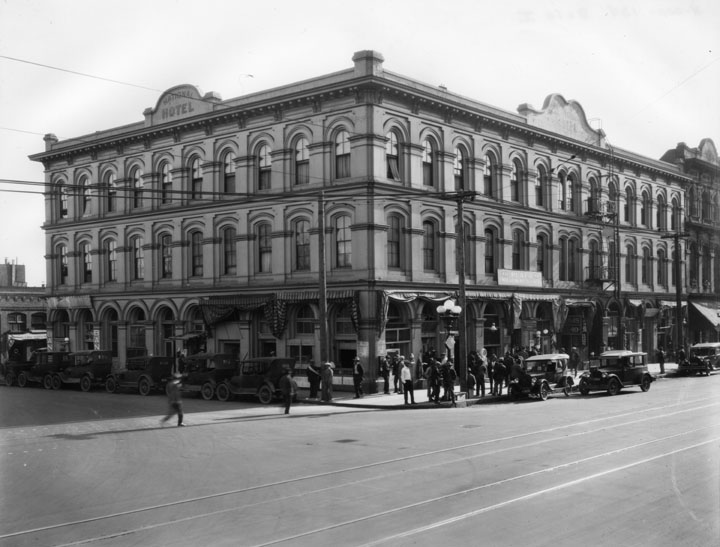 |
|
| (ca. 1920)* - The Pico House, sometimes called "Old Pico House", built by Pio Pico in 1869-70. For a period in the 1920's it became the "National Hotel" and here we see a corner view of the building at the corner of N. Main & Plaza St., with a sign for "Plaza Employment Agency" on the right side of the building. A crowd of people are hanging around the corner, and a row of cars is parked up the left side, while 3 or 4 cars are seen on the right side. |
Historical Notes Pío Pico constructed the Pico House in 1869-70. The first three-story hotel built in Los Angeles, it had about eighty rooms, large windows, a grand staircase, and a small interior courtyard.^* The Pico House (Hotel) was designated as California Historical Landmark No. 159 (Click HERE to see California Historical Landmarks in LA). |
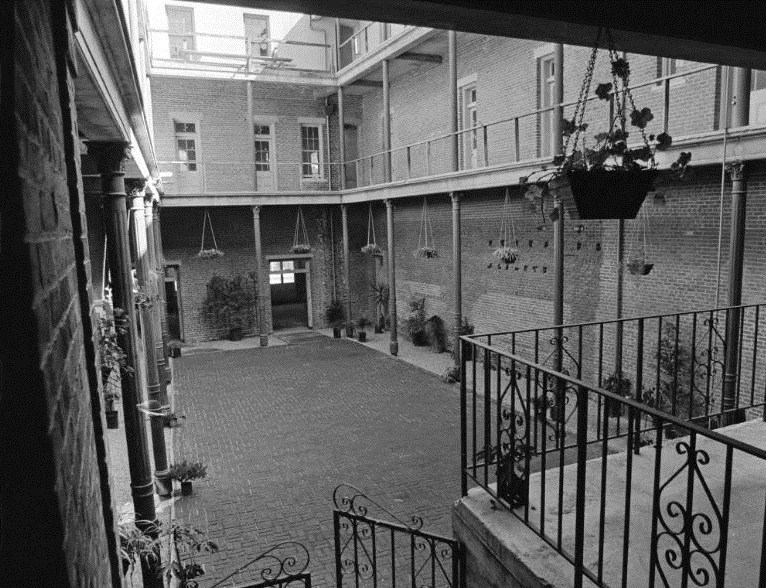 |
|
| (ca. 1971)*^*^ - View of the Pico House's interior courtyard shortly after it was restored. |
Click HERE to see more Early Views of the Pico House |
* * * * * |
Hamburger's Department Store (later May Co. - Macy's - California Broadway Trade Center)
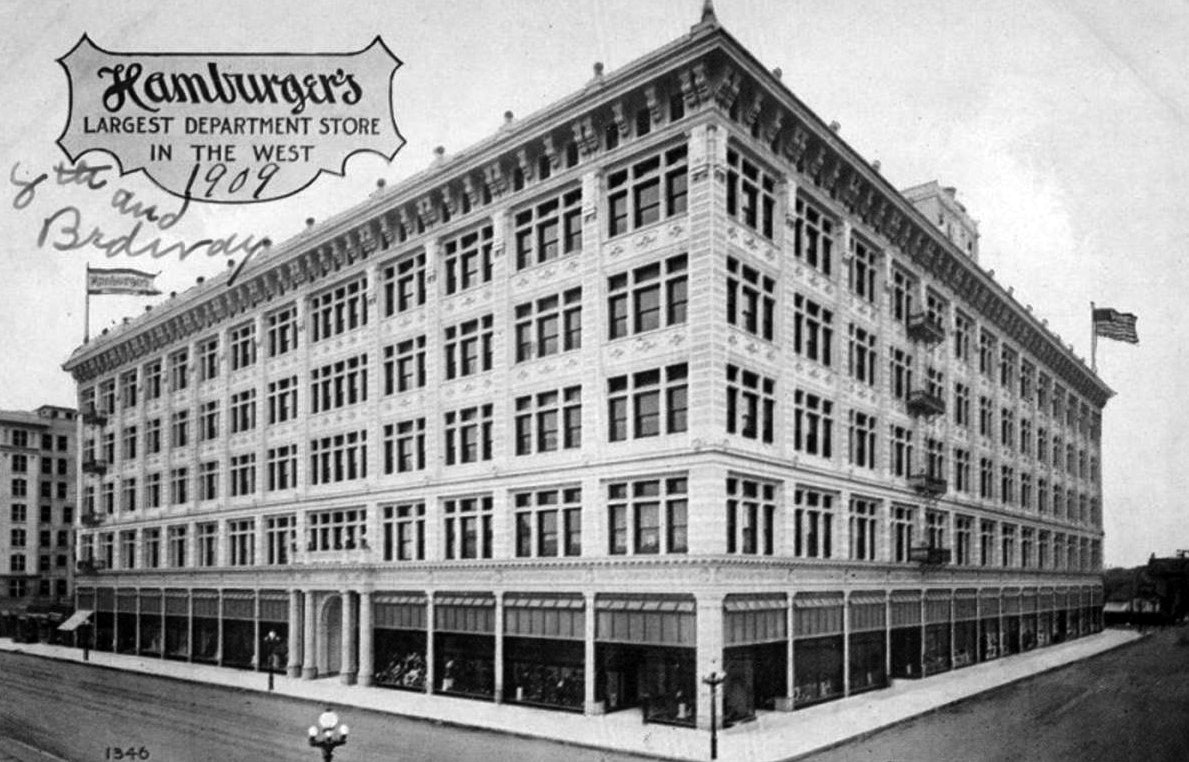 |
|
| (1909)* – Postcard view showing the newly constructed Hamburger’s Department Store located on the corner of Broadway and 8th Street. Hamburger’s was called the "Largest Department Store in the West." |
Historical Notes A. Hamburger and Sons was one of the first department stores to operate in Los Angeles. Originally known as A. Hamburger & Son's People's Store, the name later changed to Hamburger's Store. In 1908 the company relocated their store from the Phillips Block on Spring Street to a new building located at Broadway and Eighth Street (seen above). |
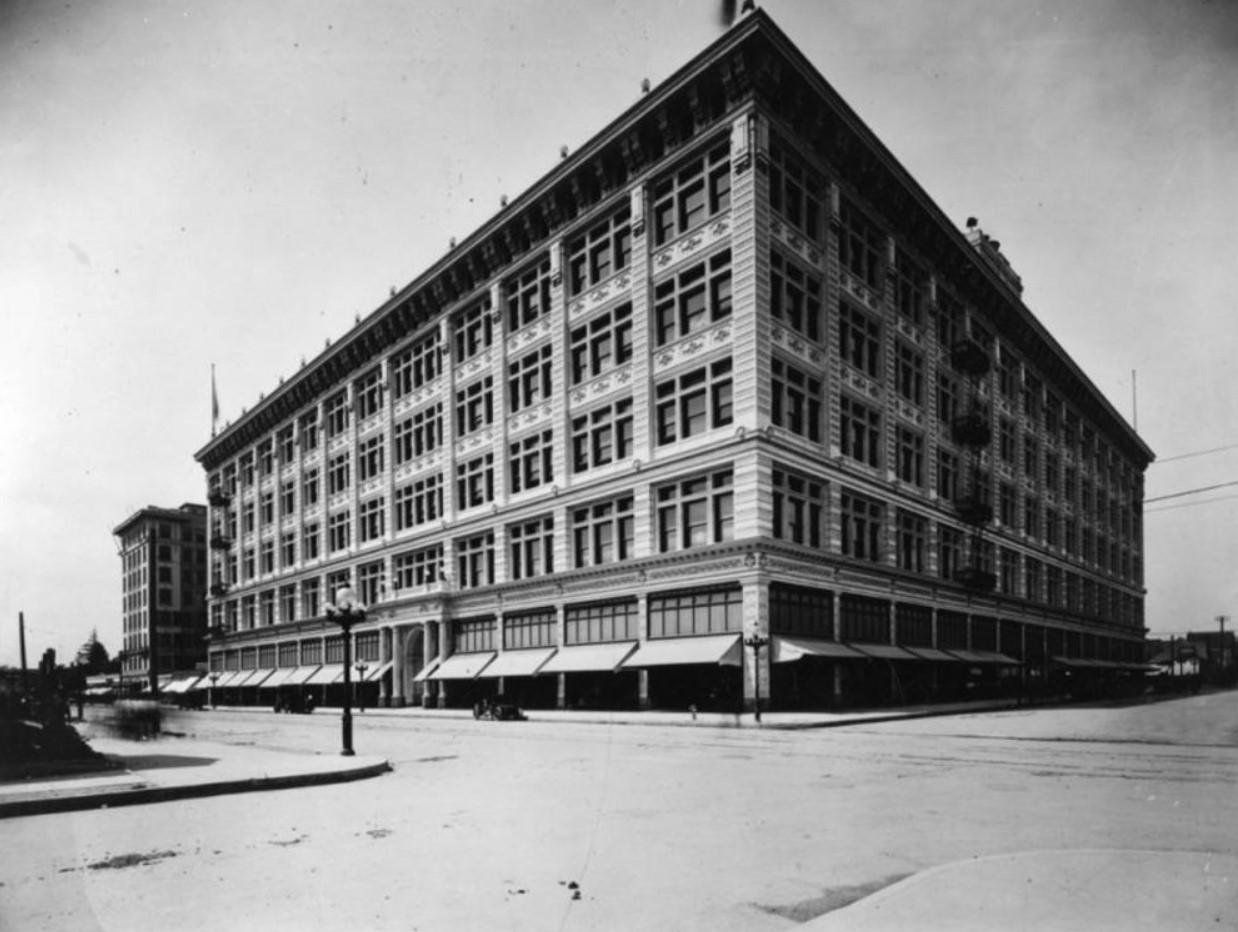 |
|
| (ca. 1909)* - View looking toward the SW corner of Broadway and 8th Street showing the Hamburger’s Department Store. The Majestic Theater (opened in 1908) can be at the end of the block in the distance. Note how empty the streets are. |
Historical Notes Originally designed by Alfred F. Rosenheim and opened in 1908, this Beaux Arts building was enlarged by Aleck Curlett in 1929 to accommodate more merchandise. The store was acquired from A. Hamburger & Sons Co. by David May in 1923 and renamed the May Company.* |
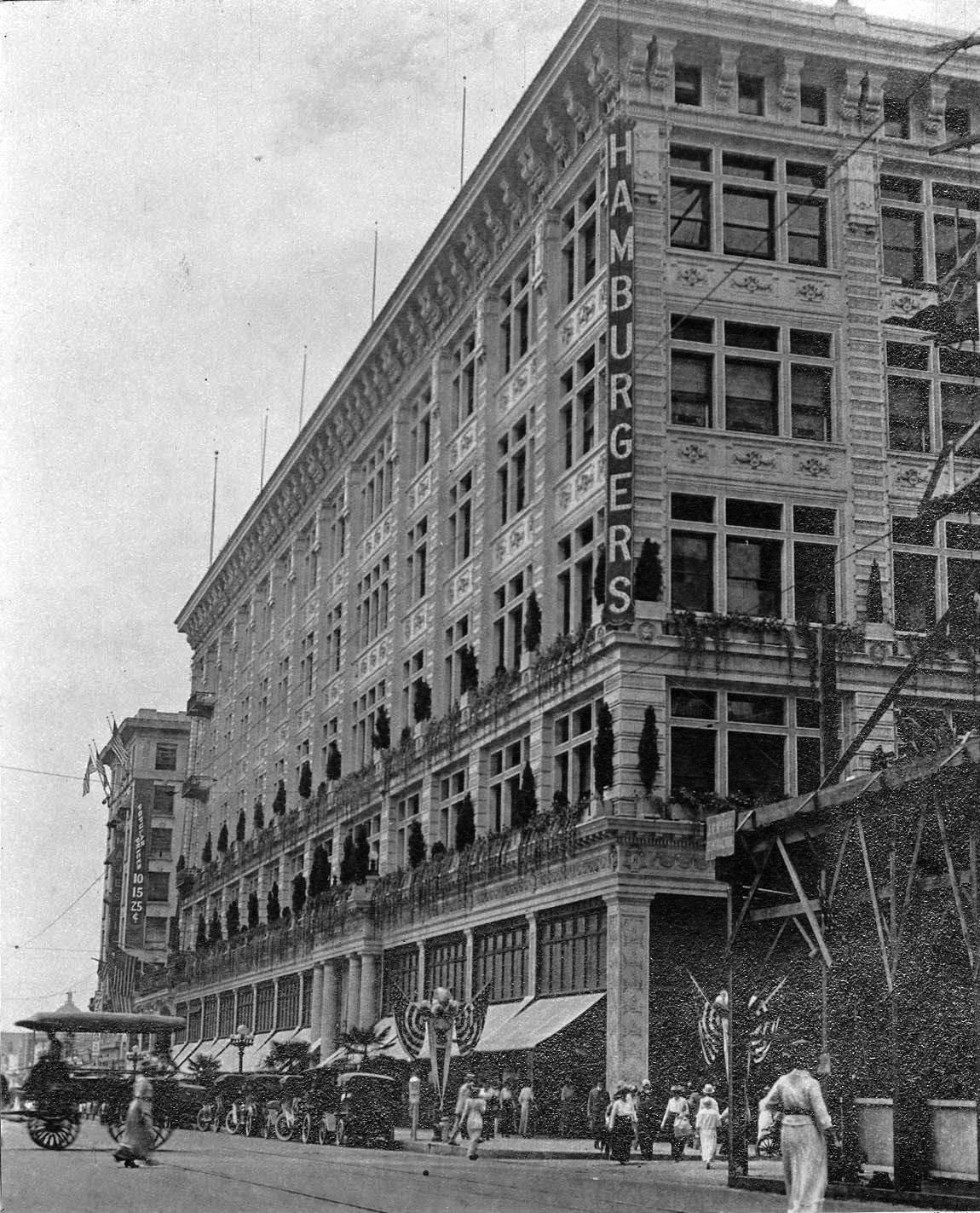 |
|
| (1915)^*#– View looking south on Broadway at 8th Street with the Hamburger’s Department Store seen on the SW corner. Horse-drawn carriages, cars, and pedestrians share the busy street. The Majestic Theater is at left with a large banner on its side that reads: “Popular Priced: 10¢ – 15¢ – 25¢”. The new building going up on the right (NW corner) is the Merritt Building. |
 |
|
| (ca. 1920)^.^ – Postcard view of Hamburger's department store located at the southwest corner of Broadway and Eighth Street in Downtown Los Angeles. “The Great White Store” |
Historical Notes A. Hamburger & Sons Co. was a department store founded in 1881 by Asher Hamburger and operated exclusively in Southern California until 1989. The Hamburger family first started its retail store, originally known as the People's Store, on Main Street near Requeña Street (later renamed Market Street). In 1887 they moved into the new Phillips Block on Spring Street. And in 1908, relocated and expanded to the Great White Store at Broadway and 8th Street. It was the largest department store building west of Chicago at that time. ^ |
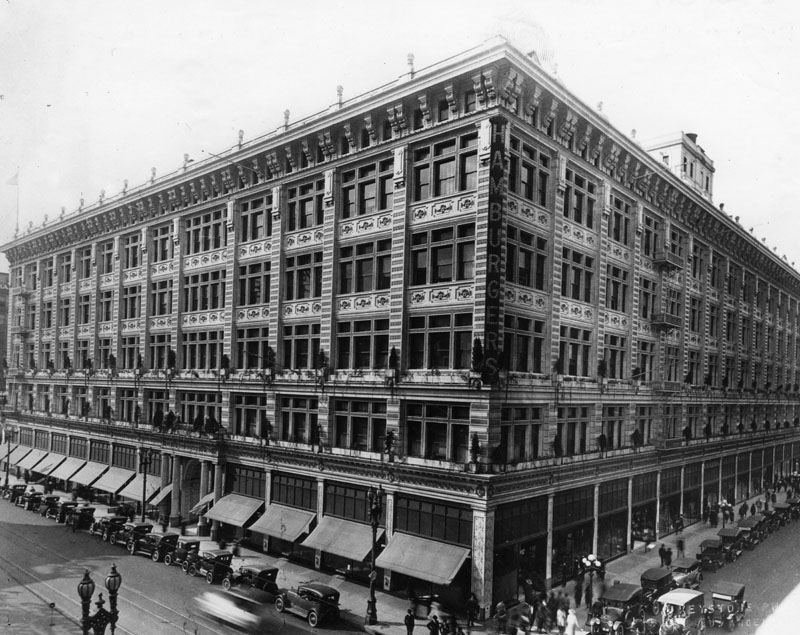 |
|
| (ca. 1926)* - Exterior view of Hamburger's ornately decorated department store located on the corner of Broadway and Eighth streets. Awnings cover the display windows on one side and cars are parked end to end at the curb. |
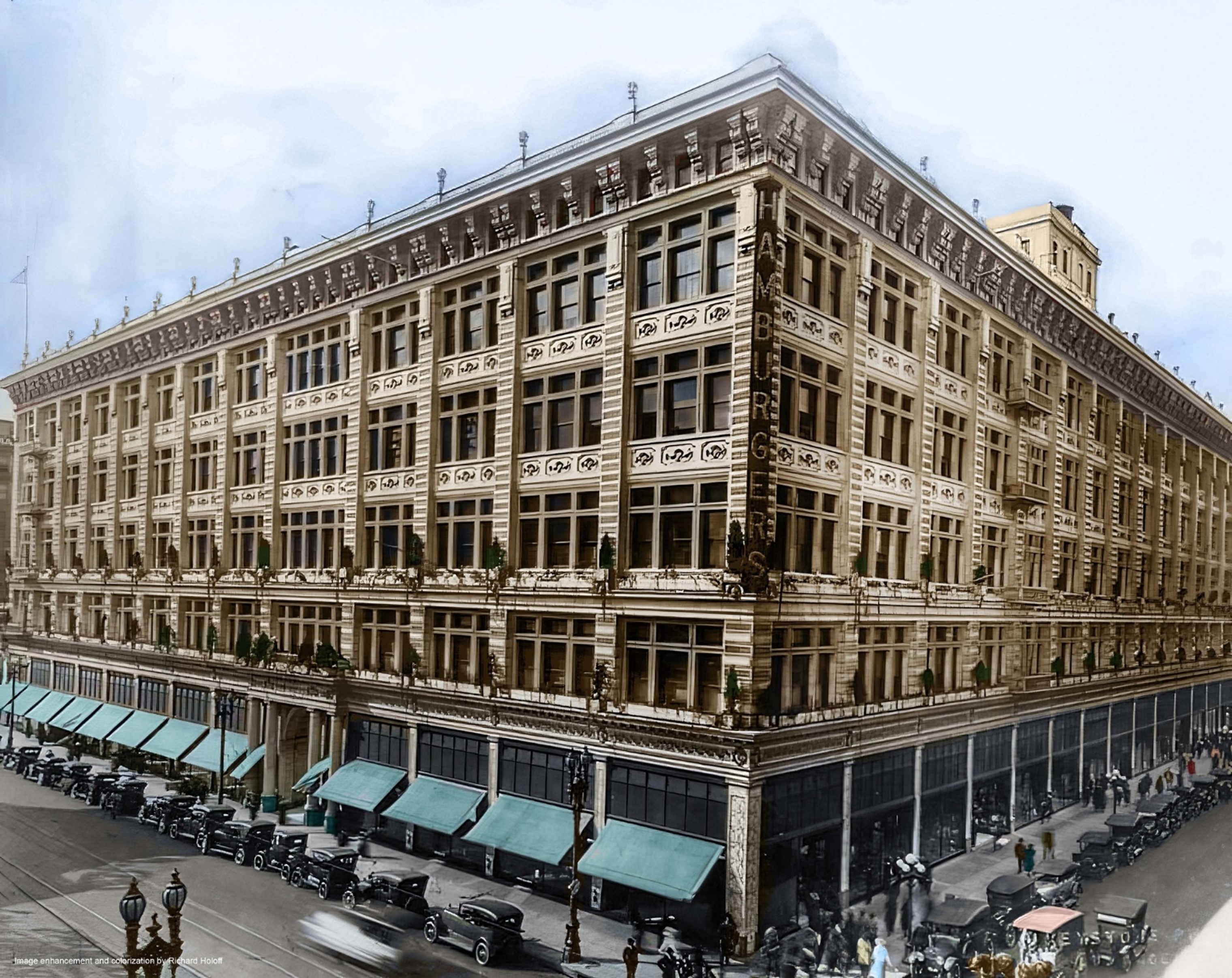 |
|
| (ca. 1926)* - Exterior view of Hamburger's ornately decorated department store located on the corner of Broadway and Eighth streets. Awnings cover the display windows on one side and cars are parked end to end at the curb. Image enhancement and colorization by Richard Holoff |
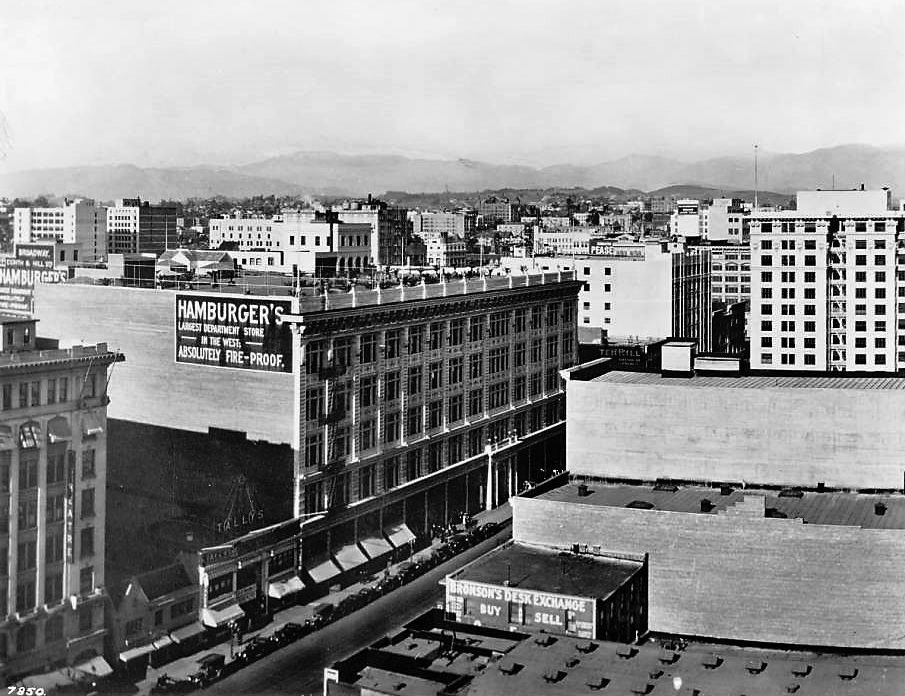 |
|
| (ca. 1915)^^ – View looking NW showing the Hamburger’s Department Store (later May Company) located on the SW corner of Broadway and 8th Street. At left can be seen the Majestic Theater and Tally's New Broadway Theatre. |
Historical Notes In 1923, the Hamburger Department Store was acquired by May Company California. The Beaux Arts building was enlarged by Aleck Curlett in 1929 to accommodate more merchandise. |
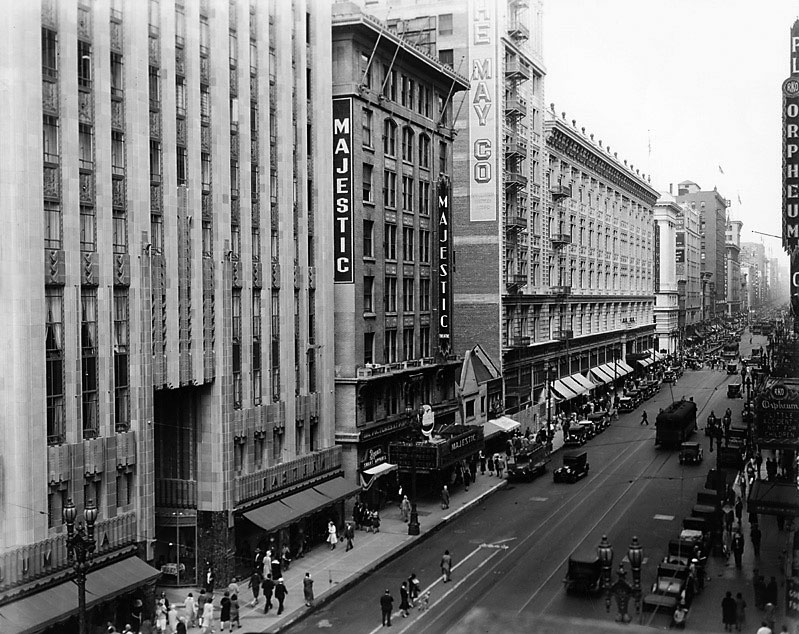 |
|
| (1930)* – View of Broadway looking north from 9th Street showing The May Company (previously Hamburger's) on the SE corner at 8th Street. Note that Tally''s Broadway Theater is now gone. The May Company was still working on the storefronts of its addition on the Tally's site. The Majestic Theater is seen at center with the newly opened Eastern Columbia Building on the left. The Majestic is running "Top Speed" with Joe E. Brown. Acorss the street, the Orpheum Theatre is playing "Little Accident," with Douglas Fairbanks, Jr. and Anita Page. |
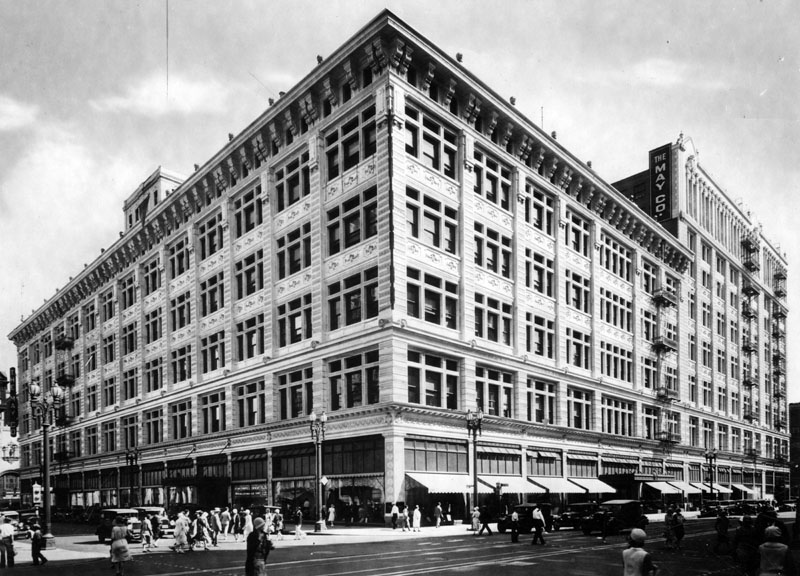 |
|
| (1933)* - View looking at the SE corner of Hill and 8th streets showing the May Co. Building (previously Hamburger's Department Store). The building runs all the way from Hill to Broadway on the south side of 8th Street. |
Historical Notes May Department Stores acquired Hamburger's in 1923 and renamed it the May Company. Much later in the century, the May Company and Robinsons chains of department stores would affiliate under the name Robinsons-May; and this entity would be bought out by Macy's in 2005.^ |
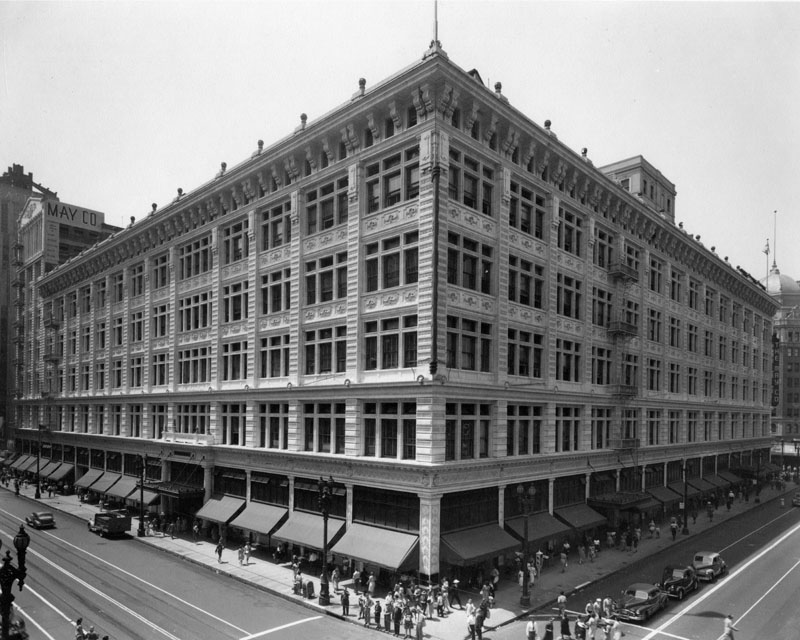 |
|
| (1951)* - Photo by Dick Whittington showing the exterior of the May Co. building located on the SW corner of Broadway and 8th streets in downtown Los Angeles. |
Historical Notes More recently, the building has been known as the California Broadway Trade Center and houses dozens of individual retail stalls.* The building is now owned by the Afshani brothers who, it is rumored, are planning to bring a hotel, apartments, and revamped retail space to the one-million-square-foot site, which runs all the way between Broadway and Hill.*## In 1989, the Hamburger/May Co. Department Store Building was designated Los Angeles Historic-Cultural Monument No. 459 (Click HERE for complete listing). |
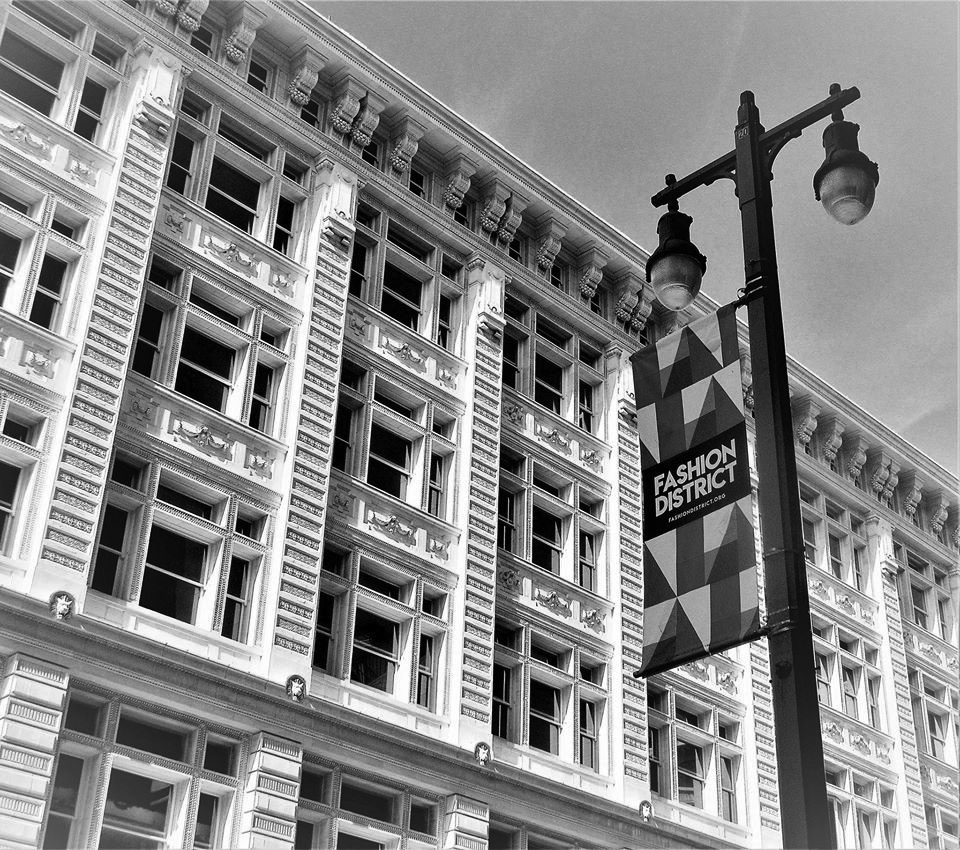 |
|
| (2020)^.^ – View looking up at the newly renovated California Broadway Trade Center (801 S. Broadway) with ornate dual-pendant teardrop-shaped streetlight seen in the foreground. The 1908-built Beaux Arts building (1908) was originally home to Hamburger’s Department Store. Photo by Howie Gray. |
* * * * * |
County Courthouse
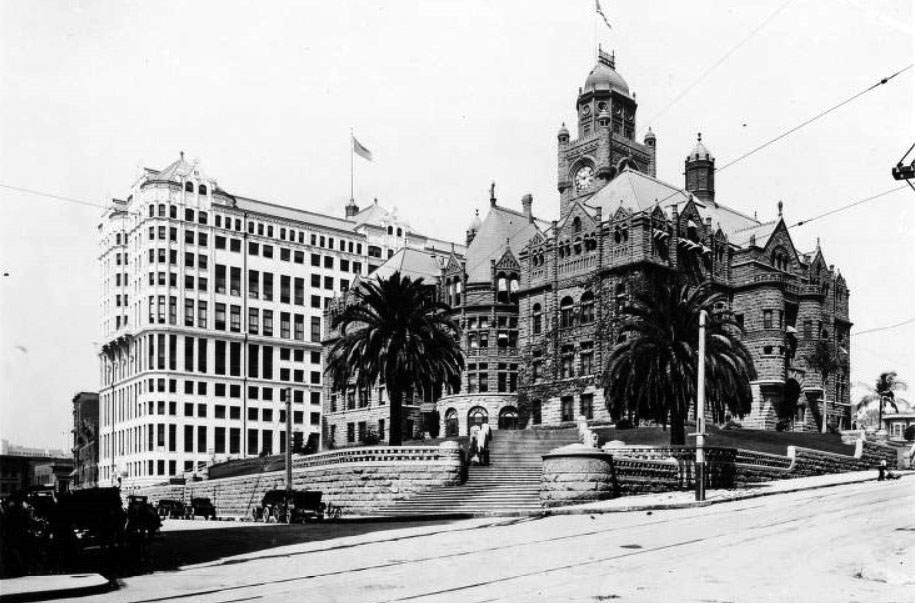 |
|
| (ca. 1917)#^*- View of the southeast corner of Temple Street and Broadway showing the County Court House and Hall of Records. |
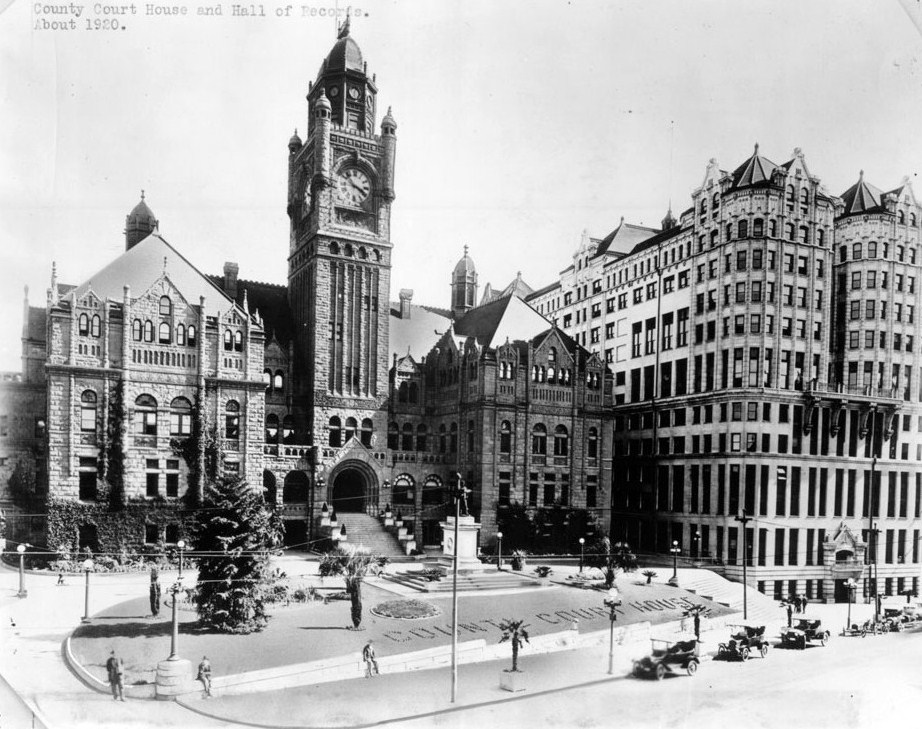 |
|
| (ca. 1920)^ - View of the Los Angeles County Courthouse and Hall of Records standing side-by-side. |
Historical Notes The LA County Courthouse was built in 1891 at the old site of Los Angeles High School. The building was demolished in 1936. The Hall of Records was built in 1906 and demolished in 1973.* |
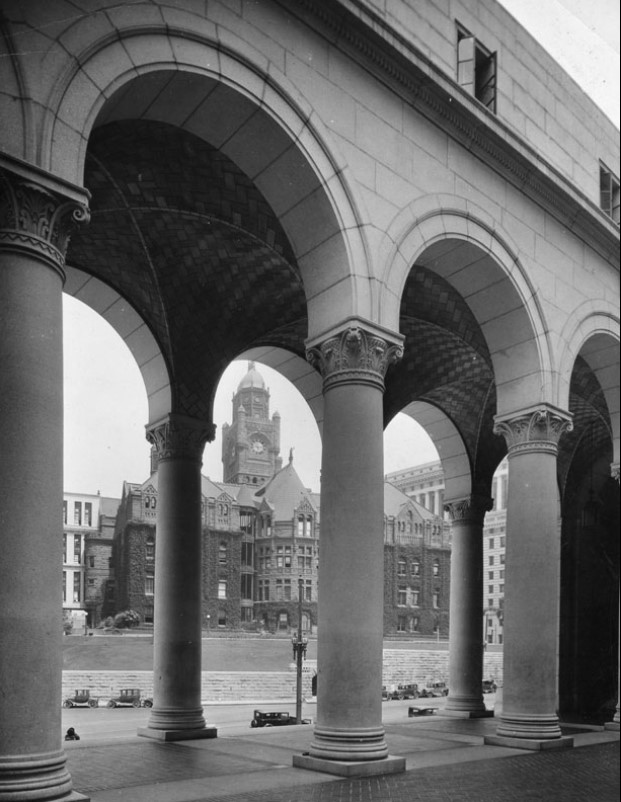 |
|
| (1928)* - View of the Los Angeles County Courthouse viewed through the colonnade of the recently completed City Hall. |
Click HERE to see more Early Views of the LA County Courthouse |
* * * * * |
Broadway Christian Church
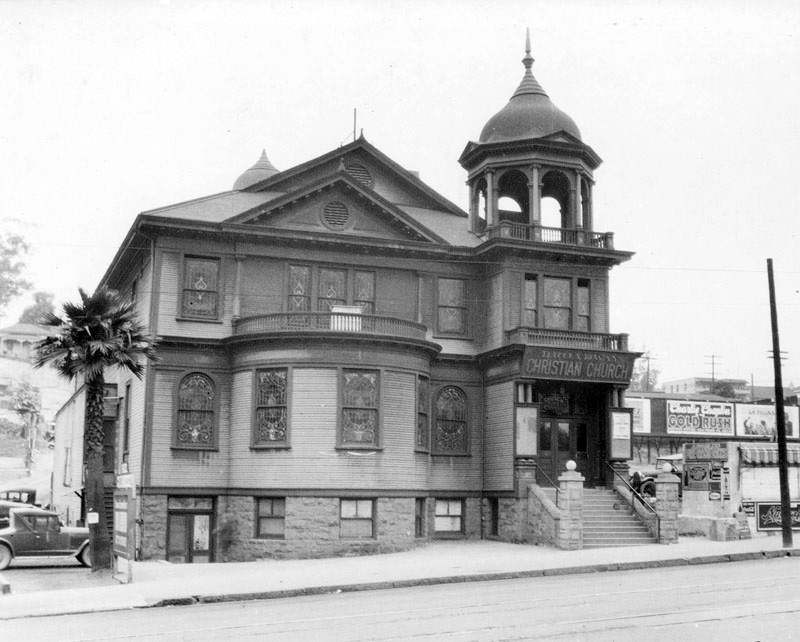 |
|
| (ca. 1923)* - View looking at the Victorian-style Broadway Christian Church at 223 Broadway, located across the street from the County Courthouse just south of Temple Street. |
Historical Notes Dedicated in 1895, this building served as the Broadway Christian Church until 1925, at which time the congregation relocated and built a Spanish-style church at 3405 W. Pico Blvd. in Los Angeles. Many years later, the Pico-Arlington Christian Church became the Ethiopian Christian Church. B. F. Coulter was an ordained minister and founded the Broadway Christian Church. He was also one of the earliest merchants in Los Angeles having started Coulter's Dry Goods in 1878. |
* * * * * |
Hotel Ford
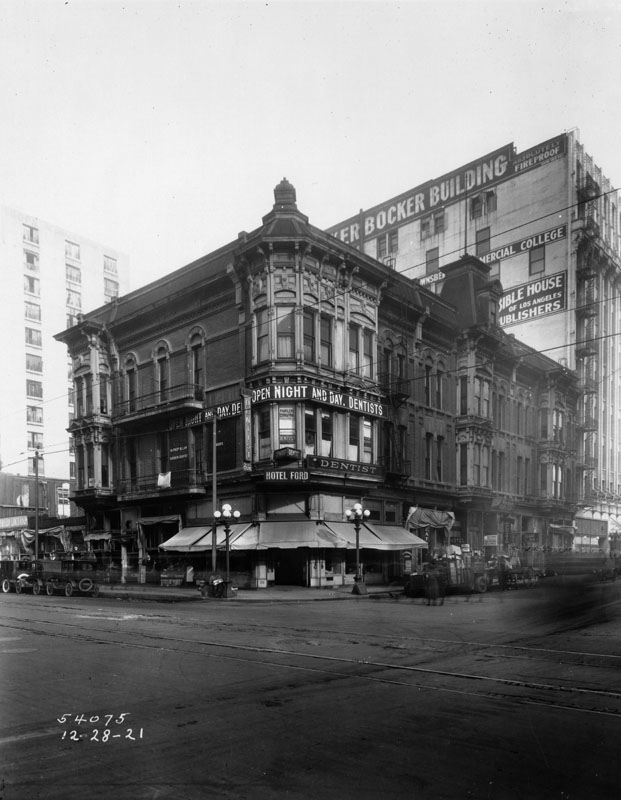 |
|
| (1921)* - The northwest corner of Olive and 7th Streets on December 28, 1921. This is the future site of the Bank of Italy Building. In this photo it is Hotel Ford, with a dentist's office above. It is also known as the United States Hotel. The Knickerbocker Building is at right. |
Bank of Italy Building (Today, Giannini Place)
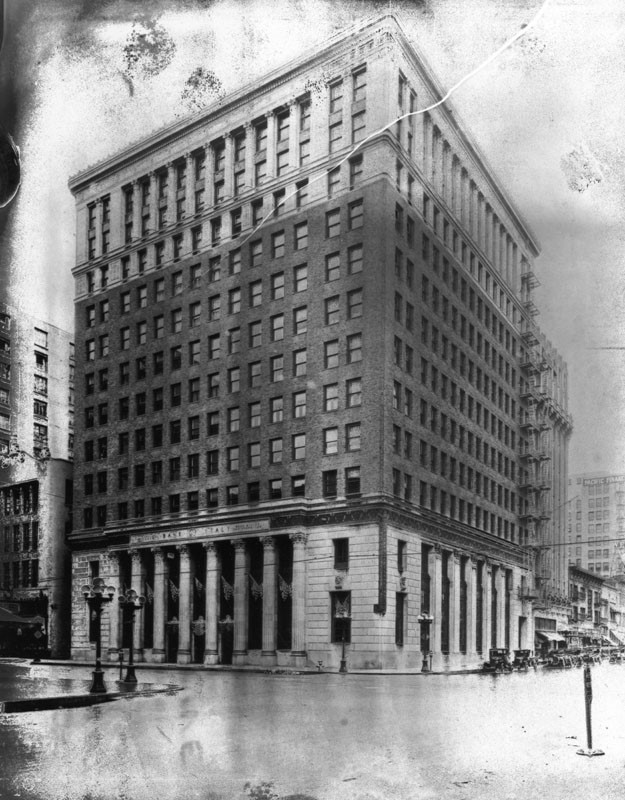 |
|
| (1922)* – View showing the newly constructed Bank of Italy at 649 South Olive Street. The building is a neoclassical base supporting office block, a rusticated base, with 3-story monumental colonnades. Date built: 1922. Architects: Morgan, Walls & Clements. |
Historical Notes The 12-story building was completed in 1922 and dedicated in 1923. It was built as the Los Angeles headquarters of the Bank of Italy, a forerunner to Bank of America founded by Amadeo Giannini. Designed by architectural firm Morgan, Walls & Clements, the Neoclassical architectural style building has Doric columns, ornate golden ceiling and marble floors. The bronze front doors are surrounded by terra cotta sculptures of American coins.
The Bank of Italy was founded in San Francisco, in 1904 by Amadeo Giannini. It grew by a branch banking strategy to become the Bank of America, the world's largest commercial bank with 493 branches in California and assets of $5 billion in 1945. It was also the first state-wide branch banking system. The Bank of Italy merged with the smaller Bank of America, Los Angeles in the 1928. In 1930, Giannini changed the name "Bank of Italy" to "Bank of America." As Chairman of the new, larger Bank of America, Giannini expanded the bank throughout his tenure, which ended with his death in 1949.^* |
 |
|
| (1920s)* – View looking at the NW corner of 7th and Olive streets showing the Bank of Italy, once the site of the Hotel Ford. |
Historical Notes When the Bank of Italy Building opened in 1922 it had a massive vault that included space for 12,000 safe-deposit boxes. The main vault door weighed 50 tons. Bank of Italy, already the largest bank in the West by 1923, also encouraged deposits from a group that most banks at the time overlooked — women and children. It became Bank of America in 1930. The building, now known as Giannini Place, was remodeled in 1968, and declared LA Historic Cultural Monument No. 354 on April 16, 1988. Click HERE for contemporary view. |
* * * * * |
Loew's State Theater
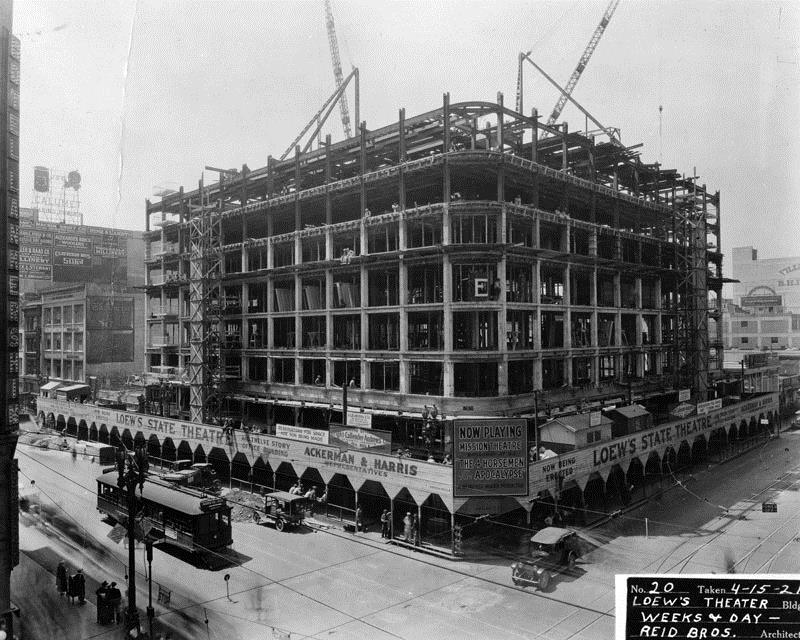 |
|
| (1921)* - View looking at the southwest corner of Broadway and 7th Street showing the construction of Loew's State Theater. Workers can be seen sitting on different floors taking a break. |
Historical Notes Loew's State Theatre, located at 703 S. Broadway was constructed in 1921 on the site of the Vogel Block (1893-1920). It opened the same year and had a seating capacity of 2,450. The theater offered both film and vaudeville when it opened. Designed by Charles Weeks and William Day, the 12-story Loew's State is said to be the largest brick-clad structure in Los Angeles.^* It was the 200th theatre built by Marcus Loew and was the most completely equipped on the coast. The theatre was housed in a twelve-story building costing $2,500,000. The theatre proper cost $1,500,000. It was built by Woods Brothers, Weeks and Day, and was under the direction of Ackerman and Harris, Western managers for Loew in San Francisco.**^ |
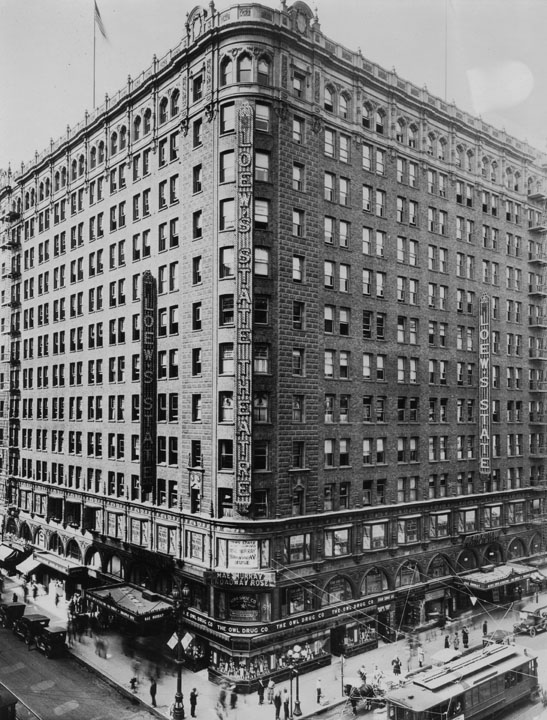 |
|
| (1921)* - Pedestrians walk by the marquee at the Loew's State Theater on the corner of 7th and Broadway as it advertises Mae Murray in "Broadway Rose". On the ground floor is The Owl Drug Co. Various businesses occupy the other floors. A horse and buggy is stopped at the intersection next to a streetcar. |
Historical Notes Loew's State Theatre was built as the west coast showcase for the product of the Loew's subsidiary Metro Pictures. The opening was on November 12, 1921 at one of downtown's busiest intersections, 7th and Broadway. Loew's State once used entrances on both streets. The 7th St. entrance was closed in 1936. The opening attraction was MGM's "Liliom." Marcus Loew was in attendance with a bevy of stars. Wonderfully successful as a vaudeville/movie house, it featured elaborate stage shows by Fanchon and Marco with leading performers. Judy Garland sang here when she was still one of the Gumm Sisters.**^ |
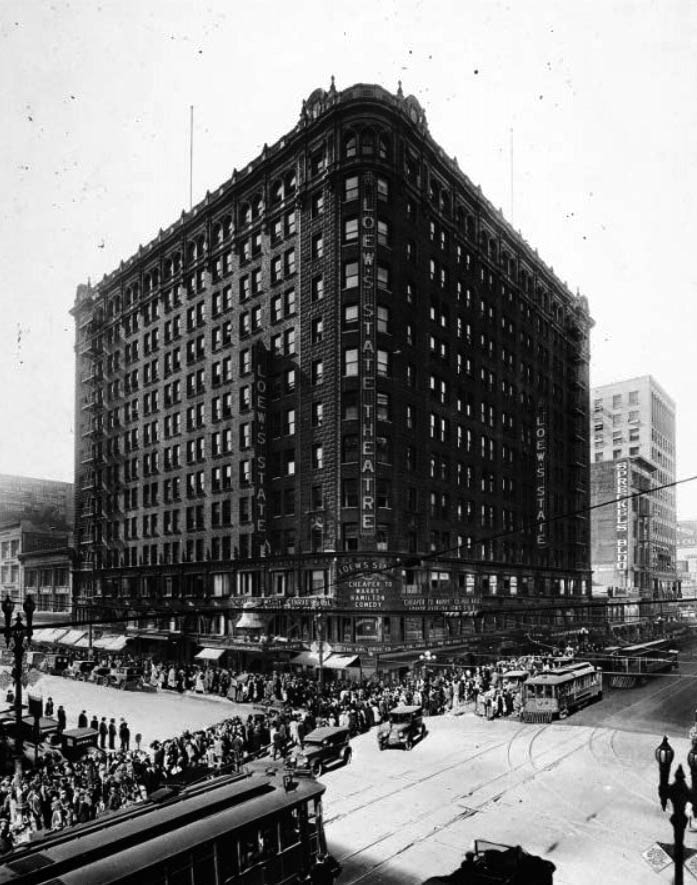 |
|
| (ca. 1924)^ – View of the Loew's State Building (Loew's State Theatre) at the southwest corner of Seventh Street and Broadway. Many streetcars can be seen operating here as thousands crowd into the theatre. |
Historical Notes In 1924 Marcus Loew engineered the merger of Metro with the Goldwyn Co. (which Sam Goldwyn had departed from in a 1922 power struggle) and the Louis B. Mayer group -- resulting in Metro-Goldwyn Pictures. By 1925, Mayer's name was also part of the company name, thus becoming MGM.**^ |
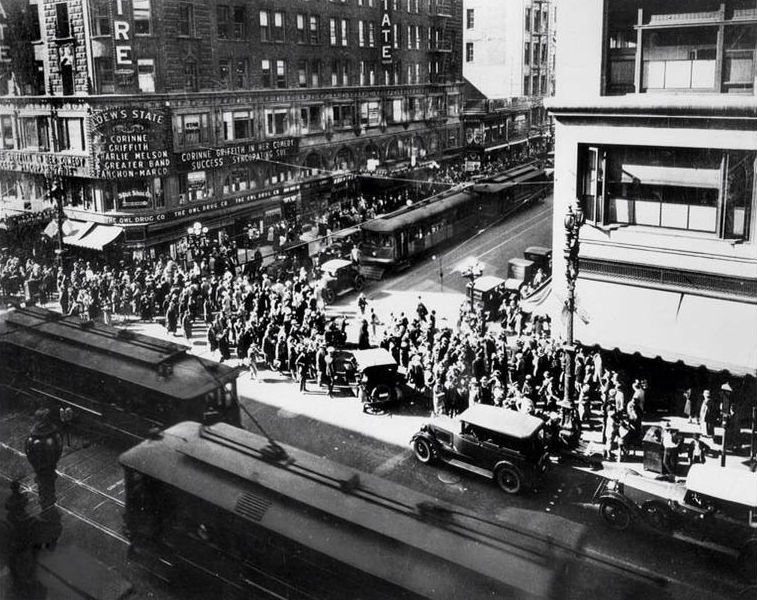 |
|
| (1926)**^ - View from above of 7th & Broadway, downtown's busiest intersection. Loew's State Theater is playing "Syncopating Sue" starring Corinne Griffith. |
Historical Notes MGM's prestige product was well suited to the type of theatres operated by the Loew's Corporation. Although at its height in the late 1920's, the circuit totaled only about 160 theatres, they were typically lavish first runs in major cities.**^ |
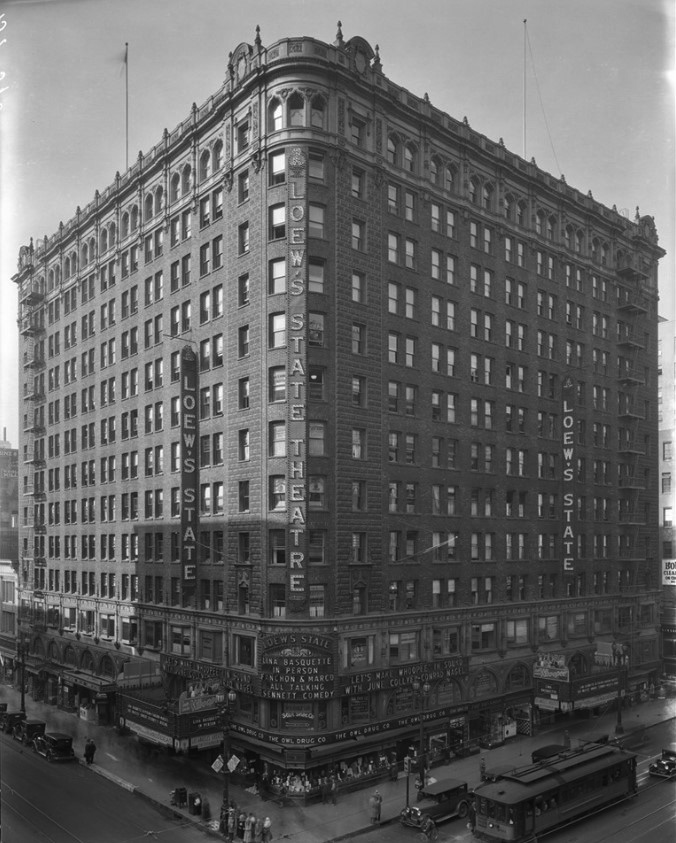 |
|
| (1928)^*# - Loew's State Theatre at 7th and Broadway. Shows theater/office building on corner. Theater marquee reads: "Lina Basquette in person, Fanchon & Marco, All talking Sennett comedy 'Let's Make Whoopee' in sound, June Collyer - Conrad Nagel." Businesses include: Owl Drug Co., Star Shoe Co., Leighton Cafeteria. Street corner shows pedestrians, automobiles, bicyclist, street car. |
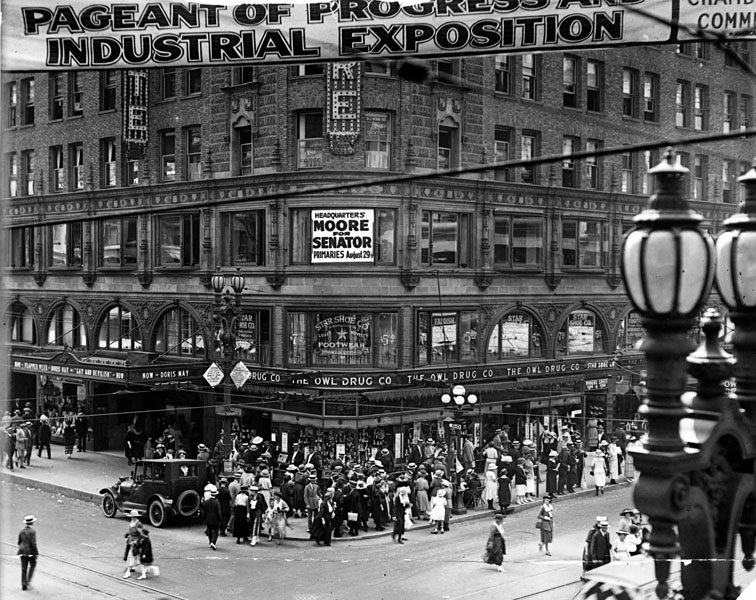 |
|
| (1922)* - Exterior view of Loew's State Theatre building. The streets are crowded with pedestrians crossing and standing along the sidewalks. Marquee reads: Now- Flapper week-Doris May in "Gay and Devilish." Occupants of the building also includes a dentist, Headquarters for Moore for Senator campaign, Star Shoe Co. and the Owl Drug Co. |
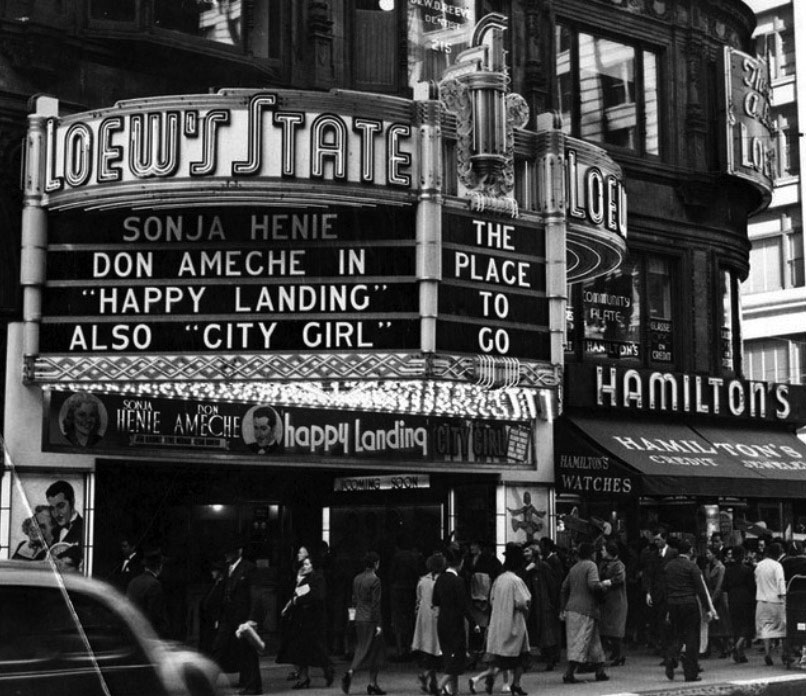 |
|
| (1938)*##^ – View showing the marquee at Loew’s State Theater, Broadway and 7th Street. Now Playing: Sonja Henie and Don Ameche in “Happy Landing”, also “City Girl”. |
Historical Notes The theater is noted for the seated Buddha located in a niche above the proscenium arch. The exterior has an elaborate "silver platter" chased ornamentation above the ground story. In 1998, Metropolitan Theaters stopped showing movies at the State and leased the space to the Universal Church. As of 2008, the State was being operated as a Spanish-language church.^* |
* * * * * |
Rex Arms Apartments
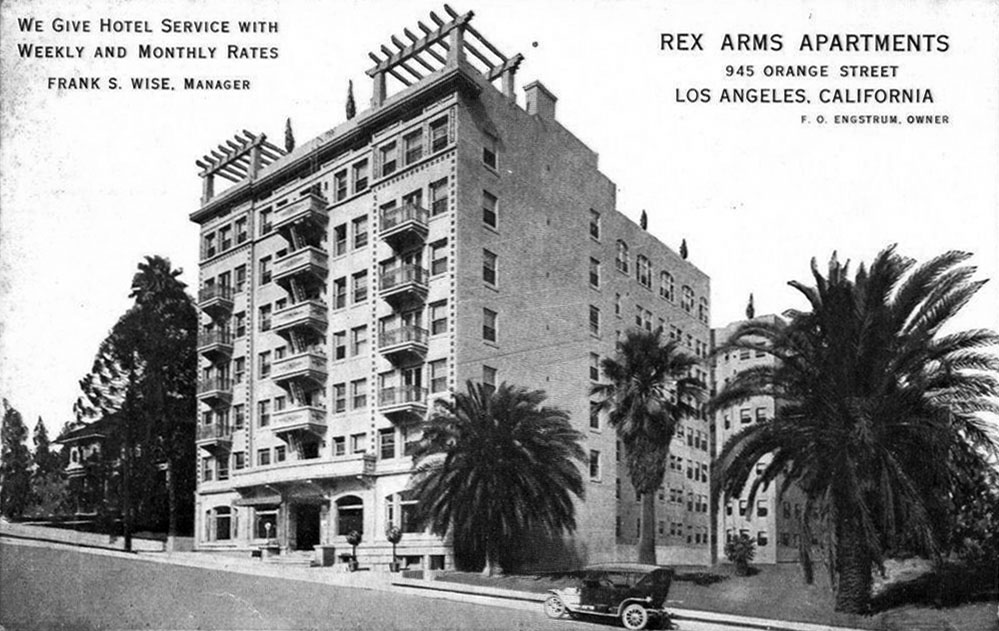 |
|
| (ca. 1920)*^ – Postcard view showing the Rex Arms Apartments located at 945 Orange St (later Wilshire Blvd). Card reads: “We give hotel service with weekly and monthly rates – Frank S. Wise, Manager” also “F. O. Engstrum, Owner” |
Historical Notes The nine-story Rex Arms Apartments opened in 1912 at 945 Orange Street, developed by F. O. Engstrum, whose firm was also behind the magnificent Bryson Apartments near MacArthur Park. At the time, the Rex was one of Los Angeles’ largest and grandest residential buildings, held up by the great ambitions of the city’s elites. After Orange Street was renamed Wilshire Boulevard, a portion of the Rex’s main facade was demolished during the avenue’s widening in the early 1930s.* |
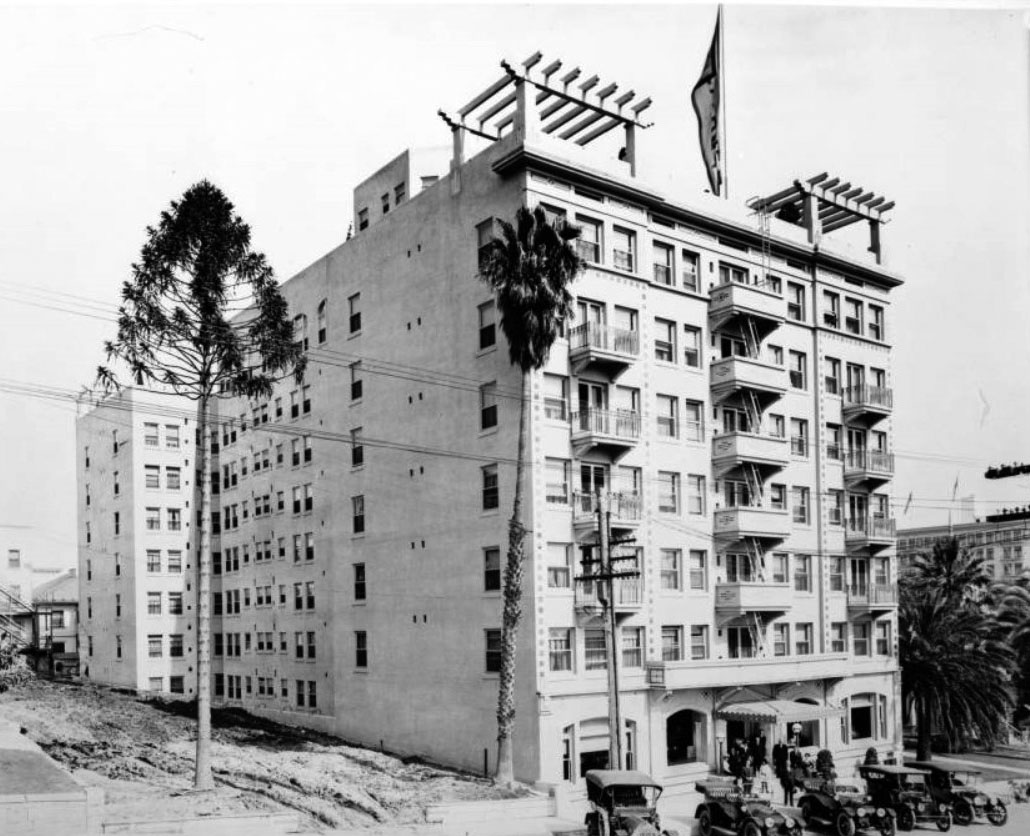 |
|
| (ca. 1920)* - View showing the 9-story Rex Arms Apartment building located on the north side of Orange St (laterWilshire) just west of Figueroa. |
Historical Notes The Rex disappears from newspaper records in 1976, probably at the time of its destruction. Since 1980, the site has been occupied by a 22-story office tower designed by Skidmore, Owings, and Merrill. Originally named 911 Wilshire, the building’s name and address, for obvious reasons, were changed to 915 Wilshire several years ago. |
* * * * * |
Van de Kamp's First Windmill Bakery
 |
|
| (1921)* - View showing Van de Kamp's Bakery Shop on Western and Beverly Boulevard. This is the 1st of the windmill bakery shops which had first been a movie set and was purchased for use as a novel bakery. |
Historical Notes Van de Kamp’s Holland Dutch Bakers was founded in Los Angeles in 1915 by Theodore J. Van de Kamp, a Dutch immigrant baker. The company began as a wholesale bread operation and quickly earned a reputation for quality baked goods during a period when commercial bread was becoming a household staple. In 1921, Van de Kamp’s opened its first windmill bakery shop at Western Avenue and Beverly Boulevard. The building had originally been constructed as a movie set, reflecting the close relationship between Hollywood and Los Angeles commercial design. The windmill structure was adopted as a visual trademark meant to attract customers and set the bakery apart from competitors. This first windmill shop proved highly successful and established a model that would be repeated across Southern California. The combination of bakery, restaurant, and novelty architecture helped Van de Kamp’s become one of the most recognizable food businesses in the region. |
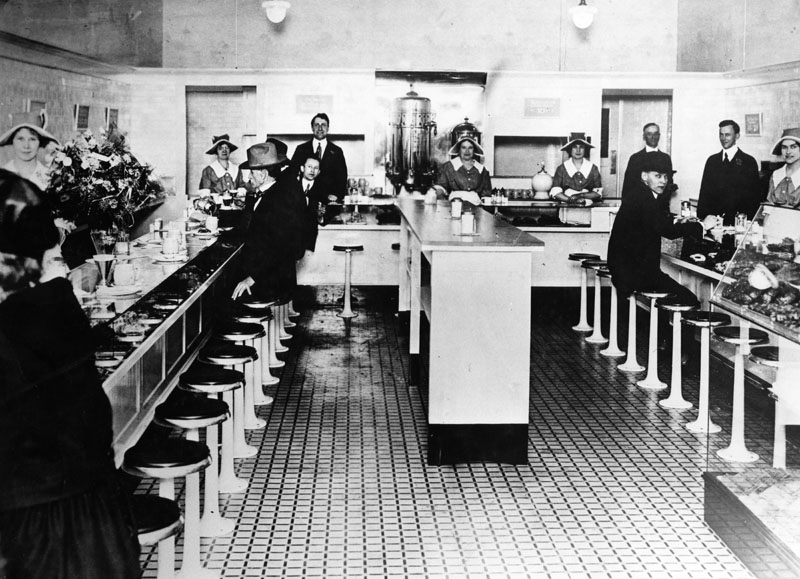 |
|
| (1921)* - Interior of Van De Kamp's first restaurant unit, on Spring Street in Los Angeles, in 1921. A few diners are seated on barstools at the counters, while restaurant staff smile for the camera. |
Historical Notes Van de Kamp’s opened an early restaurant and bakery counter on Spring Street in downtown Los Angeles in 1921. At the time, Spring Street was the city’s primary business and financial corridor, making it an ideal location for a growing company. These early bakery restaurants allowed customers to purchase fresh bread, pastries, and prepared foods while also dining on site. The open counters and simple interior emphasized cleanliness, efficiency, and freshness, values that were central to the company’s public image. By the 1920s, Van de Kamp’s had become a familiar presence in daily Los Angeles life, supplying bread to homes, restaurants, and institutions throughout the city. |
* * * * * |
Van de Kamp's (Beverly and Westmoreland)
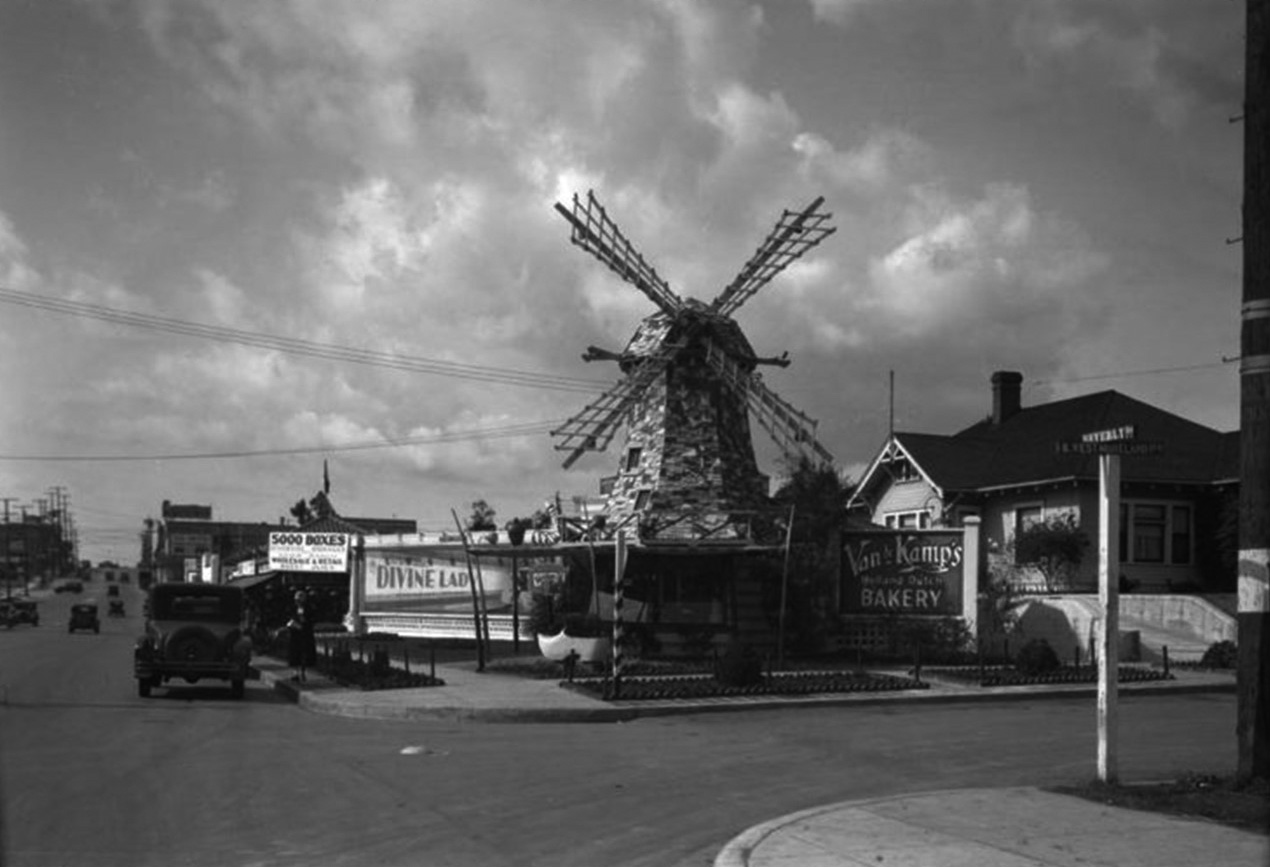 |
|
| (ca. 1930)* - View looking west on Beverly Boulevard at Westmoreland Avenue showing a Van de Kamp’s Dutch Baker on the NW corner. |
Historical Notes By the late 1920s and early 1930s, Van de Kamp’s windmill bakeries had spread throughout Los Angeles and nearby communities. The location at Beverly Boulevard and Westmoreland Avenue served a growing residential area west of downtown. The windmill buildings were examples of novelty architecture, designed so the structure itself advertised the business. The distinctive windmills became neighborhood landmarks and were easily recognizable to passing motorists and pedestrians. The bakery’s architectural style reflected Los Angeles’s embrace of playful, visually expressive commercial buildings during the automobile age. |
 |
|
| (1937)* - Close-up view of Van de Kamp's at Beverly Boulevard at Westmoreland Avenue. Sign reads: 'Open Till Midnite' |
Historical Notes This close up view highlights the architectural details and signage that made Van de Kamp’s bakeries so visible and inviting, especially after dark. By the late 1930s, Beverly Boulevard was a well traveled east west corridor, and illuminated storefronts were designed to catch the attention of passing motorists. The windmill structure, combined with bold lettering and extended hours, reflected changing habits in Los Angeles, where shopping and dining increasingly took place in the evening. The sign advertising late hours also suggests the bakery’s role as a convenient stop for both neighborhood residents and people traveling through the area. |
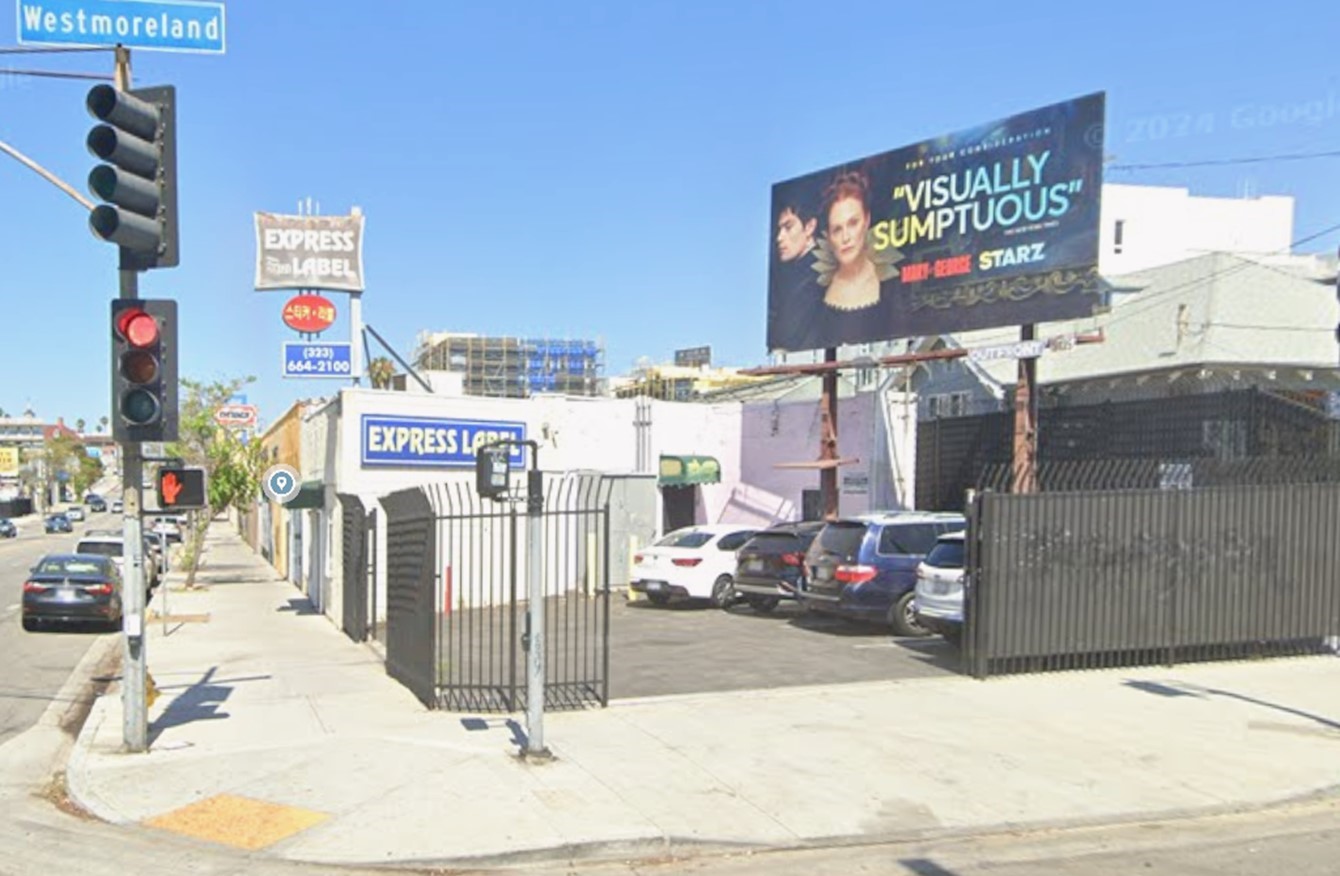 |
|
| (2024)* - Contemporary view of the northwest corner of Beverly Boulevard and Westmoreland Avenue where a Van de Kamp's Bakery once stood, now the site of a small parking lot. |
Historical Notes The modern view shows a dramatically altered streetscape, with the former bakery site reduced to a small surface parking lot. This change reflects broader postwar trends in Los Angeles, including the removal of small scale commercial buildings and the prioritization of automobile storage over neighborhood oriented storefronts. Nothing at the site today indicates the presence of what was once a highly distinctive and well known local landmark. The absence underscores how easily visually expressive commercial architecture can disappear from the urban landscape. |
Then and Now
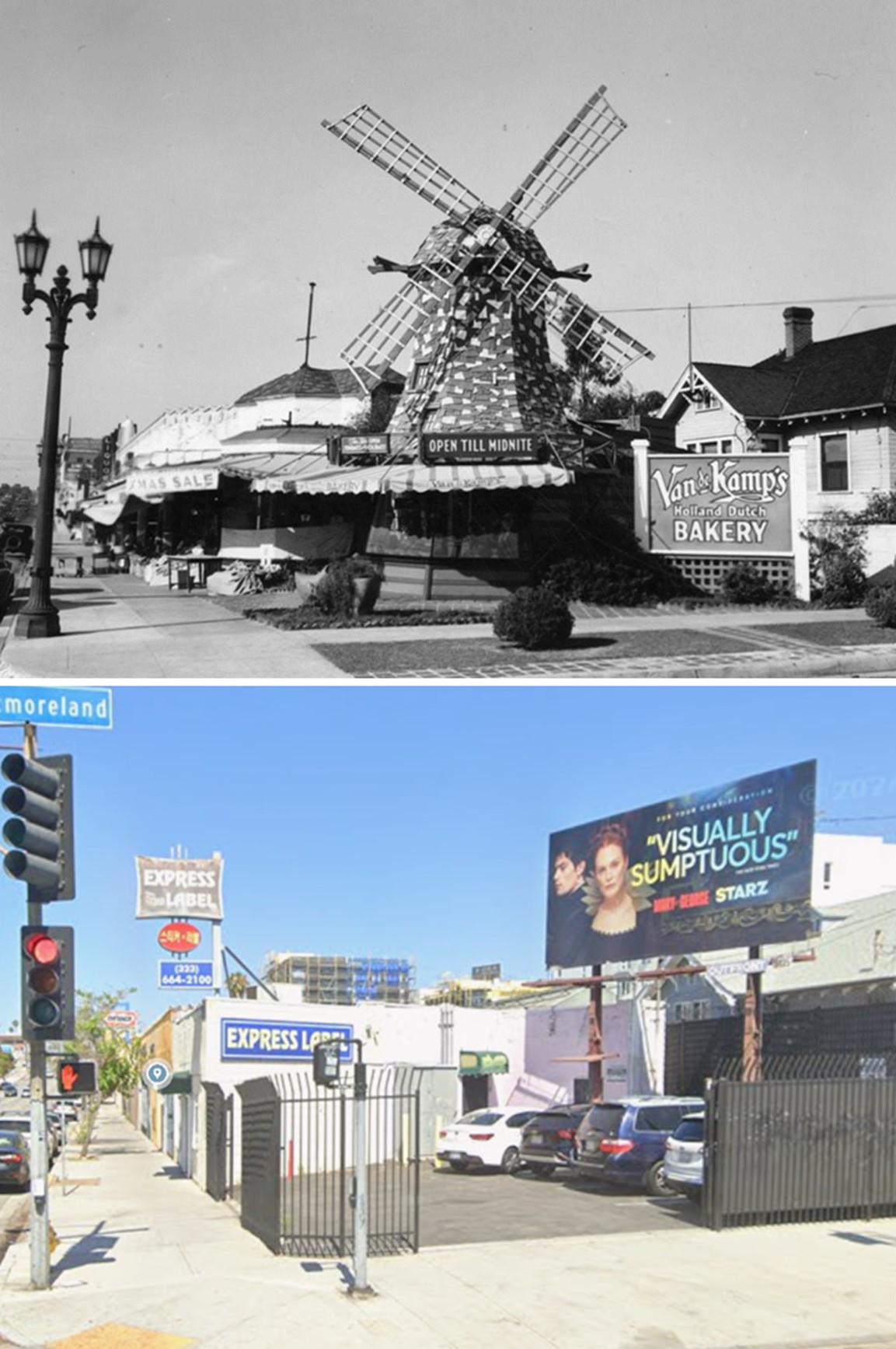 |
|
| (1935 vs 2024)* – A 'visually sumptuous' Van De Kamp’s Bakery once stood at the northwest corner of Beverly Boulevard and Westmoreland Avenue, now replaced by a small parking lot. Photo comparison by Jack Feldman. |
Historical Notes This comparison illustrates the contrast between early twentieth century commercial architecture and the present day condition of the site. The historic image shows a purpose built structure designed to attract attention and convey identity, while the contemporary view reflects a more utilitarian use of the property. Such transformations were common throughout Los Angeles as land values increased and architectural character was often sacrificed for flexibility and convenience. The loss of the Van de Kamp’s bakery at this location mirrors similar changes across the city, where many distinctive neighborhood landmarks survive only through photographs. |
Then and Now
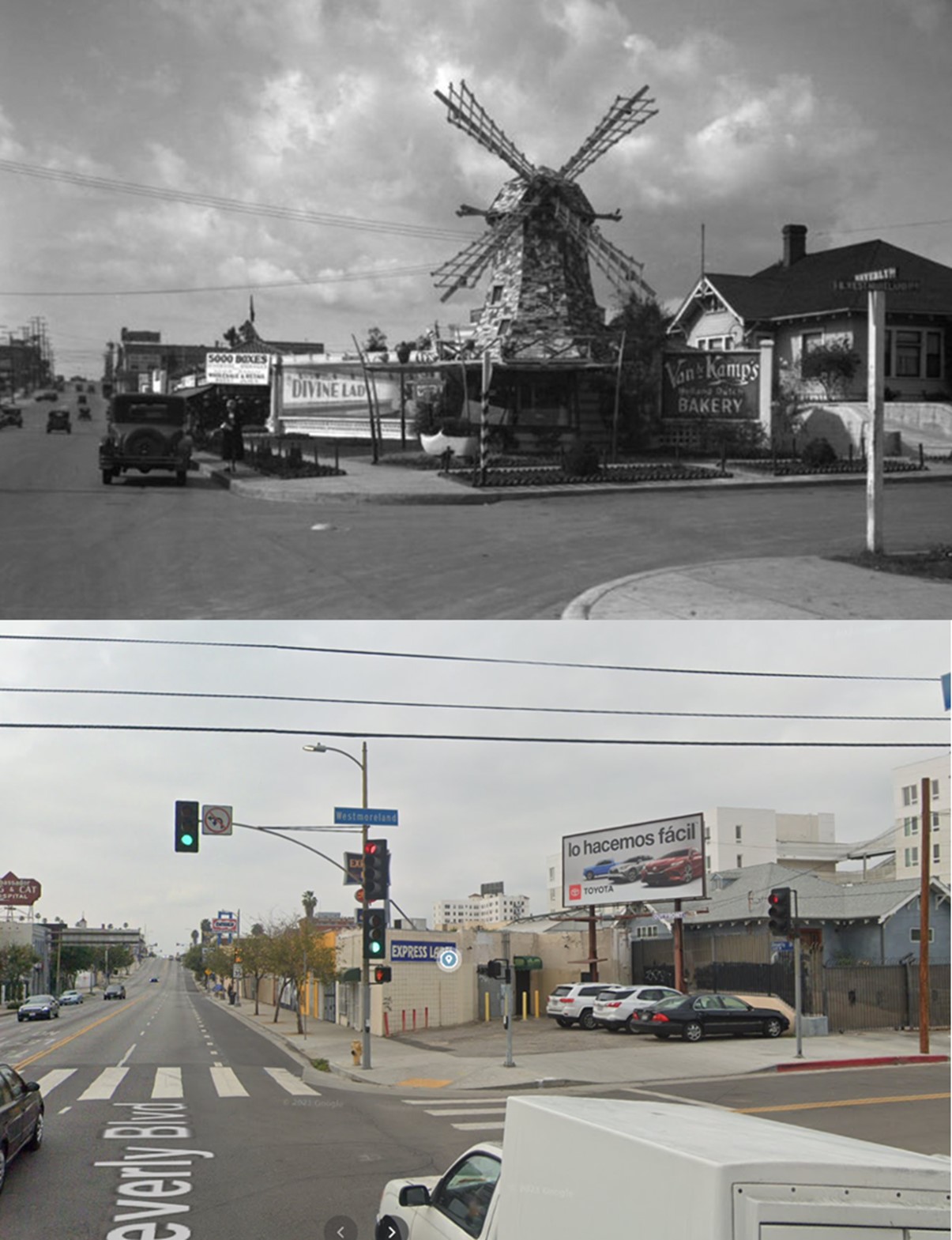 |
|
| (1930 vs. 2021)* - Looking west on Beverly Boulevard at Westmoreland Avenue. Photo comparison by Jack Feldman. |
Historical Notes The 1930 view captures Beverly Boulevard during a period when the street was still developing as a neighborhood commercial corridor. Buildings were modest in scale, closely spaced, and oriented toward pedestrians as well as early automobile traffic. Van de Kamp’s windmill bakery served as a visual anchor at the intersection, helping define the character of the block. In the contemporary view, Beverly Boulevard functions primarily as a high traffic arterial street. The loss of the windmill bakery and surrounding small scale buildings reflects broader changes in land use, where flexibility and automobile accommodation often replaced architectural identity. This comparison highlights how commercial streets in Los Angeles evolved from places designed to attract attention and encourage stopping, into corridors focused on movement and efficiency. The contrast illustrates a shift away from expressive, place making architecture toward more utilitarian development, a pattern repeated throughout the city during the late twentieth century. |
* * * * * |
Tam O'Shanter Inn (originally Montgomery's Country Inn then Montogomery's Chanticleer Inn)
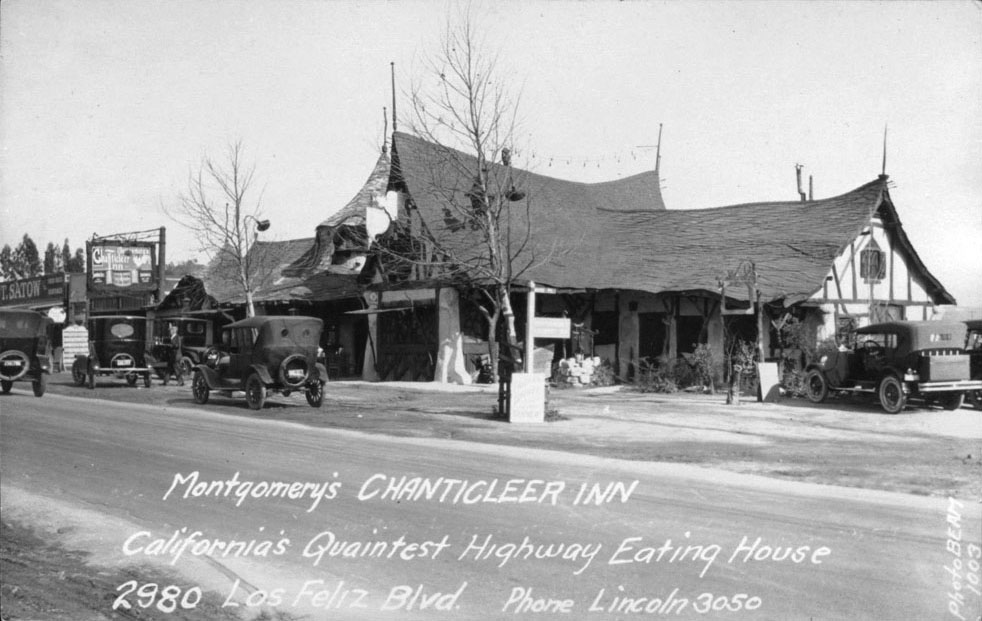 |
|
| (ca. 1924)* - View of the Montgomery's Chanticleer Inn (later Tam O'Shanter Inn) located at 2980 Los Feliz Blvd. |
Historical Notes Montgomery’s Country Inn was built in 1922 by Joe Montgomery partnering with Lawrence Frank and Walter Van de Kamp, founders of Van de Kamp's Holland Dutch Bakeries who also went on to found the Lawry's restaurant chain. They commissioned Harry Oliver to design the building. He constructed the Storybook Style building aided by movie studio carpenters. By 1924, it was known as Montgomery’s Chanticleer Inn, with its quaint tower and small store that sold pretzels, potato chips and the odd mixture of Navajo, Chinese and Italian curios. |
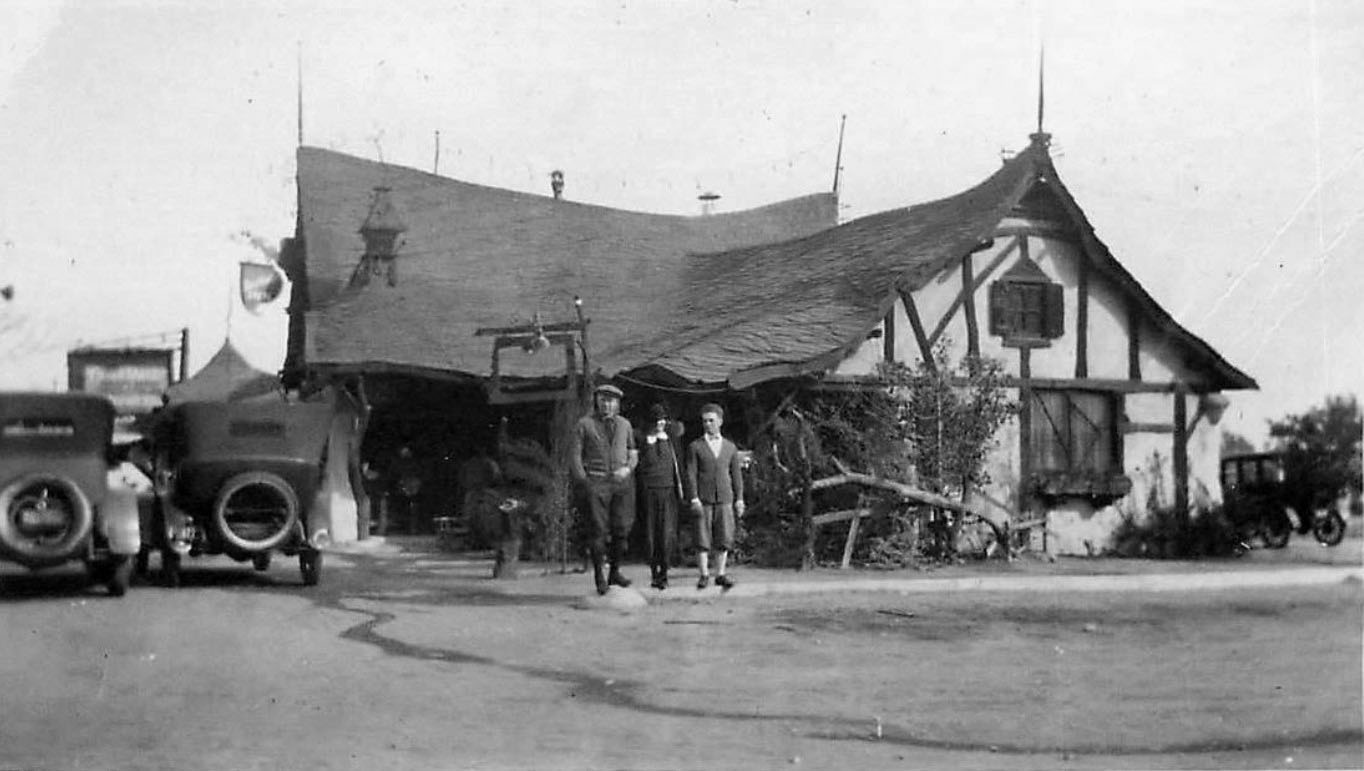 |
|
| (ca. 1924)* - View showing the Tam O'Shanter Inn, previously Montgomery's Chanticleer Inn. |
Historical Notes When Montgomery's Chanticleer Inn failed to thrive, a fellow Rotarian of one of the partners suggested that the restaurant would attract more customers if it adapted a Scottish theme and the name Tam O’Shanter. |
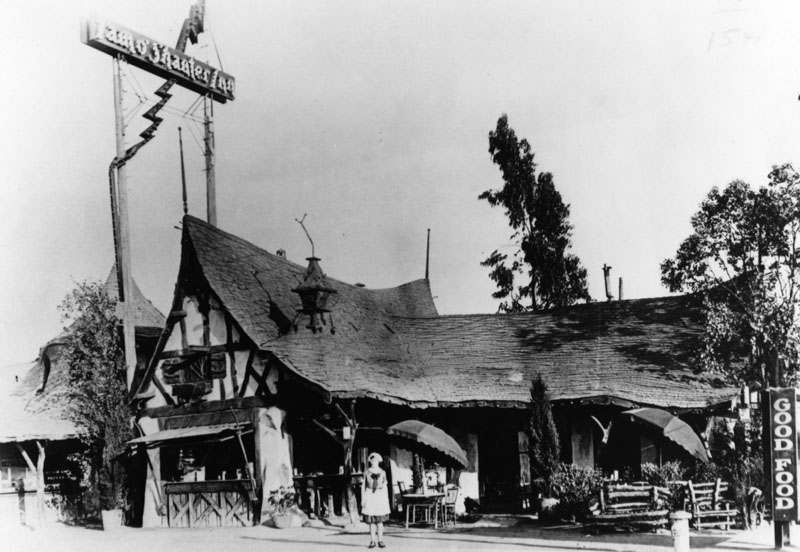 |
|
| (1920s)* - A waitress stands in front of the thatched roof Tam O'Shanter Inn. A sign at extreme right reads "Good Food." At left, a counter area is visible, and in the middle, a door leading to indoor dining. Two umbrellas and tables have been placed outside for outdoor dining. |
Historical Notes The exterior of the Tam O’Shanter has been remodeled many times since, but the initial design seen in the above picture shows the fairy-tale influence; tree trunk and branch columns, topsy-turvy roof lines, knotted wood, wrought iron flourishes and homely chimneys. Owner Lawrence L. Frank, once explained that “every piece of wood which was used in [building the tam] was thrown into fire first with the result that we never had to paint it and it got more beautiful as the years went by.” |
 |
|
| (1930s)* - View of a man sitting at the outdoor counter of the Tam O'Shanter Inn. |
Historical Notes This was Walt Disney’s favorite restaurant. He dined here nearly every week during the 1930s, 40s and 50s. |
.jpg) |
|
| (1930)* – View looking toward the southeast corner of Los Feliz Boulevard and Boyce Avenue showing the Tam O’ Shanter, advertising Malted Milk for 15 cents. Full car service can be seen at center-left, next to the umbrella. |
Historical Notes The Tam O’ Shanter soon became one of the nation’s first drive-ins with special wooden trays that enabled guests to dine in their cars. They called it 'Car Service de luxe'. |
 |
|
| (1930s)* – View showing four people enjoying a tray-served meal inside their car at Tam O’ Shanter. |
Historical Notes From a 1933 advertisement of the newly remodelled Tam o’ Shanter and its drive-in service: “We are happy to welcome you to our remodeled Tam o’ Shanter Inn. Important among the changes made, is the re-establishment of Car Service de luxe – a feature which we originated eight years ago. Ingenious tables installed in your car, enable you to sit and eat in the comfort and privace of your own automobile…” Click HERE to see more Early LA Drive-in Restaurants. |
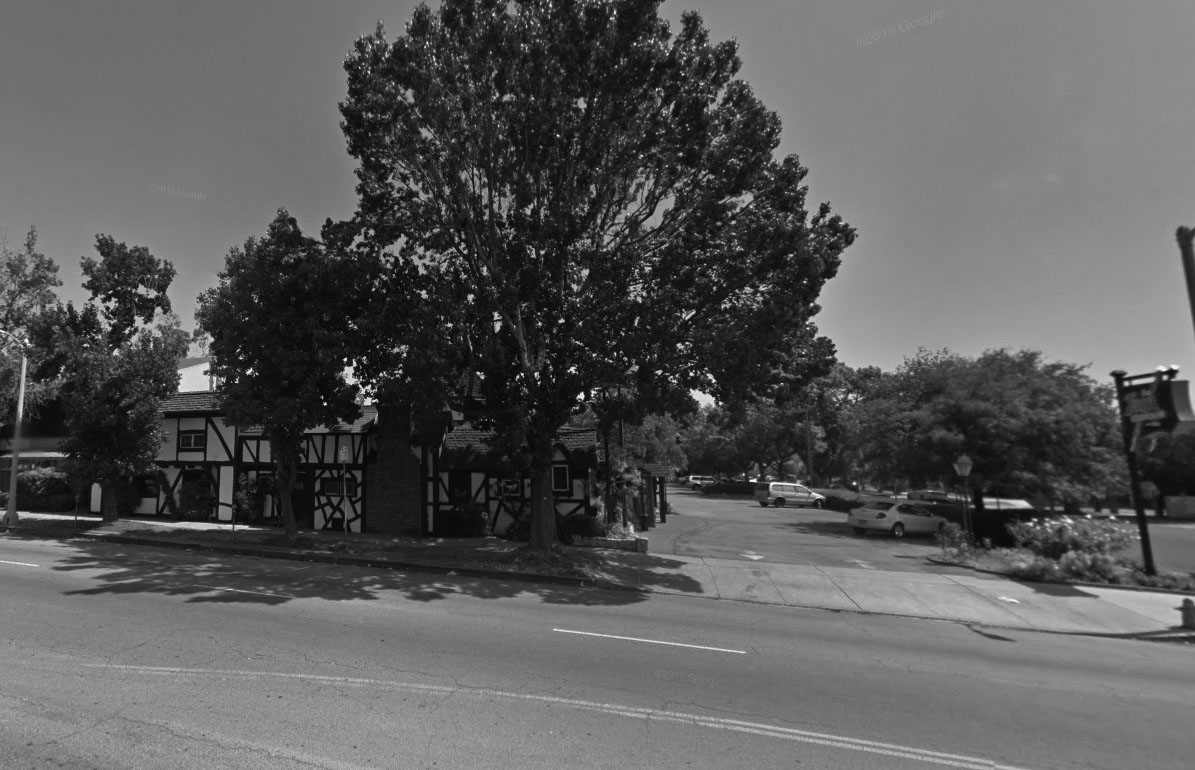 |
|
| (2015)* - Google Street View showing the Tam O'Shanter Restaurant located at 2980 Los Feliz Boulevard. |
Historical Notes The restaurant was remodeled in 1968 and renamed the "Great Scot", but has since been brought back to the its original name "The Tam O'Shanter Inn". The restaurant's decor still features English and Scottish medieval weapons, kilts, and family Coat of Arms and Medieval Family Crests. Opened in June 1922 by the founders of Van de Kamp's Dutch Bakeries and is still around today, making it Los Angeles’ oldest restaurant that has remained in the same location under the same ownership and management. |
* * * * * |
Hal E. Roach Studios
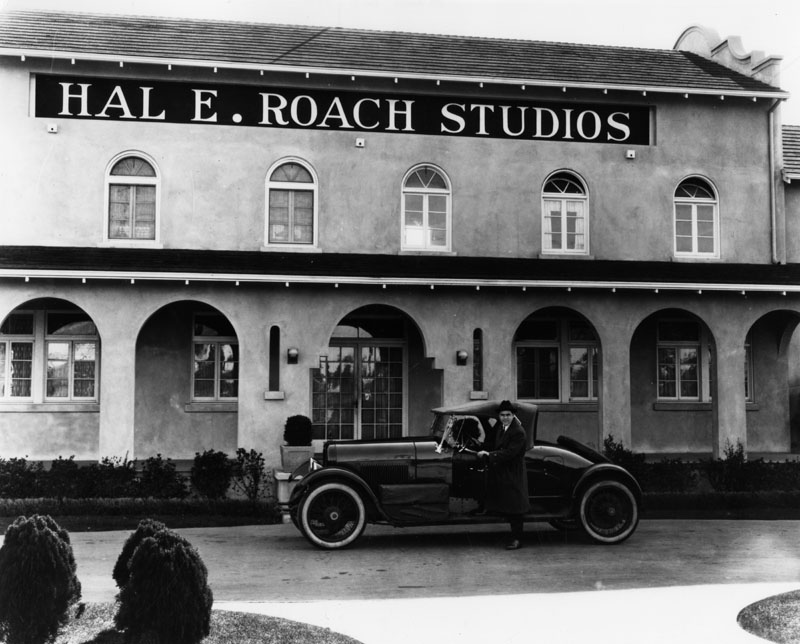 |
|
| (1921)* - Hal Roach (1892-1992) steps out of his car, which is parked outside his Hal E. Roach Studios, located at 8822 Washington Boulevard in Culver City. |
Historical Notes Harold Eugene "Hal" Roach, Sr. was an American film and television producer, director, and actor from the 1910s to the 1990s, best known today for producing the Laurel and Hardy and Our Gang (later known as The Little Rascals) film comedy series. After an adventurous youth that took him to Alaska, Hal Roach arrived in Hollywood in 1912 and began working as an extra in silent films. Upon coming into an inheritance, he began producing short film comedies in 1915 with his friend Harold Lloyd, who portrayed a character known as Lonesome Luke. |
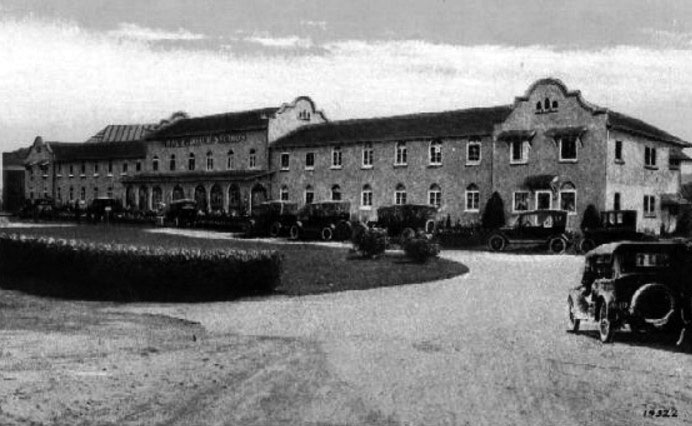 |
|
| (1920s)^* – Postcard view showing a line of cars parked in front of the Hal Roach Studios office buildings. |
Historical Notes Unable to expand his studios in downtown Los Angeles because of zoning, Roach purchased what became the Hal Roach Studios from Harry Culver in Culver City. During the 1920s and 1930s, he employed Lloyd (his top money-maker until his departure in 1923), Will Rogers, Max Davidson, the Our Gang kids, Charley Chase, Harry Langdon, Thelma Todd, ZaSu Pitts, Lupe Vélez, Patsy Kelly and, most famously, Laurel and Hardy. During the 1920s Roach's biggest rival was producer Mack Sennett. In 1925, Roach hired away Sennett's supervising director, F. Richard Jones.^* |
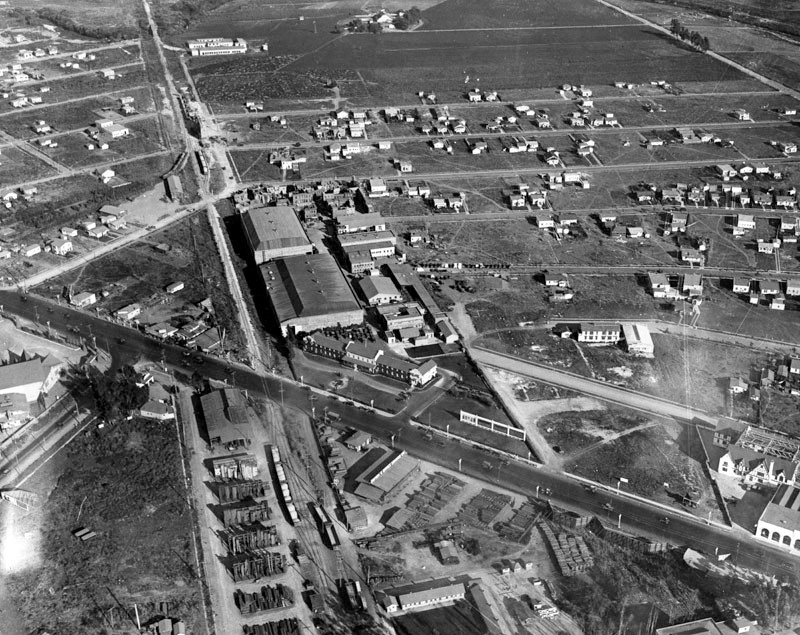 |
|
| (1926)* - Aerial view of the area surrounding Hal Roach Studios, located in the upper left--the second-to-the-largest building with a flat roof, behind which are the outdoor sets, 8822 Washington Blvd. at the corner of Washington and National in Culver City. Most of the Laurel & Hardy movies, the Our Gang shorts, and many Harold Lloyd comedies were made at the studio, |
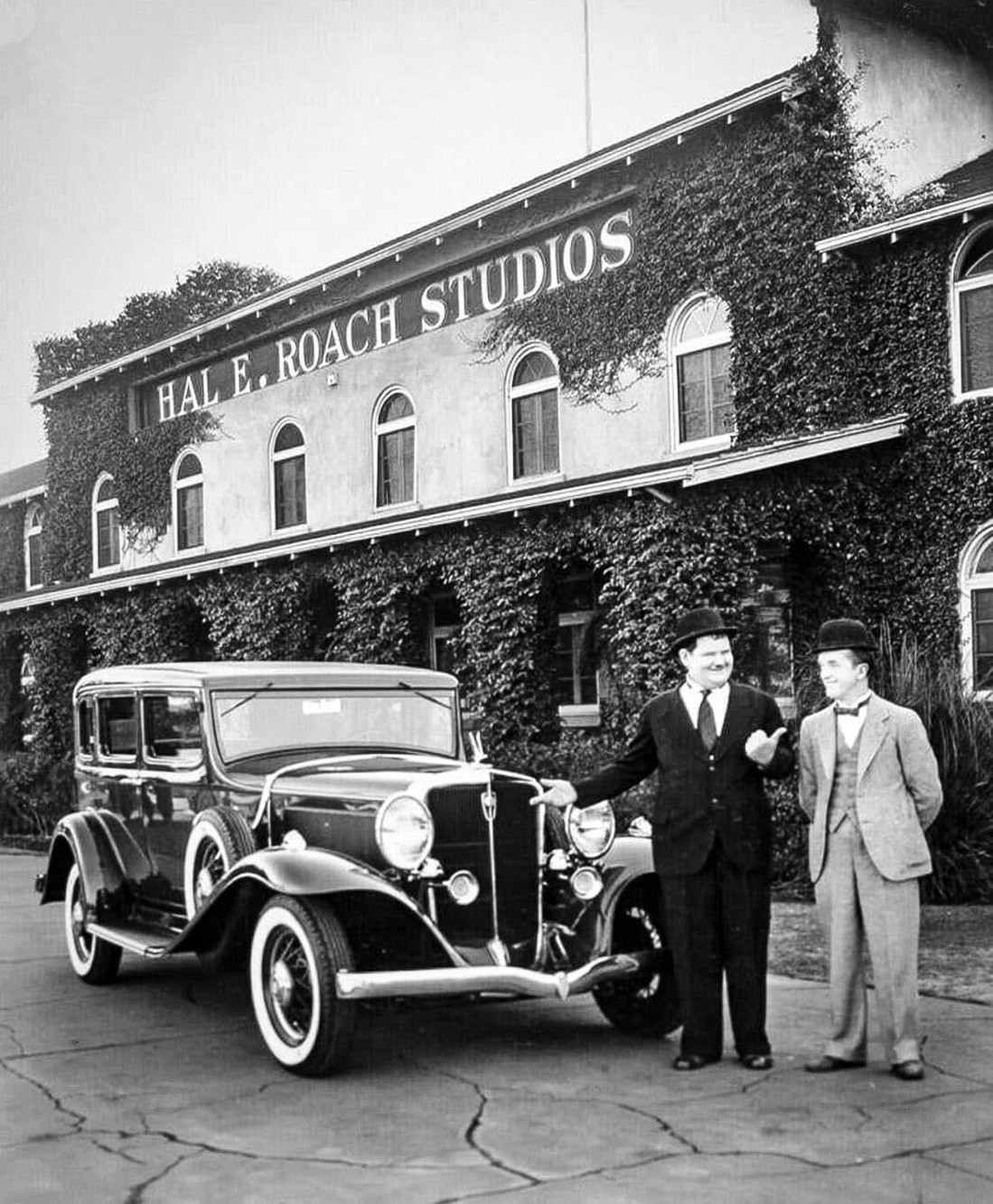 |
|
| (1931)* - Oliver Hardy and Stan Laurel stand next to a Studebaker in front of Hal E. Roach Studios. |
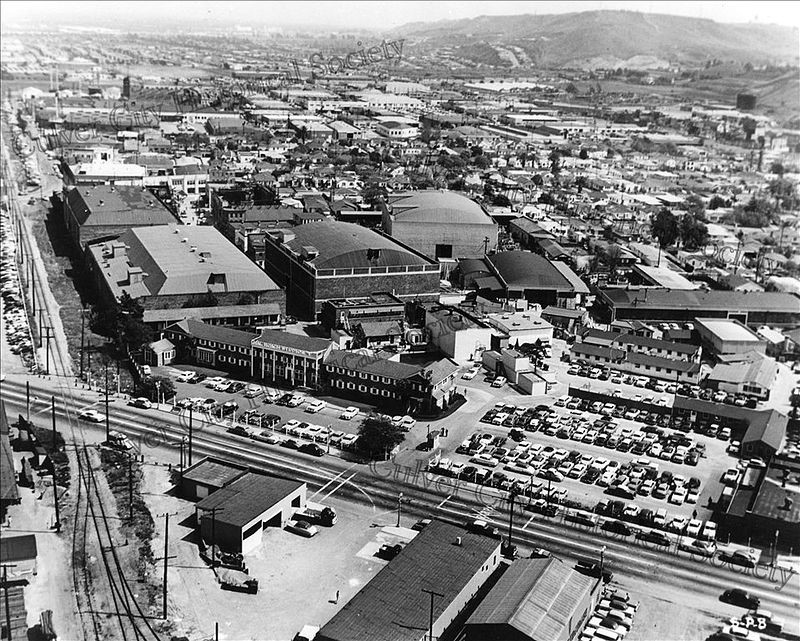 |
|
| (1950s)* - Aerial view of the the Hal Roach Studios and surrounding area. |
Historical Notes The 14.5 acre studio once known as "The Lot of Fun", containing 55 buildings, was torn down in 1963. They were replaced by light industrial buildings, businesses, and an automobile dealership. Today, Culver City's "Landmark Street" runs down what was the middle of the old studio lot, with the two original sound stages having been located on the north side of Landmark Street, and the backlot/city street sets had been located at the eastern end of Landmark Street. A plaque sits in a small park across from the studio's location, placed there by The Sons of the Desert, an international fraternal organization devoted to the lives and films of comedians Stan Laurel and Oliver Hardy.^* |
* * * * * |
San Pedro PE Depot
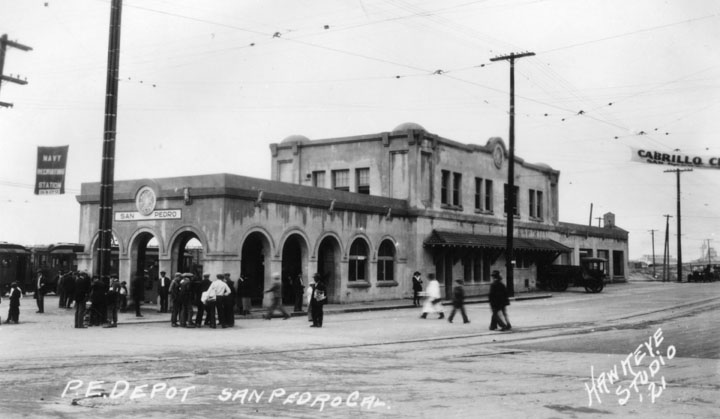 |
|
| (1921)* - Exterior view of the Pacific Electric Railway station in San Pedro. |
Historical Notes PE's two-story San Pedro depot was opened in 1920, and succumbed to the wrecking ball in 1961. The new 6th Station on the Port of Los Angeles Waterfront Red Car Line is located just east of the former PE station site, adjacent to the entrance of the Maritime Museum.*^^* |
Click HERE to see more in Early Views of San Pedro and Wilmington |
* * * * * |
Eagle Rock City Hall
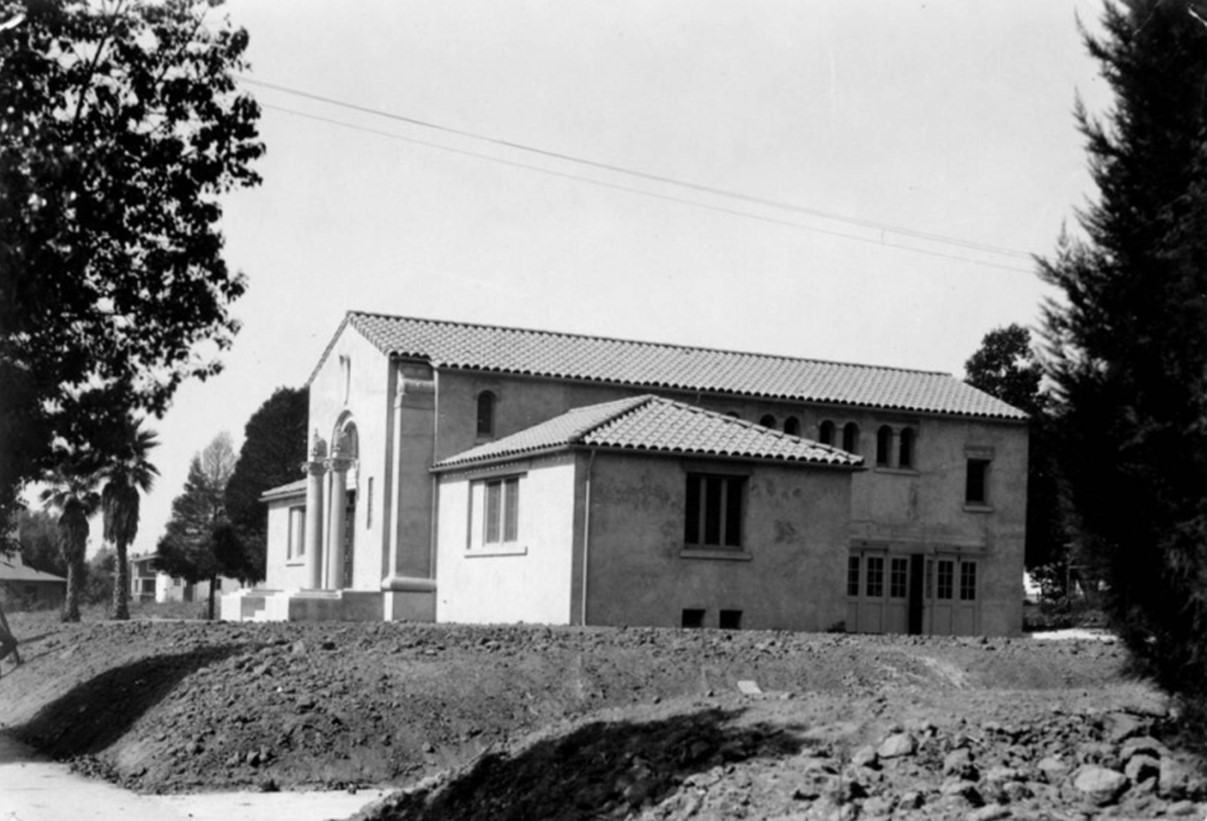 |
|
| (1922)* - Eagle Rock City Hall, probably at time of completion in 1922 because the grounds are not yet landscaped. |
Historical Notes The arrival of Owens Valley water via the Los Angeles Aqueduct and the concurrent depletion of the young city's wells ultimately led the city fathers to agree to annexation by Los Angeles in 1923. Eagle Rock is one of the few cities incorporated by Los Angeles to still have its original pre-annexation City Hall (2035 Colorado Blvd.) and Library (2225 Colorado Blvd.) still standing. Click HERE to see Contemporary View. |
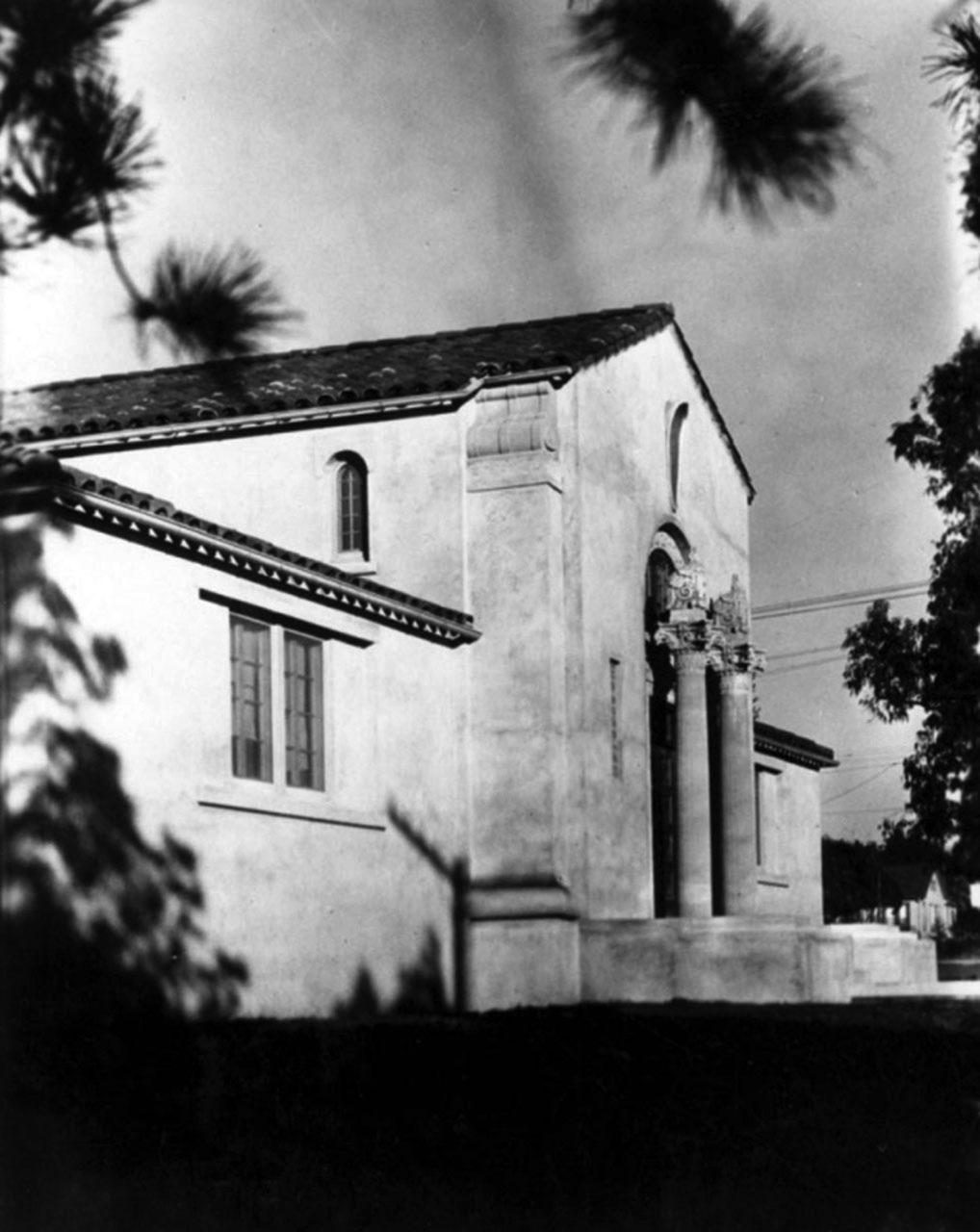 |
|
| (1923)* – Eagle Rock City Hall, showing detail of facade and front entrance. It was built in 1922 and was designed by architect William Lee Woollett. |
Historical Notes Click HERE to see Early Views of Eagle Rock |
* * * * * |
Angelus Temple
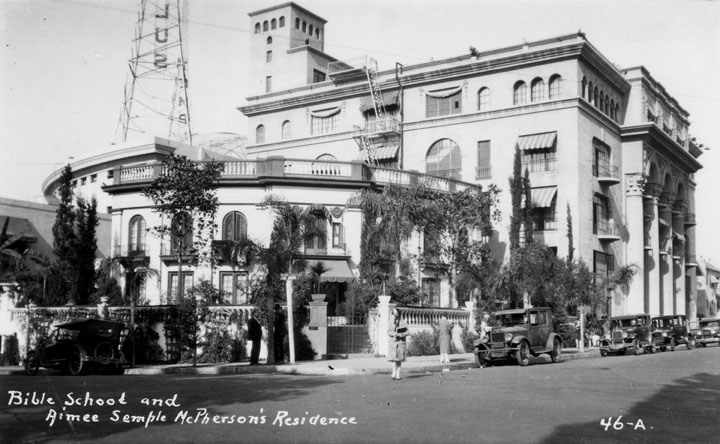 |
|
| (ca. 1922)* - Exterior view of the bible school and residence of Aimee Semple McPherson, founder of the Foursquare Church, located at Park Avenue and Lemoyne in Echo Park, adjacent to the Angelus Temple. |
Historical Notes Aimee Semple McPherson was a Canadian-American Los Angeles–based evangelist and media celebrity in the 1920s and 1930s. She founded the Foursquare Church which worshipped at the Angelus Temple adjacent to the bible school seen above. |
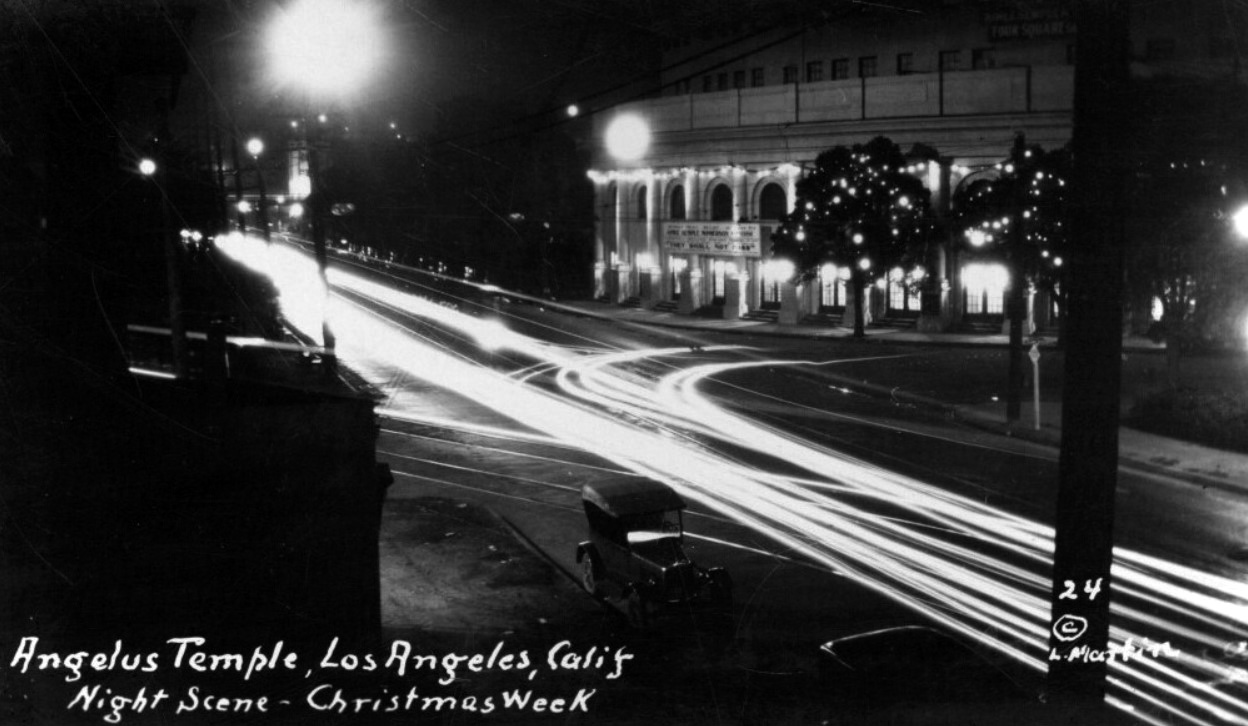 |
|
| (1920s)**# – Night time view of Angelus Temple located at 1100 Glendale Boulevard in Echo Park. |
Historical Notes Angelus Temple was the central house of worship of the International Church of the Foursquare Gospel. It was constructed in 1922 and dedicated on January 1, 1923. Located opposite Echo Park Lake, the temple had an original seating capacity of 5,300, huge for a church then and now, but suited well for the crowds McPherson attracted as an evangelical sensation of the 1920s and 1930s. |
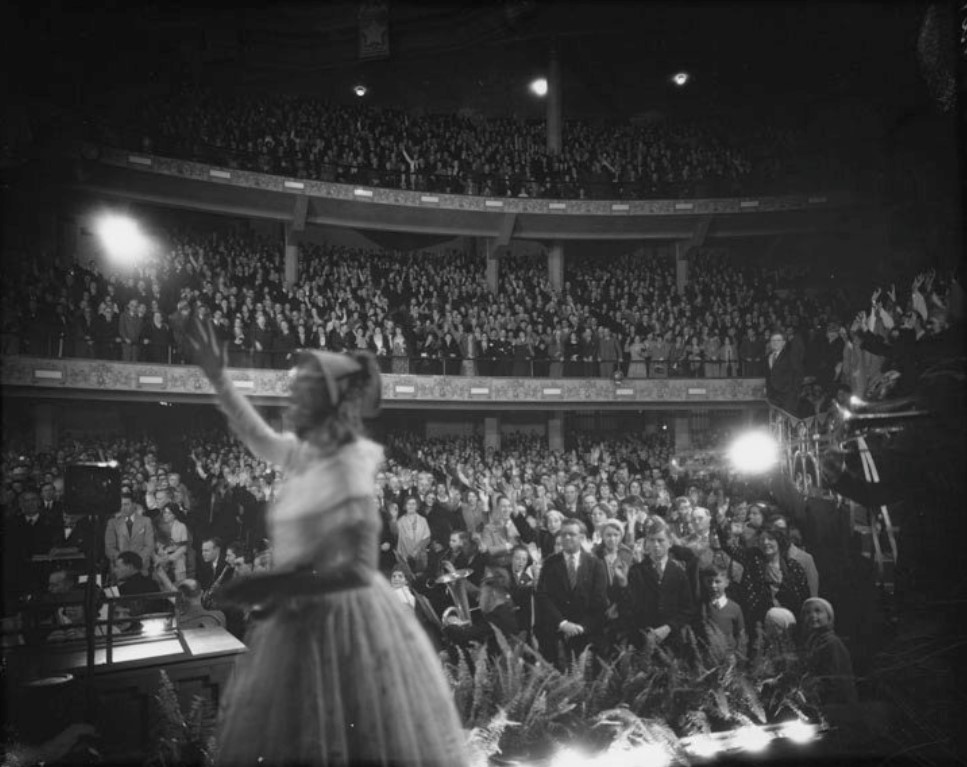 |
|
| (1930)^*^# - Evangelist Aimee Semple McPherson leading a song during Foursquare Gospel church service at the Angelus Temple. |
Historical Notes In her time she was the most publicized Christian evangelist, surpassing Billy Sunday and her other predecessors. She conducted public faith-healing demonstrations before large crowds, allegedly healing tens of thousands of people. McPherson's articulation of the United States as a nation founded and sustained by divine inspiration continues to be echoed by many pastors in churches today. News coverage sensationalized misfortunes with family and church members; particularly inflaming accusations she had fabricated her reported kidnapping, turning it into a national spectacle. McPherson's preaching style, extensive charity work and ecumenical contributions were a major influence in revitalization of American Evangelical Christianity in the 20th century. |
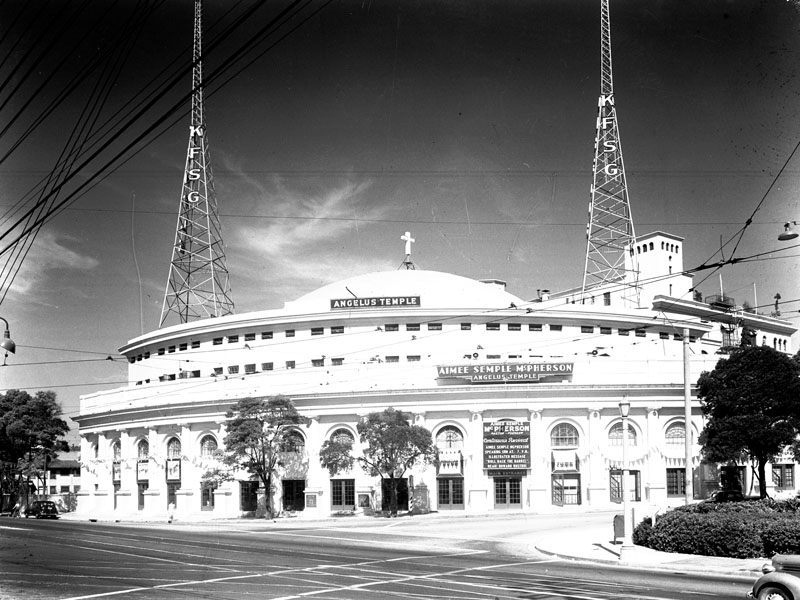 |
|
| (ca. 1934)* - Exterior view of Angelus Temple located at Glendale Boulevard and Park Avenue in Echo Park. The marquee reads: "Continuous Revival." The radio towers for the church's radio station, KFSG, are visible on the roof. |
Historical Notes McPherson has been noted as a pioneer in the use of modern media, especially radio, and was the second woman to be granted a broadcast license. She used radio to draw on the growing appeal of popular entertainment in North America and incorporated other forms into her weekly sermons at Angelus Temple.^* |
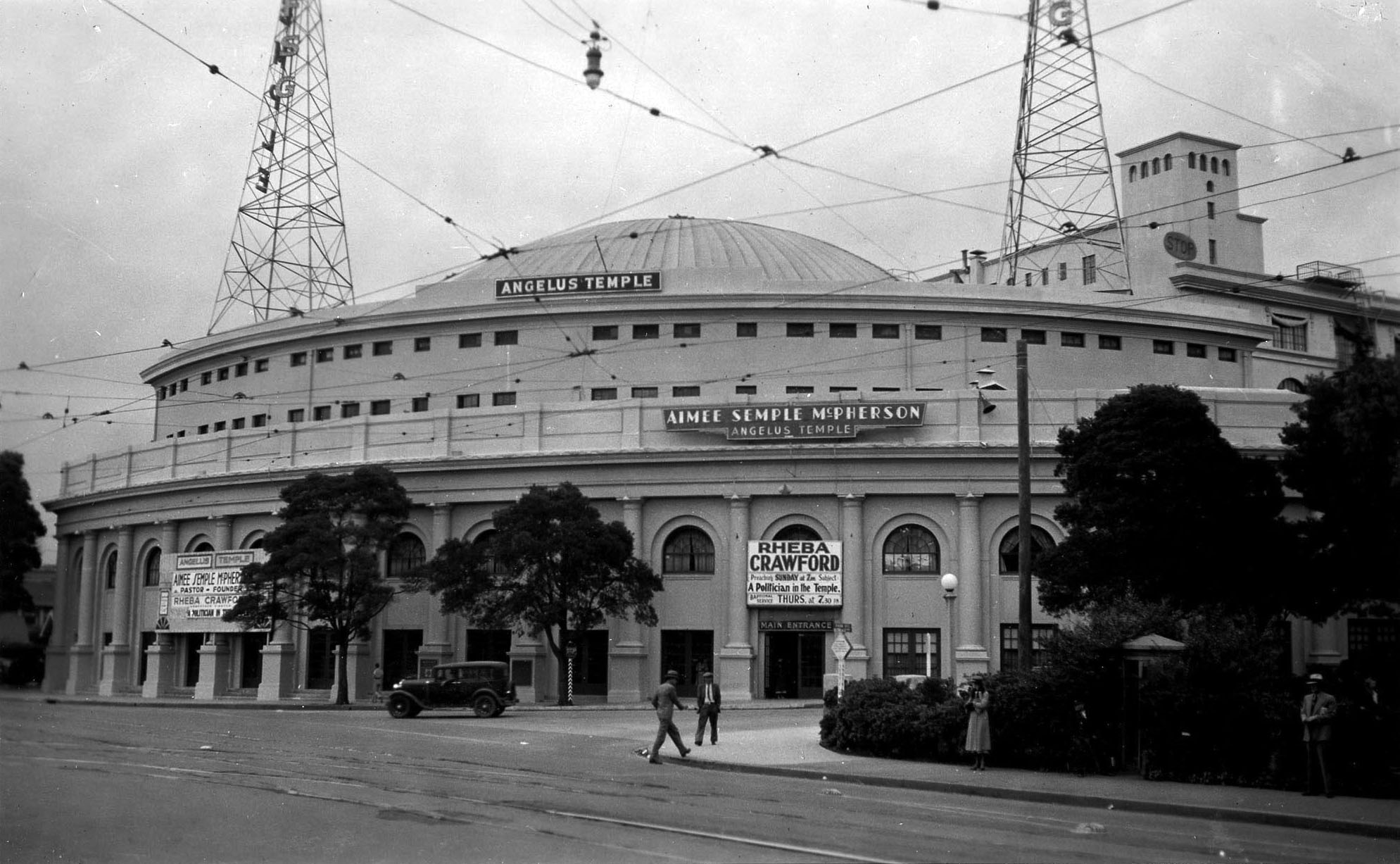 |
|
| (1935)^*# - View showing the Angelus Temple located on the northeast corner of Glendale Boulevard and Park Avenue. Echo Park is seen on the right. Sign over the doorway reads ‘Rheba Crawford’. |
Historical Notes Rheba Crawford Splivalo, known as the "Angel of Broadway," was appointed associate pastor of Angelus Temple in 1935. In 1937, she was involved in a long and contentious slander suit as the result of her ouster from the temple. McPherson had circulated rumors that Crawford was not as “pure as the wind-driven snow” as she portrayed and had characterized her as something of a slut, which her enemies grabbed on to and used. This didn’t prevent Reba Crawford from taking to the airwaves with a weekly commentary on the political goings-on around L.A. City Hall and Sacramento as well as filing a $1 million suit for slander, which was later settled.^ |
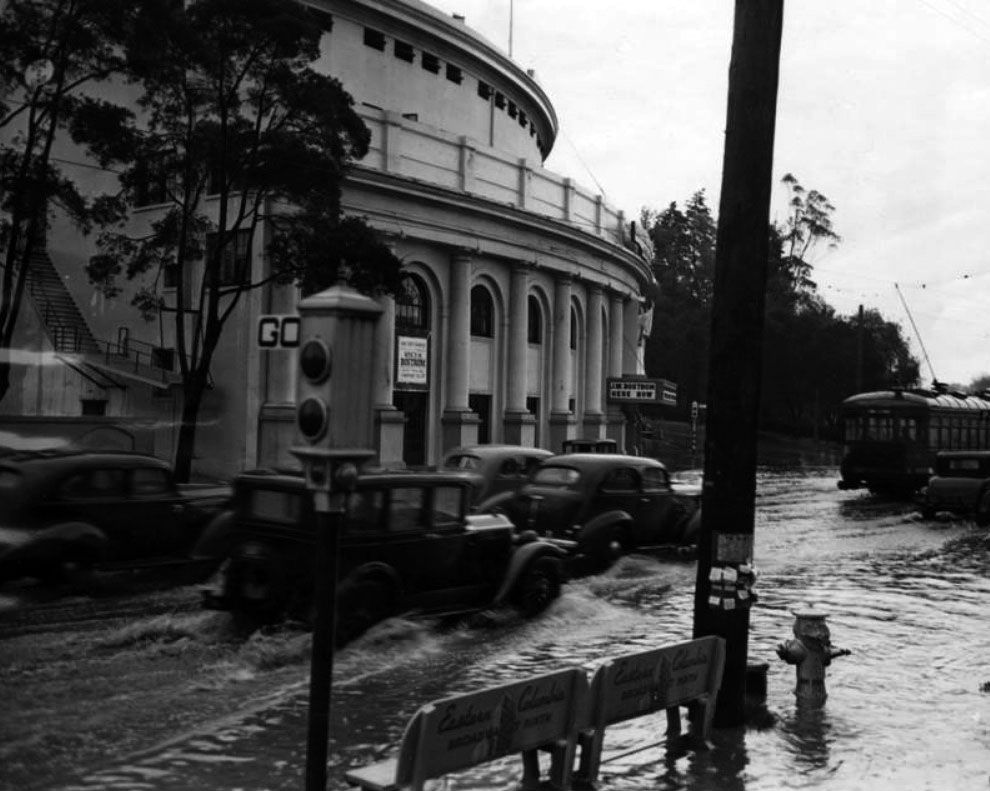 |
|
| (1940)*- Cars are shown sloshing through the flooded street in front of Angelus Temple in Echo Park on February 1, 1940. Streets in a number of parts of the city were flooded. Note the old-style traffic signal with semaphore arms. |
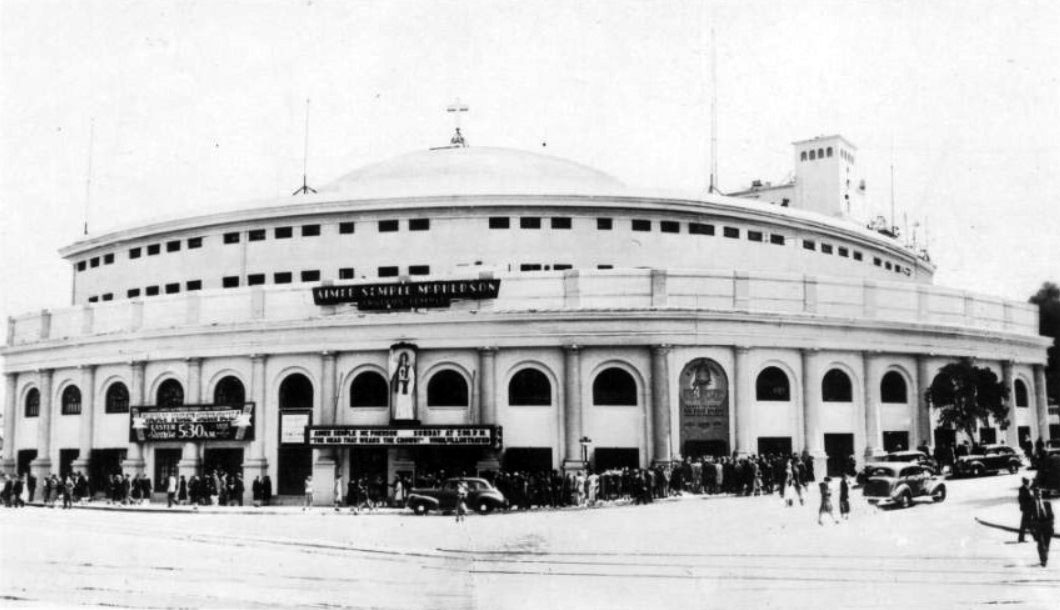 |
|
| (1940s)#^^ – Postcard view of the Angelus Temple just as services are being let out. |
Historical Notes The Angelus Temple was the largest construction of its time in North America, rising "125 feet from the main floor". A panorama of clouds, which was the work of artist Anne Henneke, adorns the ceiling, and the temple has eight stained glass windows depicting the life of Jesus Christ, created by artist George Haskins.^* |
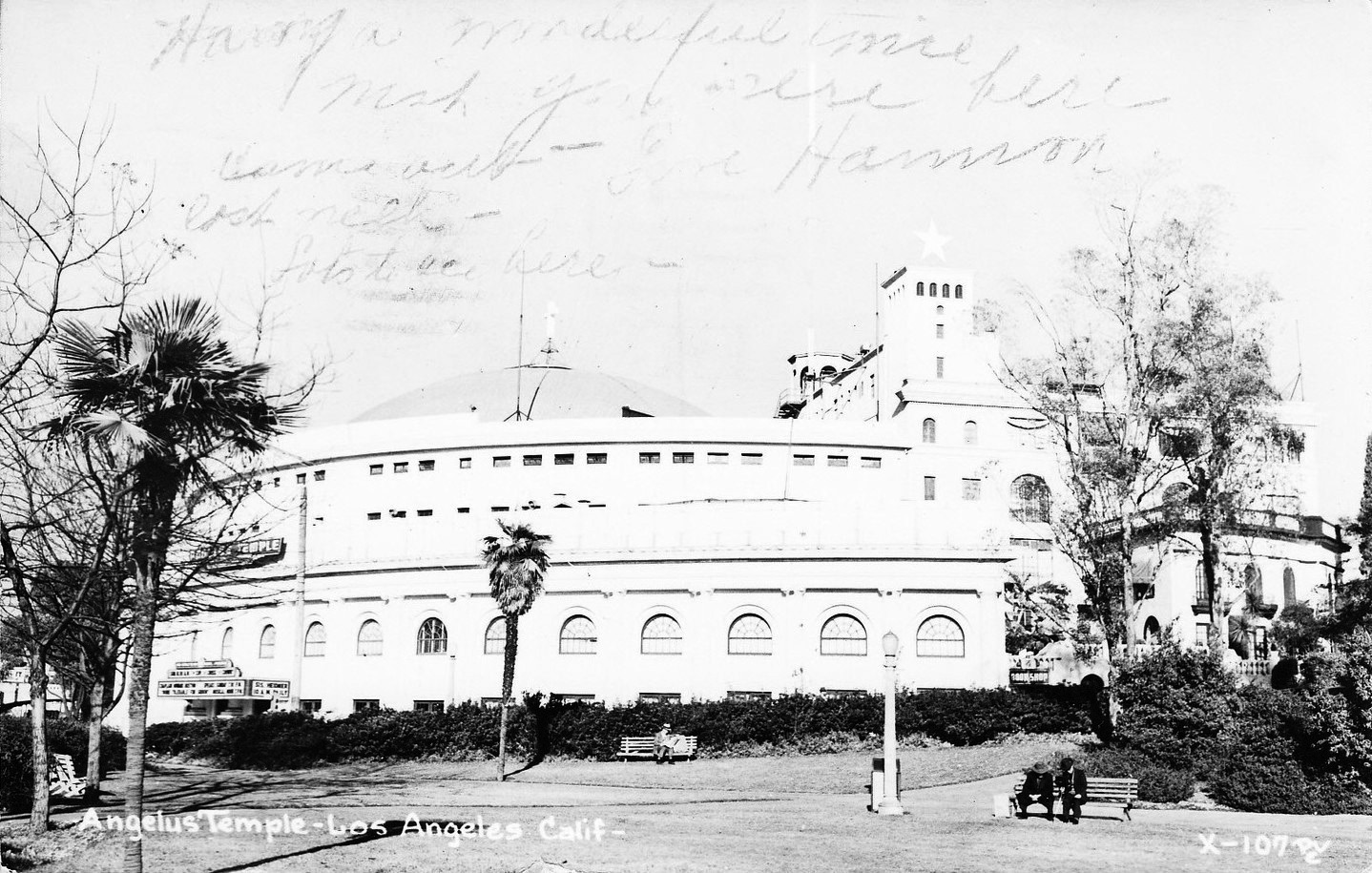 |
|
| (n.d.)**# – Postcard view showing men sitting on benches at Echo Park. Across the street (Park Avenue) stands Angelus Temple, left, and bible school and residence of Aimee Semple McPherson on the right. |
Historical Notes Angelus Temple underwent renovations in 1972, while still retaining its original interior and exterior appearance. The lighted cross atop the temple's dome is a longstanding landmark. |
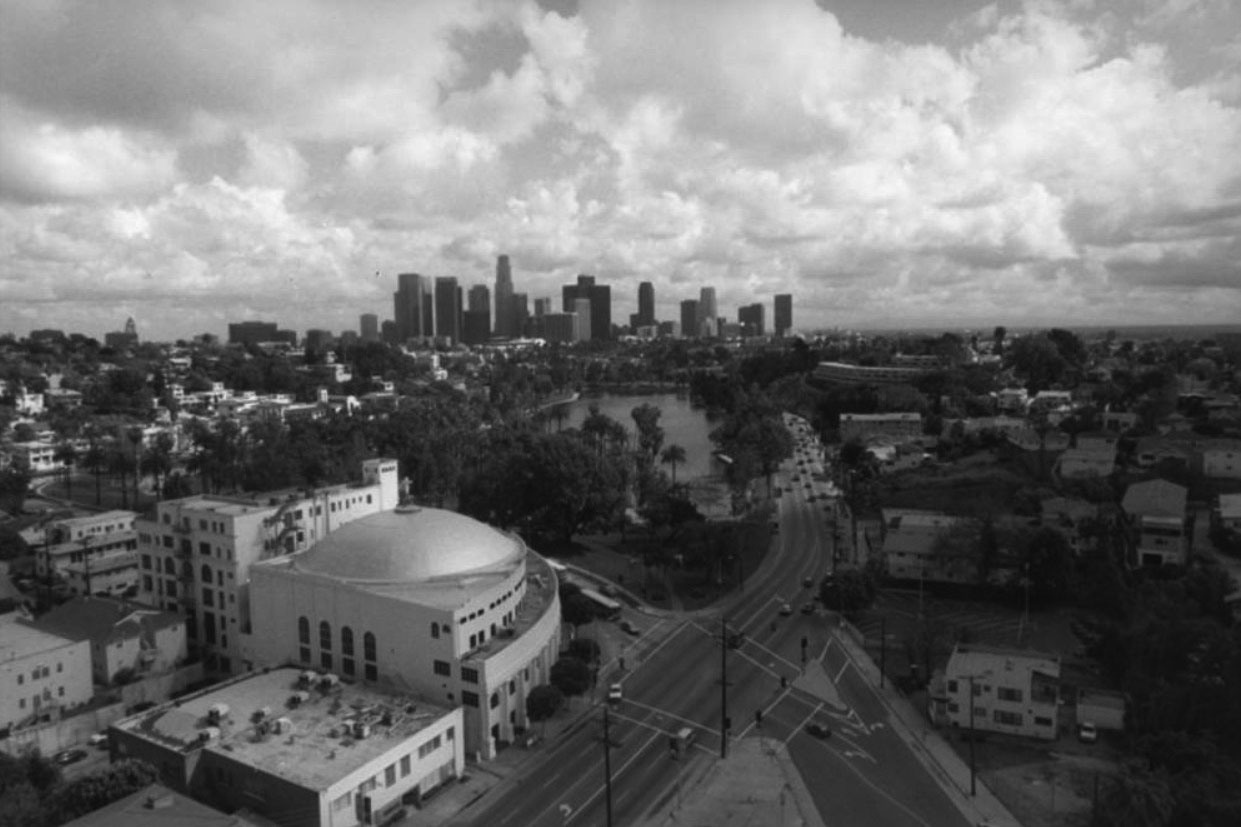 |
|
| (1998)* - Echo Park and its Lake are visible in the center of the photo, the famed Angelus Temple with its domed roof can be seen on the lower left, and Downtown L.A. skyscrapers sit majestically in the background. |
Historical Notes Angelus Temple was dedicated on January 1, 1923. It was added to the National Register of Historic Places in 1992, Building #92001875. On July 2002 the historic Temple completed major renovations, returning it to the classic and elegant look of the 1920's while also making it modern enough to have contemporary services suitable for today, without changing its historic elements. Nearly century-old homes, hillside bungalow courts, apartment buildings and pubic stairways also surround the landmark Echo Park. The visible street running along Angelus Temple and Echo Park is Glendale Boulevard. Click HERE to see more Early Views of Echo Park (1894+). |
* * * * * |
Rose Bowl Stadium
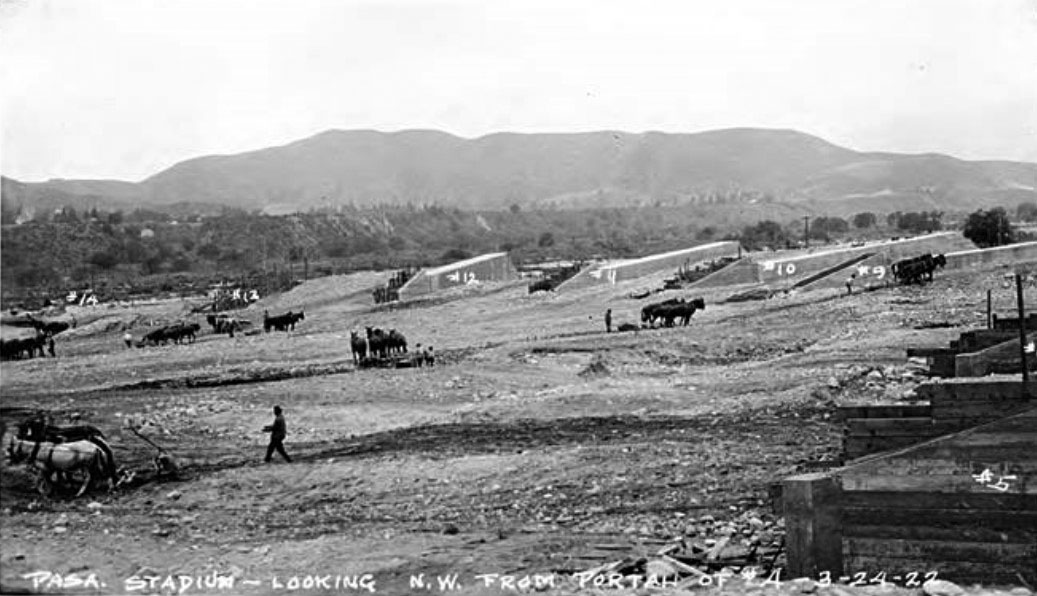 |
|
| (1922)* – View showing the early stages of construction of the Rose Bowl. The numbered structures are the tunnels, which were completed first. |
Historical Notes The idea for the Rose Bowl stadium emerged from the growing popularity of the annual Tournament of Roses football game. On March 20, 1920, the Tournament of Roses Association decided to build a stadium in Pasadena that could accommodate up to 100,000 spectators. Architect Myron Hunt, a member of the Association and respected local designer, was chosen to create the stadium's plans. In 1920, City officials declared the football facilities at Tournament Park unsafe for the growing New Year’s Day crowds. Ten-year $100 box seats were sold to raise funds for construction of a new facility. |
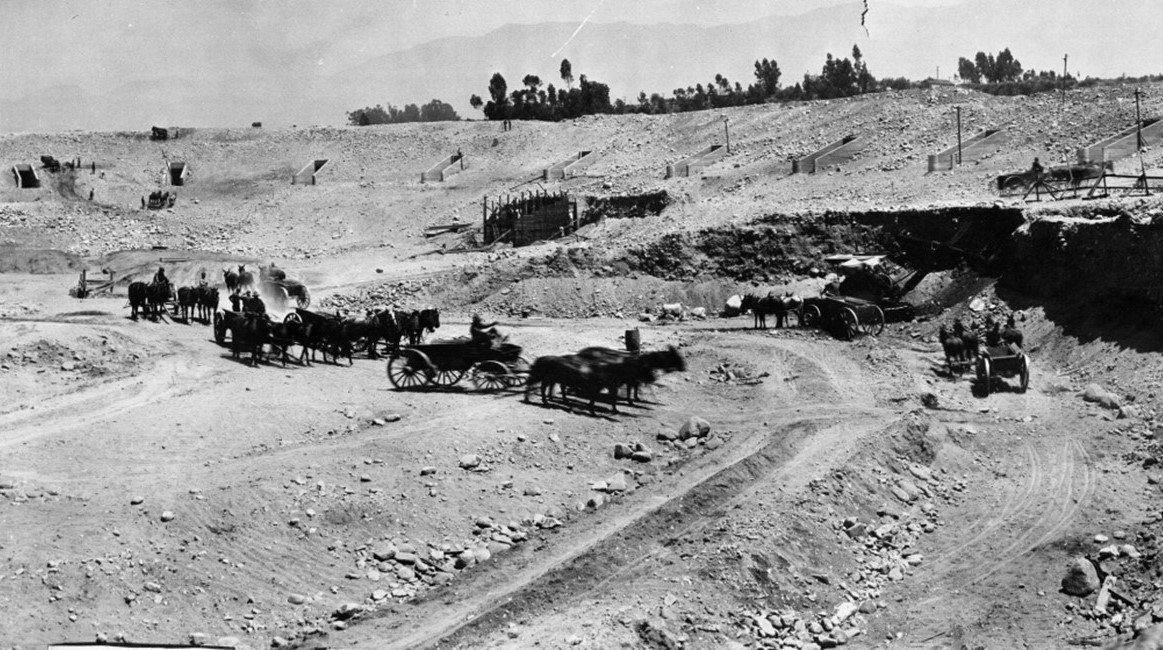 |
|
| (1922)* – Horse-drawn wagons haul off dirt during construction of the Rose Bowl Stadium. |
Historical Notes Construction of the Rose Bowl began on February 27, 1922, and was completed in just nine months, finishing in October 1922. The project employed a team of men and donkeys to dig and haul dirt, as well as to transport local river rock for the foundation. The stadium was built in the Arroyo Seco area of Pasadena, selected for its natural bowl-like topography. |
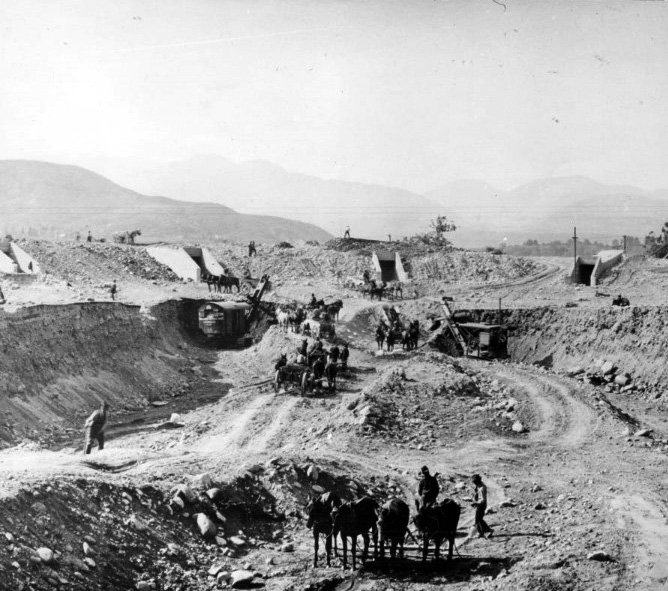 |
|
| (1922)* - The Pasadena Rose Bowl under construction in the Arroyo Seco. Construction began on February 27, 1922, following planning and design work completed in 1920 and 1921. |
Historical Notes The stadium was designed by architect Myron Hunt in 1921. His design was influenced by the Yale Bowl in New Haven, Connecticut, which was built in 1914. The Arroyo Seco dry riverbed was selected as the location for the stadium. |
 |
|
| (1922)* – View showing the Rose Bowl seats being assembled in the early stages of construction. |
Historical Notes Early construction focused on forming the concrete seating sections, tunnels, and access points. When completed in 1922, the stadium had an initial seating capacity of approximately 57,000 and was open at the southern end, forming a horseshoe shape. |
 |
|
| (1922)* - View looking west toward the San Rafael Hills showing horse-drawn wagons removing dirt and rock during construction. |
Historical Notes The rugged terrain of the Arroyo Seco required careful grading and planning. Roads, drainage systems, and utilities were integrated into the uneven canyon floor during construction. |
.jpg) |
|
| (1922)* - Another view showing the construction work on the Rose Bowl. |
Historical Notes Despite these environmental and structural challenges, the construction team successfully transformed this natural canyon into one of the most iconic sports venues in the United States. The Rose Bowl not only became an architectural marvel but also preserved the natural beauty of its original setting. |
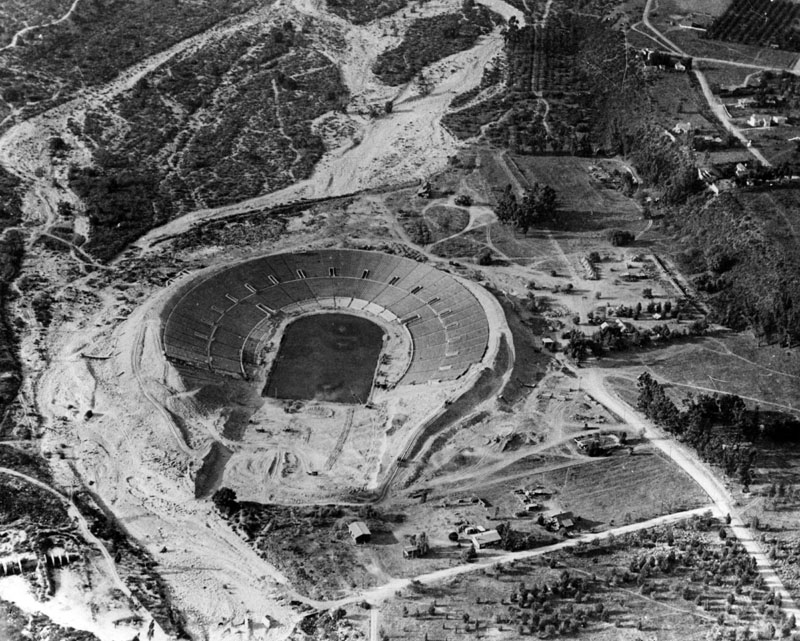 |
|
| (1922)* - Aerial view showing the Rose Bowl taking on its original horseshoe shape. |
Historical Notes The Rose Bowl was under construction for about a year. The stadium was designed to bring spectators close to the field while maximizing capacity within the natural bowl. Construction costs came in under budget, allowing funds to be reserved for future expansion. |
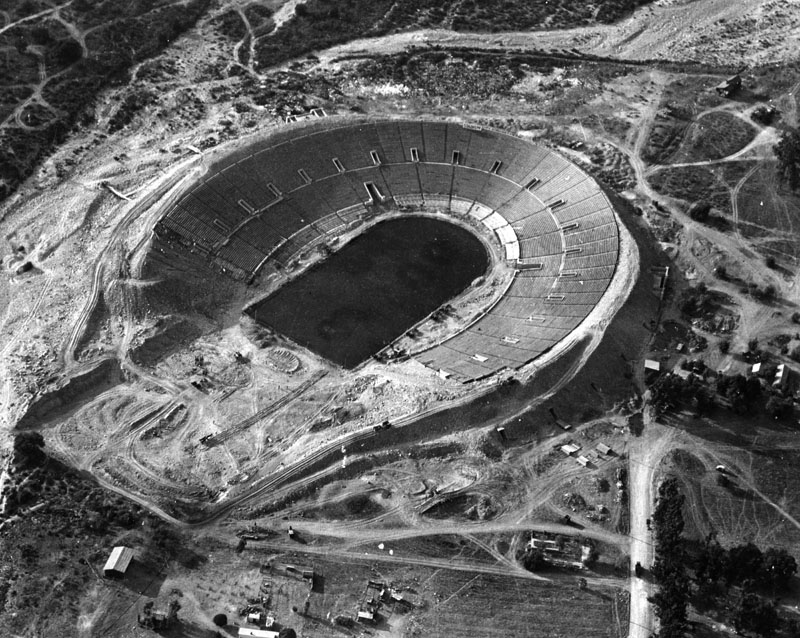 |
|
| (1922)* - A closer aerial view of the Rose Bowl under construction. |
Historical Notes The Rose Bowl was completed in October 1922, just several months prior to the completion of the nearby Los Angeles Memorial Coliseum, May 1923. The first game was a regular season contest on October 28, 1922 when Cal defeated USC 12–0. This was the only loss for USC and California finished the season undefeated. California declined the invitation to the 1923 Rose Bowl game and USC went in their place. |
Then and Now
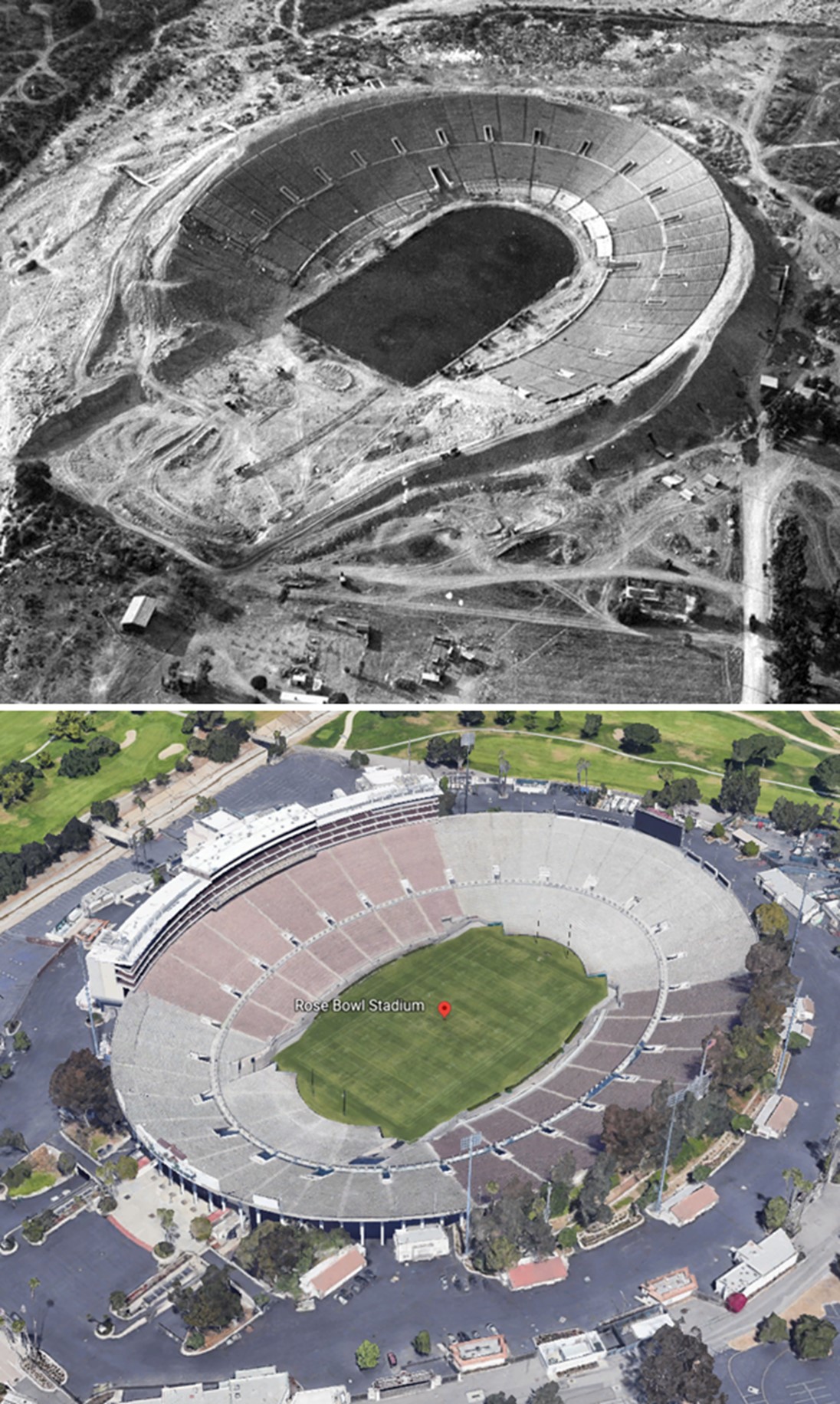 |
|
| (1922 vs. 2022)* - Then and Now. Photo comparison by Jack Feldman. |
Historical Notes The Rose Bowl stadium has undergone significant changes since its original construction in 1922, evolving from an open horseshoe into a complete bowl. Major renovations, including work completed in 2016, modernized the facility while preserving its historic character. |
 |
|
| (1923)* - Panoramic view of the 1923 Rose Bowl Game between Penn State University and the University of Southern California at the Rose Bowl Stadium in Pasadena. The stands are almost filled, with the exception of some of the higher areas on the far side of the stadium. Small groups of what appear to be military men are seated on chairs on the track surrounding the field. The game is in progress, with the two teams in the middle of a series near midfield. There are men positioned at several places along the near sideline with photographic cameras, and one man near midfield has a motion picture camera. There is a very tall flag pole on the far right with a large American flag. A large number of automobiles are parked on the far right, beyond the open part of the stadium, where there are also a couple hundred people watching the game over the stadium fence. |
Historical Notes January 1, 1923 was the first time that the Rose Bowl Game was held at the Rose Bowl Stadium. The game featured Penn State University and the University of Southern California. Start of play was delayed more than an hour when Penn’s team was stuck in traffic. USC would go on to defeat Penn State 14 to 3. The name of the stadium was alternatively "Tournament of Roses Stadium" or "Tournament of Roses Bowl", until being settled as "Rose Bowl" before the 1923 Rose Bowl game. Click HERE to see more in Early Views of USC. |
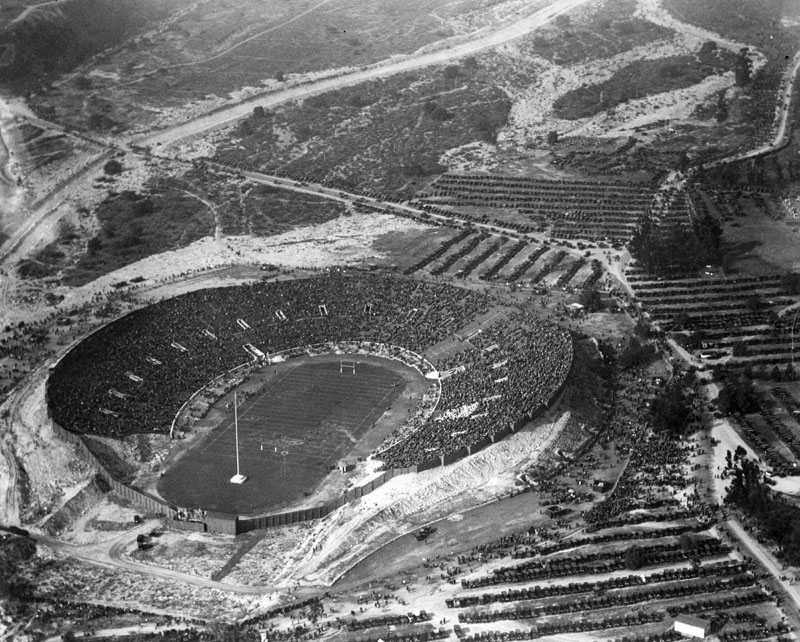 |
|
| (1925)* - Aerial view of the Rose Bowl on New Years Day, January 1, 1925. The stadium is almost full, yet crowds of people are still walking in. The football score that day was: Notre Dame, 27 vs Stanford, 10. |
Historical Notes Originally built as a horseshoe, the stadium was expanded several times over the years. The southern stands were completed in 1926, making the stadium a complete bowl. |
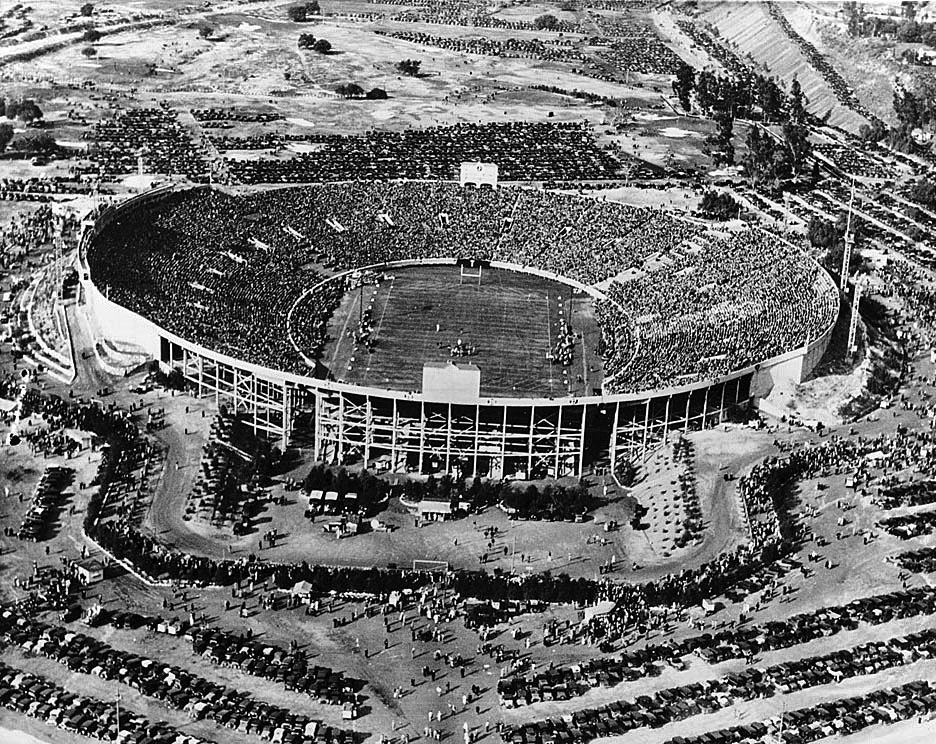 |
|
| (1926)* - Aerial view looking north showing the 1926 Rose Bowl game. |
Historical Notes The 1926 Rose Bowl Game is commonly referred to as "the game that changed the south." The game featured the Alabama Crimson Tide, making their first bowl appearance, and the Washington Huskies. Alabama was victorious 20–19, as they scored all twenty points in the third quarter. With the victory, the Crimson Tide was awarded its first National Championship. The game made its radio broadcast debut, with Charles Paddock, a sports writer and former Olympian track star, at the microphone. Alabama’s coach, Wallace Wade, was later inducted into the Rose Bowl Hall of Fame (1990). |
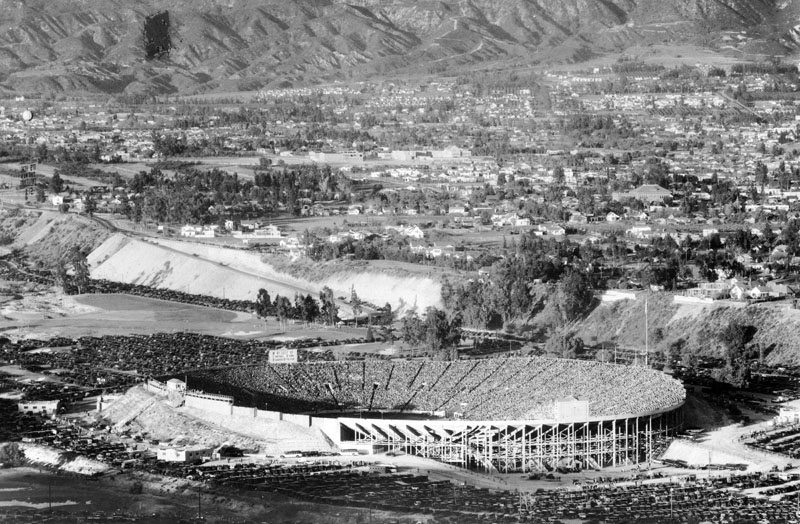 |
|
| (ca. 1928)* - Aerial view of the Rose Bowl after the southern stands were constructed making it a complete bowl. Though the stadium appears to be filled to capacity, people are still trickling in, and row upon row of automobiles can be seen neatly parked in the lots. View also shows the residential homes surrounding the stadium, as well as the mountains in the background. |
Historical Notes For many years, the Rose Bowl had the largest football stadium capacity in the United States. From 1972 to 1997, seating capacity reached 104,594. The current official seating capacity is 92,542. The stadium was designated a National Historic Landmark in 1987. |
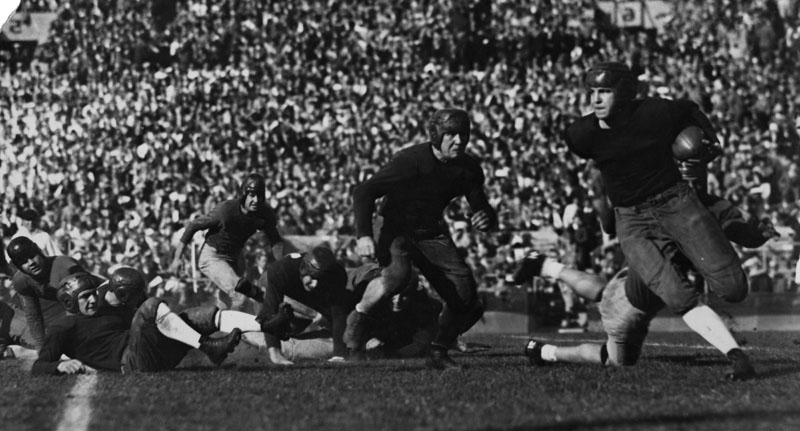 |
|
| (1929)* - Georgia Tech player Mizell carries the ball during the Rose Bowl Game, January 2, 1929. |
Historical Notes The January 2, 1929 Rose Bowl Game featured Georgia Tech and the University of California. Georgia Tech won the closely contested game by a score of 8 to 7. |
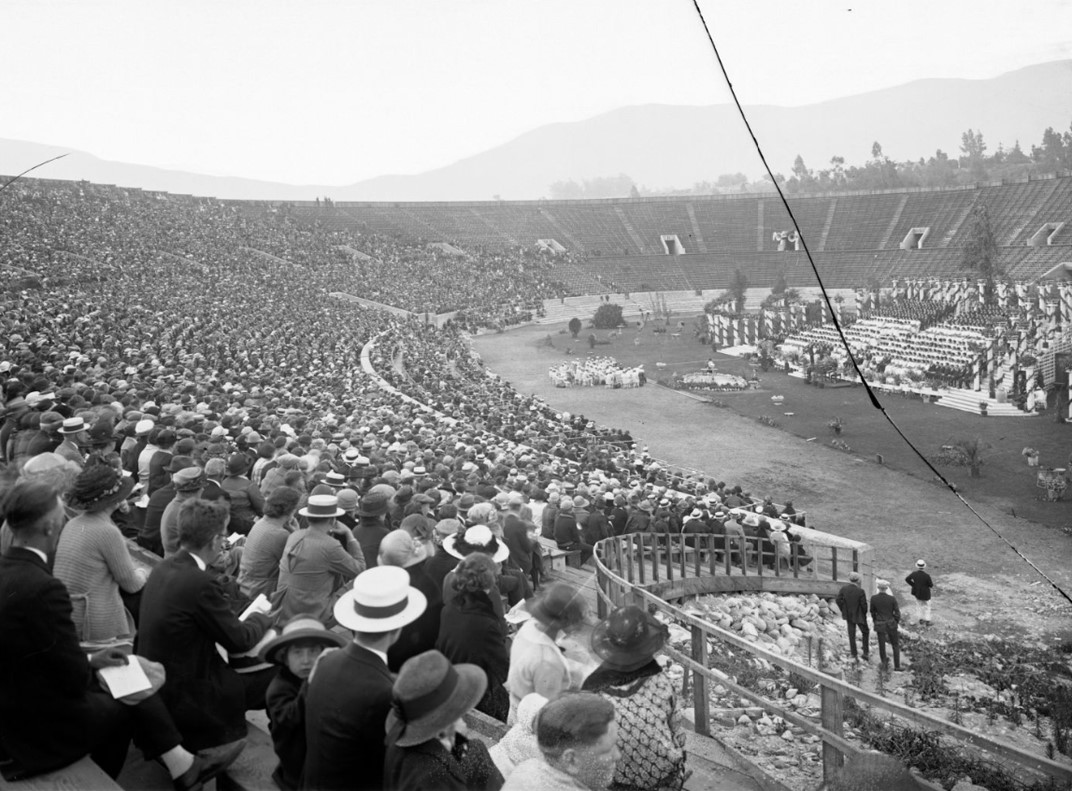 |
|
| (ca. 1924)* - A view of the Pasadena High School commencement ceremony at the Rose Bowl. A large crowd of spectators fills about half of the stadium. There are freestanding white bleachers on the far side which are occupied by the students, and a band is on the field in front of them. |
Historical Notes Today, the stadium still hosts commencement ceremonies for John Muir High School and Pasadena High School. It also hosts the annual football homecoming game, called the Turkey Tussle, between Pasadena High School and John Muir High School, in mid-November. Click HERE to see more Early Views of the Rose Bowl (1930s & 1940s). |
* * * * * |
Los Angeles Memorial Coliseum
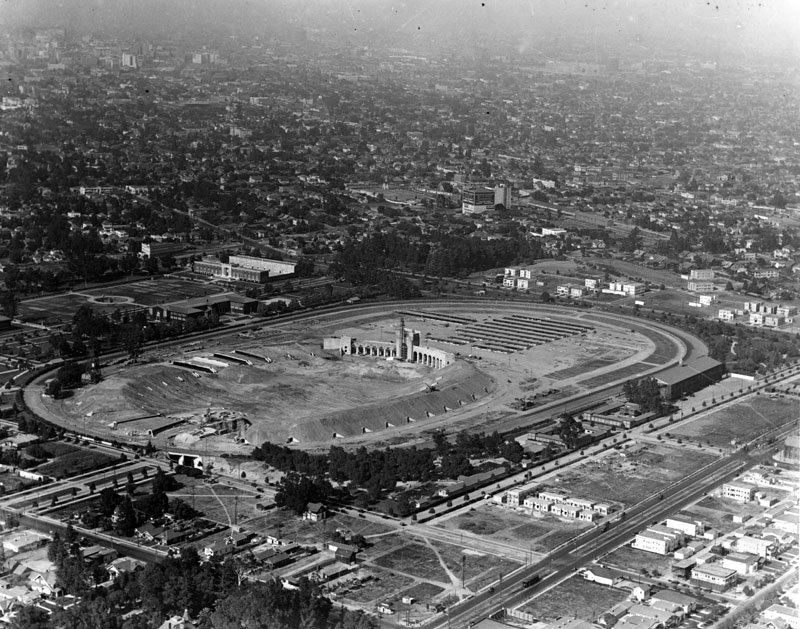 |
|
| (1922)* - Aerial view showing the early stages of the Coliseum's construction. The arches and east entranceway are already in place. |
Historical Notes Construction of the Los Angeles Memorial Coliseum began in December 1921 on land within Exposition Park. Designed by architects John and Donald Parkinson, the stadium was planned as a memorial to veterans of World War I. Early construction focused on the massive concrete arches and the east entrance, which would become one of the building’s most recognizable features. The project moved quickly, reflecting both civic pride and the growing importance of Los Angeles as a major American city. |
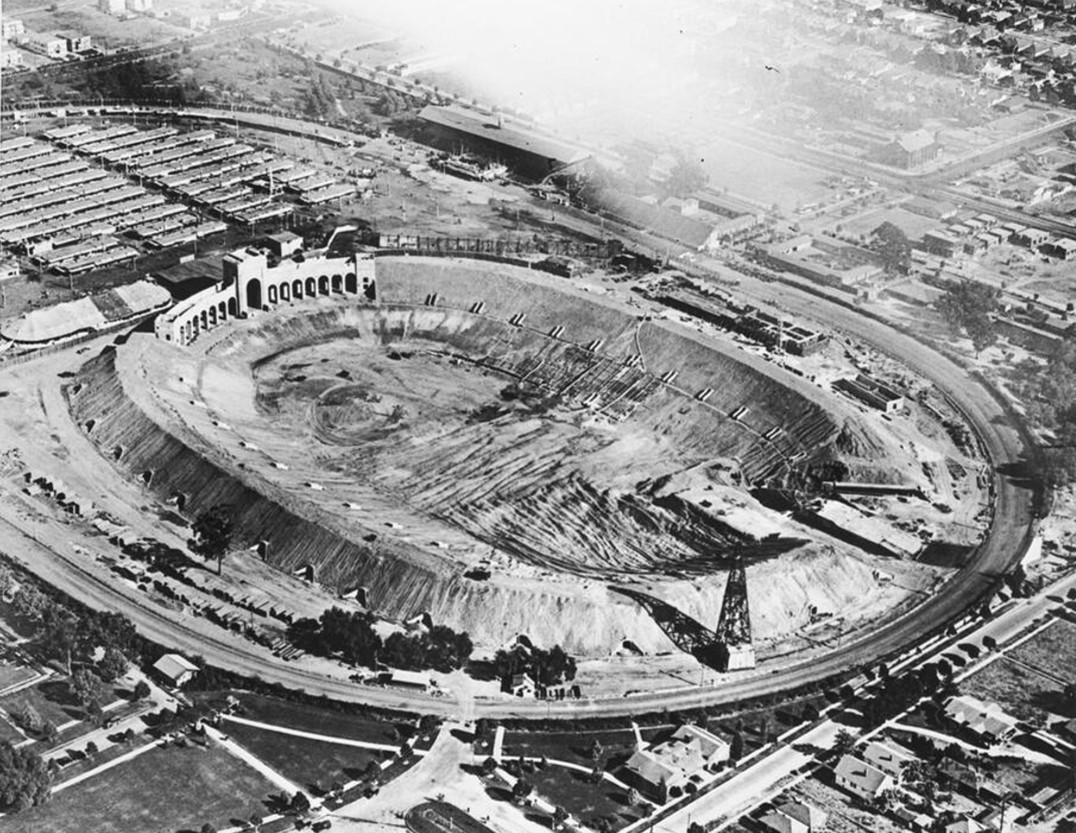 |
|
| (1922)* - Construction continues on the new Los Angeles Memorial Coliseum. The large stadium was built in less than two years, from December 1921 to May 1, 1923. |
Historical Notes By 1922, the stadium’s bowl and structural framework were rapidly taking shape. The Coliseum was built on land once known as Agricultural Park, an area used since the 1870s for fairs, exhibitions, and racing events. In 1913 the grounds were renamed Exposition Park as cultural institutions and museums began to occupy the area. The Coliseum’s construction marked a major shift in the park’s role as a center for large public gatherings. |
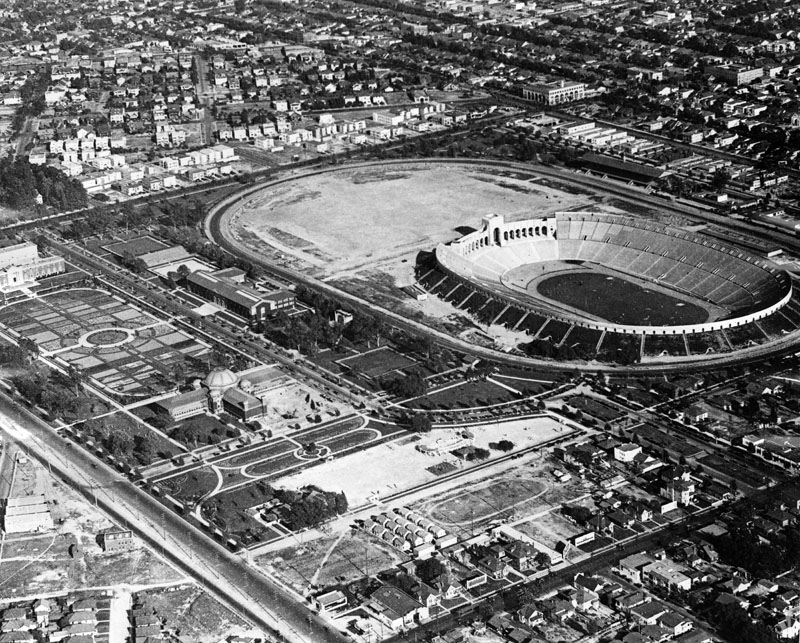 |
|
| (1923)* - Aerial view showing progress on the Coliseum, with the stadium nearly complete and the surrounding grounds still under development. |
Historical Notes By early 1923, the main structure of the Coliseum was largely finished. Exposition Park, including the Natural History Museum and the Sunken Garden, can be seen nearby, highlighting the stadium’s setting within a larger civic landscape. The original design featured a single bowl with seating for more than 75,000 people, making it the largest stadium in Los Angeles at the time. |
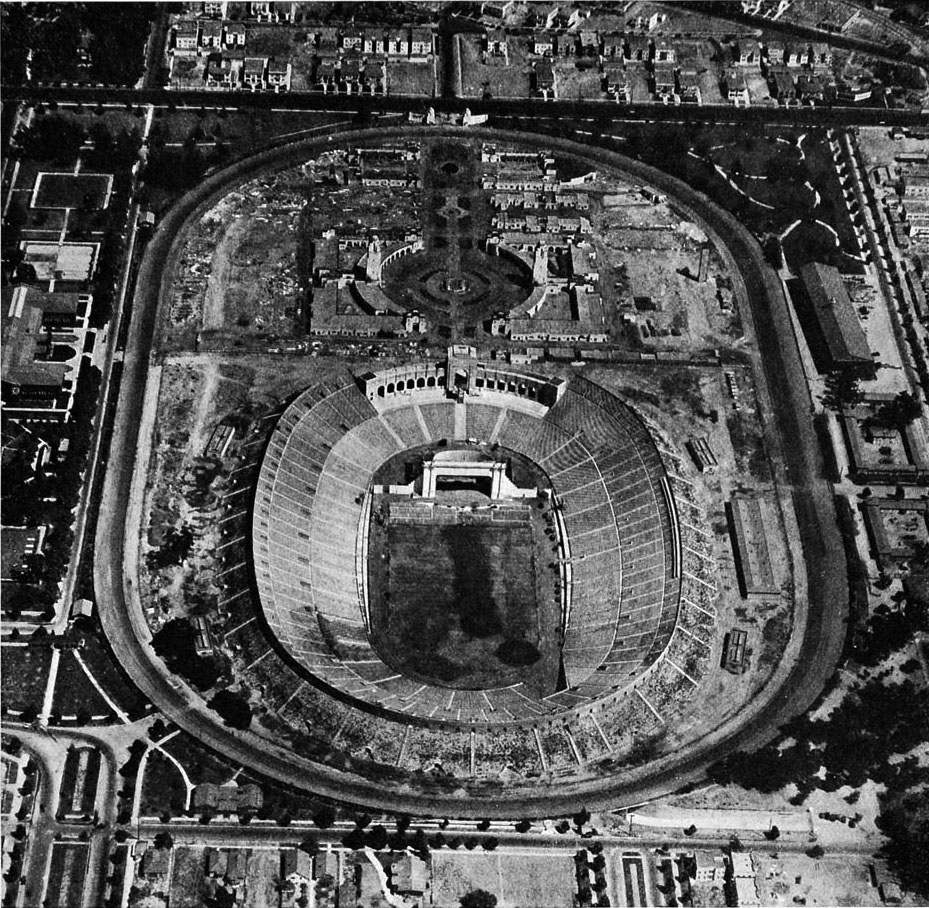 |
|
| (1923)* - Aerial view looking north showing an almost completed Coliseum. The next step is the landscaping. Figueroa Street, running left to right, is seen at top. |
Historical Notes As construction neared completion, attention turned to landscaping and improving access around the stadium. Figueroa Street bordered the site, connecting the Coliseum to the growing city beyond Exposition Park. When the stadium officially opened in 1923, it stood as a symbol of Los Angeles ambition and modern engineering. |
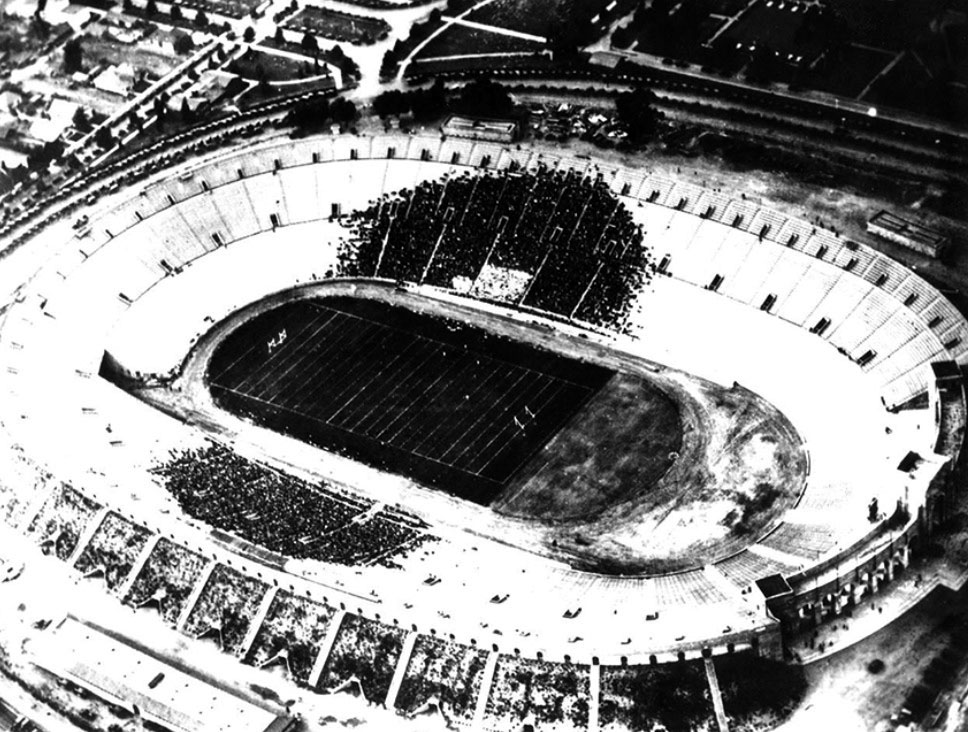 |
|
| (1923)* – View showing the first football game at the Los Angeles Memorial Coliseum, USC vs Pomona. |
Historical Notes The Los Angeles Memorial Coliseum opened in June 1923, and its first football game was played on October 6 of that year. The University of Southern California defeated Pomona College 23 to 7 before a crowd of more than 12,000 spectators. This game marked the beginning of the Coliseum’s long role as the home field for USC football and established the stadium as a major sports venue in Southern California. |
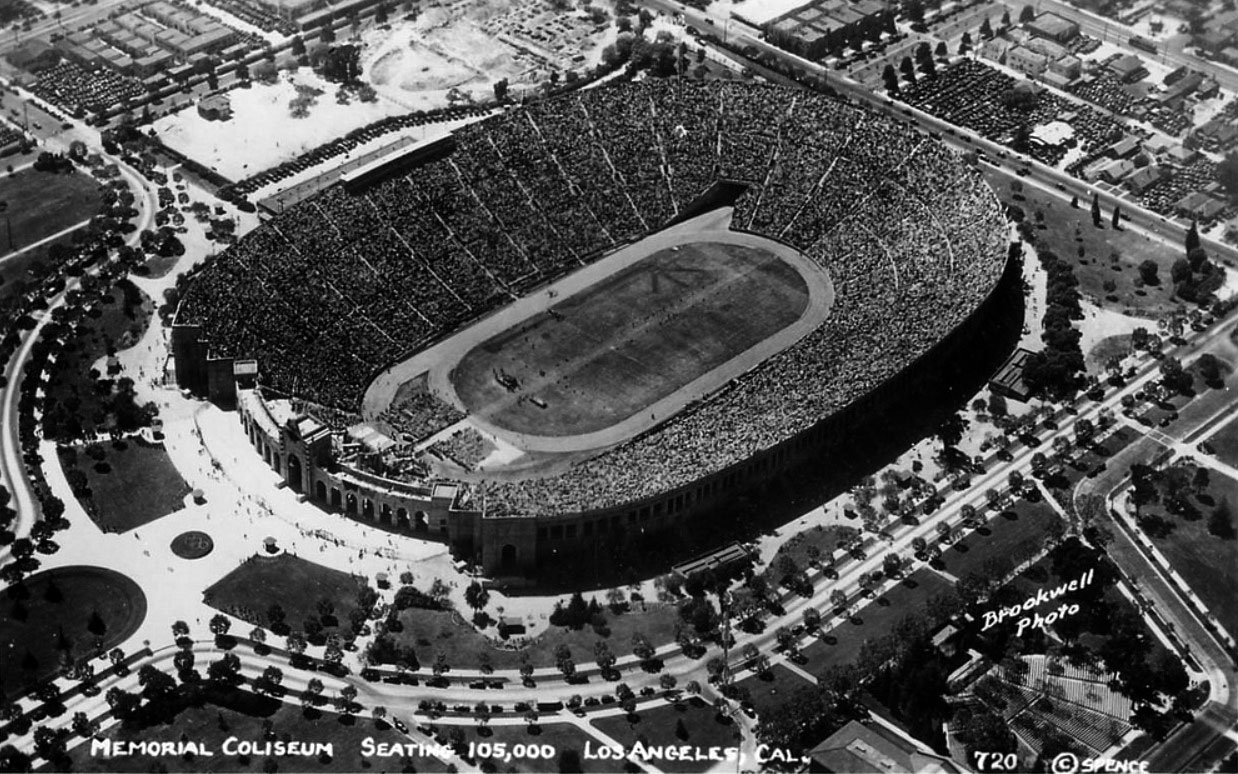 |
|
| (ca. 1930)* - Postcard view of the Memorial Coliseum following its expansion in preparation for the 1932 Olympic Games, prior to the installation of the Olympic torch. |
Historical Notes In preparation for hosting the 1932 Summer Olympic Games, the Coliseum underwent a major expansion beginning around 1930. Seating was increased to more than 100,000, and new tunnel levels were added to improve circulation. At this stage, the stadium had taken on much of its Olympic-era form, though the torch and other symbolic elements were still to come. |
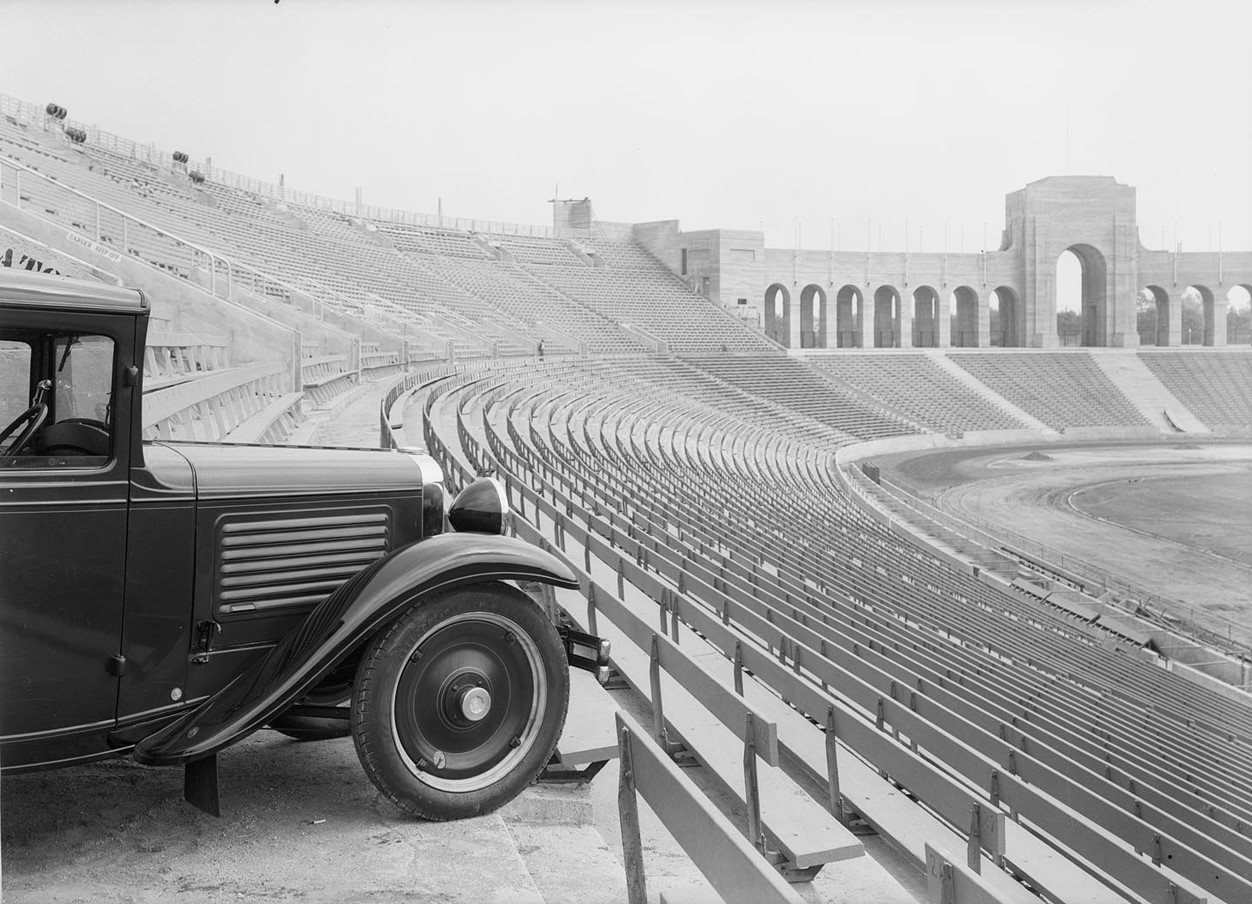 |
|
| (ca. 1929)* - A Ford Model A car is parked behind the wooden bleachers in the Los Angeles Memorial Coliseum. Note the torch we see today would not be installed until 1930. |
Historical Notes This image offers a glimpse of everyday life around the Coliseum just before the Olympic renovations were completed. The presence of a Ford Model A reflects the growing role of the automobile in Los Angeles. At this time, the stadium still retained elements of its original construction, including wooden seating areas that would soon be replaced or modified. |
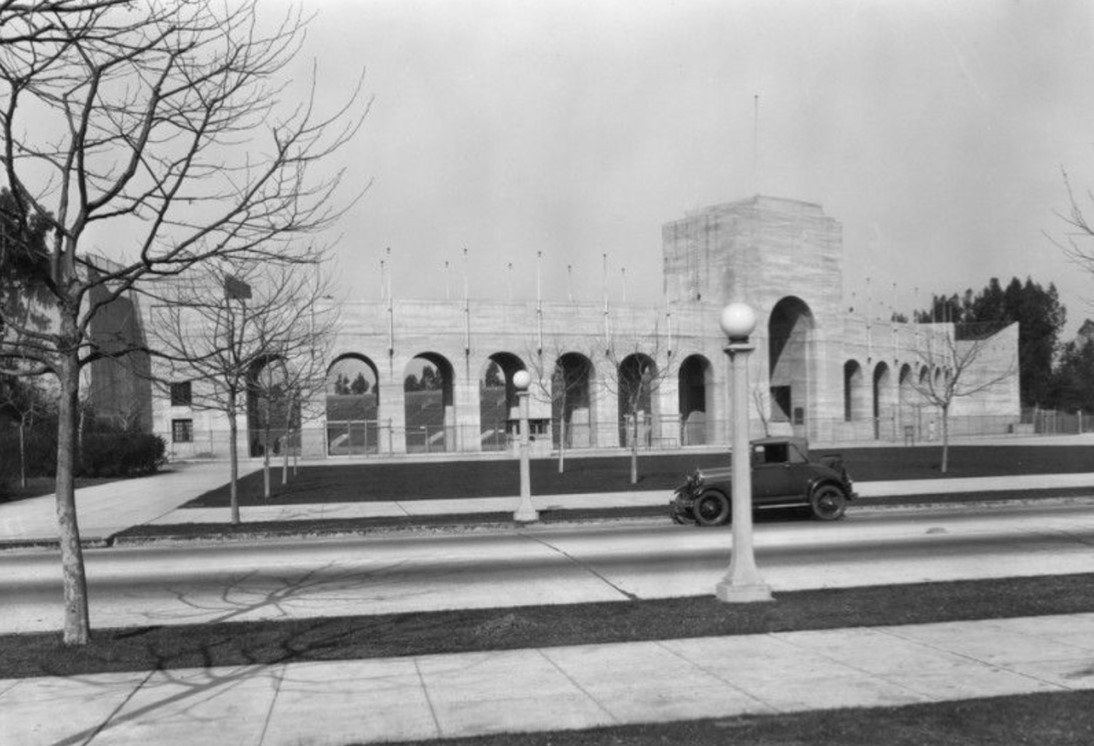 |
|
| (1920s)* - View of the front end of the Coliseum stadium at Exposition Park before the Olympic torch was added. |
Historical Notes During the 1920s, the Coliseum’s classical design was already well established, even without the Olympic torch. The peristyle entrance served as a grand gateway for spectators attending football games and other events. The stadium quickly became a focal point for civic pride and large public gatherings. |
 |
|
| (ca. 1932)* - Christmas lights illuminate rows of evergreen trees at Exposition Park, with the Peristyle entrance and Olympic torch visible atop the Los Angeles Memorial Coliseum in the distance. |
Historical Notes This nighttime holiday scene shows the Coliseum after the Olympic torch had been installed above the peristyle entrance. Added during the 1930 renovation, the torch became a lasting symbol of the stadium’s Olympic role. The decorated trees in Exposition Park highlight how the area functioned not only as a sports complex, but also as a public space enjoyed by the community during special occasions. |
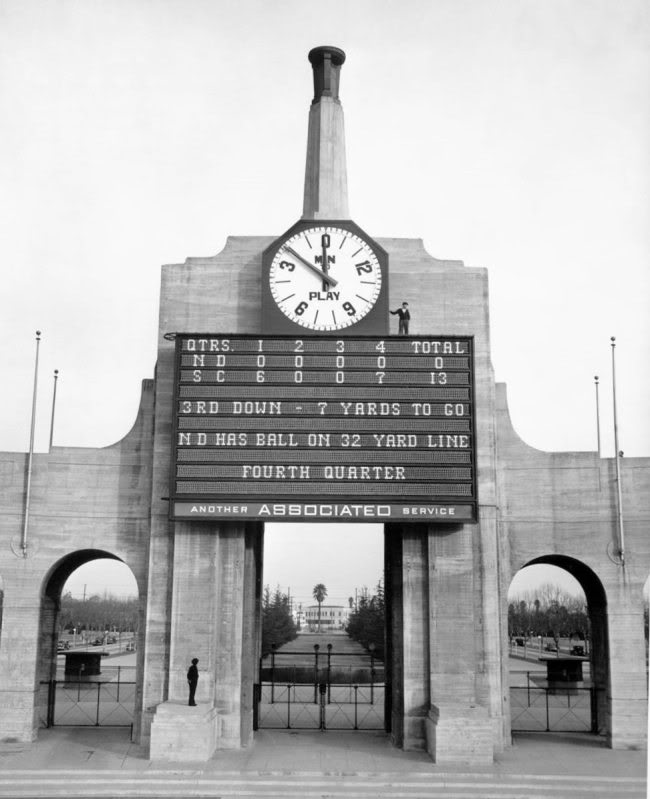 |
|
| (1932)* - Final score: USC 13 – Notre Dame 0. |
Historical Notes By 1932, the Coliseum had become one of the most important stages in college football. USC’s shutout victory over Notre Dame came during a remarkable period when the two schools dominated the national scene. Between 1928 and 1932, USC and Notre Dame won five consecutive national titles, helping cement one of college football’s most storied rivalries. The game reflected both the growing national importance of the Coliseum and its role in defining West Coast football. |
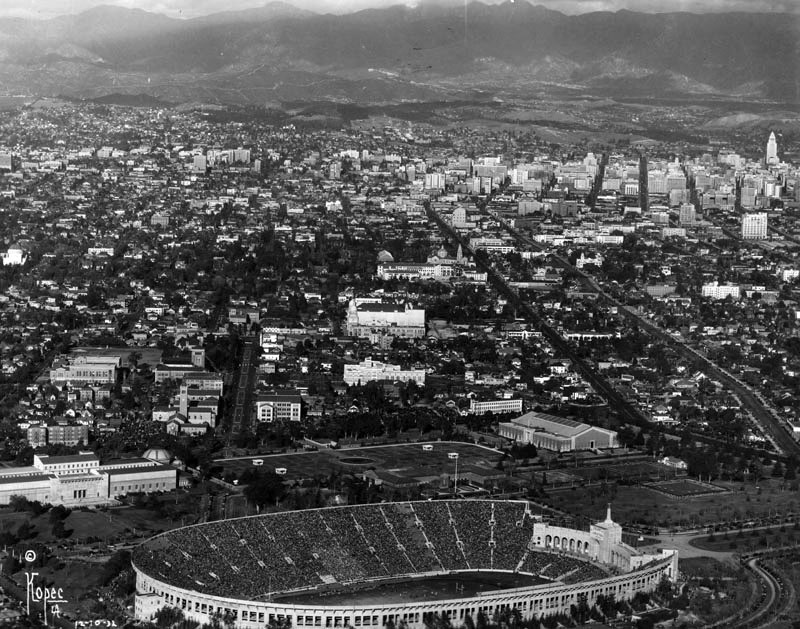 |
|
| (1932)* - Aerial view of Los Angeles, looking north, with the Coliseum in the foreground. Note: the Olympic torch is now in place. Downtown LA can be seen in the background with City Hall appearing to be the tallest building. |
Historical Notes In preparation for the 1932 Olympics, the Coliseum underwent its first major expansion, increasing capacity to over 100,000 and adding the iconic Olympic torch. This set the stage for the stadium's unique Olympic legacy, as it went on to host the 1984 Games and is slated to host again in 2028, making it the first stadium to host three Olympic Games. Prior to the late 1950s the Charter of the City of Los Angeles did not permit any portion of any building other than a purely decorative tower to be more than 150 feet. Therefore, from its completion in 1928 until 1964, the City Hall was the tallest building in Los Angeles, and shared the skyline with only a few structures having decorative towers, including the Richfield Tower and the Eastern Columbia Building. Click HERE to see more Early Views of the Los Angeles Memorial Coliseum during the Olympics. |
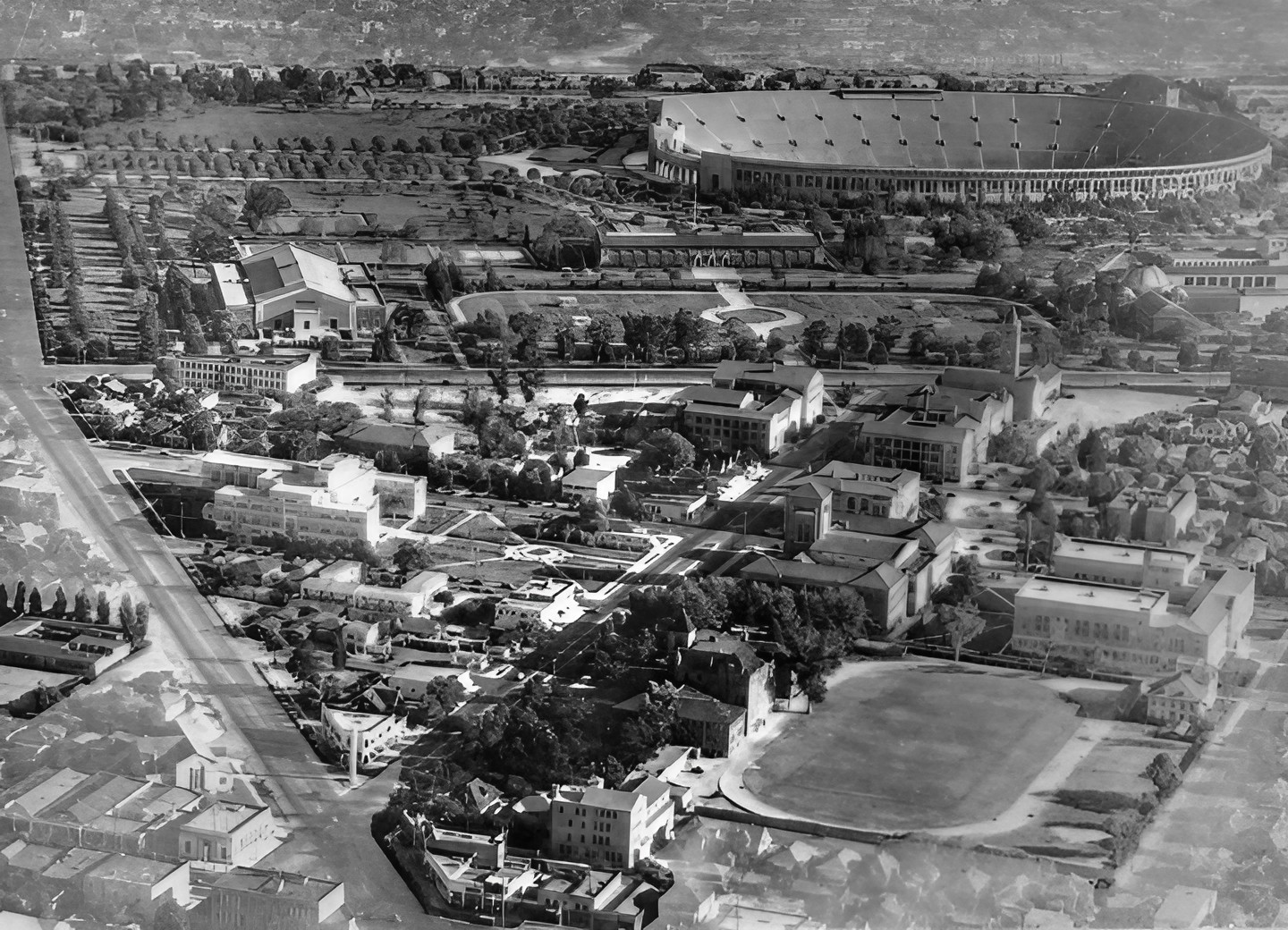 |
|
| (1930s)* - Aerial view looking south showing the Coliseum and Exposition Park in the distance with the USC campus in the foreground. |
Historical Notes In addition to serving as the home field for the USC Trojans since 1923, countless historic events have taken place inside these venerable walls during nine decades of celebrated history. It is the only facility in the world to play host to two Olympiads (X and XXIII), two Super Bowls (I and VII), one World Series (1959), a Papal Mass and visits by three U.S. Presidents: John F. Kennedy, Richard M. Nixon and Ronald Reagan. Click HERE to see more in Early Views of USC. |
* * * * * |
California Bank (1st and Vermont)
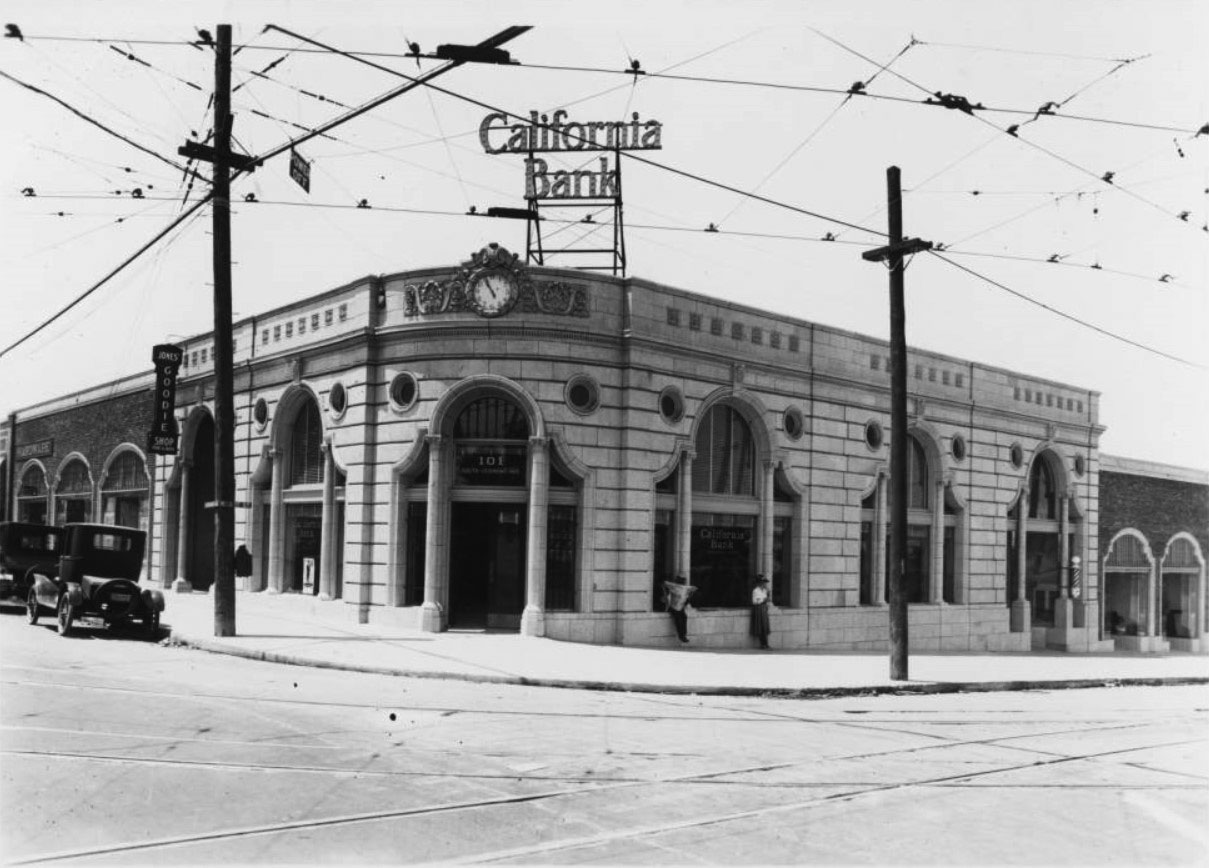 |
|
| (1922)^ - View of the California Bank branch office on the southwest corner of Vermont and First Street. Two poles stand in front of the bank with their streetcar wires weaving overhead. The bank has an arched entrance and tall, arched windows where two people lean on the right. Automobiles sit parked in front of Jones Goodie Shop on the far left. |
* * * * * |
Hollywood Bowl
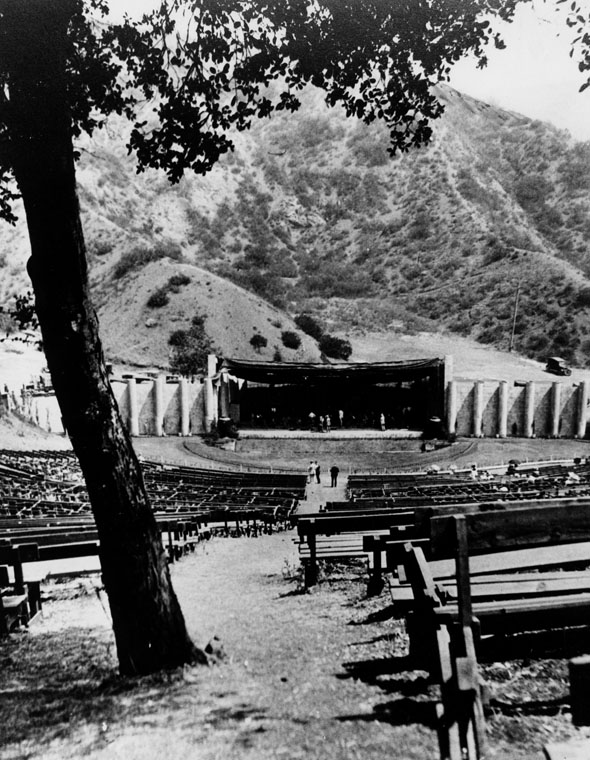 |
|
| (1922)* - Hollywood Bowl at first Symphony Under the Stars, July 11, 1922. This was the "Bowl's" official opening and was on the site of a natural amphitheater formerly known as the Daisy Dell. It has undergone several upgrades to improve seating as well as acoustics. |
Historical Notes On July 11, 1922, with the audience seated on simple wooden benches placed on the natural hillsides of Bolton Canyon, conductor Alfred Hertz and the Los Angeles Philharmonic inaugurated the first season of music under the stars at the Hollywood Bowl. The Bowl was very close to its natural state, with only makeshift wooden benches for the audience, and eventually a simple awning over the stage.^* |
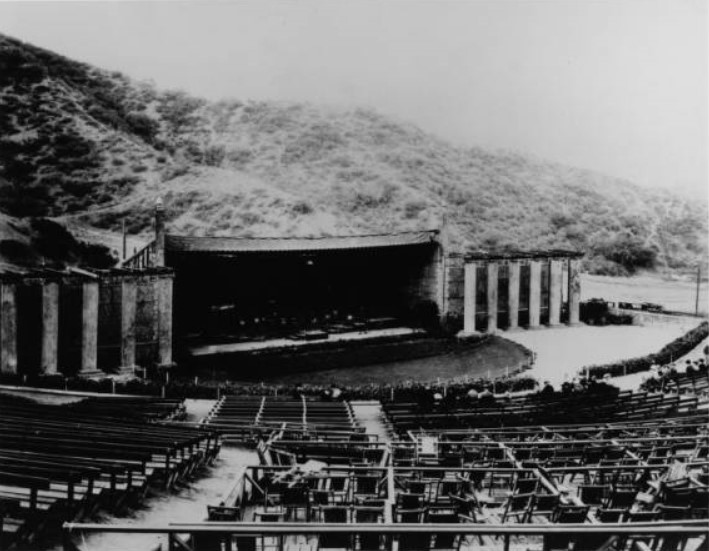 |
|
| (1920s)^ - View looking toward the stage from an upper row of seats. The stage of the Hollywood Bowl is shown at center, bordered on each side by columns. Curved rows of bleacher-like seats sit to the left of the camera, while in front of it are rows of box seats. A group of several people stands in the front rows of the center and right sections of seats. |
Historical Notes The Hollywood Bowl has been the summer home of the Los Angeles Philharmonic, since its official opening in 1922.^* In 1922 the admission price was 25 cents. |
Click HERE to see more Early Views of the Hollywood Bowl |
* * * * * |
Hollywood Masonic Temple
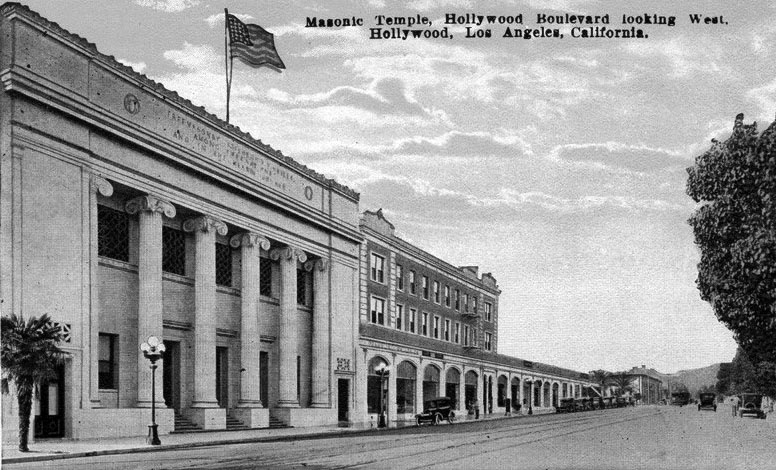 |
|
| (ca. 1922)^*# – Postcard view looking west on Hollywood Boulevard showing the newly constructed Masonic Temple located at 6840 Hollywood Boulevard. |
Historical Notes In 1921, the Hollywood lodge of the Masons relocated from their existing lodge on the current site of the Kodak Theatre. The construction of the new three-story building was led by lodge master, Charles E. Toberman, who was responsible for the Hollywood Bowl, Grauman's Chinese Theatre, the Roosevelt Hotel and the Max Factor Building. |
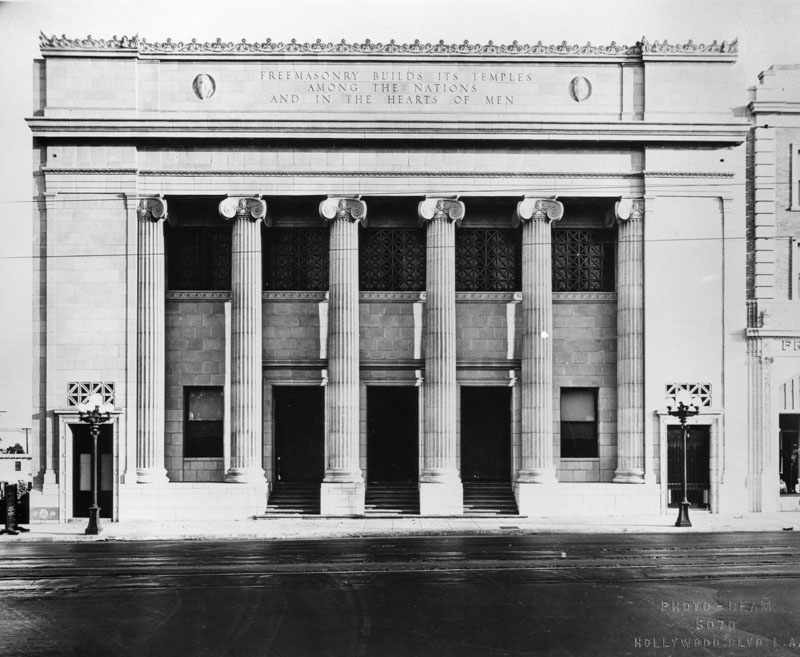 |
|
| (1922)* - Exterior view of the Masonic Temple located at 6840 Hollywood Boulevard, between Highland and La Brea. The building was built in 1922 and designed by Architects Austin, Field & Fry in a Greek Revival design with six tall pillars decorating the front entrance of the building. Note the two ornate 5-bulb streetlights in front of the building. Click HERE to see more in Early L.A. Street Lights. |
Historical Notes When the new temple opened, it was one of the most substantial structures in Hollywood. It had a billiard room, pipe organ, ladies parlor, ballroom and lodge rooms. One writer described the building as "unsurpassed for beauty, attractiveness and richness of equipment. The architect, John C. Austin also worked on the Shrine Auditorium, Griffith Observatory and Los Angeles City Hall.^* |
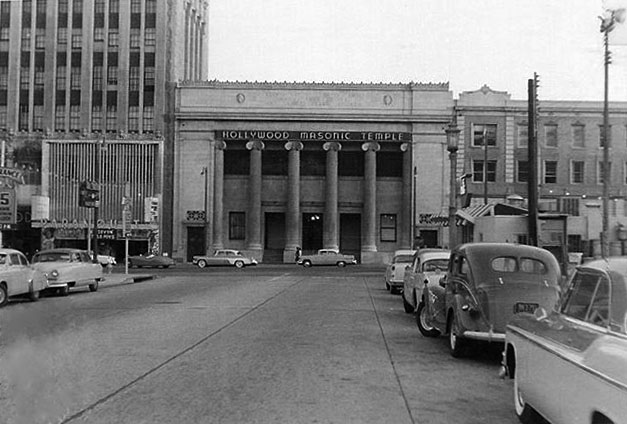 |
|
| (1955)**^# – View looking south on Orchid Avenue toward Hollywood Boulevard. The Hollywood Masonic Temple is seen on the south side of Hollywood Boulevard at the end of the T-intersection. Toff's Coffee Shop can be seen at center-right, NW corner of Orchid and Hollywood Blvd. |
Historical Notes Orchid Avenue at Hollywood Boulevard "disappeared" during the construction of the Hollywood Highland complex in the late 90s. The other half of the street still exists and can be accessed off of Franklin Ave, the next street north of Hollywood Blvd. |
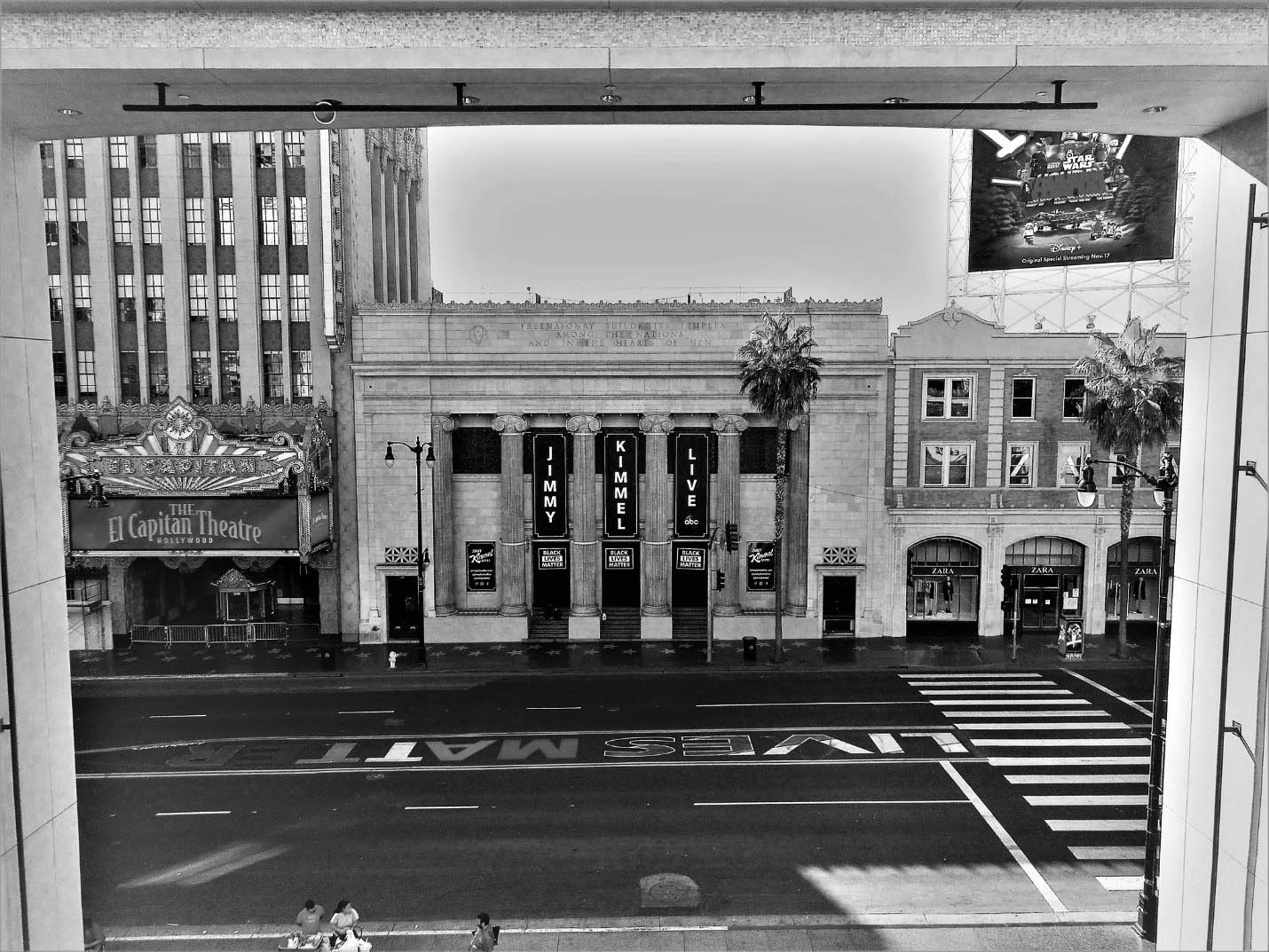 |
|
| (2020)^.^ - The Masonic Temple as seen from the Hollywood and Highland Center across the street. The building is now the El Capitan Entertainment Center where Jimmy Kimmel Live is filmed. Photo by Howard Gray |
Historical Notes The Masons operated the temple until 1982, when they sold the building after several years of declining membership. The 34,000-square-foot building was then converted into a theater and nightclub, and ownership subsequently changed several times, until it was bought by the Walt Disney Company's Buena Vista Pictures Distribution in 1998 for Buena Vista Theatres, Inc. In 1984, the Hollywood Masonic Temple (now known as the El Capitan Entertainment Centre) was desiganted LA Historic-Cultural Monument No. 277 (Click HERE to see complete listing). It was also listed in the National Register of Historic Places in 1985. |
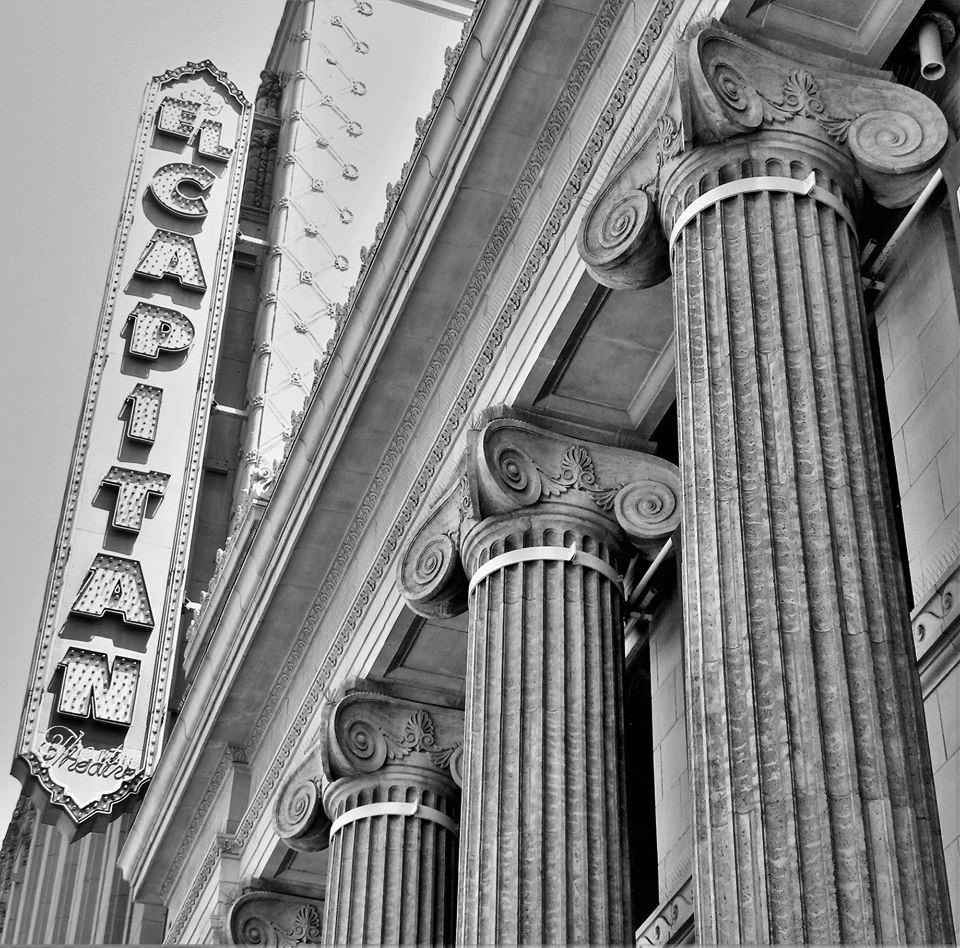 |
|
| (2020)^.^ - View looking up toward the El Capitan Theatre sign as seen from in front of the old Hollywood Masonic Temple, now the El Capitan Entertainment Center. Photo by Howard Gray |
Historical Notes In 2002, after extensive renovation, Disney reopened the building as the El Capitan Entertainment Centre. Disney restored original fixtures, including backlighted stone filigree, wrought iron torchieres, Batchelder tiles and old post boxes once used by Masonic officers. On January 26, 2003, Jimmy Kimmel Live! premiered at the entertainment center, its regular location.^ |
* * * * * |
Los Angeles Normal School
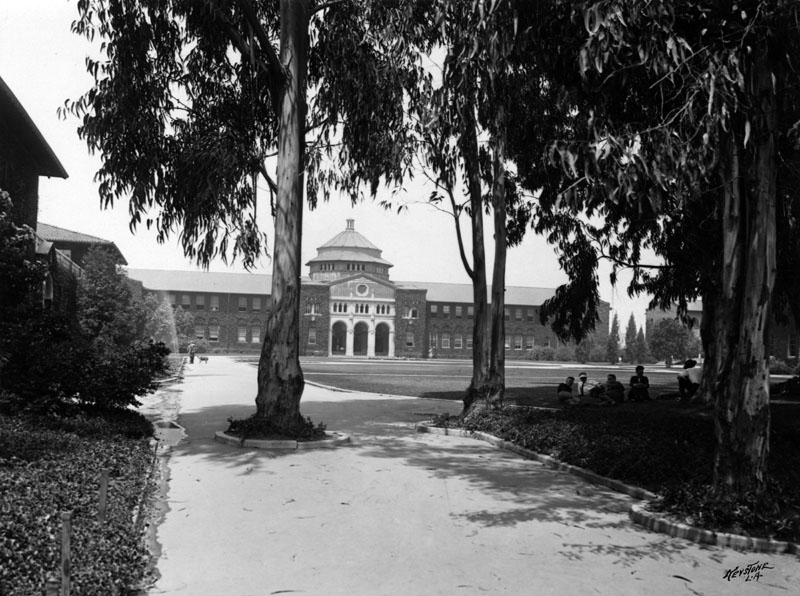 |
|
| (1922)* - Millspaugh Hall at the Los Angeles State Normal School on Vermont Avenue (later to become UCLA). Students can be seen sitting in the shade of a Eucalyptus tree. |
Historical Notes The cornerstone for Millspaugh Hall was laid on November 18, 1913; in September 1914, the school began its sessions in the new building. Millspaugh Hall was the center of student and administrative activity and occasionally an outdoor assembly area. The University of California, Southern Branch would eventually come to be known as the University of California, Los Angeles - or UCLA for short.* |
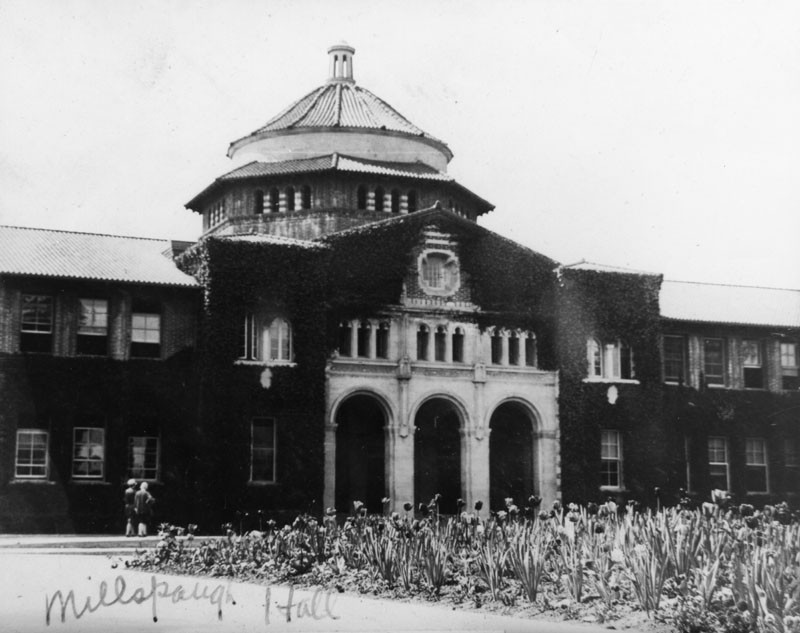 |
|
| (ca. 1925)* - Millspaugh Hall, an ivy-covered Beaux-Arts style building with a flared polygonal dome, was the Administration building of the University of California, Southern Branch, located at 855 N. Vermont Ave. |
Historical Notes UCLA's first Commencement was in 1920 and was held in Millspaugh Hall of what was then the Los Angeles State Normal School on Vermont Avenue. The institution conferred its first bachelor's degree in education in 1923, and its first bachelor of arts degree in 1925. The Class of 1928 was graduated in ceremonies held in the Hollywood Bowl, the site of UCLA Commencements for several years, even following the move from the Vermont Avenue campus to Westwood in 1929.^** |
Click HERE to see more in Early Views of UCLA |
* * * * * |
Egyptian Theatre
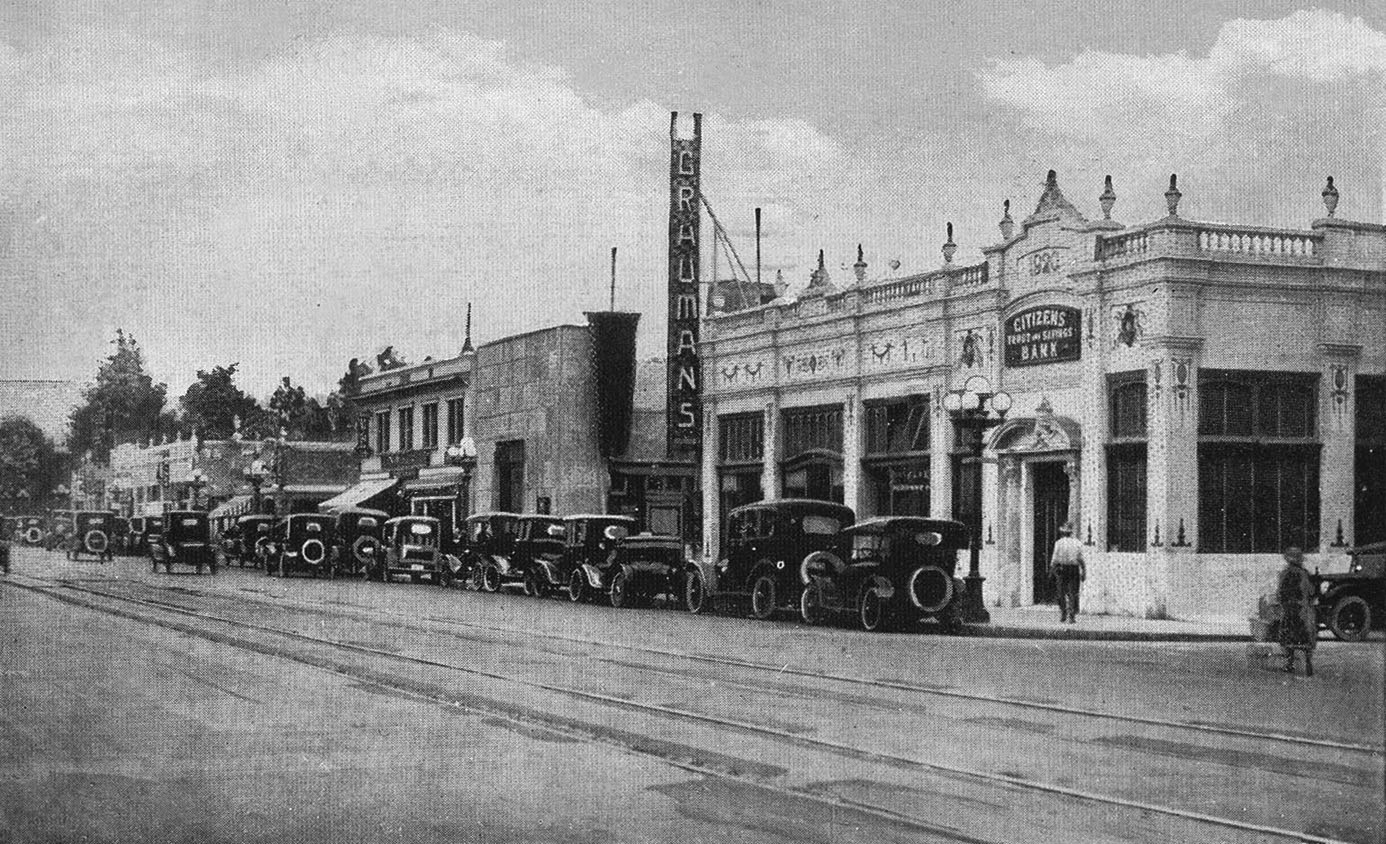 |
|
| (1922)^ - View looking east on Hollywood Boulevard at McCadden Place showing the newly opened Grauman's Egyptian Theater. |
Historical Notes The Egyptian Theatre was built by showman Sid Grauman and real estate developer Charles E. Toberman, who subsequently built the nearby El Capitan Theatre and Chinese Theatre on Hollywood Boulevard. Grauman had previously opened one of the United States' first movie palaces, the Million Dollar Theatre, on Broadway in Downtown Los Angeles in 1918. The Egyptian Theatre cost $800,000 to build and took eighteen months to construct.* McCadden Place was named after developer and subdivider W. C. McCadden. |
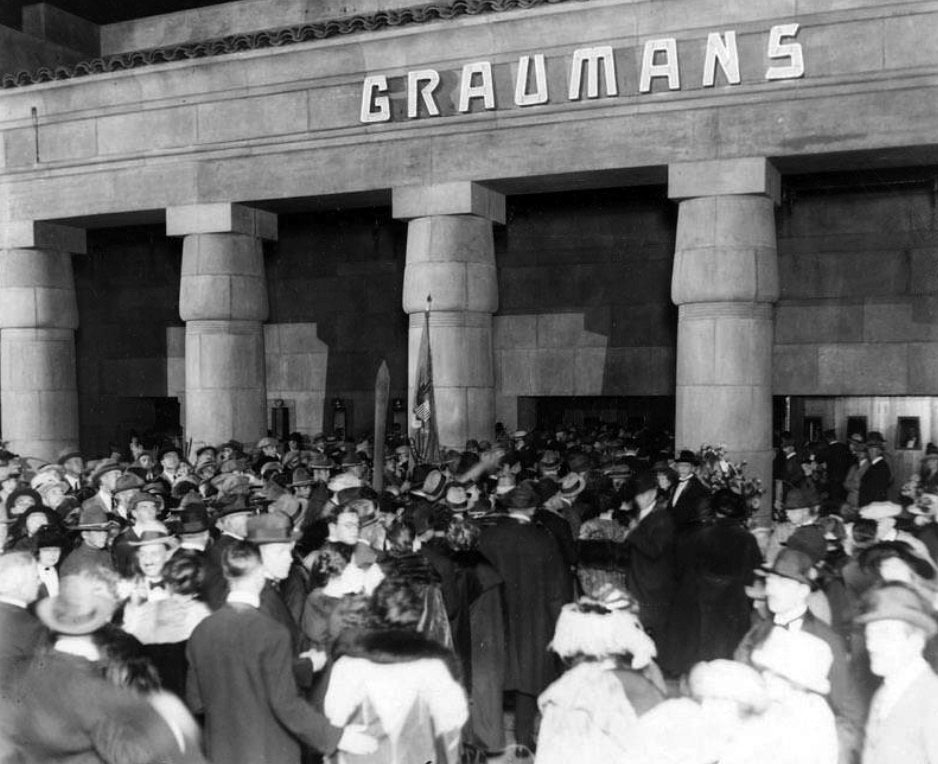 |
|
| (1922)^*^# - The Grauman's Egyptian Theatre on opening night. The film was Douglas Fairbanks' "Robin Hood," which was the first-ever Hollywood premiere. |
Historical Notes The Egyptian Theatre was the venue for the first-ever Hollywood premiere, Robin Hood, starring Douglas Fairbanks, on Wednesday, October 18, 1922. As the film reportedly cost over $1 million to produce, the admission price to the premiere was $5.00. One could reserve a seat up to two weeks in advance for the daily performances. Evening admission was 75¢, $1.00 or $1.50. The film was not shown in any other Los Angeles theater during that year.* The address 6712 Hollywood Boulevard, now the site of the Egyptian Theatre, was once the address of Gilbert F. Stevenson and his wife. In 1903, Stevenson, the Secretary and General Manager of the Western Masons Mutual Life Insurance Association, moved from downtown Los Angeles to a five acre lemon ranch on the corner of Prospect (now Hollywood Boulevard) and Dakota (now McCadden Place) Avenues.^#** |
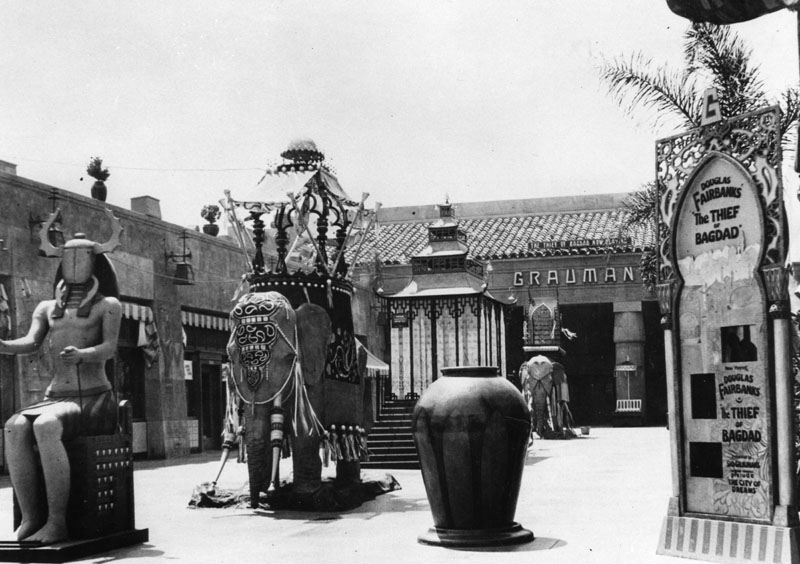 |
|
| (ca. 1923)* - A view of the courtyard of Grauman's Egyptian Theatre with statues of an Egyptian king, Indian elephants. Billboard advertising for Douglas Fairbanks "The Thief of Bagdad." |
Historical Notes King Tutankhamen’s tomb was discovered in Egypt on November 26, 1922 and an Egyptian craze swept the nation. |
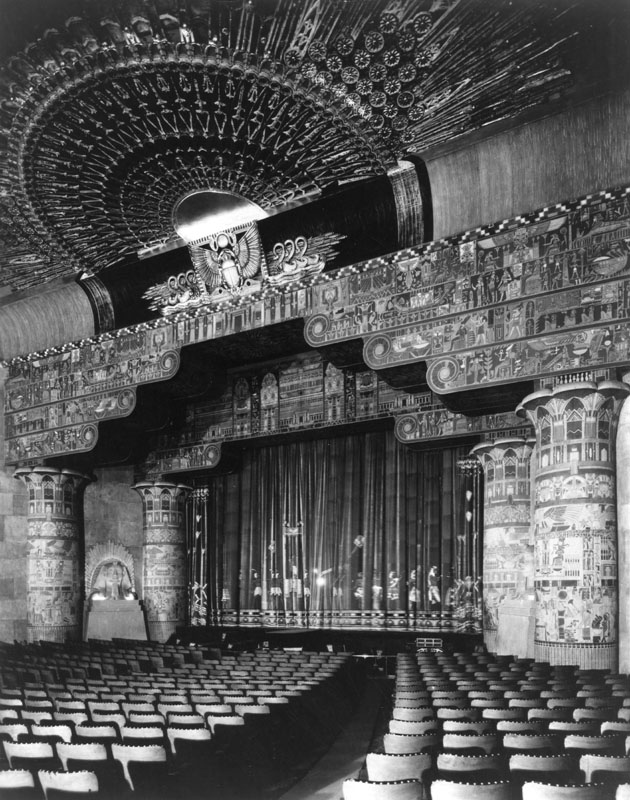 |
|
| (1922)* - Looking toward the stage across the seats in the auditorium, you can see the delicately carved arches around the stage as well as the ornate ceiling above it. |
Historical Notes Architects Meyer & Holler designed the Egyptian Theatre. The Milwaukee Building Company built it. |
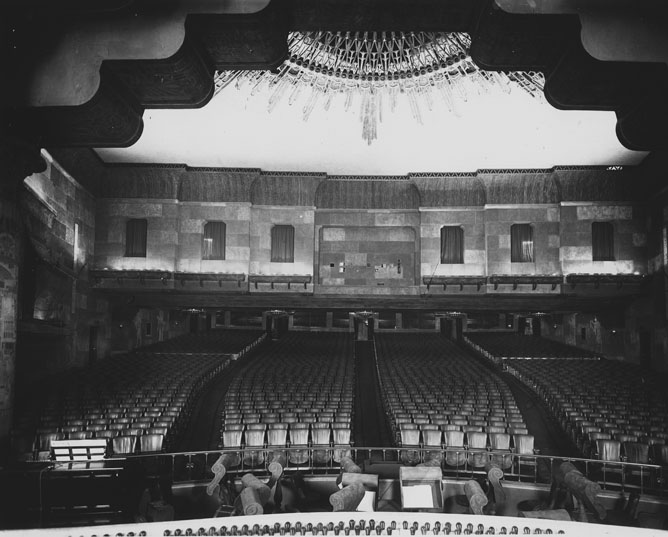 |
|
| (1924)* - Interior view of the Egyptian Theatre as seen from the stage. |
Historical Notes The original seating capacity of the theatre was close to 2,071 in a 115 by 125 foot auditorium. |
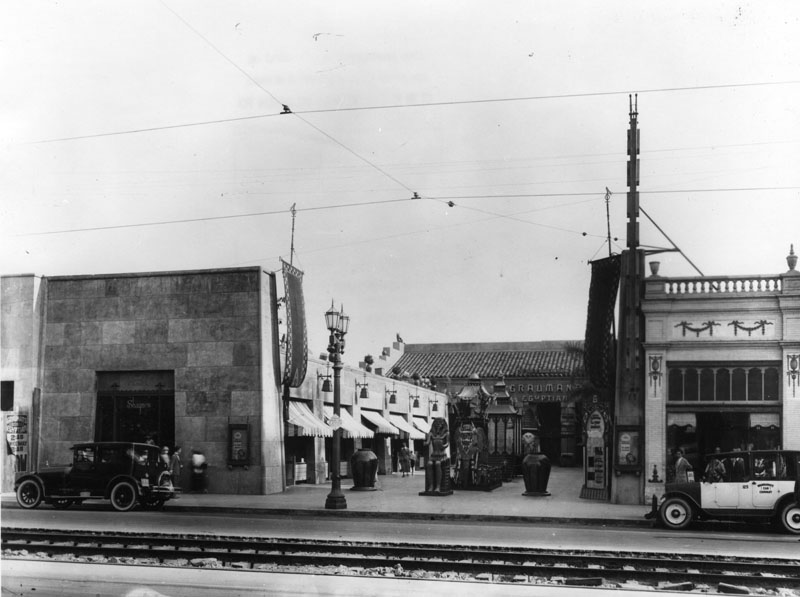 |
|
| (1924)* - View of the Grauman's Egyptian Theatre in 1924. Railroad tracks can be seen on Hollywood Boulevard in front of the theatre. |
Historical Notes The courtyard of the Egyptian is 45 feet wide and 150 feet long. The store fronts along the east side of the courtyard were described as having an "Oriental motif" and apparently sold imports. On the west side, the Pig ‘n Whistle restaurant, which opened on July 22, 1927 and operated until the late 1940s, had a side entrance onto the Egyptian Theatre courtyard. A small tiled area featuring the "pig ‘n whistle" motif still exists in the courtyard on the west wall near the fountain.^#** |
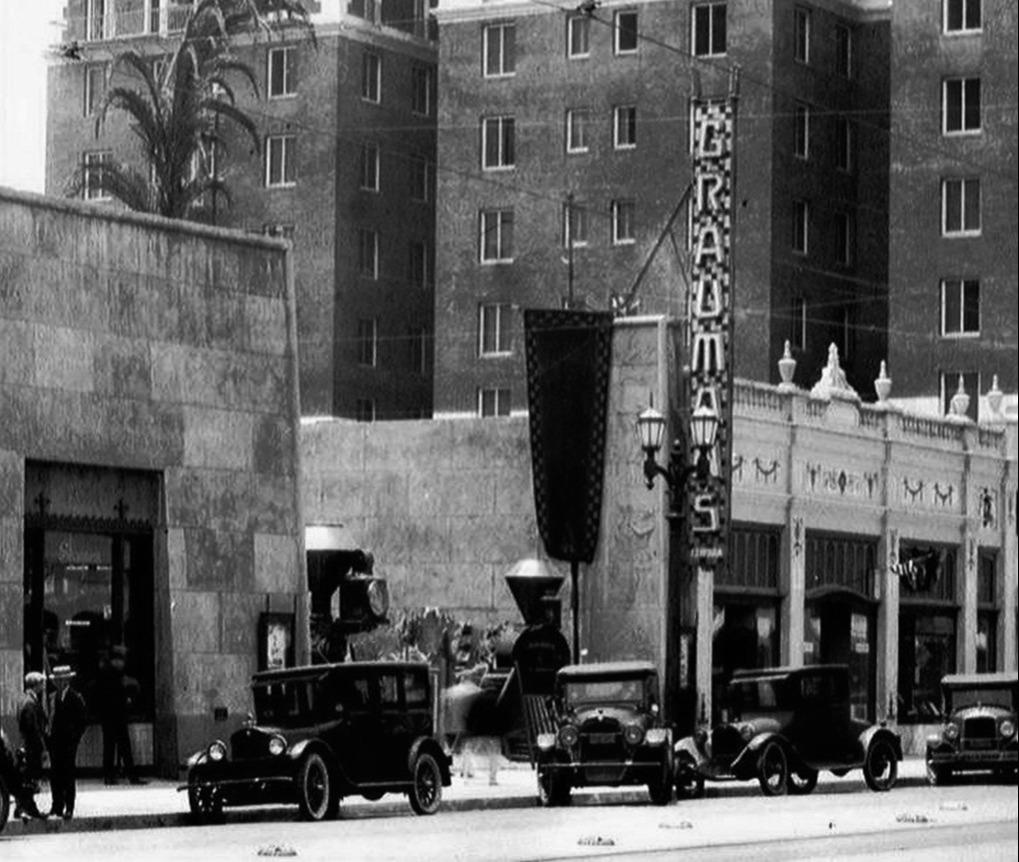 |
|
| (ca. 1924)* – Cars parked in front of Grauman’s Egyptian Theatre with the 1922-built Hotel Christie seen in the background. |
Historical Notes In 1927, Grauman would open a second movie theater further west on Hollywood Boulevard. In keeping with the public fascination in that era with international themes, he named his new theater the Chinese Theatre. Its popularity eventually rivaled and surpassed the Egyptian because of its numerous celebrity handprints, footprints and signatures in the cement of its forecourt.* |
 |
|
| (1932)*^#* – Postcard view of the front entrance to the Egyptian Theatre on Hollywood Boulevard. Now Playing: “Back Street” starring Irene Dunne and John Boles. |
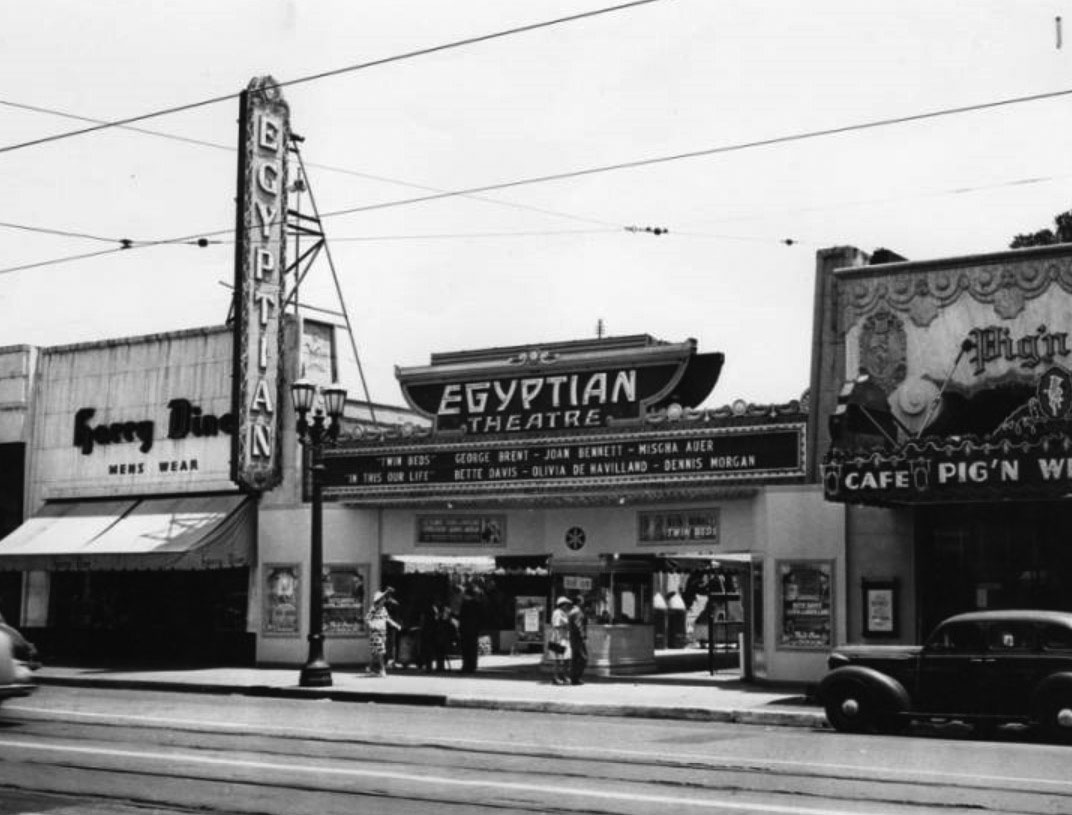 |
|
| (1942)* - View showing the entrance to the Egyptian Theatre with the Pig 'N Whistle Café seen on the right. The marquee reads: Twin Beds with George Brent, Joan Bennet, and Mischa Auer; and In This Our Life with Bette Davis, Olivia de Havilland, and Dennis Morgan. |
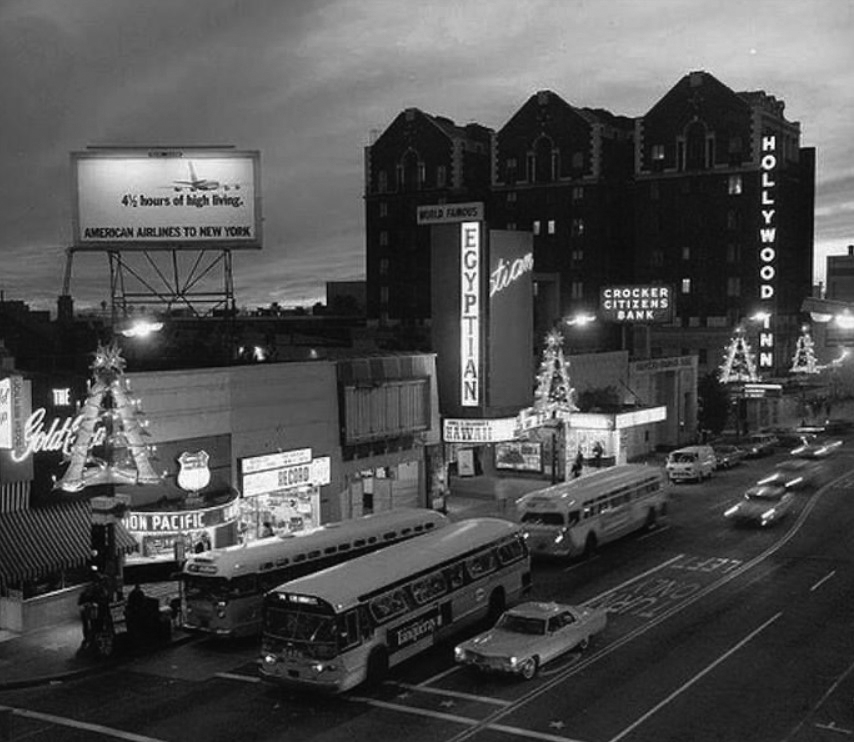 |
|
| (1966)#**^ – View looking southwest on Hollywood Boulevard from Las Palmas Avenue during the holiday season. The Egyptian Theatre is seen on the south side of the Boulevard with the Hollywood Inn (previously Hotel Christie and Drake Hotel) in the distance. |
Historical Notes As Hollywood declined in the 1980s and early 1990s, the Egyptian Theatre eventually fell into disrepair. In 1996, the city of Los Angeles sold the theatre to the American Cinematheque for a nominal one dollar with the provision that the landmark building be restored to its original grandeur and re-opened as a movie theatre. The Cinematheque committed to raising the funds to pay for the restoration and to using the renovated theatre as home for its programs of public film exhibition.^* |
.jpg) |
|
| (2014)#^^* – Google street view showing the Egyptian Theatre located at 6712 Hollywood Boulevard. |
Historical Notes The Egyptian Theatre was re-opened to the public on December 4, 1998, after a $12.8 million renovation. The original theatre seated 1760 patrons in a single auditorium. In the restored Egyptian the building has been reconfigured to add a second screening theatre. The main theatre now accommodates 616 patrons and is named after Los Angeles philanthropist Lloyd E. Rigler. The smaller, 77-seat theatre is named for Hollywood director Steven Spielberg.^* |
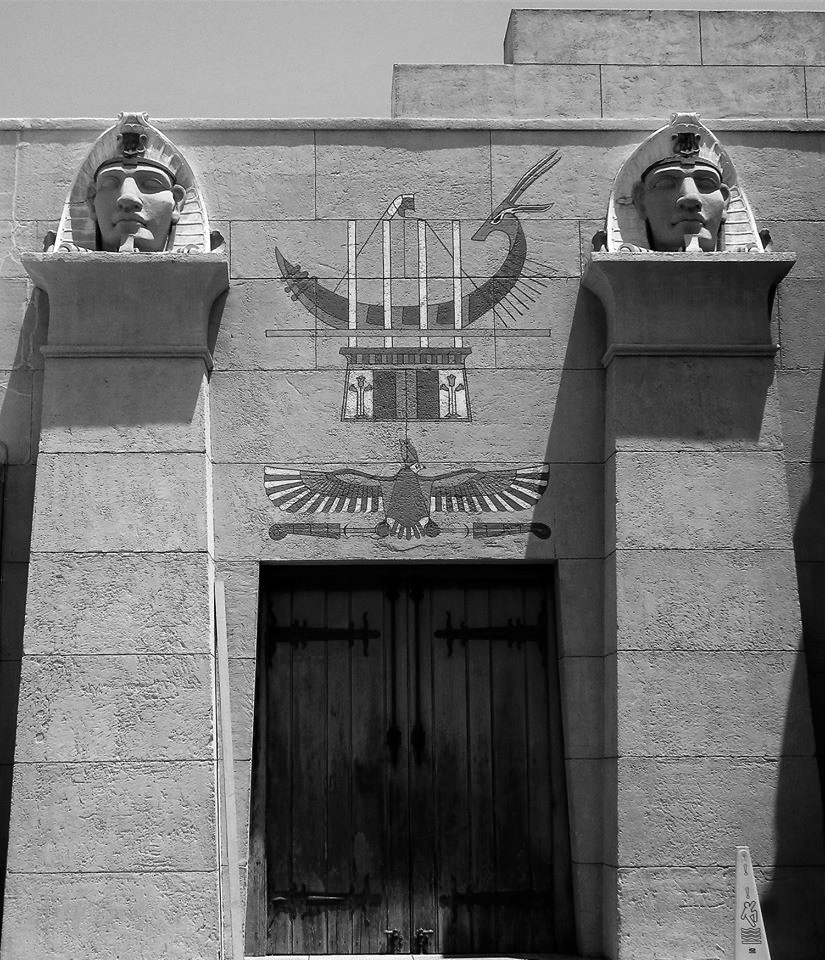 |
|
| (2020)^.^ - Grauman's Egyptian Theatre – Photo by Howie Gray |
Then and Now
 |
.jpg) |
|
| (1924)* vs. (2014)* - Egyptian Theatre |
Then and Now
 |
|
| (1922 vs 2020)* - Looking east on Hollywood Boulevard at McCadden Place showing the 1922-built Grauman’s Egyptian Theatre. |
* * * * * |
Guaranty Building
.jpg) |
|
| (ca. 1923)* – View showing the 12-story Guaranty Building designed by John C. Austin and Frederick Ashley, located on the northeast corner of Hollywood Boulevard and Ivar Avenue. |
Historical Notes The northeast corner of Ivar and Hollywood Blvd. has always occupied a special place in the social and economic history of Hollywood. Part of the original Hollywood ranch owned by Horace and Daeida Wilcox, the corner became the first permanent site of the First Methodist Church of Hollywood in 1910. The Guaranty Building and Loan Association paid the church $2000 per front foot for the site in 1923, and proceeded to erect the twelve story Guaranty Building, one of the first height-limit buildings on Hollywood Blvd. The owner and builder of the Guaranty Building was one of Hollywood's most prominent citizens. Gilbert Bessemyer was born in Hollywood on his father’s ranch in 1885. Gilbert, after attending public schools and the Normal School of Los Angeles, entered banking. By 1912 he was a director of the Hollywood National Bank and Citizens Savings bank. These were acquired by Security Trust and Savings (Security Pacific today). In 1919, and Beesemyer and a partner organized the Central Commercial Savings Bank (later known as the Bank of Hollywood). Beesemyer commissioned John C. Austin and Frederick Ashley to build the Guaranty Building. Classical Beaux Arts Buildings were popular from 1900 on for those businesses who wished to project a conservative image, primarily financial institutions.+^^ |
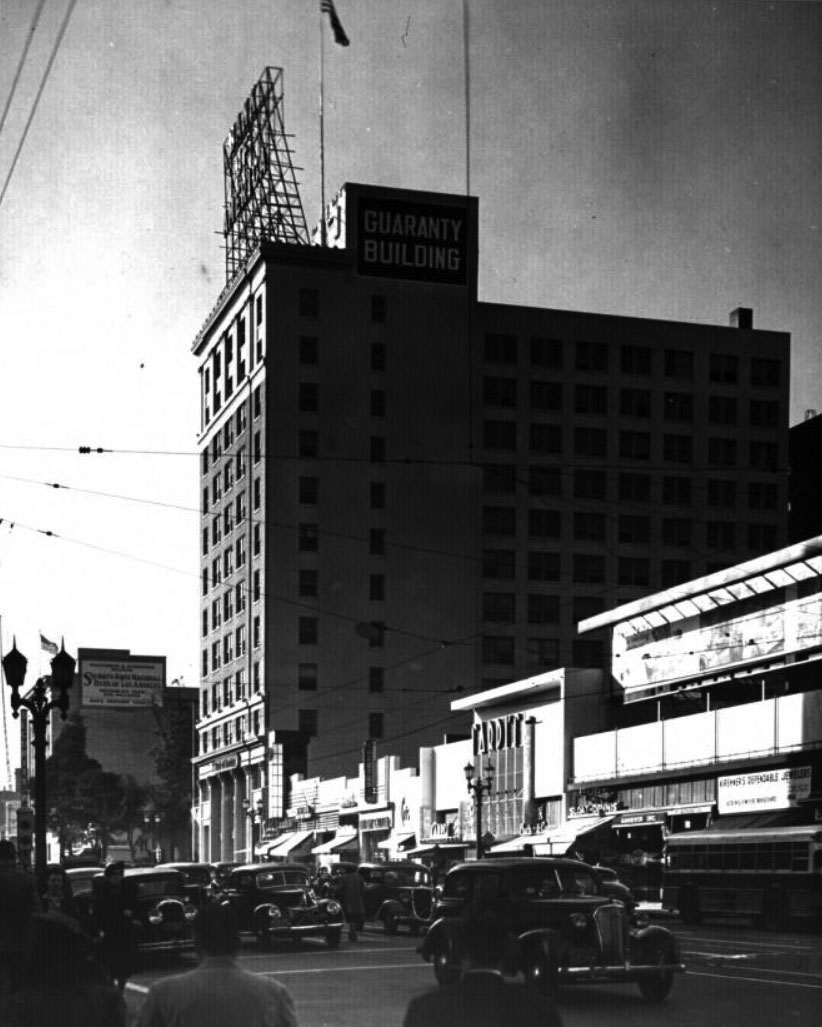 |
|
| (1939)^^ - Looking west on Hollywood Boulevard toward Cahuenga Boulevard. The 12-story Guaranty Building is the tallest in view. Sardi's Restaurant is at lower center-right. |
Historical Notes The complicated financial transactions of the film industry and a burgeoning real estate market had created a need for a number of financial services. Guaranty Savings took its place with other giants: Bank of America, Security Trust, and First Federal of Hollywood, among others. These and their smaller affiliates handled the investments of film moguls and citizens alike. |
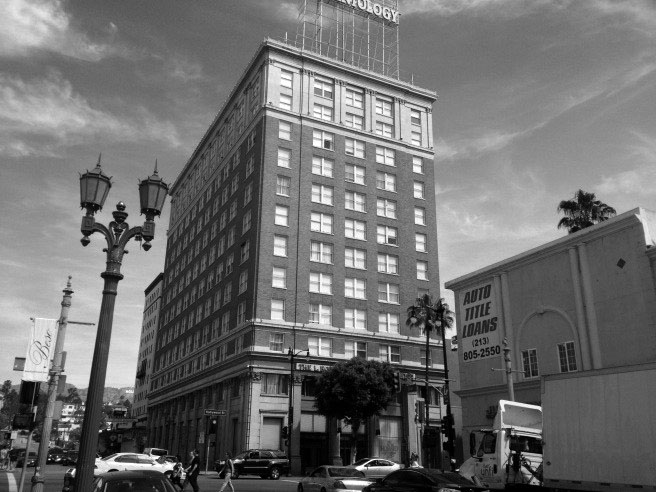 |
|
| (ca. 2016)*.* - View looking northeast on Ivar Avenue toward Hollywood Boulevard showing the Hollywood Guaranty Building located on the NE corner. Click HERE to see more contemporary street view. |
Historical Notes The twelve-story, Beaux Arts-style Guaranty Building (6331 Hollywood Blvd), designed by John C. Austin, was constructed in 1923. It was added to the National Register of Historic Places in 1979. In 1988 it was purchased by the Church of Scientology. |
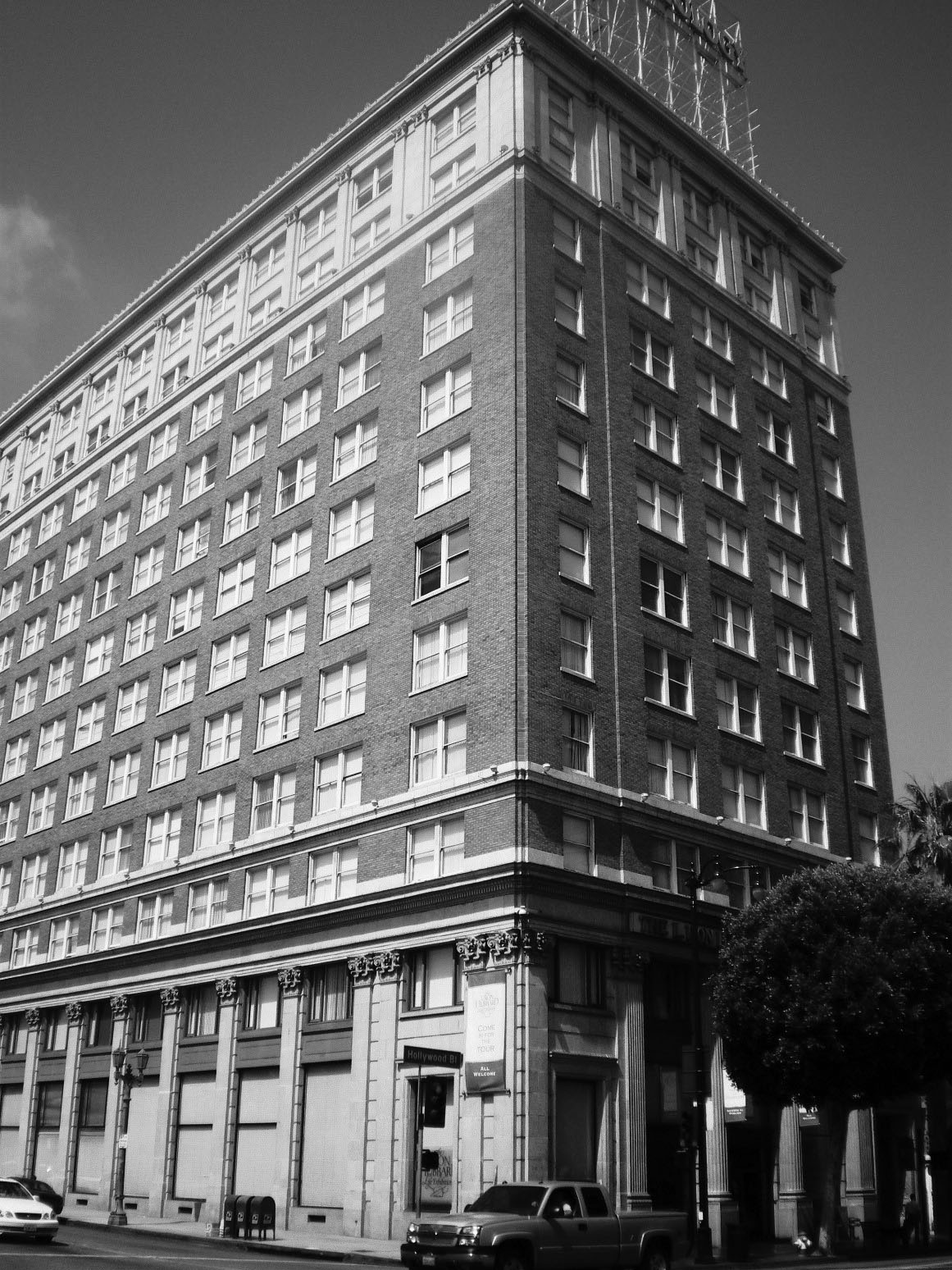 |
|
| (2008)^* – Close-up view of the Guaranty Building, located at 6331 Hollywood Boulevard in Hollywood. |
* * * * * |
Vista Theatre (originally Bard's Theatre)
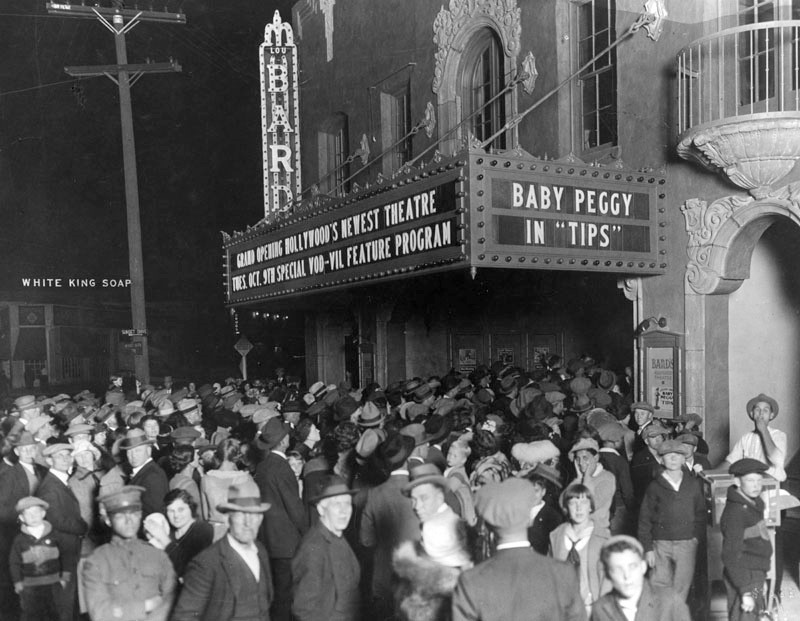 |
|
| (1923)* – View showing the opening of Bard’s Hollywood Theatre (later Vista Theatre), located at 4473 Sunset Drive in East Hollywood. Featuring Baby Peggy in "Tips". |
Historical Notes Bard’s Hollywood Theatre opened on October 16, 1923 with Baby Peggy in “Tips” plus vaudeville acts on stage. After the famous impresario Sid Grauman opened the Grauman's Egyptian Theatre in 1922, there appeared several movie palaces done in the Egyptian Revival Style in Los Angeles, Bard's Hollywood being one of the first; this wave of interest in Egyptian antiquities corresponded with the discovery of the tomb of King Tutankhamen in November 1922 by Howard Carter and the Earl of Carnarvon in the Valley of the Tombs near Luxor; their expedition electrified the world having recovered over 5000 relics, many composed of gold and alabaster; the theatre's exterior, done in the Spanish Colonial Revival Style, clashed notably with its Egyptian interior. Architect: Lewis A. Smith |
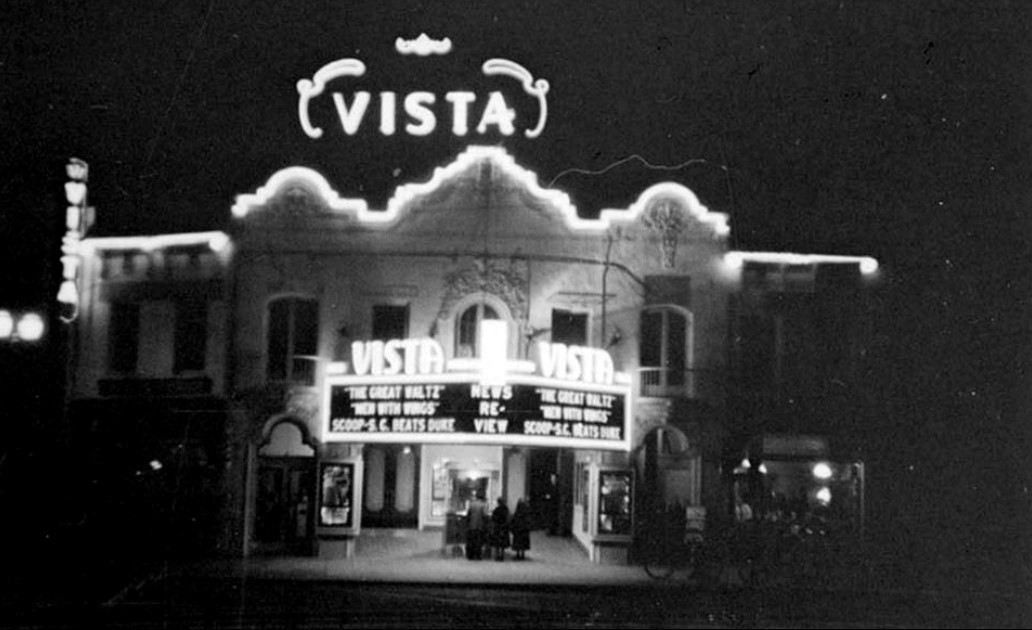 |
|
| (ca. 1938)* - Nighttime view of the Vista Theatre (previously Bard's Hollywood Theatre) with its new neon marquee. |
Historical Notes By the late 1920s, Bard's Hollywood Theatre became known as the "Vista." A new neon marquee was erected in 1938 for $1,000. The Vista also features a variety of hand and foot prints in cement that commemorate some of the cast and crew members of films screened at the theatre. |
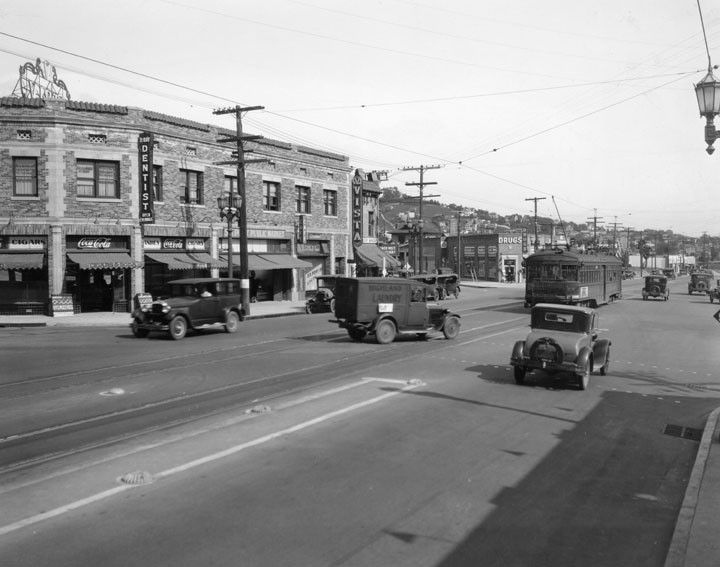 |
|
| (1930)* – View looking east showing the junction of Hollywood and Sunset. The marquee of the Vista Theater is visible at top center. |
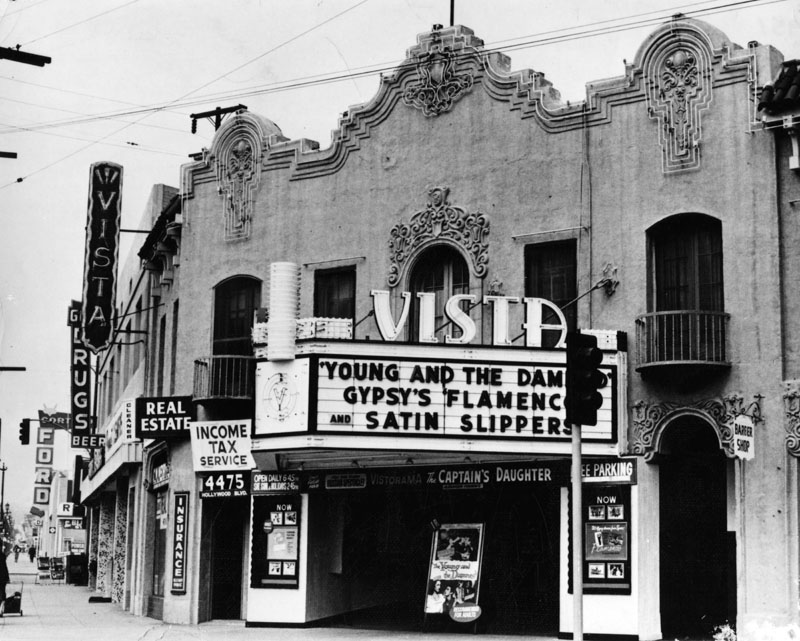 |
|
| (1951)* - View showing the Vista Theatre in East Hollywood, 4473 Sunset Drive. Note the architectural design details (Spanish Colonial Revival Style) on the face of the building. Architect: Lewis A. Smith. |
Historical Notes Alongside its elegant facade, the interior with its Egyptian designs is the true stunner at this old single screen palace. The original seating capacity in the auditorium held space for 838 seats. The owners later removed every other row to allow for increased legroom, reducing the number of seats to 400. |
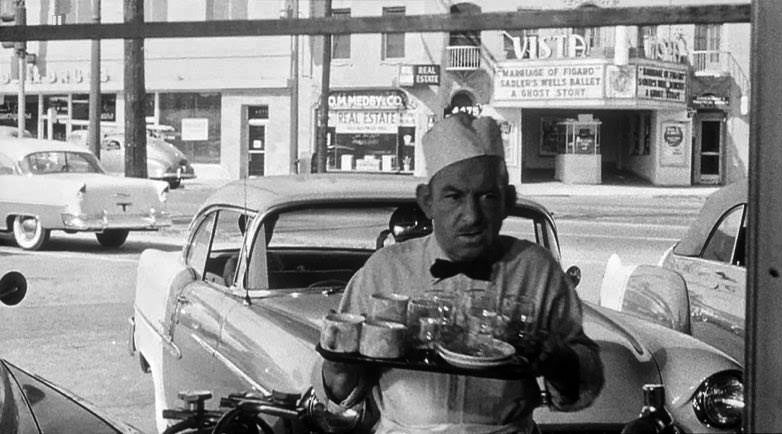 |
|
| (1955)* - A shot of the Vista Theatre from inside Stan's Drive-in Restaurant seen in "The Crooked Web" (Columbia, 1955). Thanks to Jonathan Raines for the screenshot. |
Historical Notes The Vista appears on the cover of Suicidal Tendencies' album Lights...Camera...Revolution! (1990). It also appears in the nighttime portions of the music video for Pharrell Williams's 2013 song "Happy", from the film Despicable Me 2. The theatre appears in the film True Romance (1993), as the place where Christian Slater's and Patricia Arquette's characters first meet. It also appears in the film The Crooked Web (1955), while the 'Walls of Babylon' scenes from D. W. Griffith's film Intolerance (1916) were filmed on the site before the theater was constructed. The Vista also appears in the made-for-television film Return to the Batcave: The Misadventures of Adam and Burt (2003). |
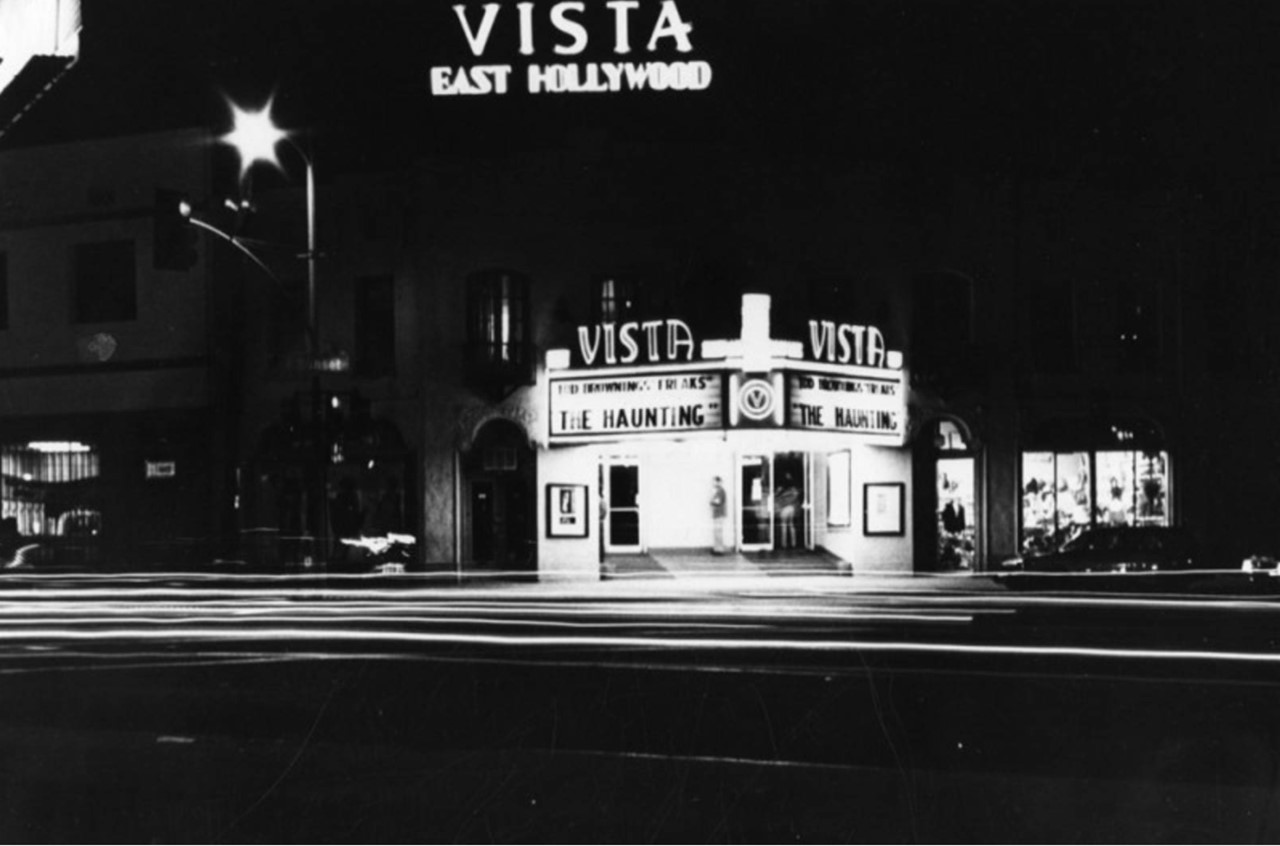 |
|
| (1970s)* - View of the front of Egyptian revival style Vista Theater taken at night. Stores to the side are dark except for a lighted window to the right and the front of the theater which is lit up. A sign high above is also lit and reads: Vista, East Hollywood. Film on marquee is The Haunting. Photo by Tom LaBonge. |
Historical Notes Until its refurbishment by Thomas Theaters in 1980, the theatre showed softcore pornography, then moved to hardcore porn and finally gay porn for 20 years. It also showed gay-oriented non-pornographic films, including the local premiere of The Times of Harvey Milk (1984). |
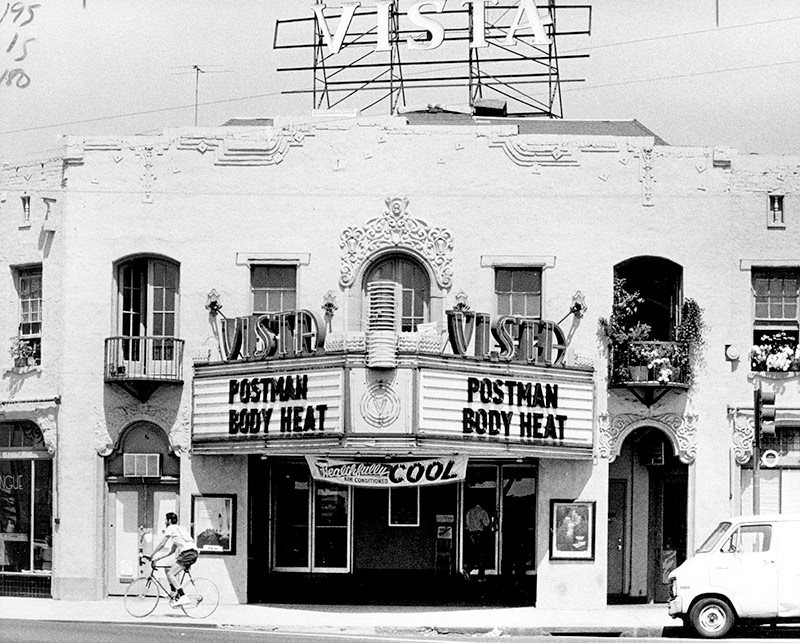 |
|
| (1980s)* - View showing a lone bicycle rider passing by the Vista Theatre. Now Playing: Postman and Body Heat. |
Historical Notes The Vista got a new screen in the early 1980s during the time it was owned by Landmark Theatres; at this time the theatre reverted to showing revival films. Landmark dropped the lease on the Vista in 1985. |
 |
|
| (1983)* – Vista Theatre double feature: Romeo and Juliet & West Side Story |
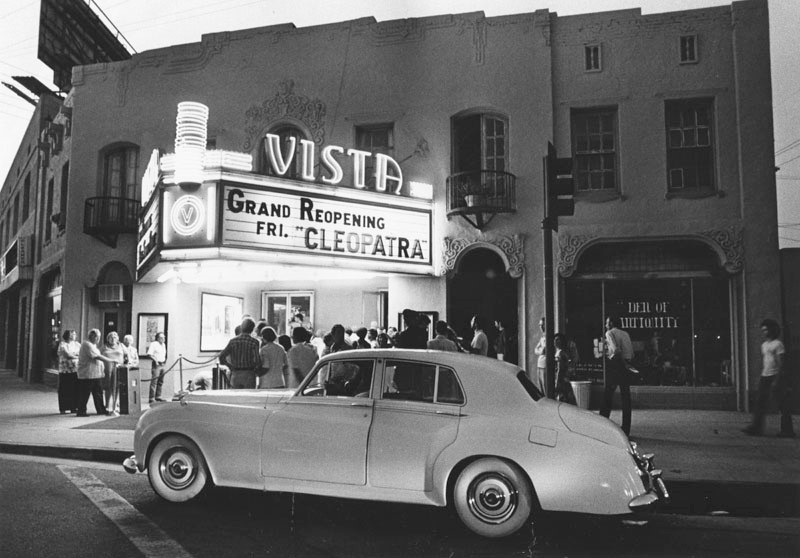 |
|
| (1980)* - A crowd of people stand at the entranceway awaiting the grand reopening of the Egyptian revival style Vista Theater, featuring the 1934 version of "Cleopatra." Silent-film star Mary MacLaren (1896-1985) helped re-open the Vista. Baby Peggy came back: In 1923 she opened the theater. |
Historical Notes In a manner reminiscent of Grauman's Chinese Theatre, the theater's forecourt features cement handprints and footprints of notable film figures. However, the handprints and footprints at the Vista Theatre tend to include more icons of independent and cult films such as Spike Jonze, John C. Reilly and Martin Landau, among many others.^ Click HERE for contemporary view of the Vista Theatre. In July 2021, director Quentin Tarantino revealed that he had purchased the theater. Tarantino has stated that the Vista will remain a first-run theater, and wherever possible, they will be screening 35mm prints. |
* * * * * |
Jensen's Recreation Center
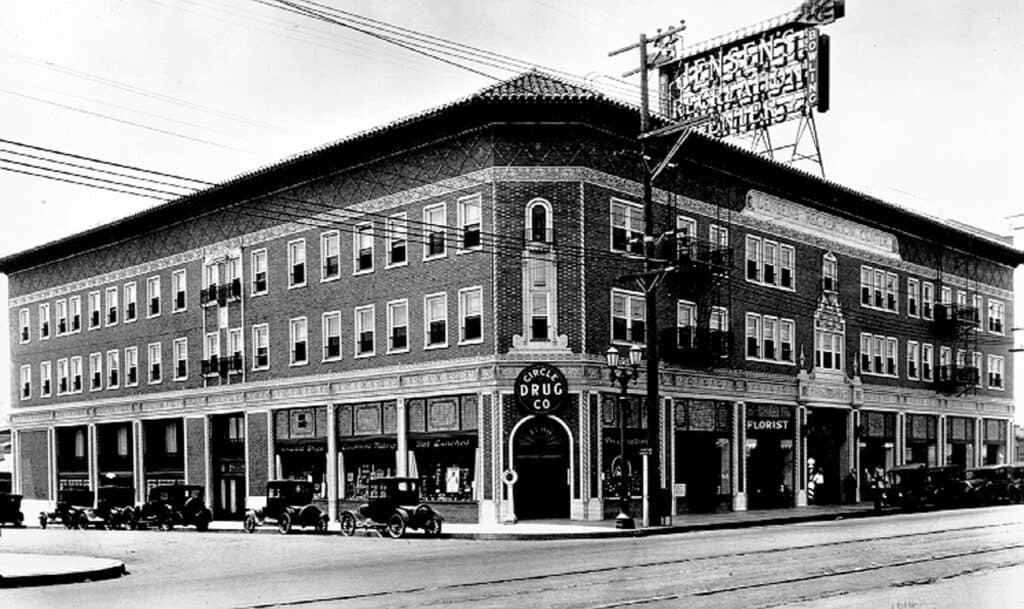 |
|
| (1924)* – View looking southwest toward the newly completed Jensen’s Recreation Center at the corner of Sunset Boulevard and Logan Street. Circle Drug Store occupies the ground-floor corner space. A penny scale stands outside the store’s entrance, and a barber’s pole marks the entrance to the recreational facilities inside. Several Model T Fords are parked along the curb. |
Historical Notes Built in 1924 by Danish-German immigrant and entrepreneur Henry Christian Jensen, this three-story Beaux Arts-style building combined retail, entertainment, and residential functions in one complex—an early forerunner of the mixed-use developments we see today. The building originally housed a bowling alley in the basement, a billiard hall upstairs, and 46 apartments on the upper floors. The ground-floor commercial spaces included shops and service businesses like Circle Drug Store. Jensen, a successful brick manufacturer, also built theaters and commercial buildings across Southern California including Jensen’s Theatorium (Echo Park), Raymond Theatre (Pasadena), and Palace Grand Theatre (Glendale). |
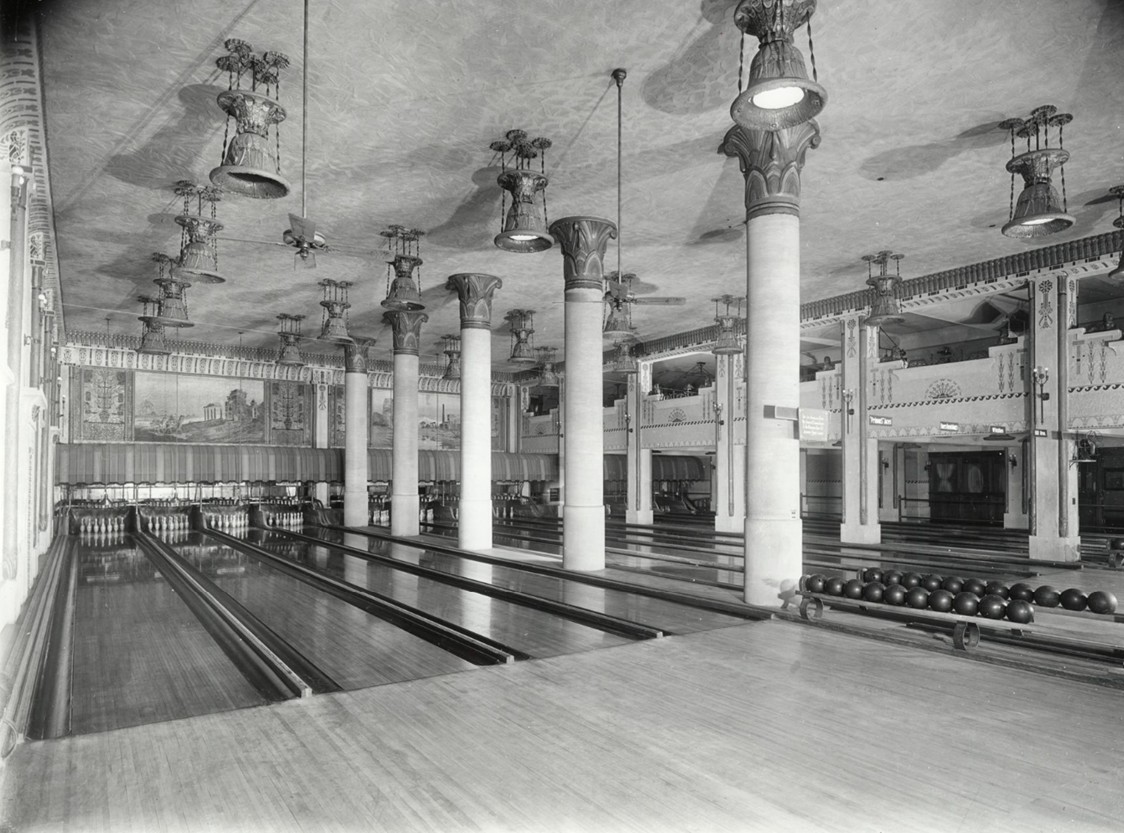 |
|
| (ca. 1929)* - Interior view of the bowling alley in the basement of Jensen’s Recreation Center, featuring Beaux Arts-inspired capitals, decorative tile trim, and hand-painted murals above the pins. |
Historical Notes The basement bowling alley was among the finest in Los Angeles during the 1920s, noted for its architectural details and ornamentation. Pillars adorned with Beaux Arts-style capitals supported the space, while tilework and murals added touches of elegance uncommon for such recreational venues at the time. The alley hosted public leagues, exhibitions, and even celebrity tournaments. This attention to style reflected Jensen’s vision of combining functionality with aesthetic appeal. |
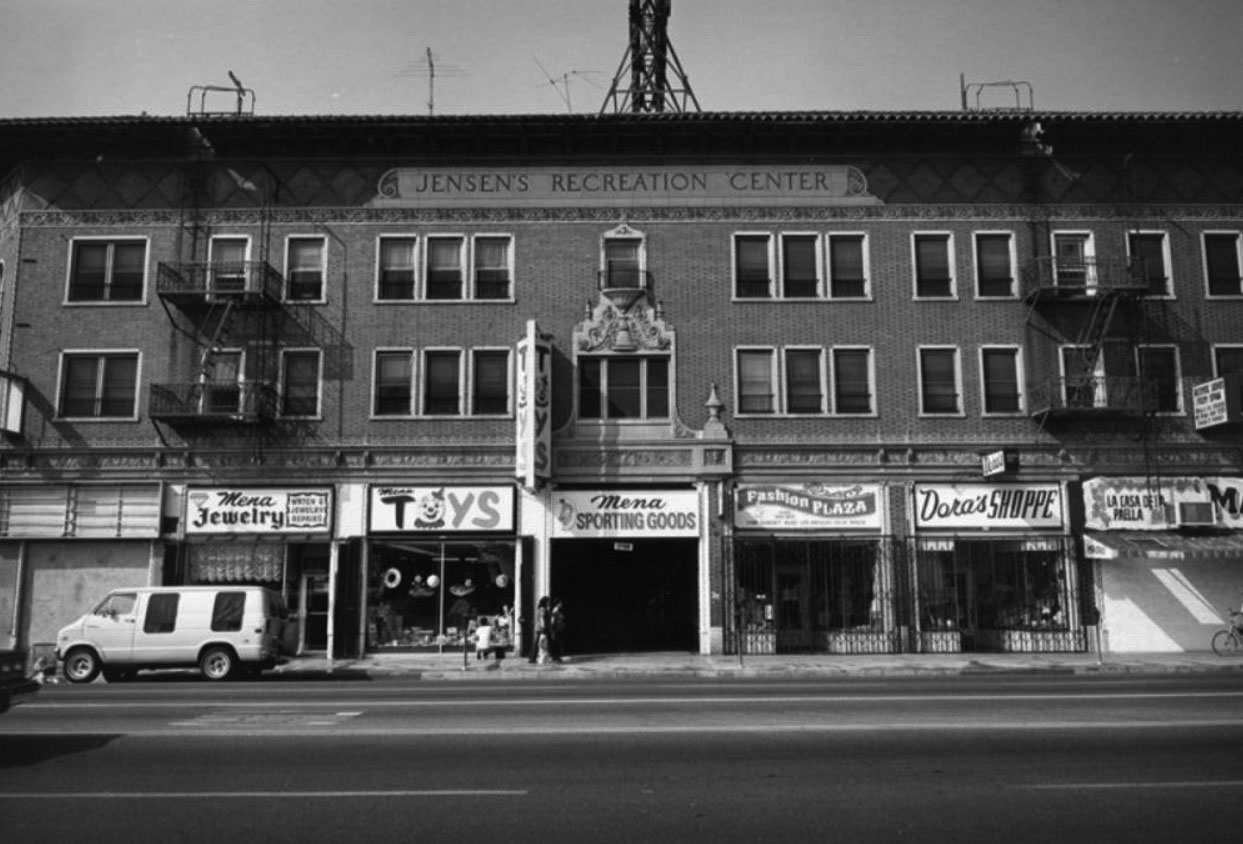 |
|
| (1981)* - View showing the Jensen’s Recreation Center at 1706 W. Sunset Boulevard, still serving as a retail and residential building. |
Historical Notes By the 1980s, Jensen’s Recreation Center had evolved into a typical urban commercial property, with street-level retail shops and residential units above. The original recreational functions—bowling and billiards—had largely faded by this time. Yet, despite the changes, the building’s architectural integrity remained largely intact. In 1998, the structure was recognized for its historical and cultural value and designated Los Angeles Historic-Cultural Monument No. 652. |
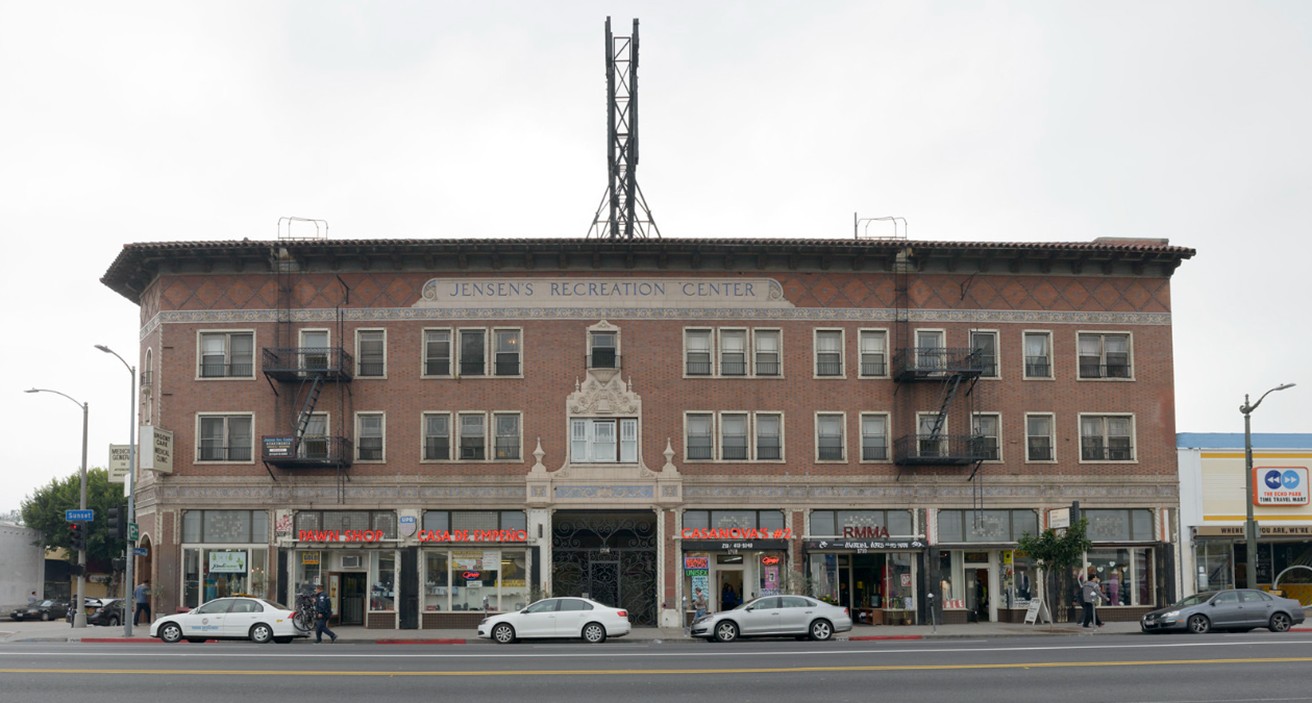 |
|
| (2013)* - Looking across Sunset Boulevard toward Jensen’s Recreation Center following major renovations. Photo courtesy of Non-F' via Flickr. |
Historical Notes In 2004, Sebren Development undertook a major renovation of the building, converting the former bowling alley into commercial space and updating the residential units. Among the preservation efforts was the restoration of a large Egyptian-themed mural—one of the few surviving elements of the original bowling alley. The building’s most iconic feature, the rooftop animated sign depicting a bowler throwing a strike, underwent a complex restoration between 1997 and 2005, funded in part by the Los Angeles County Preservation Society. The sign contains over 1,300 incandescent bulbs and is rarely lit due to energy use and preservation concerns. |
Then and Now
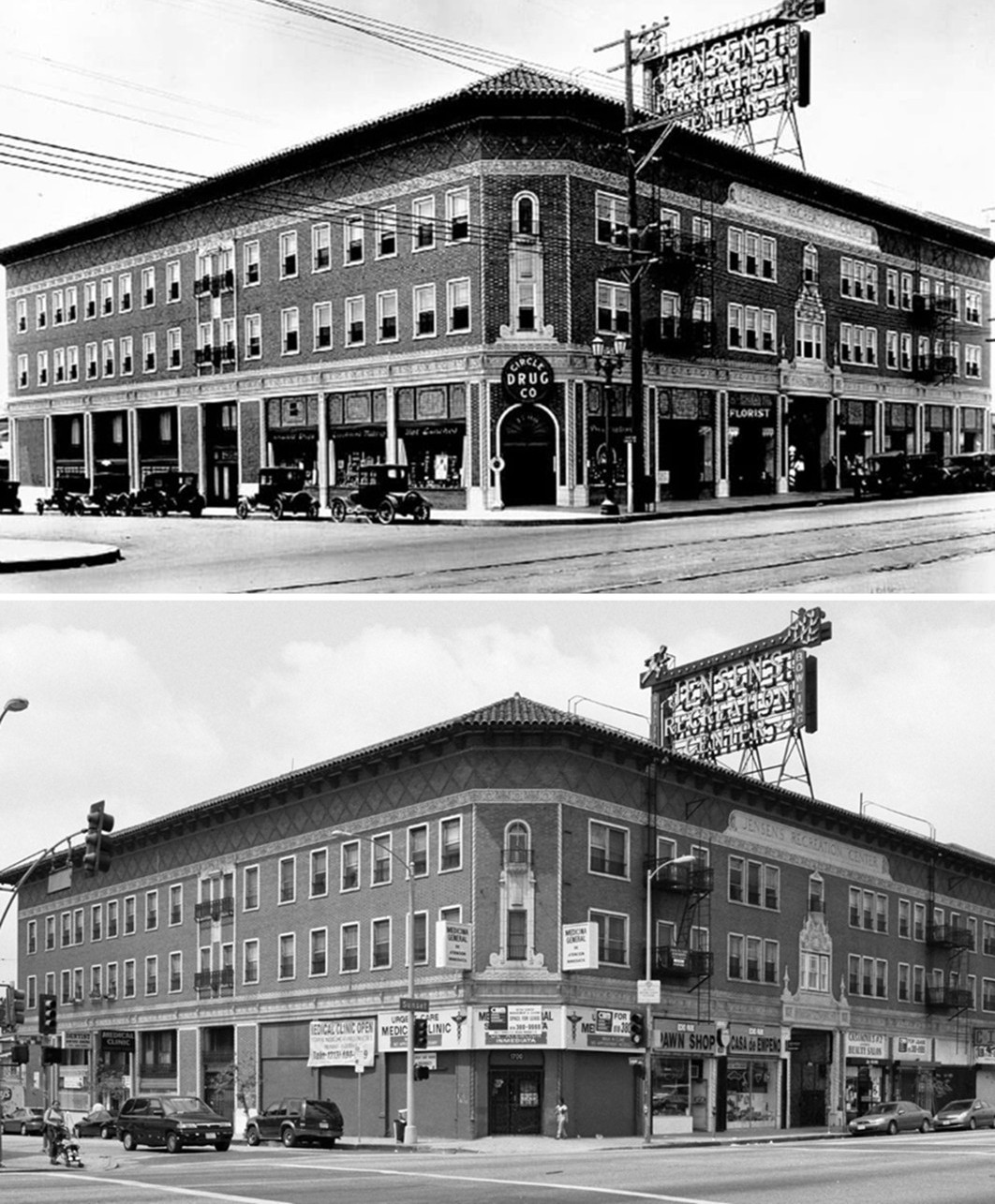 |
|
| (1924 vs. 2008)* - Then and now comparison of Jensen’s Recreation Center at 1700 W. Sunset Boulevard, Echo Park. Photo comparison by Jack Feldman. |
Historical Notes Despite nearly a century of change, the building’s façade and rooftop sign remain defining elements of the Sunset Boulevard streetscape. The 2008 view shows careful preservation of the structure’s architectural character. While the uses within have changed, the building still functions as a mixed-use landmark and contributes to the evolving cultural fabric of Echo Park. |
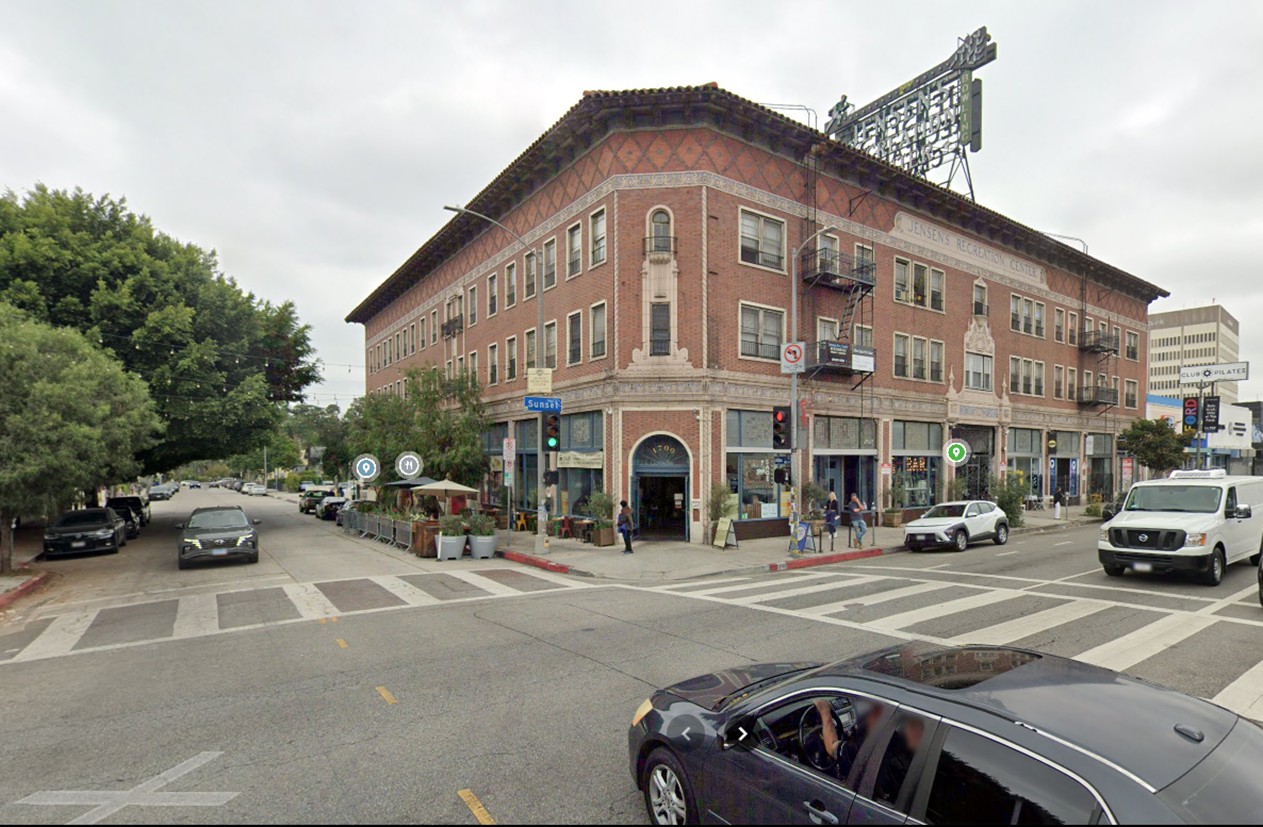 |
|
| (2024)* - Modern-day view of the Jensen Recreation Center on the southwest corner of Sunset Boulevard and Logan Street. |
Historical Notes Nearly a century after its construction, the Jensen’s Recreation Center remains a defining landmark in Echo Park. Its original mix of residential and commercial space—along with the now-iconic rooftop animated sign—reflects an era when architecture served both form and function. Though the original recreational facilities are long gone, the building continues to be actively used and appreciated for its historical character and visual presence. |
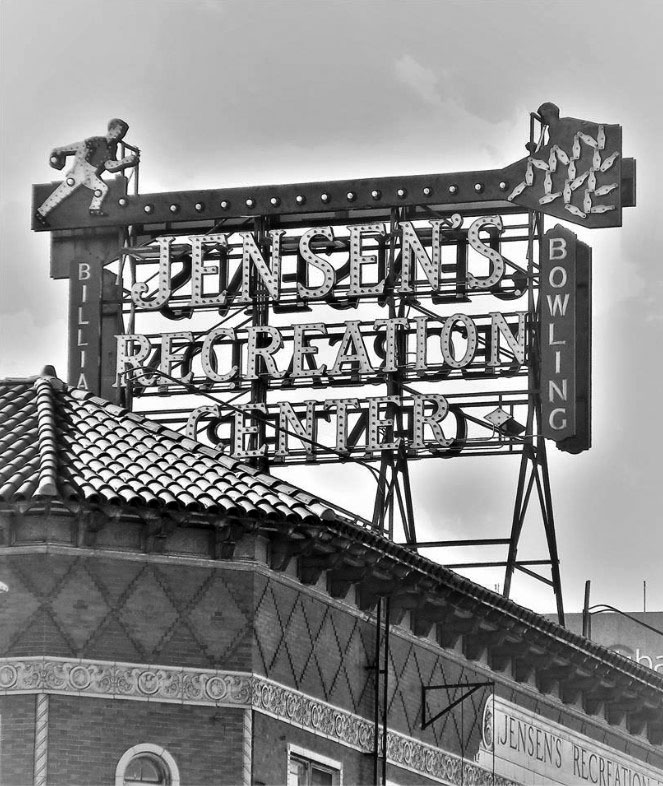 |
|
| (2019)* - Close-up view of Jensen’s animated rooftop sign depicting a bowler in action. Photo by Howard Gray. |
Historical Notes Measuring 17 feet tall by 28 feet wide, the rooftop sign is among the most unique animated signs in Los Angeles. Originally installed in the 1920s, it uses sequential incandescent lighting to depict a bowler approaching and releasing a ball toward ten pins. It was fully restored between 1997 and 2005 and now functions more as a static landmark than an active advertisement. The sign and building together were designated LA Historic-Cultural Monument No. 652 in 1998. |
* * * * * |
Beverly Theater (Beverly Hills)
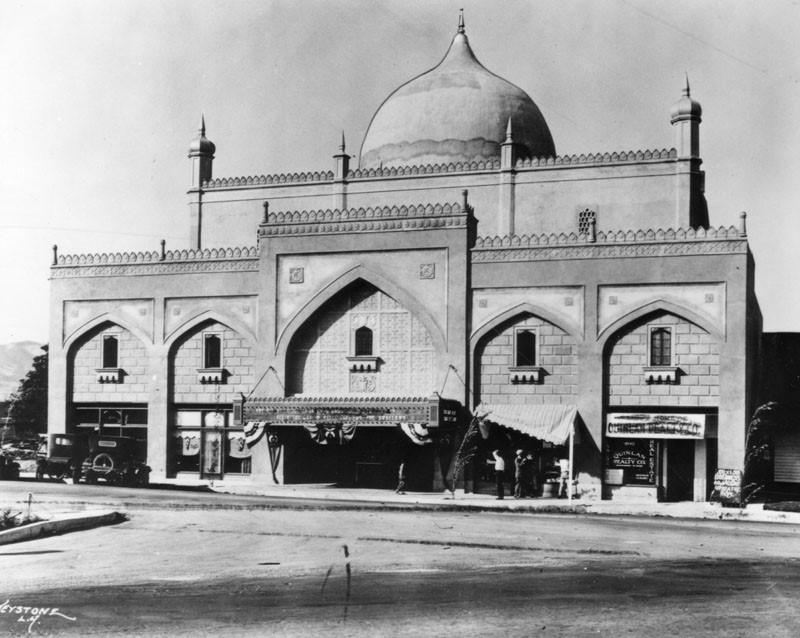 |
|
| (1925)* – View showing the newly built Beverly Theater located at 206 N. Beverly Drive. Its grand opening was May 18th, 1925. |
Historical Notes Designed by L.A. Smith in a style inspired by The Tomb of Second Mughal Emperor Humayun, Delhi 1880's. This was the first vaudeville and movie theater in Beverly Hills. It was built for Beverly Hills real estate mogul Daniel Quinlan.* There was retail on the ground floor and two studios on the 2nd floor. The south storefront was occupied by Daniel Quinlan's real estate office. The Quinlan family owned the building until 1936 when it got traded for property behind the Beverly Hills hotel. |
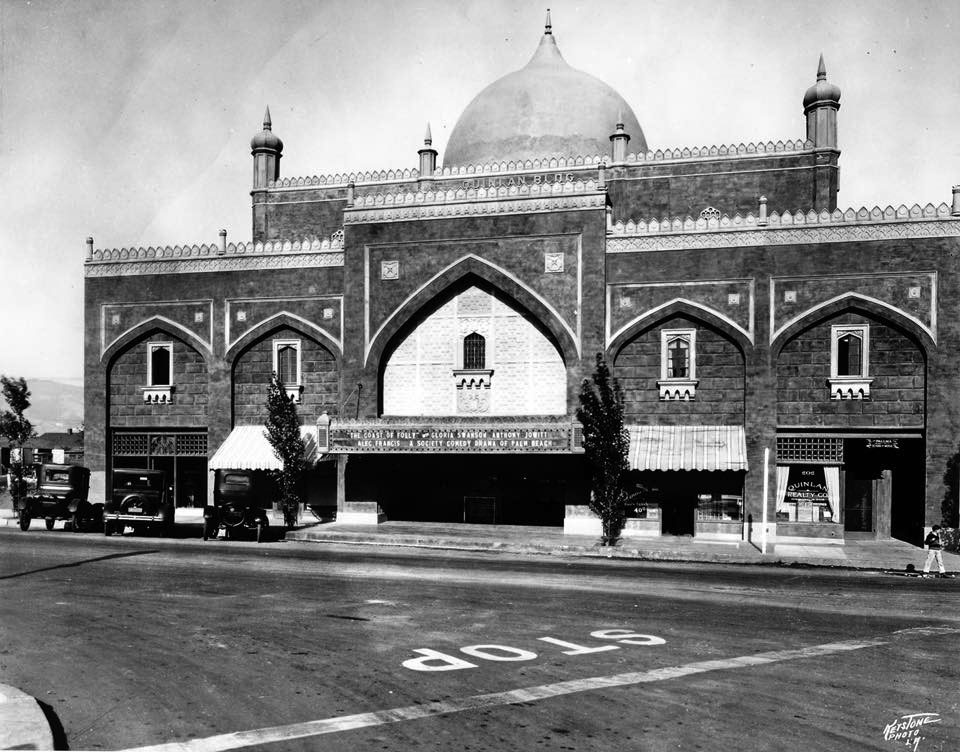 |
|
| (1920s)* – View showing the Beverly Theater designed in the Indo-Chinese style and topped with an onion tower. |
Historical Notes The theater was initially operated by West Coast Theatres as the West Coast Beverly. When the chain became Fox West Coast in 1929 the theatre was called the Fox Beverly. It stayed in the circuit until the late 50s and had a whole series of other operators: Amusement Corp. of America, Statewide, Loew's (as Loew's Beverly) and General Cinema. |
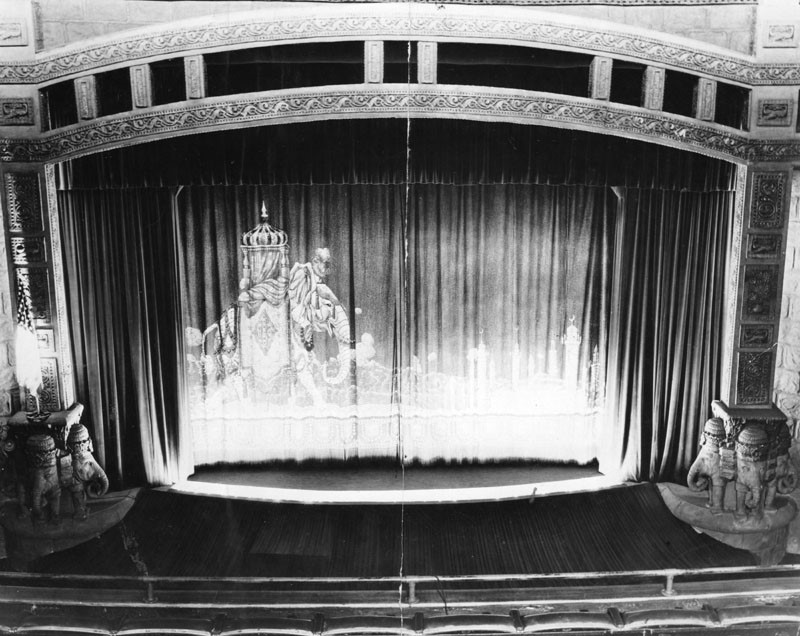 |
|
| (1940)* - Auditorium and stage area of the Beverly Theater. Carved elephants decorate the bottom of pillars on either side of the stage, and this motif is continued on the stage curtain. |
Historical Notes The Beverly Theater had a huge Wurlitzer Orchestral pipe organ. When it opened the theater also had an eight-piece orchestra as part of the house staff. |
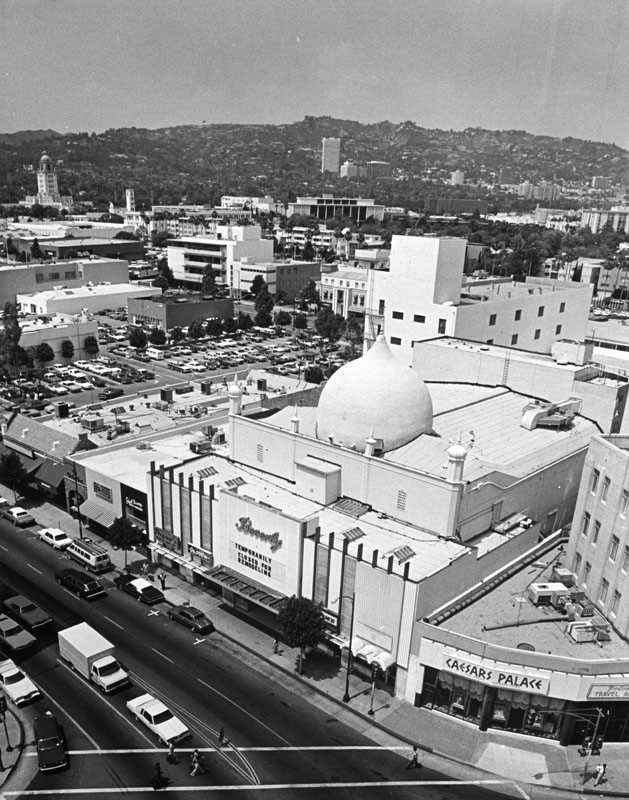 |
|
| (1970s)* - Aerial view of Beverly Hills with the domed Beverly Theater in the foreground at the intersection of Beverly Drive and Wilshire Boulevard. |
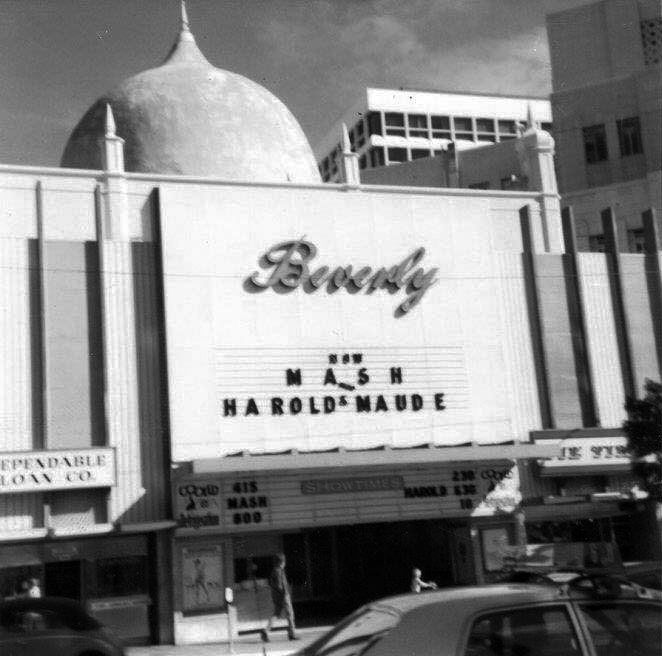 |
|
| (1974)* – Front view of the Beverly Hills Theater with a double feature showing "MASH" and "HAROLD & MAUDE". |
Historical Notes In the mid-1970’s, Beverly Hills had a number of theaters. But with the noise & traffic generated by such films as “Tommy”, “Woodstock”, and others, local citizens began to complain. Responding to these local complaints, General Cinemas closed the theater in 1977. |
.jpg) |
|
| (1978)* - Evening view of the Moorish style structure, located at 206 N. Beverly Drive in Beverly Hills, originally known as the Beverly Theater; a Christmas garland hangs from above. |
Historical Notes In 1977, after decades of serving as a movie house, the building was closed. The interior was gutted and redesigned to accommodate commercial use; it was occupied by Fiorucci, a boutique and later an Israeli bank. |
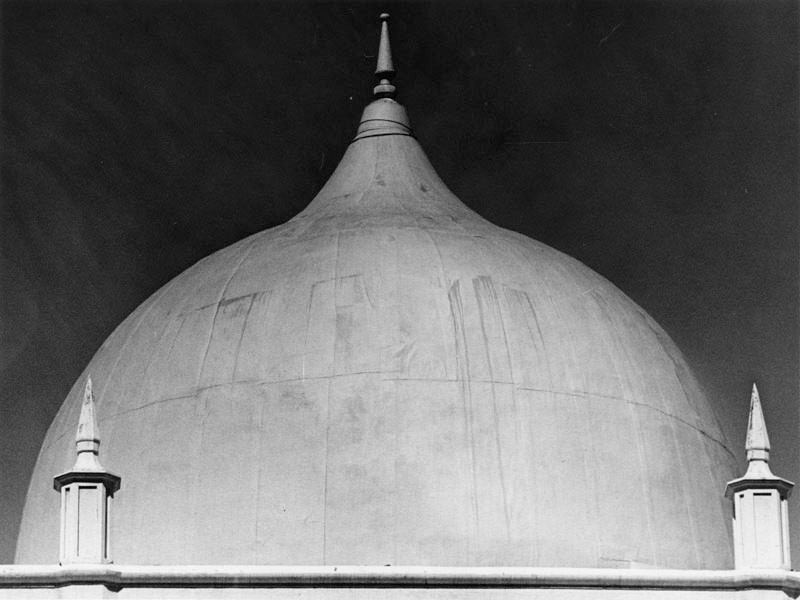 |
|
| (1978)* - Close-up view showing the dome of the old Beverly Theatre, at time of photo a bank. |
Historical Notes After many years of housing a bank, the Beverly Theater was sadly demolished in August of 2005 to make way for new development. The onion dome ... brings to mind Beverly Hills' temporary original name, "Morocco". Click HERE to see more in Early Views of Beverly Hills. |
* * * * * |
Farmers and Merchants National Bank
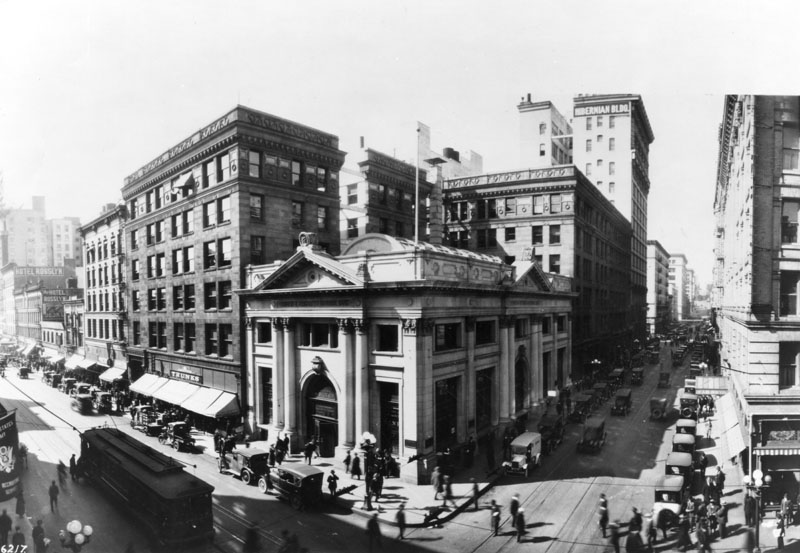 |
|
| (1923)* - Exterior view of Farmers and Merchants National Bank of Los Angeles, located at the southwest corner of 4th and Main Streets. Note the architectural designs on the building. |
Historical Notes Designed in the Classical Revival style, the Farmers and Merchants Bank remains one of Southern California's finest examples of the early "temples of finance" which were popular at the turn of the century. Its two-story facade, reminiscent of a Roman temple, is punctuated by an entrance framed with Corinthian columns topped by a large triangular pediment. Built in 1905, the bank was designed by the firm of Morgan and Walls. The Farmers and Merchants Bank was the first incorporated bank in Los Angeles, founded in 1871 by 23 prominent Los Angeles businessmen, with an initial capital of $500,000. The three largest subscribers were Isaias W. Hellman ($100,000), former California Governor John G. Downey ($100,000), and Ozro W. Childs ($50,000) who in later years became the founders of the University of Southern California. Other investors included Charles Ducommun ($25,000), I.M. Hellman ($20,000) and Jose Mascarel ($10,000.) Downey was named the first president. Isaias later served as president of the bank till his death in 1920.^* Click HERE to see more Early Views of the Farmers and Merchants Bank. |
* * * * * |
Biltmore Hotel
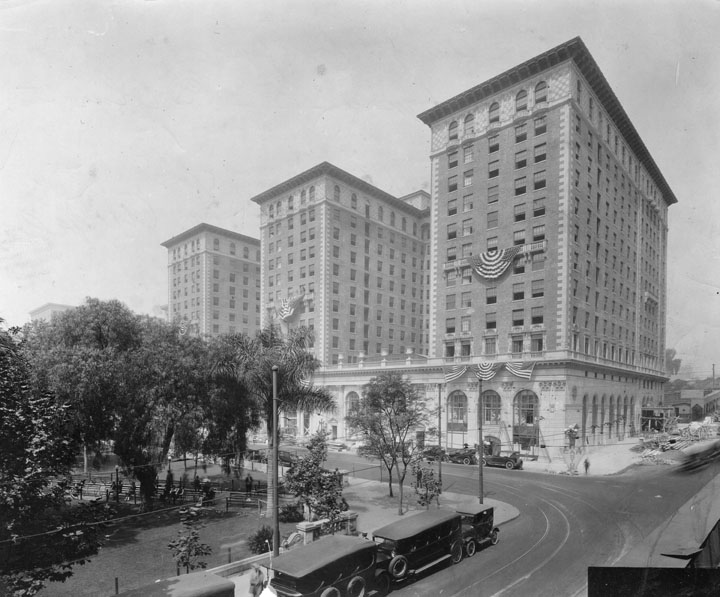 |
|
| (1923)* - People sit in Pershing Square while across the street flag decorated banners hang from the still unfinished Biltmore Hotel. The view at the corner of 5th and Olive shows building materials on the 5th St. side of the hotel. |
Historical Notes The Los Angeles Biltmore Hotel opened in 1923. With it's 1,500 guest rooms, it was the largest hotel west of Chicago. |
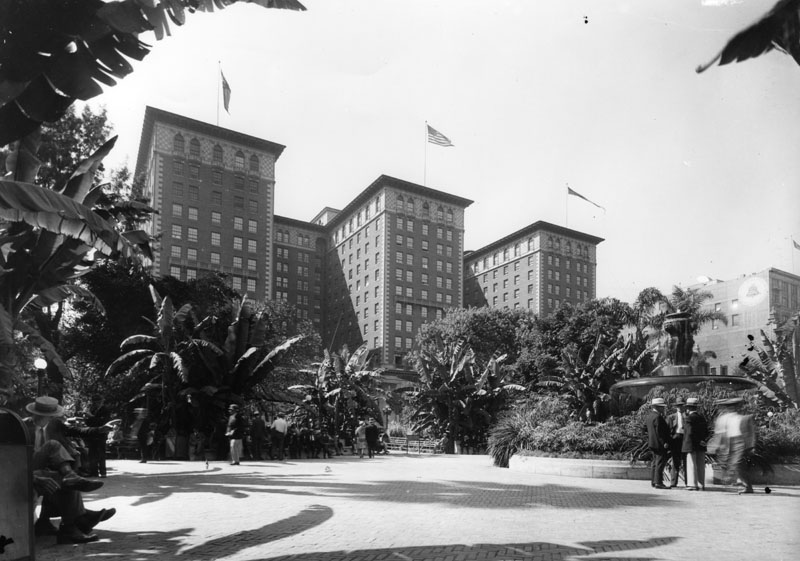 |
|
| (ca. 1923)* - View of the three towers of the Biltmore Hotel at 515 South Olive Street, as seen from the center plaza of Pershing Square. |
Historical Notes The architectural firm Schultze & Weaver designed the Biltmore's exterior in a synthesis of the Spanish-Italian Renaissance Revival, Mediterranean Revival, and Beaux Arts styles, meant as an homage to the Castilian heritage of Los Angeles. The "Biltmore Angel" is heavily incorporated into the design—as a symbol of the city as well as the Biltmore itself. With a thick steel and concrete frame, the structure takes up half a city block and rises over 11 stories. |
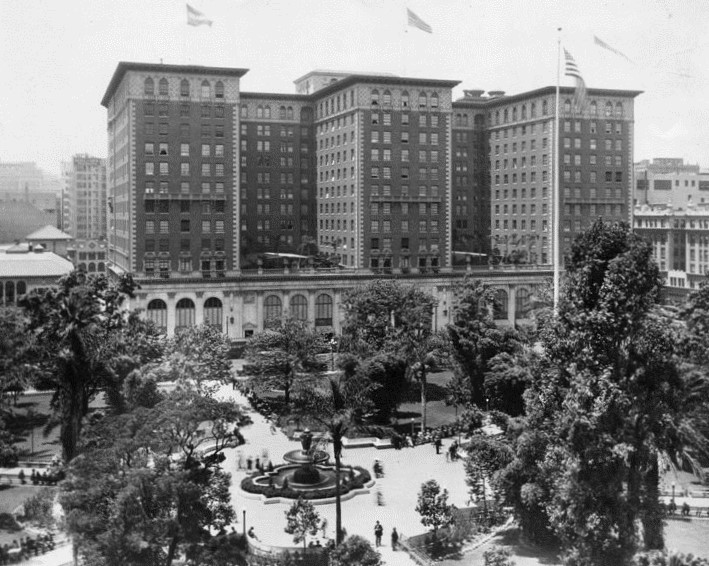 |
|
| (1920s)* - People, fountain, trees and bushes of Pershing Square are in the foreground, while the Biltmore Hotel and Biltmore Garage are in the background across Olive Street. |
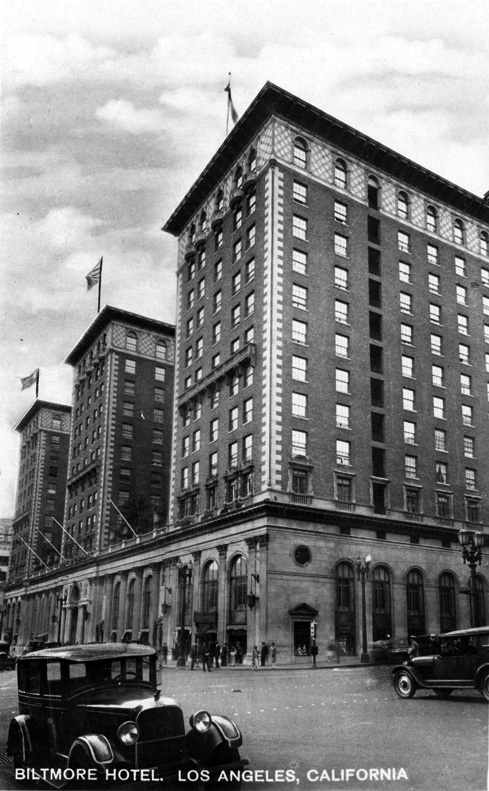 |
|
| (ca. 1930)^*# - View of Biltmore Hotel on the corner of 5th Street and Olive. |
 |
|
| (1940s)* - View showing the ornate lobby of the Biltmore Hotel. |
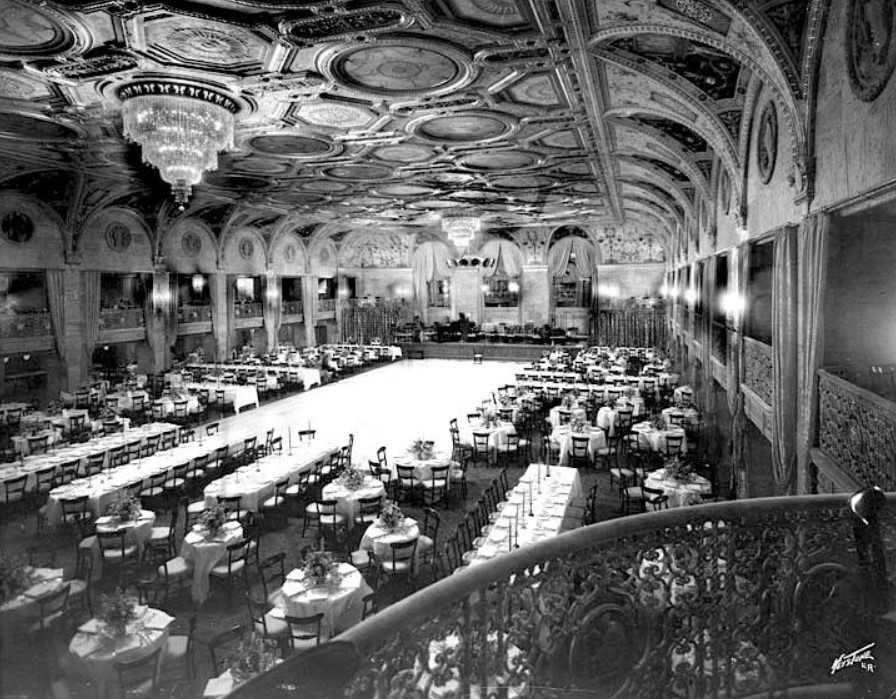 |
|
| (ca. 1930s)^ – View showing the two-story tall Biltmore ballroom (Biltmore Bowl), home to eight Oscar ceremonies. |
Historical Notes Originally called the Sala de Oro and later renamed the Biltmore Bowl, the ballroom was a vast and sumptuous space two stories tall and played host to eight Oscar ceremonies in the 30s and early 40s. In the 1950s, it suffered a devastating fire and was not rebuilt. In its place, the hotel built two smaller ballrooms.^ |
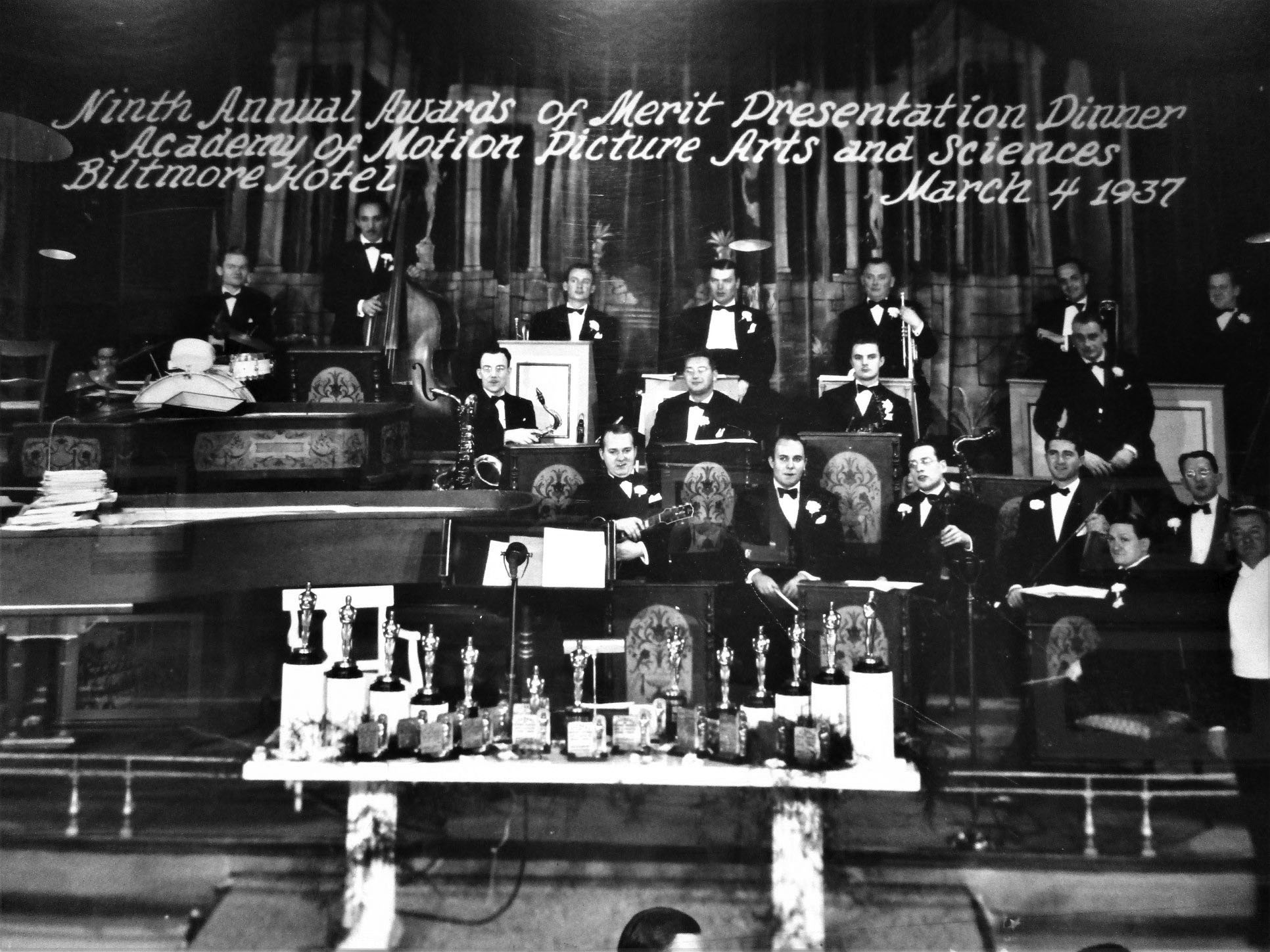 |
|
| (1937)^ – 9th Annual Awards of Merit Presentation Dinner, Academy of Motion Picture Arts and Sciences, Biltmore Hotel. This photo hangs in the Biltmore Hotel. |
Historical Notes The Los Angeles Biltmore is known for being an early home to the Academy Award Ceremony for the Oscars. The Academy of Motion Picture Arts and Sciences was founded at a luncheon banquet in the Crystal Ballroom in May 1927, when guests such as Louis B. Mayer met to discuss plans for the new organization and presenting achievement awards to colleagues in their industry. Legend has it that MGM art director Cedric Gibbons, who was in attendance, immediately grabbed a linen Biltmore napkin and sketched the design for the Oscar statue on it. Eight Oscar ceremonies were held in the Biltmore Bowl during the Academy's early years of 1931, 1935–39, and 1941-42. In 1977 Bob Hope hosted the Academy's 50th Anniversary banquet in the same room. |
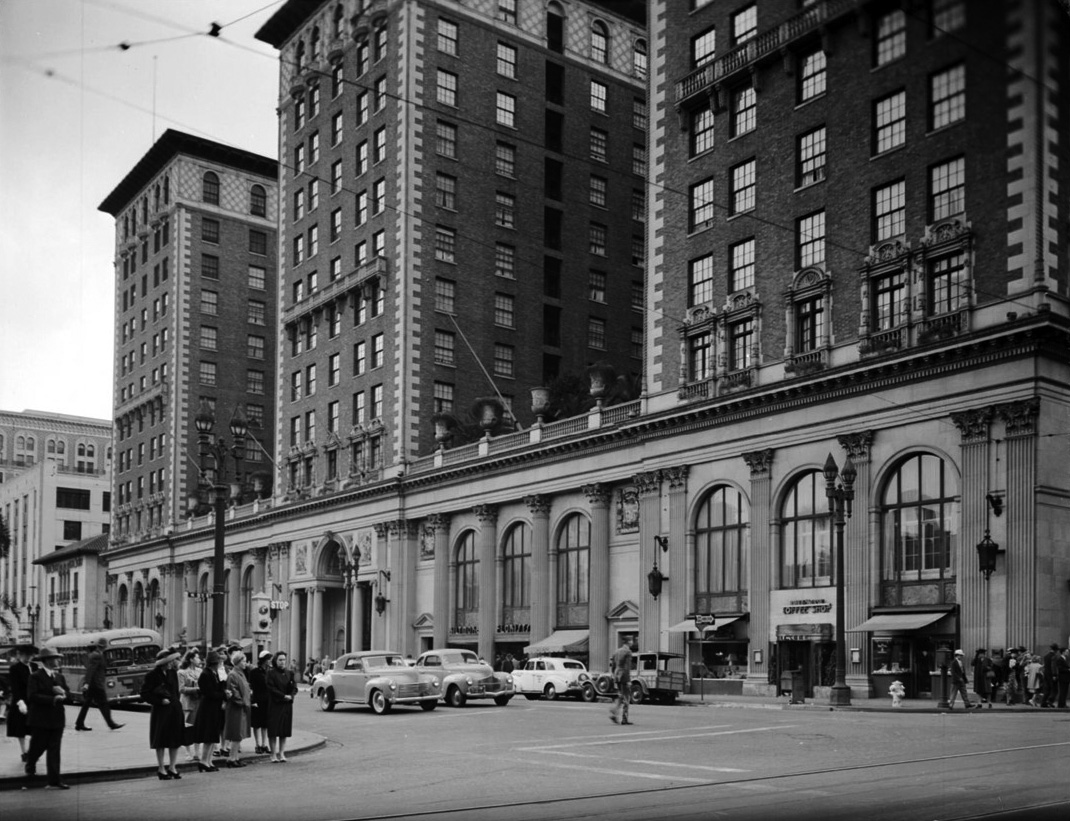 |
|
| (1943)* – The Biltmore Hotel as seen from the intersection of Olive and 5th Street. Note that the top of the streetlights are blacked-out (during WWII). |
Historical Notes During the War many streetlights throughout the City were blacked-out on top as a preventative measure. Click HERE to see more. |
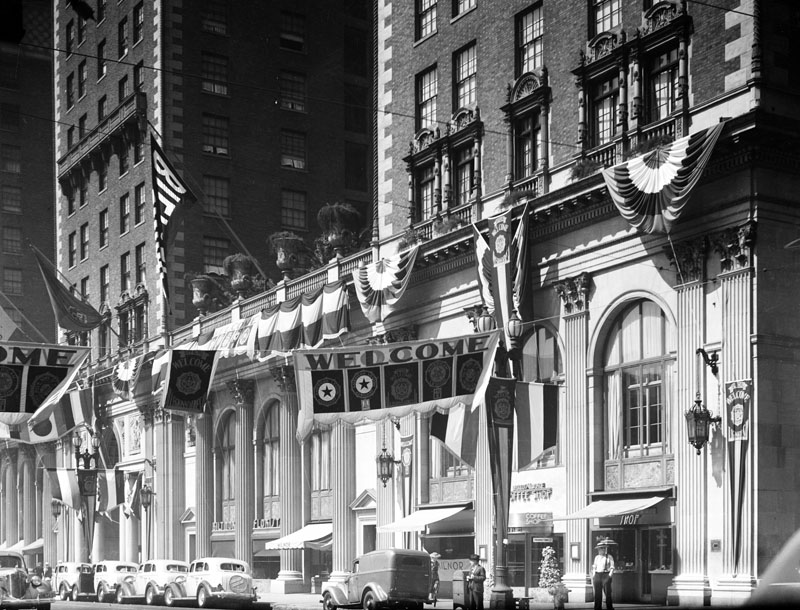 |
|
| (1940s)* - View of the lower eastern facade and entrance of the Biltmore Hotel, located at 515 South Olive Street. Buntings and a banner welcome visiting groups. |
Historical Notes In 1969 the Biltmore Hotel was designated a Los Angeles Historic-Cultural Monument No. 60 by the City of Los Angeles. Click HERE to see the LA Historic-Cultural Monument List. As of 2009, the Los Angeles Biltmore is operated as part of the Millennium & Copthorne Hotels chain as the Millennium Biltmore Hotel. From its original 1500 guestrooms it now has 683, due to room reorganization.^* |
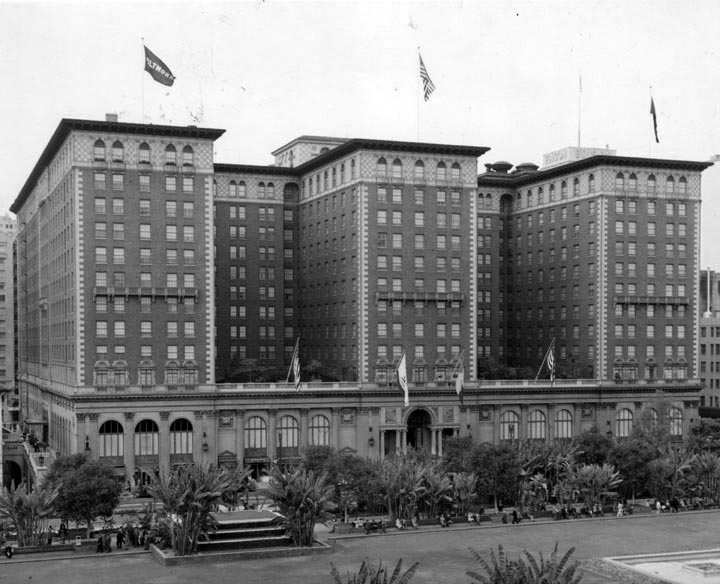 |
|
| (1950)* – View showing the Biltmore Hotel with a line of trees along the Olive Street side of Pershing Square. |
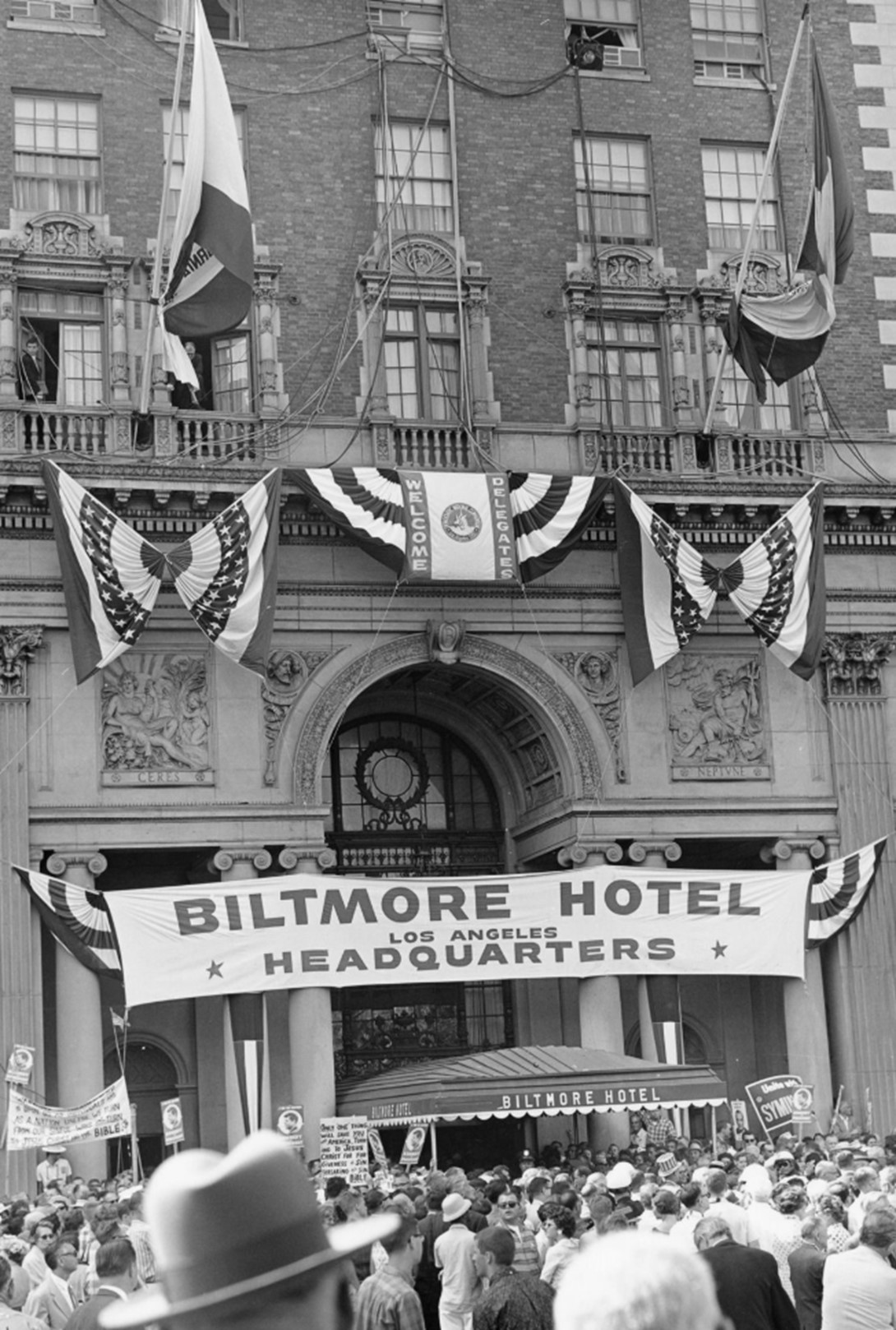 |
|
| (1960)* - Entrance to the Biltmore Hotel during 1960 Democratic Convention with banners hung outside building. Photo by William Reagh |
Historical Notes The 1960 National Democratic Convention was held at the Los Angeles Memorial Sports Arena from July 11 to July 15, 1960. This convention is notable for nominating John F. Kennedy as the Democratic candidate for President, who would go on to win the general election later that year. The Biltmore Hotel played a significant role during the convention. While the main activities, including the nomination process, took place at the Sports Arena, the Biltmore Hotel served as headquarters for many delegates and campaign activities, hosting political meetings, press conferences, and social gatherings. |
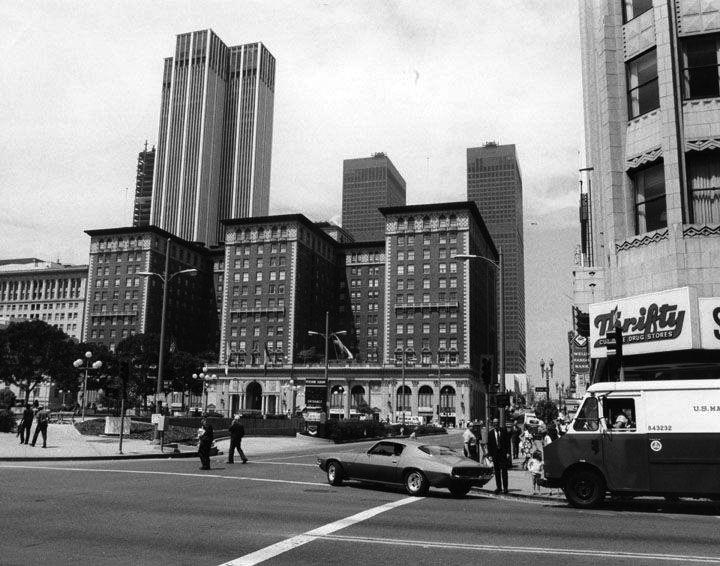 |
|
| (1970s)* – View looking west from the corner of 5th and Hill streets showing the Biltmore Hotel with Crocker-Citizens Bank Building and Arco Towers behind it. Thrifty is on the N/W corner. |
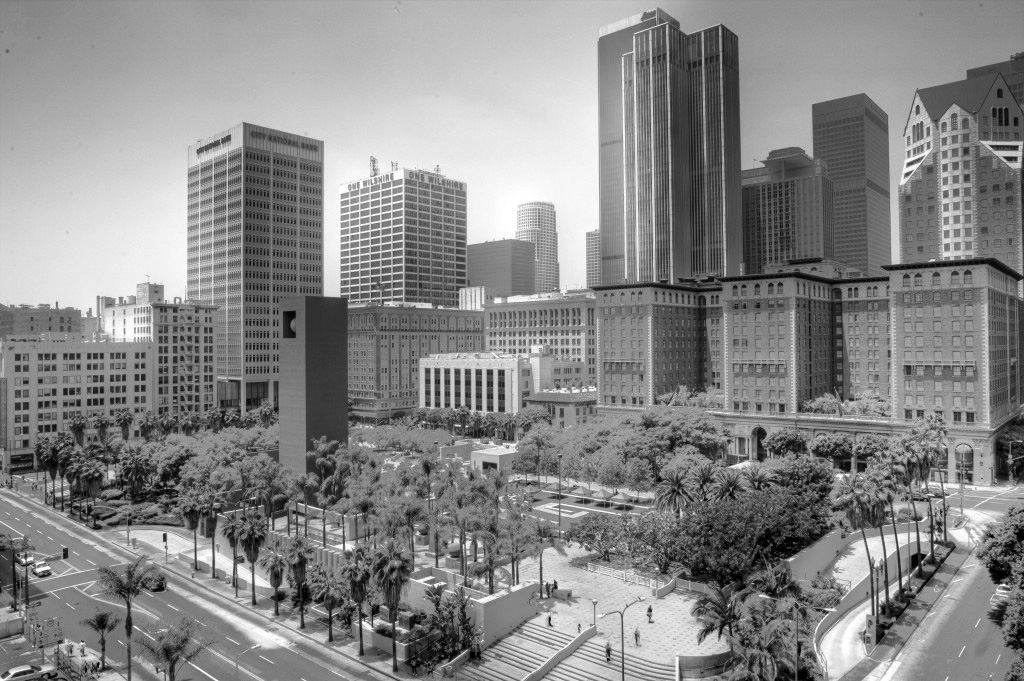 |
|
| (ca. 2011)* – View looking southwest showing Pershing Square as it appears today with the Biltmore Hotel on the right and the downtown skyline in the background. |
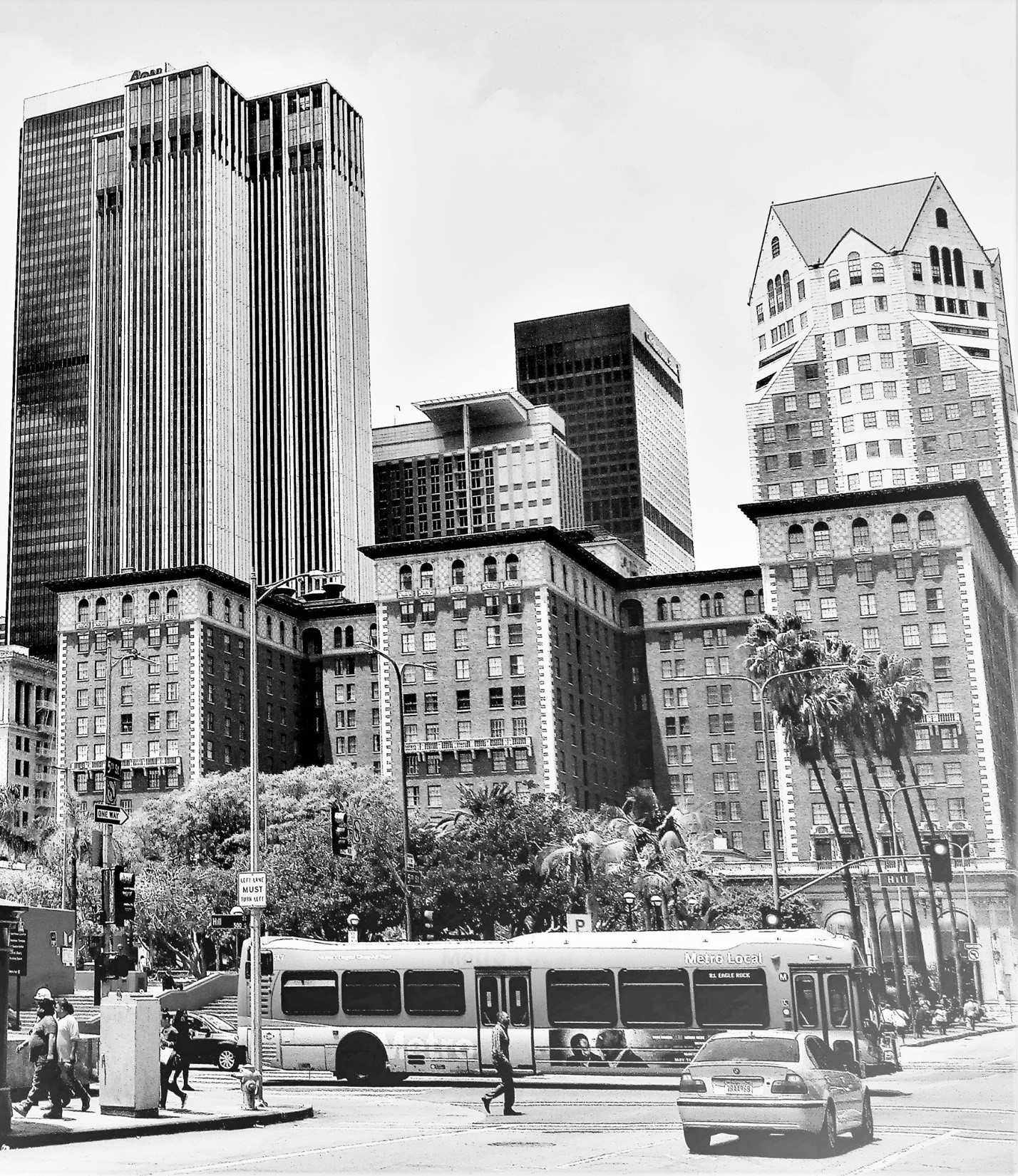 |
|
| (2016)* - Closer view showing the Biltmore Hotel with Pershing Square in the foreground and LA’s skyline to the west. Photo by Howard Gray |
 |
|
| (2017)^ – Close-up view showing the detail design on the Biltmore Hotel with the Bank Tower in the background. |
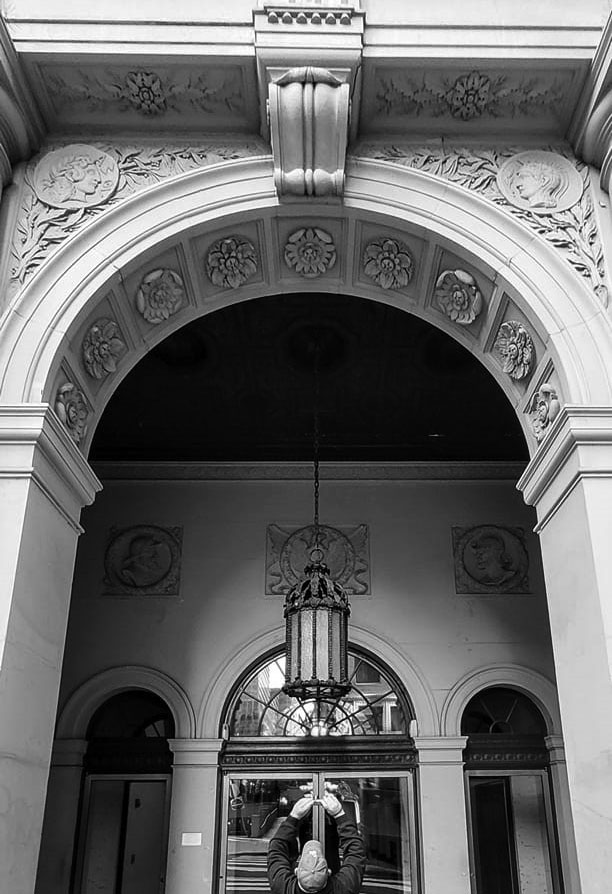 |
|
| (2021)* - Can’t resist taking a photo of detail design above front entrance to the Biltmore Hotel. Photo by Paul Wright |
Biltmore Theatre
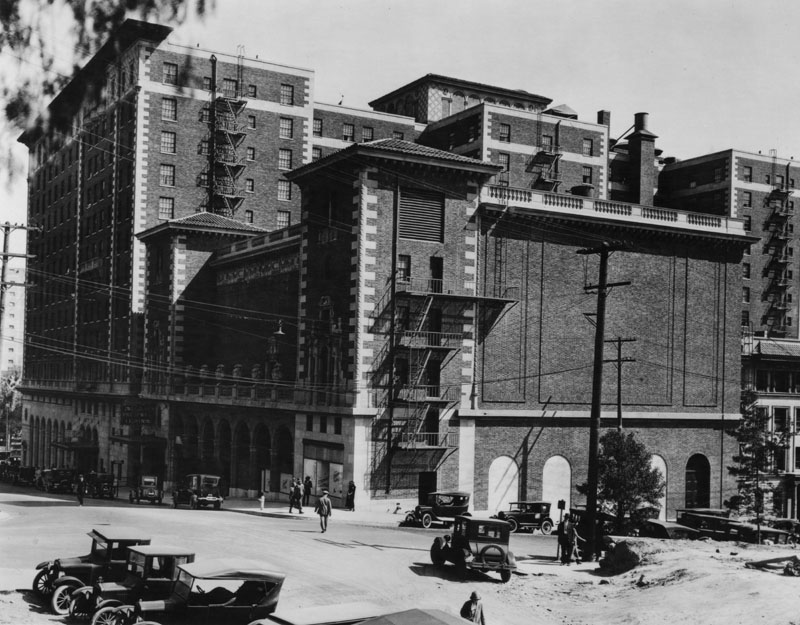 |
|
| (ca. 1924)* - Looking east on 5th Street and Grand Avenue, the Biltmore Hotel and Biltmore Theater are seen on the right. A marquee halfway down the block reads "Biltmore Presents [illegible]". The corner dirt lot (seen on the bottom right) would eventually become part of Central Library. |
Historical Notes Constructed in 1924, the Biltmore Theater was designed by renowned New York hotel architects Leonard Schultze and S. Fullerton Weaver who also designed the Biltmore Hotel. The theatre was connected to the hotel via an arcade and also had the entrance on 5th St. |
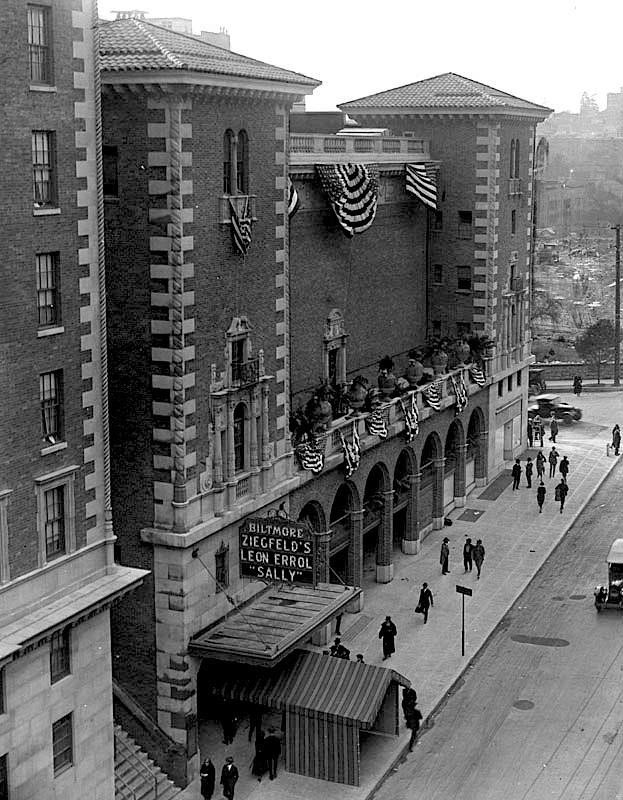 |
|
| (1924)* – Banners decorate the front of the Biltmore Theater at its grand opening. |
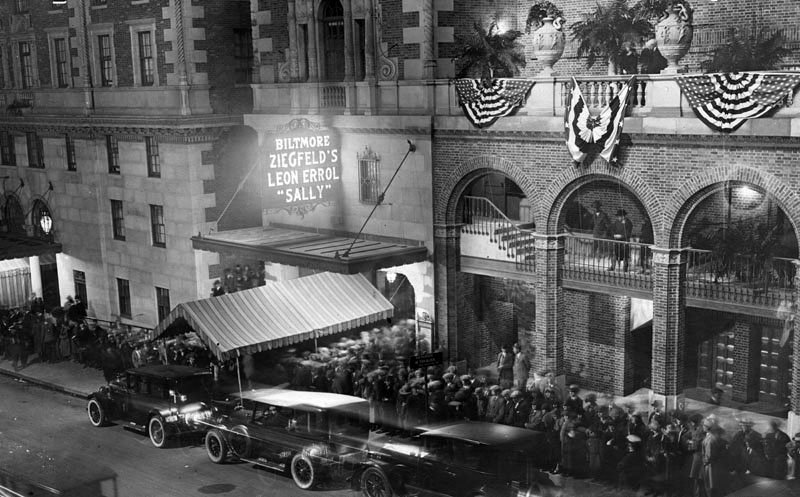 |
|
| (1924)* - The crowd at the Biltmore for the grand opening of the new theater with Ziegfeld's smash musical "Sally". |
Historical Notes The Biltmore Theater opened on March 3, 1924 with a Ziegfeld production of "Sally" starring Leon Errol. The musical was written by Jerome Kern, Clifford Grey and Guy Bolton. The theatre was under Erlanger circuit management. Will Rogers was the emcee and tickets were $10.00. |
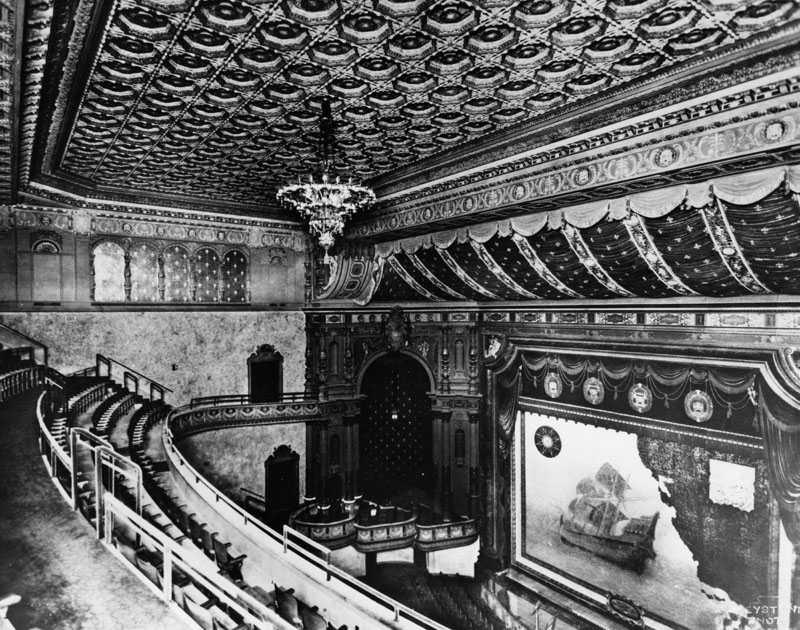 |
|
| (ca. 1924)* - View from the balcony of the painted theater curtain of the 1,654-seat Biltmore Theater. |
Historical Notes The Biltmore Theater was a major venue for Broadway shows playing in Los Angeles for decades. The Biltmore was still part of the Erlanger circuit during the 30s and 40s. |
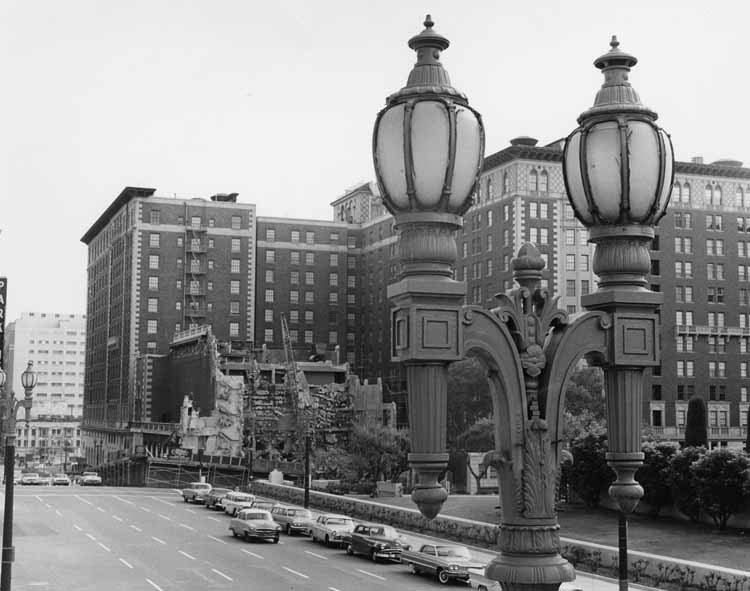 |
|
| (1964)^^^ – View looking east on 5th Street toward Grand Ave showing the Biltmore Theatre in the process of being demolished. Note the beautiful street light in the foreground. It’s known as dual-lamp UM-1906 electrolier which were installed as early as the 1920s. |
Historical Notes The Biltmore Theater was demolished in 1964 and the site was used as a parking lot until the 1980s when a tower addition to the hotel was built. |
* * * * * |
Masonic Temple (Highland Park)
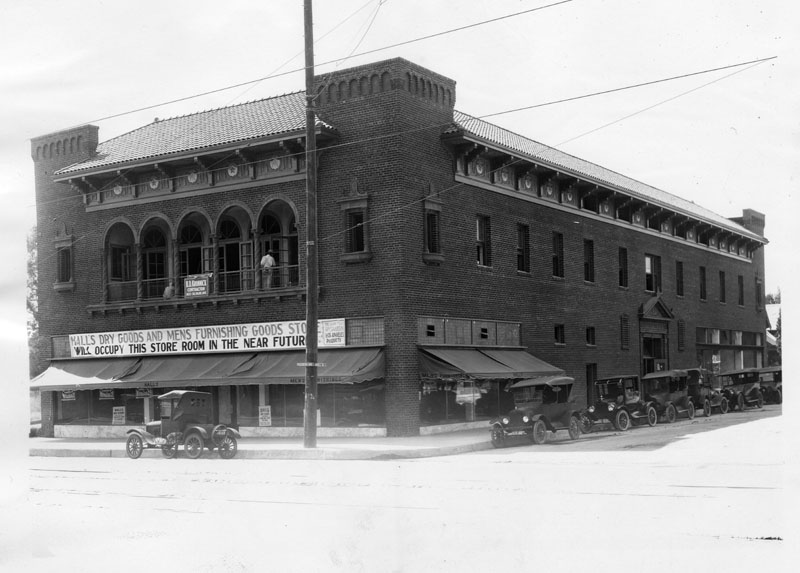 |
|
| (ca. 1923)* - Masonic Temple on North Figueroa Street and Avenue 56 in Highland Park, which has a sign announcing Hall's Dry Goods and Men's Furnishing Goods Store will soon occupy the first floor. The brick building is located on the southwest corner of the intersection. |
Historical Notes Completed in 1923, the 'Commercial/Renaissance Revival' style building served as Lodge 382 of the Free and Accepted Masons for sixty years. The original structure included retail shops on the ground floor with the lodge and banquet hall on the second floor. In 1983, the Masons were forced to vacate the structure when they were unable to afford the cost of retrofitting the building to meet seismic safety requirements.^* |
* * * * * |
Venice High School
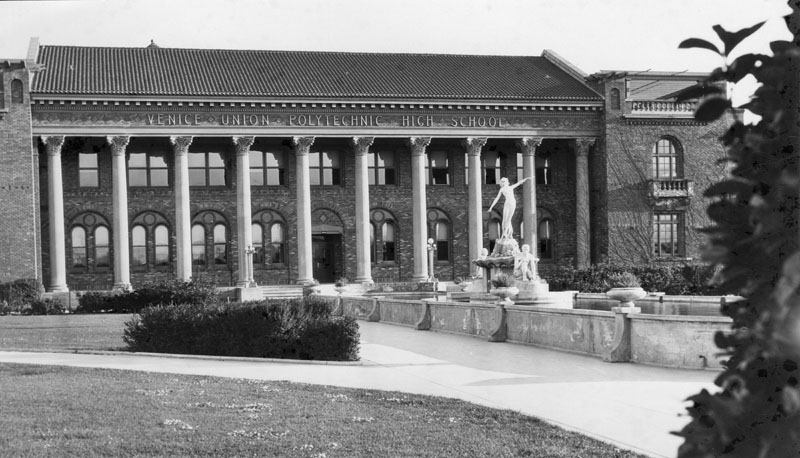 |
|
| (ca. 1924)* - The pool in front of the Venice High School contains a statue with 2 figures, a man kneeling and a woman standing above and behind him, done by sculptor, Harry Winebrenner. |
Historical Notes Venice Union Polytechnic High School, as it was originally called, was established in 1911 with classes being held in an old lagoon bathhouse; at the time, it boasted of 52 students and 8 faculty members. In 1913, a 29-acre site was purchased and in September of 1924, the school moved to its current location at 13000 Venice Boulevard. A year later, in 1925, the school was annexed to the city of Los Angeles and its name officially changed to Venice High School.* |
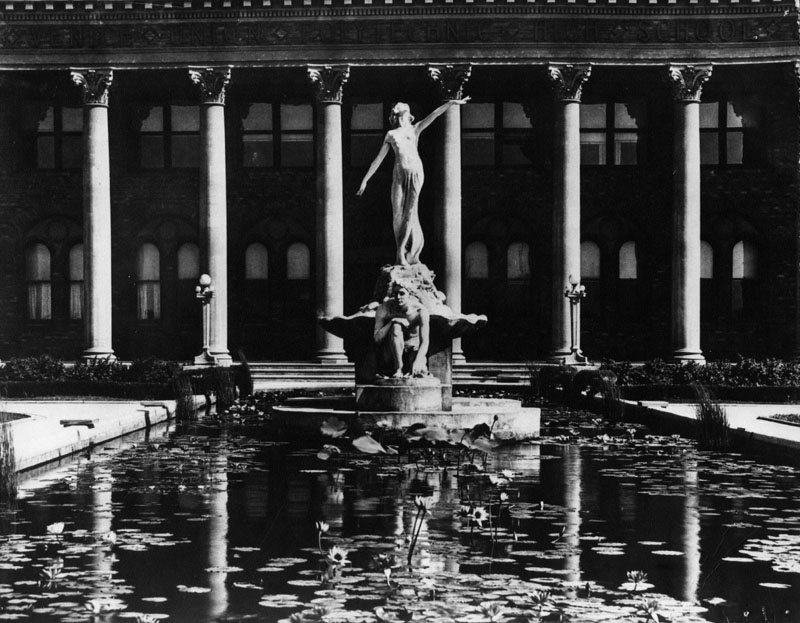 |
|
| (ca. 1924)* - A closer view of the pool in front of the Venice High School. Actress Myrna Loy (at that time she was a student--Myrna Williams) posed for the statue. |
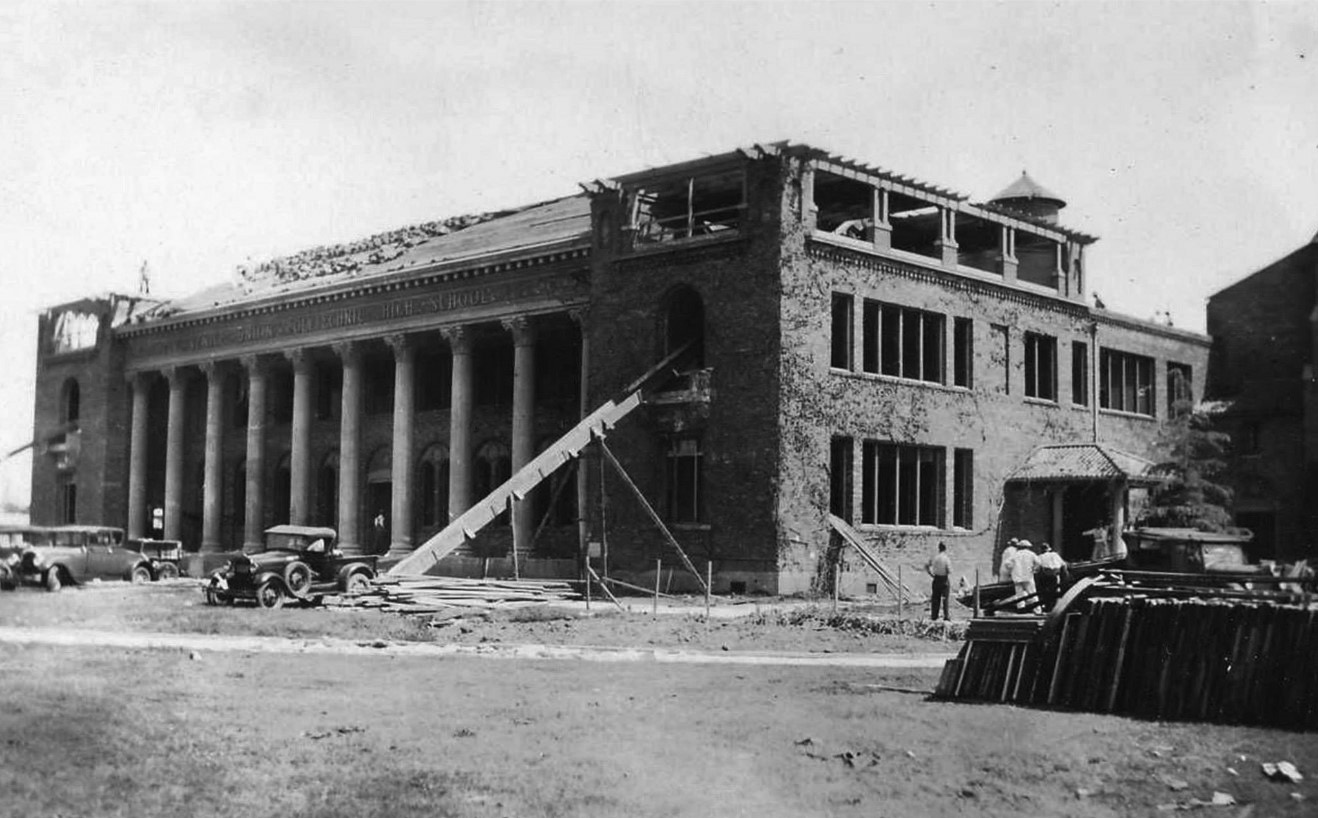 |
|
| (1933)^*^# – View showing Venice High School following the 1933 Long Beach earthquake. |
Historical Notes On March 10, 1933, the Long Beach Earthquake critically damaged the school, and it was subsequently torn down. As a result, for a period of two years classes had to be held in hastily constructed tents until a replacement school was built. On January 22, 1935 ground was broken for the new modern buildings that still stand today.* |
* * * * * |
Rancho Cienega O' Paso de la Tijera (also known as Baldwin Ranch)
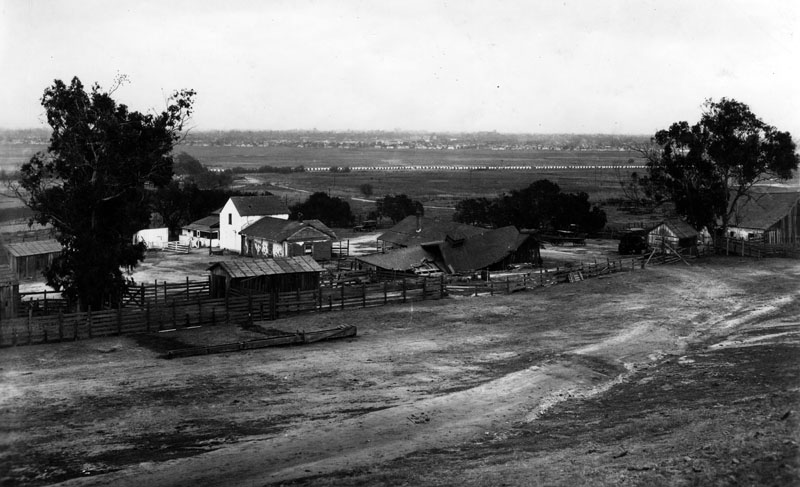 |
|
| (1924)* - Panoramic view of Rancho Cienega O' Paso de la Tijera (also known as Baldwin Ranch) located on the 2400 block of S. Crenshaw Boulevard in the Baldwin Hills area, looking east. The taller white building to the left of center is the Sanchez Adobe (not to be confused with the other Sanchez Adobe in Montebello) and is generally assumed to be the oldest building in Los Angeles. |
Historical Notes Rancho La Cienega O' Paso de la Tijera was a series of adjoining adobe structures located on the eastern side of the Baldwin Hills in an area determined to be approximately 4,481 acres. The unusual title of the Rancho is actually two names combined: "La Cienega" ("The Swamp"), refers to the marshes in the area between Baldwin Hills and Beverly Hills; the latter half of the name "Paso de la Tijera" ("Pass of the Scissors"), was a name used by the early Spanish to describe the pass through the nearby hills that resembled an open pair of scissors.* |
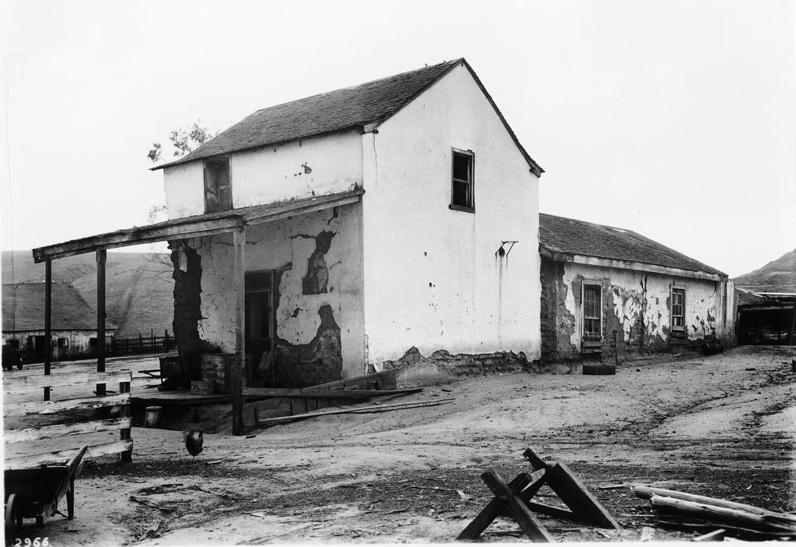 |
|
| (ca. 1924)^ - Casa de Sanchez, ca. 1924. At this time, the house was already 130 years old. |
Historical Notes This two story structure may have been built in the early 1790s, making it older than Avila Adobe, maybe older than Mission San Gabriel, older even, perhaps, than the 1795 Gage Mansion in Bell Gardens, currently considered the oldest structure in Los Angeles County. Like Mission San Fernando, the Sanchez Adobe wasn't previously part of Los Angeles but it's an integral part of it now, and was perhaps great-great-great-grandfathered in as the city's oldest building amid growth and annexation.^*^* |
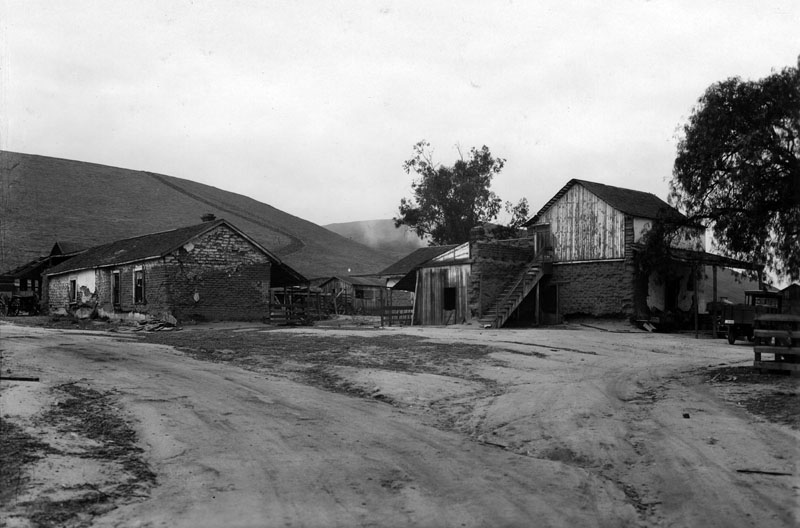 |
|
| (1924)* - View of Rancho Cienega O' Paso de la Tijera shows two adobes, a single-story on the left, and the Casa de Sanchez on the right; another smaller building is visible in the background between the adobes. |
Historical Notes The Rancho La Cienega O' Paso de la Tijera area remained unclaimed for many years following the first Spanish settlements in California. Squatters from the pueblo considering these lands public and built the La Tijera adobe as early as 1790 or 1795 for the purpose of raising cattle on surrounding land. In 1843, Manuel Michaeltorrena (then Mexican Governor of Alta California) formally granted Rancho La Cienega O' Paso de la Tijera to Vicente Sánchez.* |
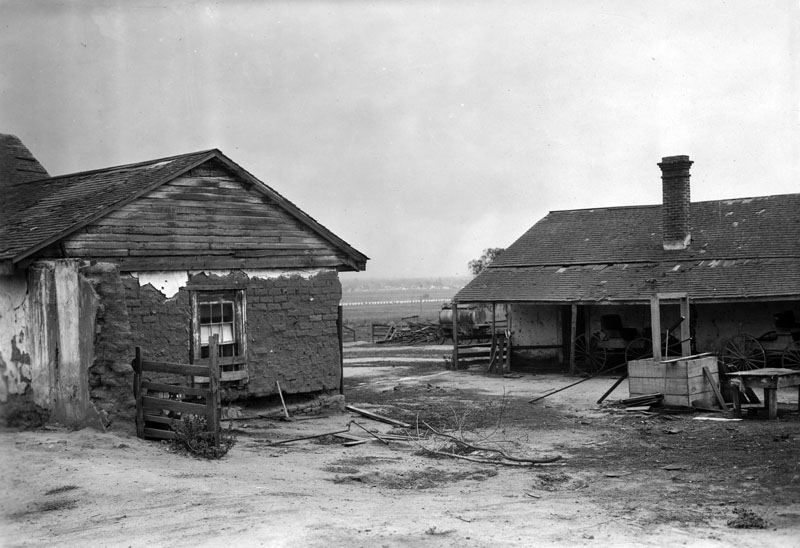 |
|
| (1924)* - View of Rancho Cienega O' Paso de la Tijera shows two adobes, both single-story, with what appears to be a wooden well in the area between them. |
Historical Notes In 1875, Tomas Sanchez (Vincente's grandson) sold Rancho La Cienega o Paso de la Tijera to Francis Pliney Fisk (F.P.F) Temple (brother of John Temple of Temple Block and Temple St.), Arthur J. Hutchinson, Henry Ledyard and Daniel Freeman. However, Temple experienced financial difficulties and in 1875 Elias J. (Lucky) Baldwin acquired the rancho, giving his name to the hills that dominated the western section of the rancho and thereafter known as the Baldwin Hills. Baldwin used the ranch primarily as a sheep pasture but it was not profitable. When Baldwin died 1909, his daughter Anita M. Baldwin realized that there was oil on the estate, and by 1916 drilling had begun.^* |
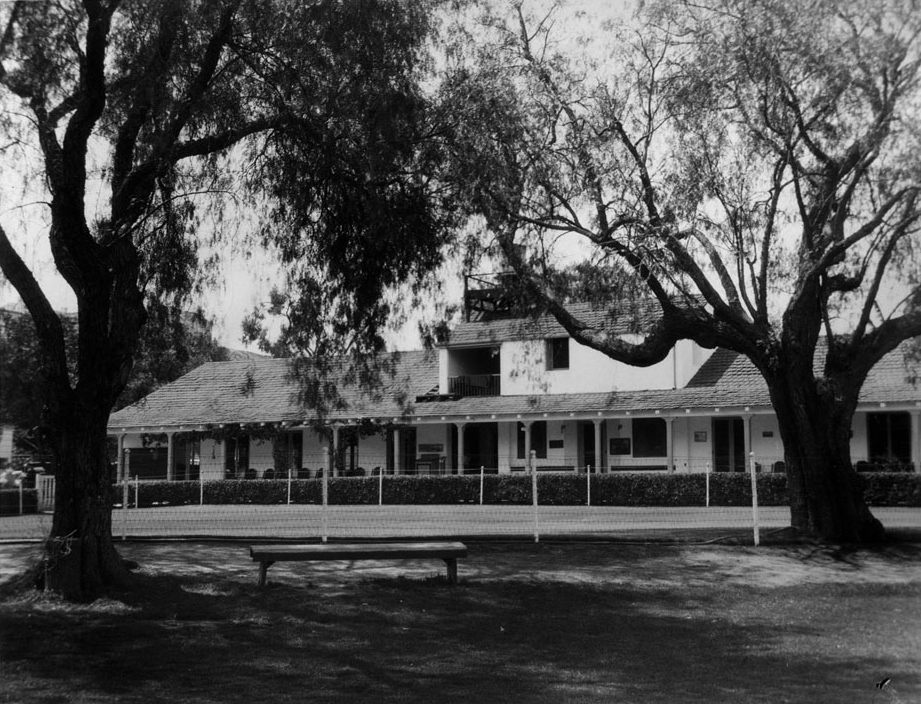 |
|
| (ca. 1935)^ - Exterior view of the remodeled adobe home of Tomas Sanchez on the Rancho Cienega de la Tiejera in Baldwin Hills. |
Historical Notes In more recent years, a portion of Rancho La Cienega O' Paso de la Tijera became the center of Sunset Fields public golf links located at 3725 Don Felipe Drive, off Crenshaw Boulevard. In 1959, Bernadette Fathers sold the property to Park View Women's Club.* Rancho La Cienega O' Paso de la Tijera (Sanchez Ranch) was declared Los Angeles Historic-Cultural Monument No. 487 on May 1, 1990 (Click HERE to see complete listing). |
* * * * * |
Sphinx Realty Company
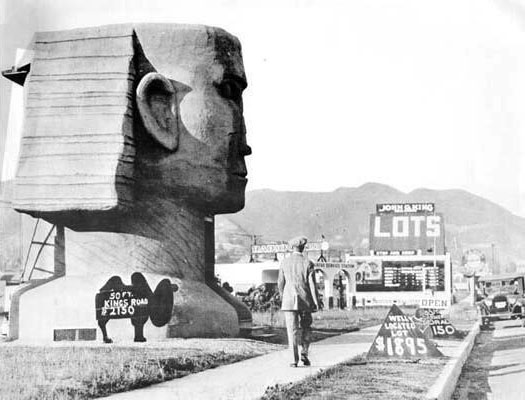 |
|
| (ca. 1920s)* – View looking north on Fairfax Ave showing a man walking in front of the Sphinx Realty Company. The building was located at 537 North Fairfax Avenue, across the street from Fairfax High School. Camel-shaped sign on the left reads: 50 ft. Kings Road - $2150. Triangular-shaped sign on right reads: Well Located Lot - $1895. |
Historical Notes In the 1920s, as the automobile was becoming the default way to get around the Southland, buildings and structures in the area became more unique. These “hey-you-can’t miss-me!” buildings (referred to as Novelty or Programmatic Architecture) were made to pull automobile drivers right off the road. Click HERE to see more examples of Programmatic Architecture. |
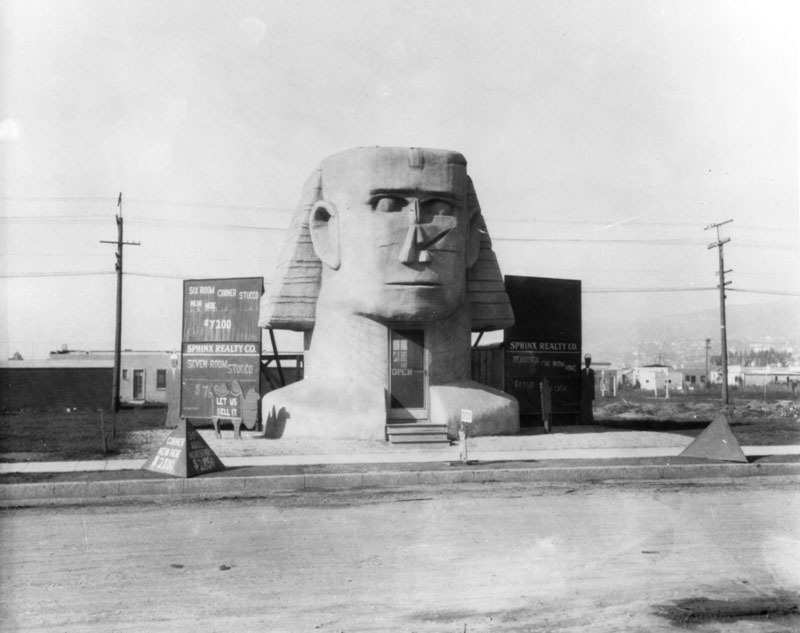 |
|
| (1920)* - Exterior view of the Sphinx Realty Company, in the shape of a sphinx, located at 537 North Fairfax Avenue, surrounded by signs listing these properties for sale: Beautiful five bedroom home, $6,750; Six room corner stucco near here, $7,200; Seven room stucco, $7,650; Corner near here, $2,500. |
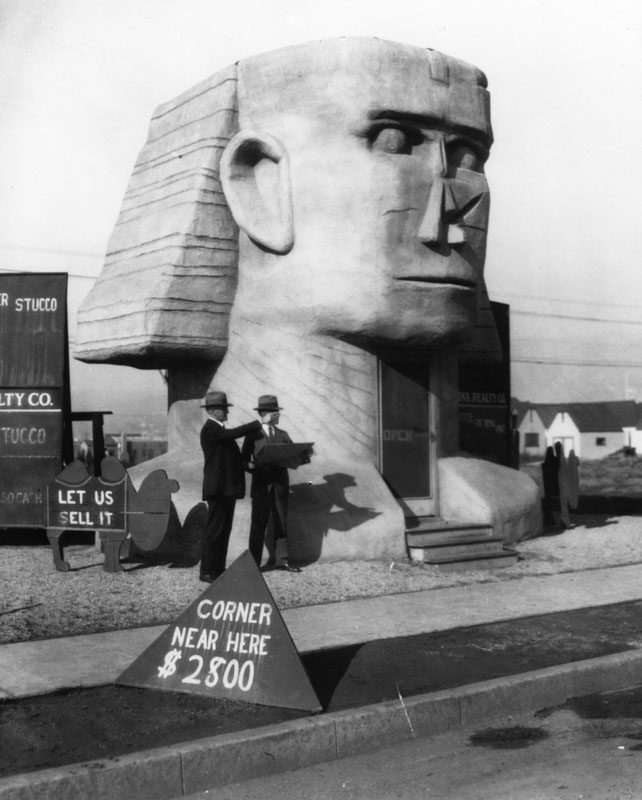 |
|
| (1920)* - View showing two men standing in front of the Sphinx Realty Company sales building located on Fairfax Avenue. The office was located across the street from where Fairfax High School stands today. Click HERE to see more examples of Programmatic Architecture. |
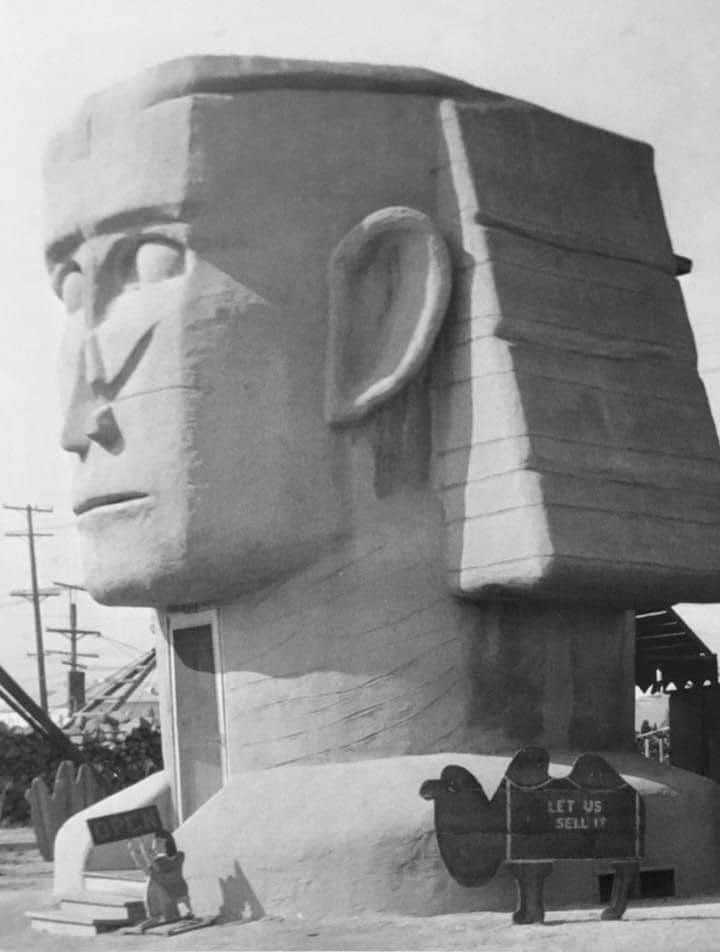 |
|
| (ca. 1920s)* - Sphinx Reality Company sales office, 537 N. Fairfax Ave - "LET US SELL IT". Click HERE to see more examples of Programmatic Architecture. |
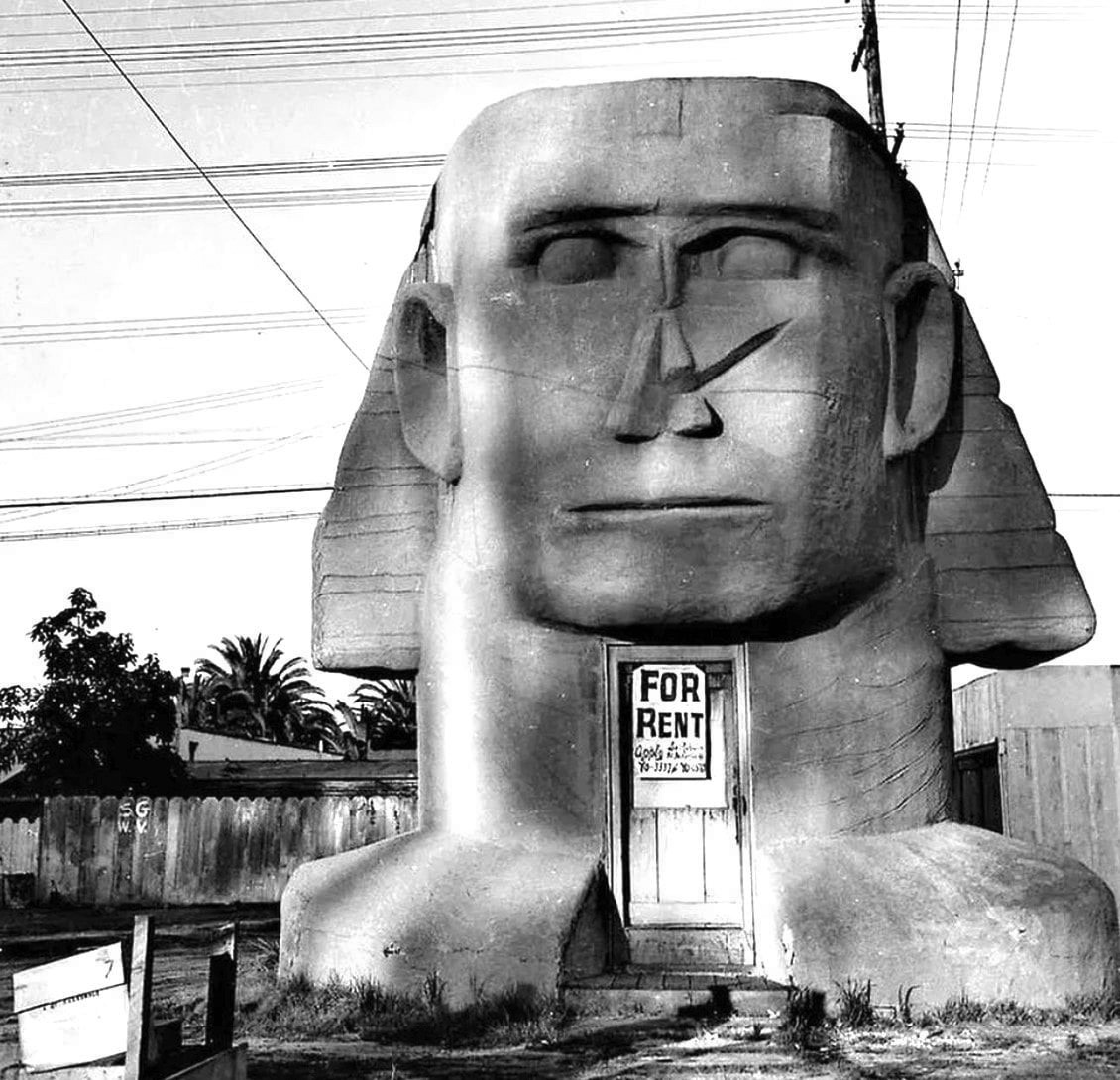 |
|
| (1920s)* - The Sphinx Realty building with a ‘For Rent’ sign on its front door. Nothing lasts forever. |
Historical Notes Click HERE to see more examples of Programmatic Architecture. |
* * * * * |
Fairfax High School
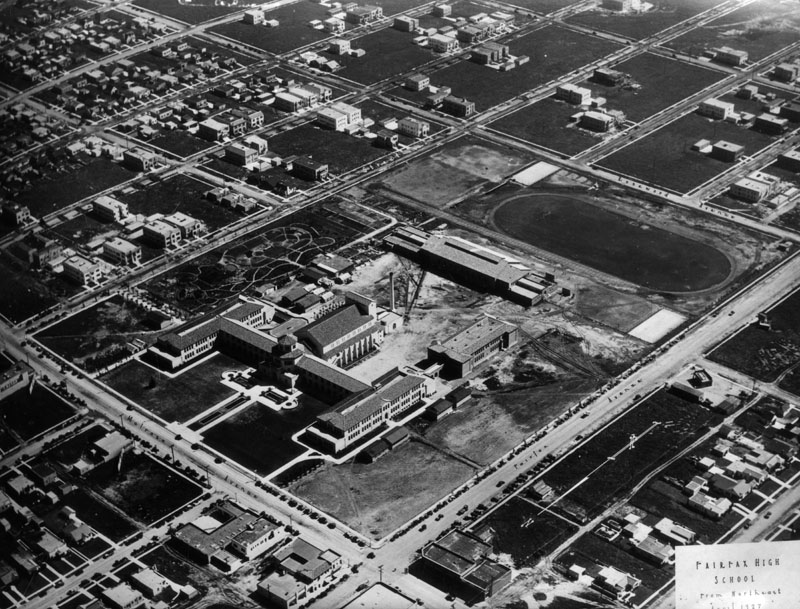 |
|
| (1927)* - Aerial view looking southeast showing Fairfax High School located on the southeast corner of Fairfax and Melrose Avenues. The Sphinx Reality Office (previous photo) was located at 537 N. Fairfax Avenue which is across the street from the track in the above photo. |
Historical Notes Originally, the land around Fairfax “was a swampy area or cienaga, the home of the duck and the mudhen - a veritable hunters’ paradise during the wet season of the year. As land became more valuable, the old cienega was drained and filled and a region suitable for residence created. Because of its swampy condition, the Board of Education was enabled to buy the twenty-eight acres on which this high school stands at a very low figure. When the time came to build our school, through a friend we were able to secure gratis thirty eight thousand loads of dirt. This raised the frontage on Melrose twenty - two inches, and so we are kept out of the water most of the time. Thus we have passed by slow transition from the jungle home of the lords of the forest to the more sheltered home of the Lords of Fairfax.” Written by the first Principal of Fairfax, R.G. Van Cleve - 1963 Yearbook. #*#* |
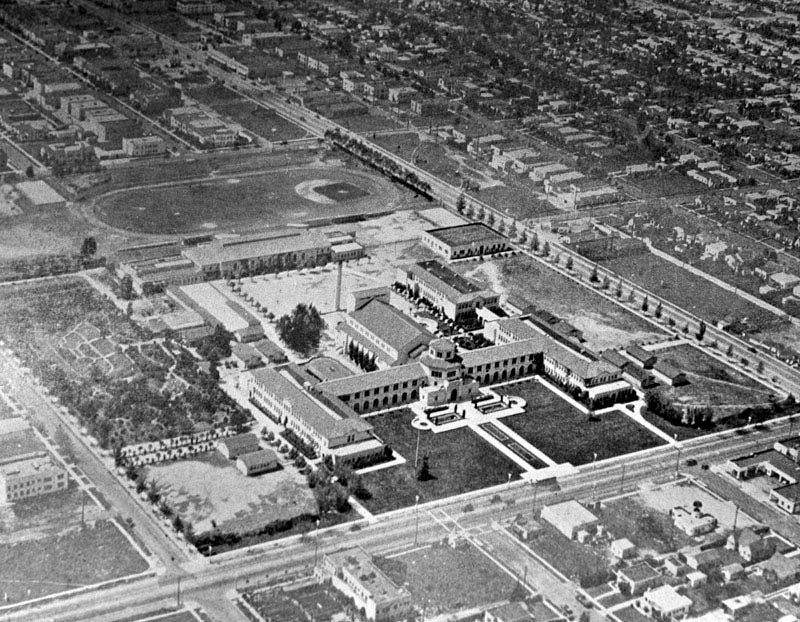 |
|
| (1931)* - Aerial view of Fairfax High School looking southwest. The tree-lined street running diagonally at top right is Fairfax Avenue. Melrose Ave runs east to west in the foreground. The school's "Rotunda" and auditorium can be seen at center of photo. |
Historical Notes In 1924, Fairfax High School, named for Lord Fairfax of Colonial America, opened its doors. Rae G. Van Cleve, the first principal, wished to make Fairfax very “American and Democratic.” The Fairfax family (direct descendants of Lord Fairfax) in Virginia gave permission to use the coat of arms (Rampant Lion) and the motto “Fare Fax” (“Say and Do”). The student body chose to name “Colonials.” In keeping with the Colonial backgrounds, Student Body officers bore colonial titles. The first boys’ and girls’ groups were called Lords and Ladies, and the student body president was called The Lord High Commissioner. Fairfax was initially designed to be an Agricultural & Mechanical school emphasizing “practical” skills. With 28 Acres of campus, school programs included landscape gardening, forestry, architecture, agronomy and an arboretum. The Domestic Science unit supervised the cafeteria so that the “girls” would get practice as well as the theory of cooking and serving “food”. #*#* |
 |
(1926)#*#* - View of what appears to be two lily ponds in front of the Fairfax High School Rotunda and Auditorium. Both the Rotunda and Auditorium are the only two original buildings still standing today.
|
Historical Notes Because the buildings were not earthquake-safe, the last year of the original campus was 1966. Brick by brick, the old structures came down, and completely new earthquake-safe building arose. New additions included a four-story administration and classroom facility, a physical education plant, an industrial arts complex and cafeteria. Students and faculty moved into the new building in 1968. Because of the unique beauty of the Rotunda and the Auditorium, a public campaign was successful in saving them, and the Auditorium was reinforced for seismic safety. Subsequently, the Fairfax Hall of Fame was established in the Rotunda. #*#* |
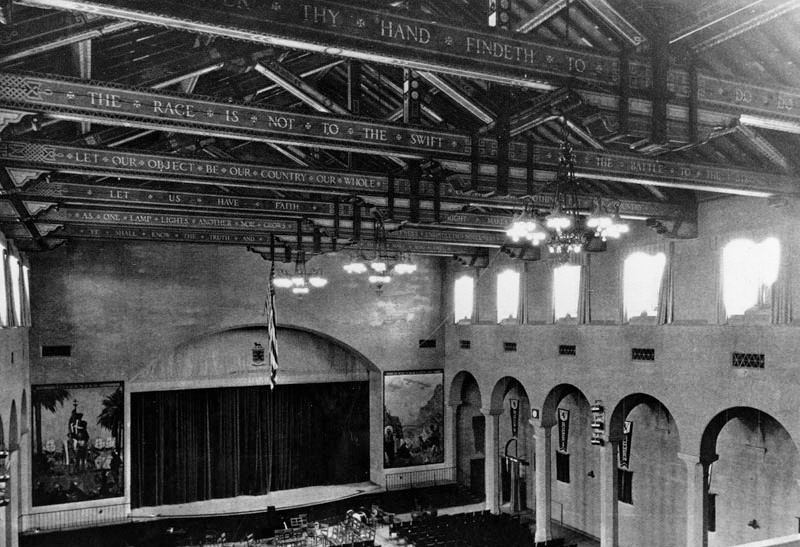 |
|
| (1931)* - Interior view of the auditorium at Fairfax High School. |
Historical Notes The auditorium was dedicated in 1926 and later named the DeWitt Swan Auditorium, in honor of the first Boys’ Vice Principal. The first annual in 1926 bore the dedication, “Enter to learn; go forth to serve.” In 1927, the summer graduating class dedicated the sunken gardens and the fountain that was located in front of the old building. The same year, a Fine Arts building and a gymnasium were added to the campus. By the time, Fairfax High School (containing grades 7-12) was an established, prestigious element in the Fairfax Community. #^#* |
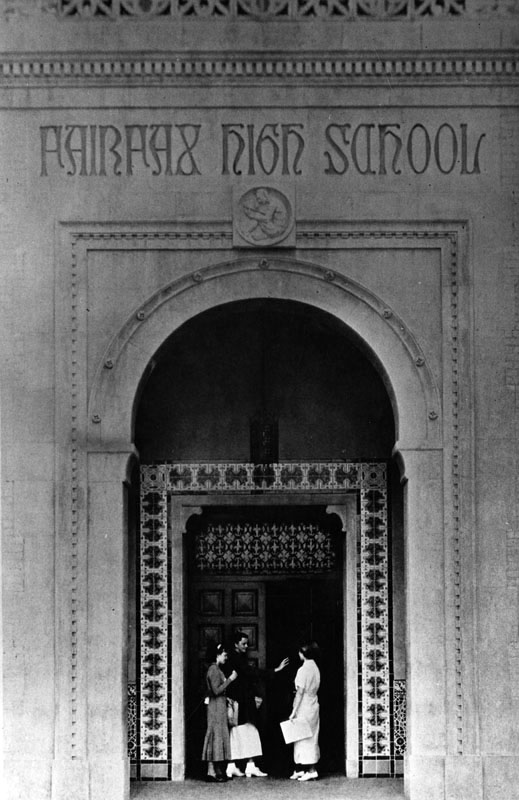 |
(ca. 1931)^ - Students standing outside the Moorish style archway of the entrance to the Fairfax High School auditorium. “Never say die, say do” - The Fairfax Motto, “Fare Fac”, was the subject of a 1930 contest for the best slogan and motto depicting its meaning. More than 150 entries were submitted. The winning motto: “Noble in speech, honorable in deed”. “Let your words be wise and your actions likewise”.
|
Historical Notes When the United States entered the war, hundreds of Fairfax students and alumni joined the military. The 1946 Colonial Yearbook was dedicated to those men and women, 96 of whom lost their lives. During the war years, Fairfax students sold $90,000 in war bonds, conducted numerous recycling material drives. Also in 1946, a Fairfax drama featured Ricardo Montalban and Jim Hardy, once a Lord High Commissioner starred at football. He continued his career at USC ad professionally with Rams, Chicago Cardinals and Detroit Lions. #*#* Click HERE for a list of Fairfax High School Notable Alumni. |
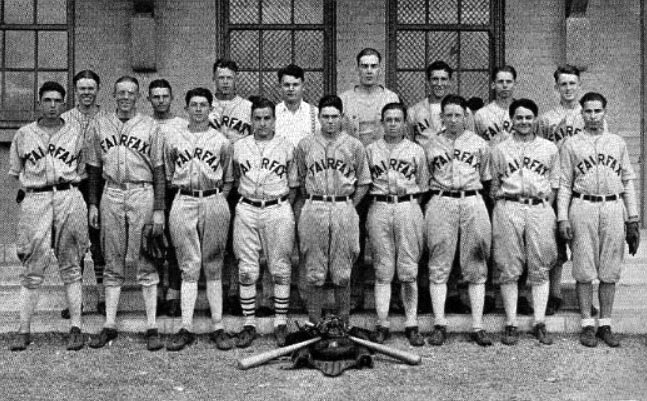 |
|
| (1929)#*#* – The Fairfax Varsity Baseball Team of 1929. Yearbook referred to the team as "Heavyweight Baseball". |
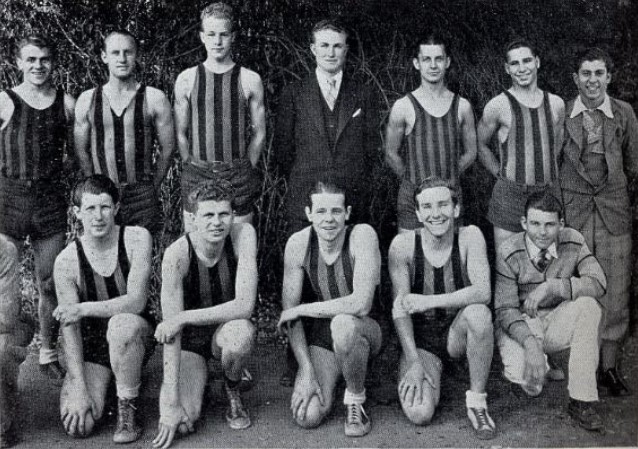 |
|
| (1929)#*#* – The Fairfax Varsity Basketball Team of 1929, at the time referred to as "Heavyweight Basketball". |
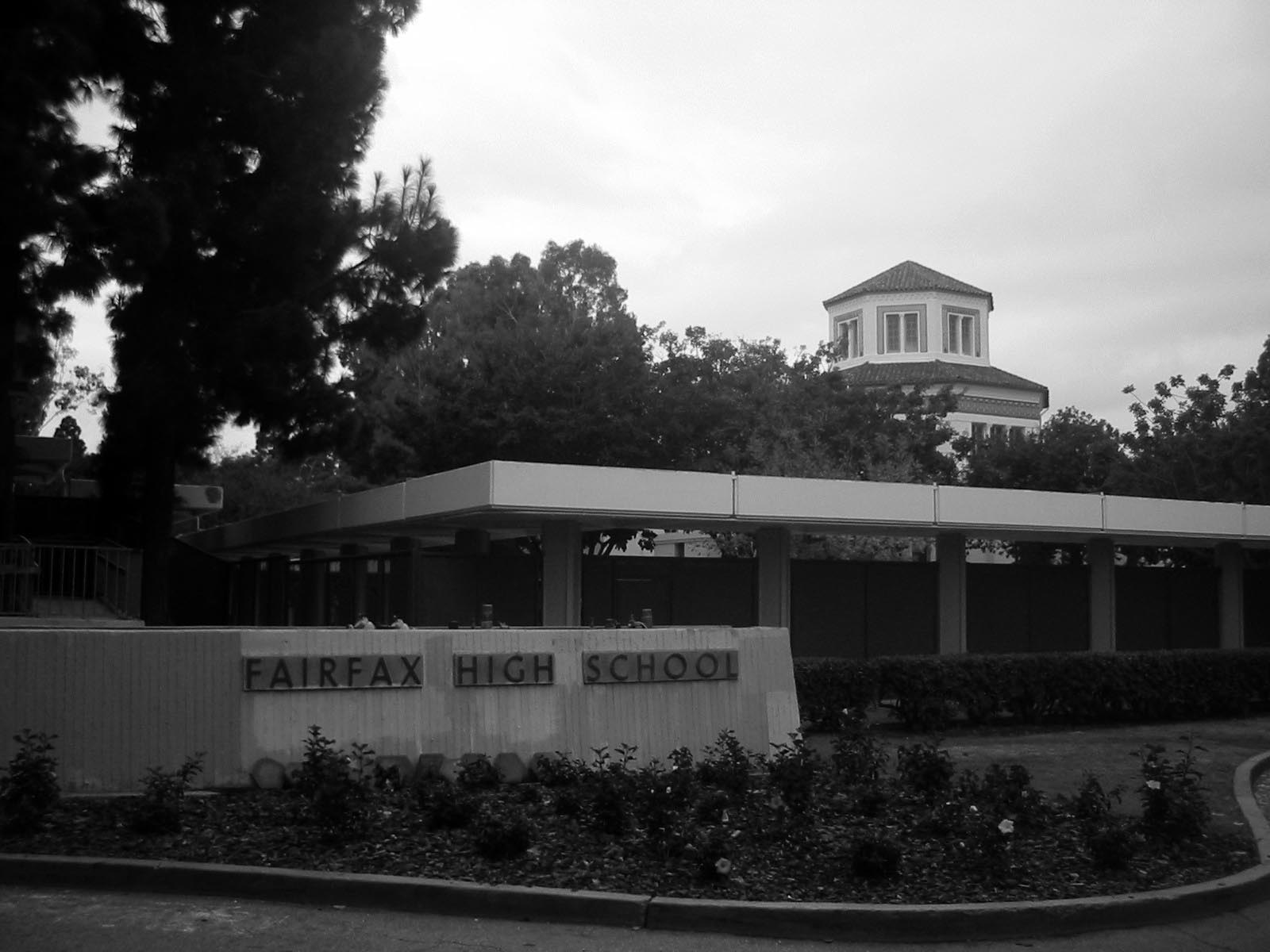 |
|
| (2006)^* - Fairfax High School as it appears today, with Rotunda in the background. Photo by Gary Minnaert |
Historical Notes Fairfax was the foreign language magnet school in the 1960s and 1970s, offering Hebrew, German, Chinese and Latin, among other languages. The Fairfax Magnet Center for Visual Arts opened in 1981 and remains the only visual arts magnet in the Los Angeles Unified School District. In 1984, Dr. Virginia Uribe, an LAUSD teacher and counselor for 42 years, founded LAUSD’s Project 10 program, the first dropout prevention program specifically for lesbian, gay, bisexual and transgender (LGBT) students in the United States. Organized by a group of local theater artists, the first Melrose Trading Post was held in 1998 in the school's parking lot. Regarded as most successful on-going fund-raising activity in the LAUSD, the flea market evolved into the Greenway Arts Alliance, the Friends of Fairfax and the Institute for the Arts at Fairfax High School, all which are of immense benefit to the school and students. In Fall 2008, Fairfax High School was reconfigured from a comprehensive high school into a complex of five new small learning communities (SLCs) and the existing Fairfax Magnet Center for Visual Arts.^* |
 |
The coat of arms of Thomas Fairfax, 6th Baron Fairfax of Cameron (1693–1781), which became the emblem of the County of Fairfax, Virginia, USA.^* |
Historical Notes There is a connection between Fairfax High School, Gilmore Gas Co., and Thomas Fairfax - a 'Lion'. Fairfax High School and Gilmore's first oil well are located in proximaty to each other and to Fairfax Avenue. It turns out that both Gilmore's logo and Fairfax's mascot is a 'Lion' - which is more than a coincidence. |
|
|
Fairfax High School's Mascot is a lion (left). Gilmore Oil Company's logo was also a lion. |
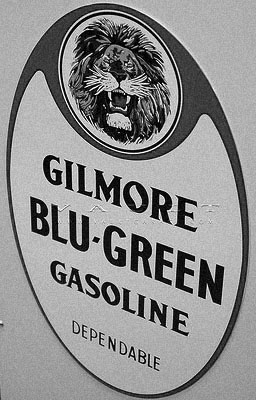 |
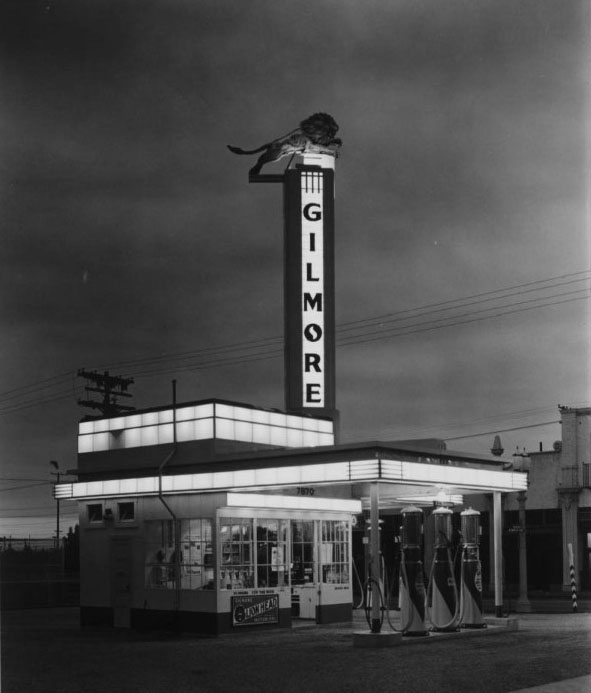 |
|
| (1935)#^* – Night view of the Gilmore Service Station located at 7870 Beverly Boulevard, one block east of Fairfax Avenue. Note the lion on top of the illuminated Gilmore sign. |
Historical Notes A.F. Gilmore and his son, Earl Bell (E.B.) turned their Gilmore Oil Company into the largest distributor of petroleum products in the Western U.S. E. B. Gilmore appears to have invented the self-serve gas station. He created a “gas-a-teria” not far from Farmers Market where customers saved 5 cents per gallon by filling their own tanks. Those who preferred to have their gas pumped by “professionals” at the gas-a-teria got unusual service for a period of time when young ladies on roller skates would glide to the pumps to gas the cars up.^**# Gilmore Gas Stations were eventually bought out by Mobil Oil Co. Click HERE to see more Early Views of LA Gas Stations. |
* * * * * |
Temple Emanu-el
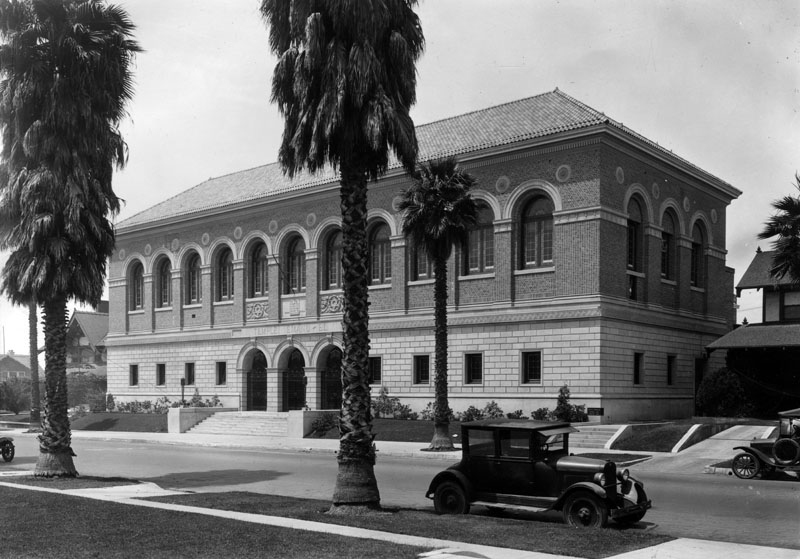 |
|
| (ca. 1924)* - Exterior view of Temple Emanu-el, located at 639 S. Manhattan Place near Wilshire Boulevard. |
Historcial Notes Designed by Russel and Alpaugh, Temple Emanu-el opened in 1923 and was occupied by the first "traditional reform" congregation. In 1929, the congregation was dissolved and the building was sold to become Christ Church. In the late 1930s, the congregation of Temple Emanu-el reappeared in Westwood where it was located until a large temple was built at 8844 Burton Way in Beverly Hills. The home on the left was later demolished and the English style residence on the right later became the parsonage for Christ Church.* |
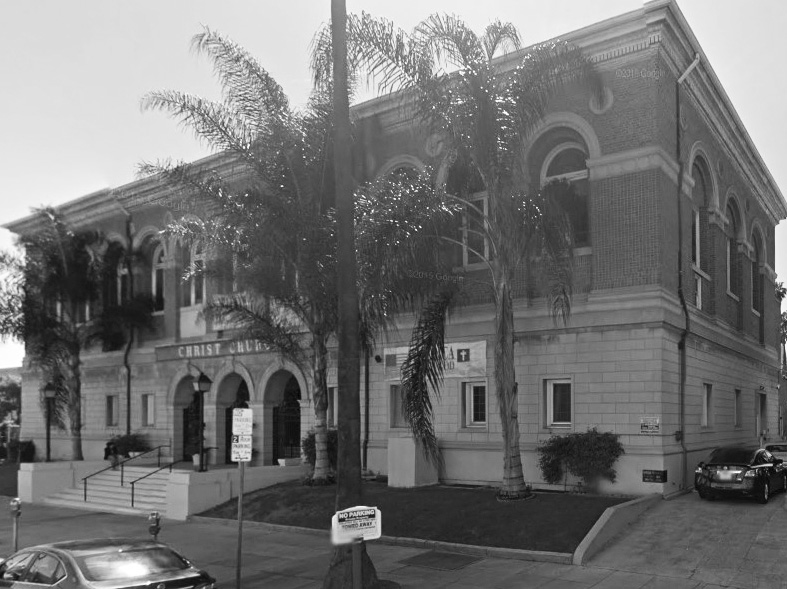 |
|
| (2015)#^** - Google street view showing Christ Church at 639 S. Manhattan Place (original location of Temple Emanu-el). |
* * * * * |
Victoria Arms Hotel Apartments (today, Park View Apartments)
 |
|
| (1924)^ - View showing the Victoria Arms Apartments located just west of MacArthur Park (Westlake Park at the time) at 2424 Wilshire Boulevard. |
Historical Notes Known as the Victoria Arms Hotel Apartments when it opened in 1924, this building located at 2424 Wilshire Blvd. near downtown Los Angeles was sold and renamed the Park Wilshire in the early 1930's. |
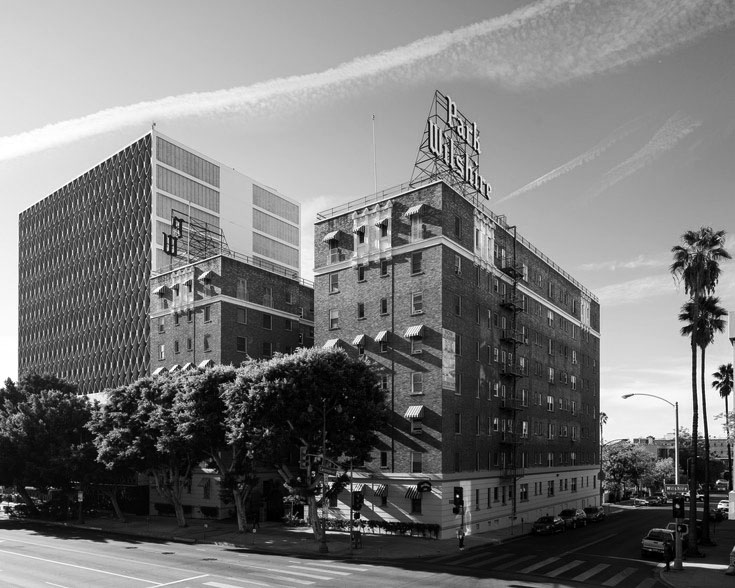 |
|
| (2017)^.^ – View showing the Park Wilshire Apartments located on the SE corner of Wilshire Boulevard and Carondelet Street. |
Historical Notes The historic eight-story apartment building is located at 2424 Wilshire Boulevard, sandwiched between Koreatown and downtown Los Angeles. The building is designated as a historic-cultural monument by the LA Cultural Heritage Commission and was designed by the famed architectural team of Clarence H. Russell and Norman W. Alpaugh in 1924. It originally opened as a residential hotel and was easily spotted by passerby due to its iconic neon sign which graced the building’s rooftop. |
 |
|
| (2009)^.^ – Close-up view of the iconic neon sign on the rooftop of the Park Wilshire Apartments. |
* * * * * |
Friday Morning Club (Original Building)
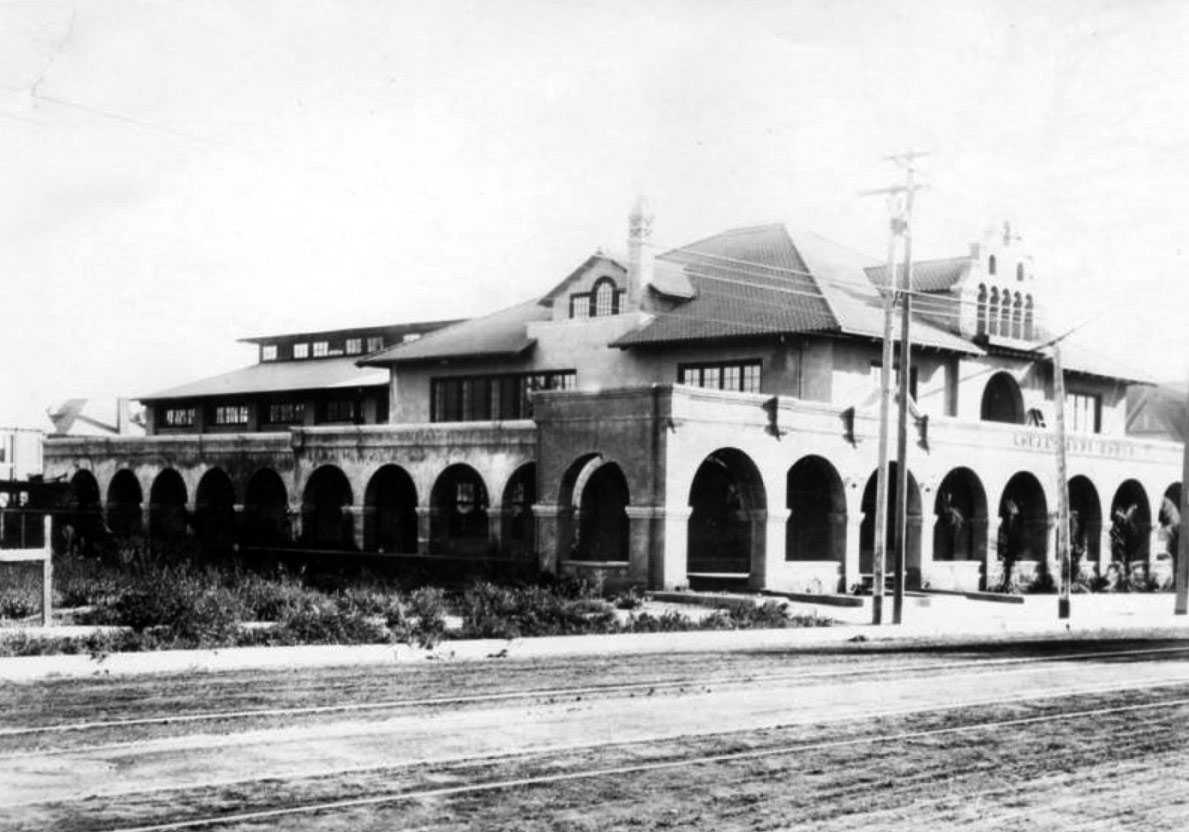 |
|
| (ca. 1900)* - View looking across an unpaved Figueroa Street showing the Friday Morning Club building, located at 940 South Figueroa. |
Historical Notes In 1891, Caroline M. Severance and 87 charter members organized the Friday Morning club in the parlor of the Hollenbeck Hotel, at 2nd Street and Spring. Among its interests were intellectual and literary pursuits. From its inception, however, the club was directly involved in political issues--women's rights, the movements that resulted in the establishment of Los Angeles Juvenile Court and a city library, and the preservation of landmarks. The club started the movement that put women on the board of education. It campaigned for harbor development at San Pedro. It fought to preserve the redwoods and the California missions. It sponsored food and drug legislation. At its peak, the club boasted 3,800 members.^ |
.jpg) |
|
| (ca. 1900)* – View looking southeast showing the Friday Morning Club located on the east side of Figueroa between 9th and 10th streets. The church seen on the right in the background is the Immanuel Presbyterian Church, located on the southeast corner of Figueroa Street and 10th Street (now Olympic Boulevard). |
Historical Notes In 1899, Severence formed a corporation and issued stock to its membership of the Friday Morning Club. The money raised from the stock, made it possible to purchase a parcel of land on Figueroa between Ninth and Tenth to build a clubhouse, which would eventually be leased back to the club.^^ |
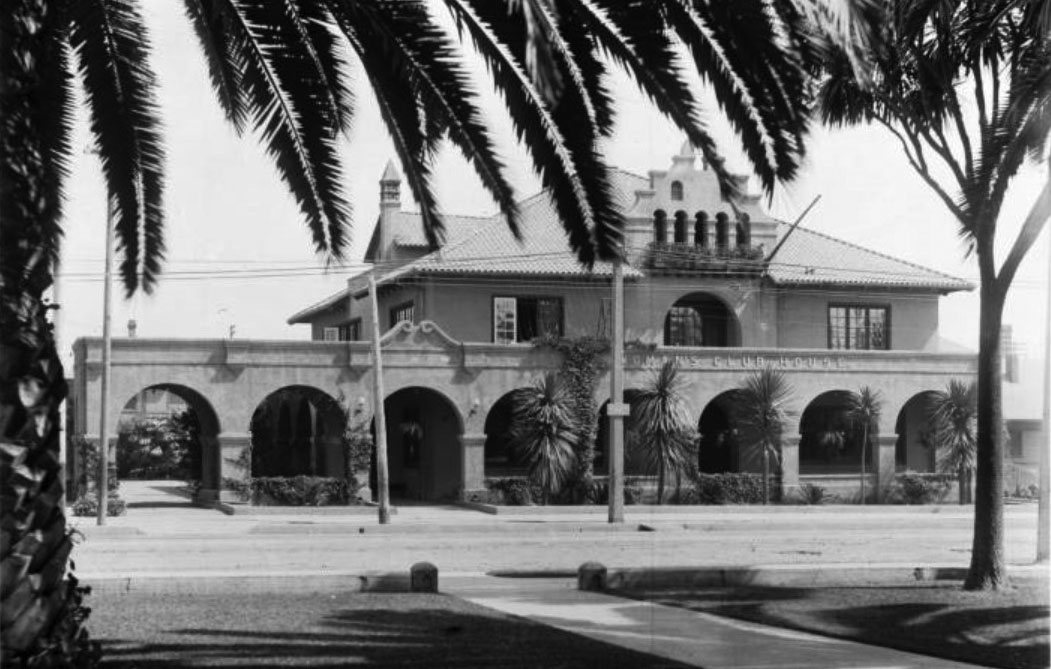 |
|
| (ca. 1905)^ – View showing the Mission-style Friday Morning Club building as seen from across the street. Sign above the front face of the building reads: “Woman’s Club House” |
Historical Notes On September 14, 1899, the cornerstone for the clubhouse was laid. On January 19, 1900, four months later, a $13,000, two-story Mission revival structure was completed and opened for meetings. Severence died in 1914 at the age of 94; however, the club that she stared continued to prosper and grow its membership.^^ |
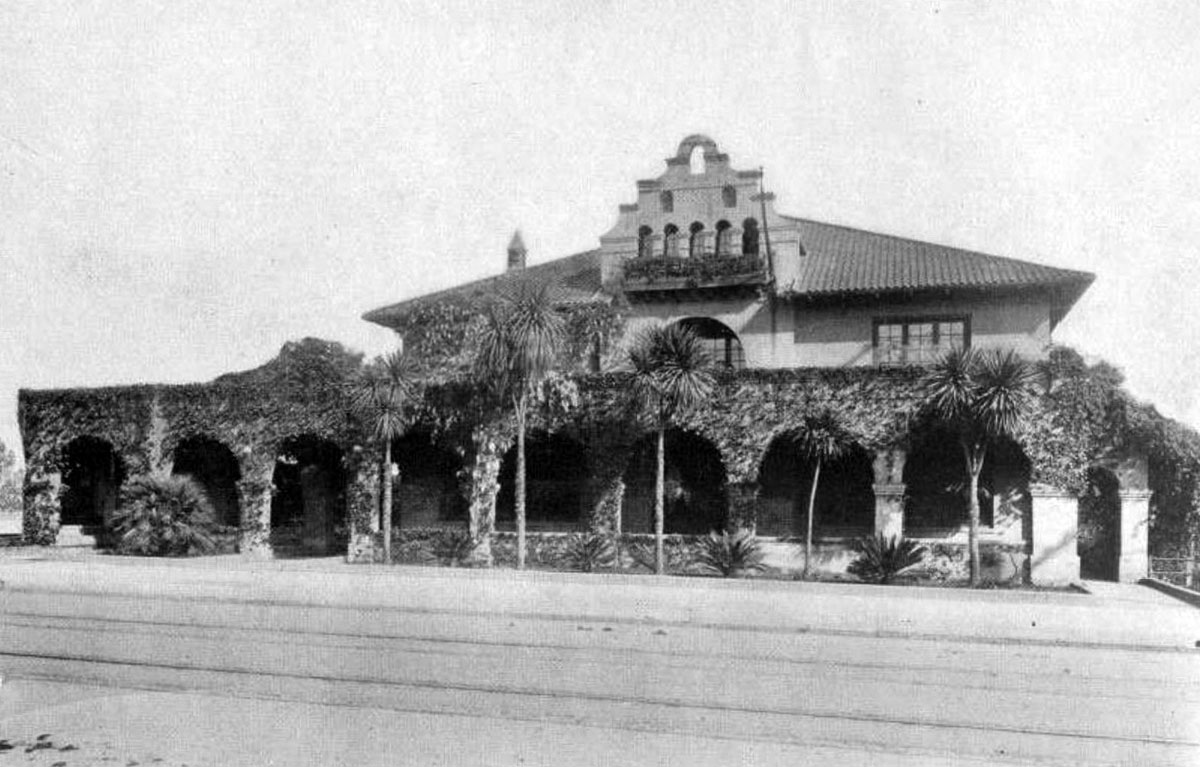 |
|
| (1911)^.^ – View of the original club house for the Friday Morning Club on Figueroa near Ninth Street. Ivy now covers the front arched face of building. |
Historical Notes In April of 1922, the Friday Morning Club hired architects James & David Allison to design and build a brand new five-story, Italian Renaissance clubhouse on the site of the original building. At a cost of $750,000, the old clubhouse was razed and the new clubhouse was built.^^ |
* * * * * |
Friday Morning Club (aka Variety Arts Center - Figueroa Playhouse & Variety Arts Theater)
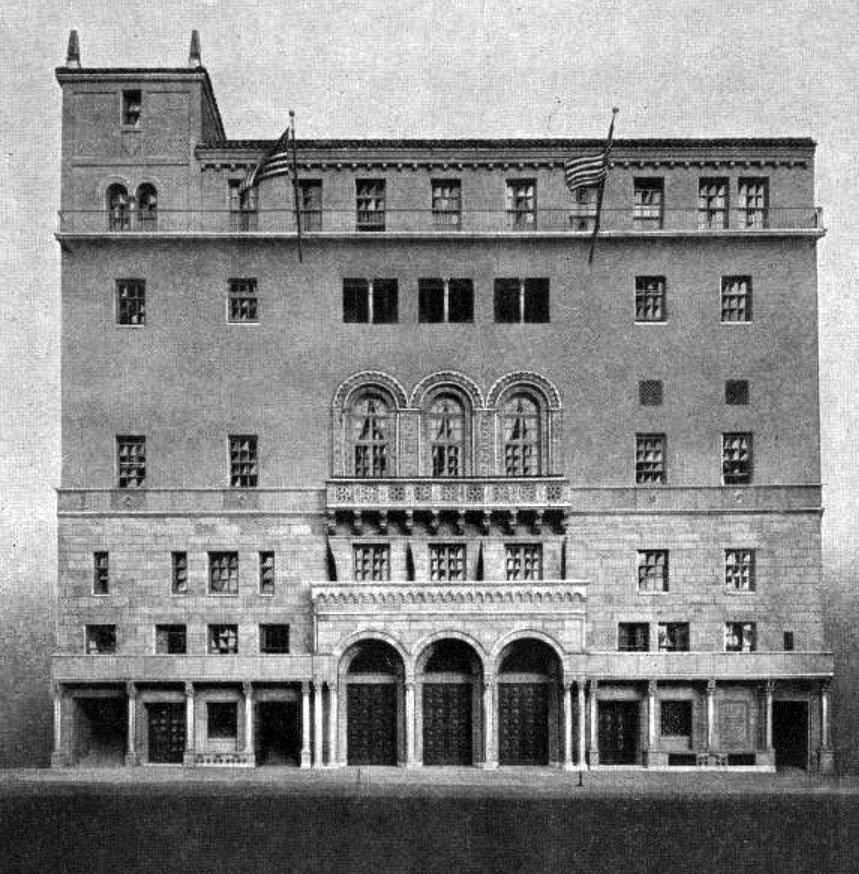 |
|
| (1924)^.^ – View showing a sketch (or model) of the Friday Morning Club’s 2nd Building located on the same site as the original Club Building building, 940 South Figueroa Street. |
Historical Notes The Friday Morning Club was founded by suffragist and abolitionist Caroline Severance. In 1922, the members announced plans for brothers James & David Allison to design and build a five-story clubhouse on Figueroa Street, replacing a 1900 structure already in use. The club opened in April, 1924, at a cost of over $750,000. Over the doorway is carved their motto: ‘In Essentials Unity – In Nonessentials Liberty – and In All Things Charity’* Among the clubs interests were intellectual and literary pursuits. From its inception, however, the club was directly involved in political issues--women's rights, the movements that resulted in the establishment of Los Angeles Juvenile Court and a city library, and the preservation of landmarks. The club started the movement that put women on the board of education. It campaigned for harbor development at San Pedro. It fought to preserve the redwoods and the California missions. It sponsored food and drug legislation. At its peak, the club boasted 3,800 members.^ The Figueroa Hotel was built directly across the street from the Friday Morning Club in 1925. It was also financed and run by women, to meet the needs of business, professional, and traveling women in Los Angeles. The two are a microcosm of the increasingly important and complex roles women were playing in American society in the 1920s. |
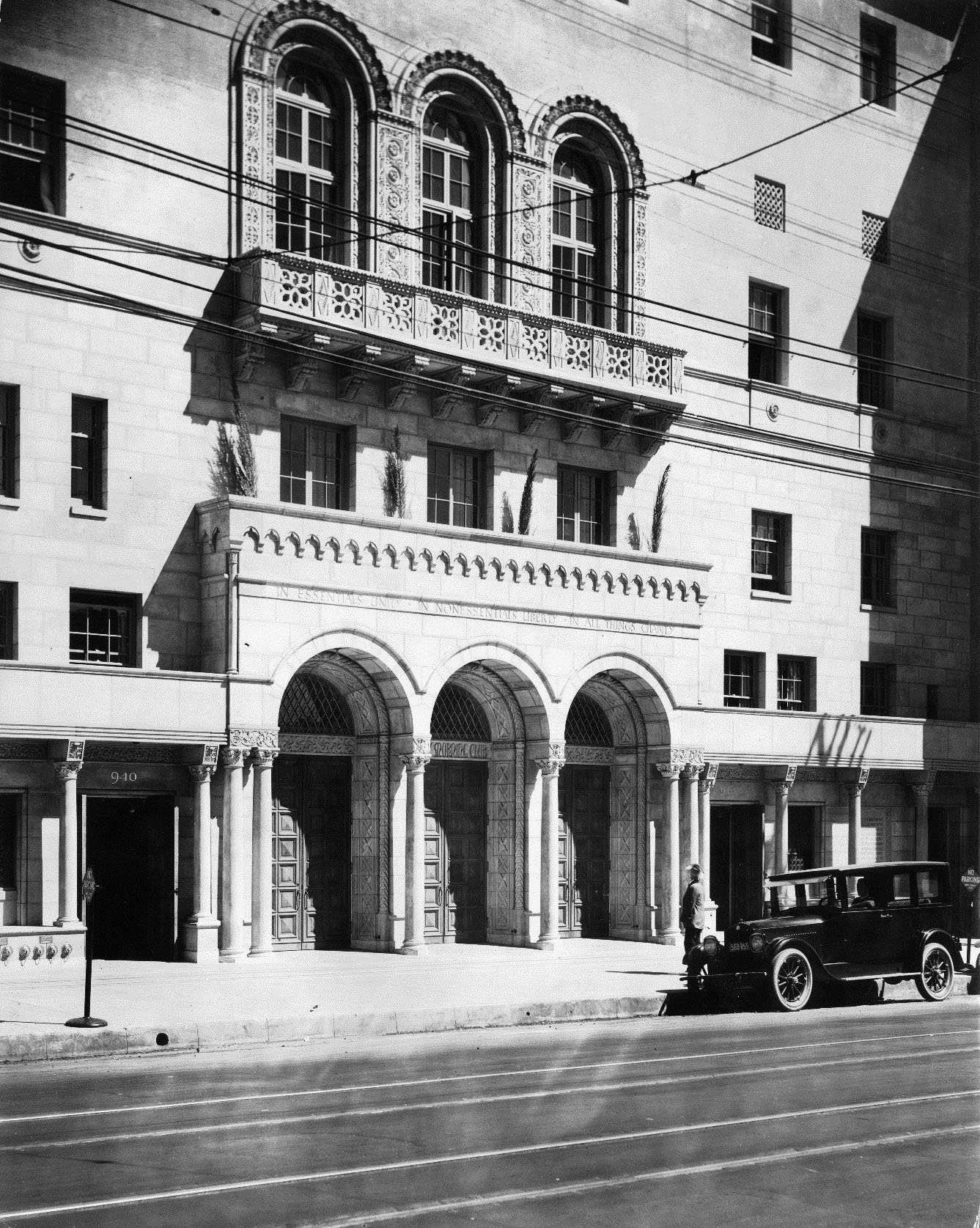 |
|
| (ca. 1925)^*# – A man is standing in front of an early model car looking up at the new Friday Morning Club Meeting Building located at 940 S. Figueroa Street. |
Historical Notes Opened: May 5, 1924 as the Friday Morning Club, a social and political group for women that had been founded in 1891. Will Rogers was the toastmaster at the opening and guests included Charlie Chaplin and C.B. DeMille. The idea was that the main theatre, known as The Playhouse, would generate revenue to support the building. Speakers included Eleanor Roosevelt and Dorothy Parker. Live radio shows from the building included performers such as Al Jolson and Eddie Cantor.^ |
.jpg) |
|
| (ca. 1925)* – Close-up view showing two men walking in front of the entrance to the Renaissance Revival-style Friday Morning Club Building. Note architectural designs over arches over the entranceway and windows above. Architects: Allison and Allison |
Historical Notes The building contained offices, lounges, a library, assembly/dining room with seating for 500, an art gallery and two small clubrooms. The 1,100-seat auditorium occupies first floor. The 500-seat auditorium on the third floor was leased out as The Playroom, a live venue and vaudeville house. It is said that Clark Gable made his acting debut here in “Romeo and Juliet” in May of 1925.* |
 |
|
| (1926)* - View looking southeast across Figueroa Street showing the Friday Morning Club and Figueroa Playhouse. The Playhouse marquee reads: “Coming Pauline Frederick”. The church seen in the distance is the Immanuel Presbyterian Church, located on the southeast corner of what is now Figueroa Street and Olympic Boulevard. |
Historical Notes The auditorium, originally called The Playhouse, was immediately leased to producers Louis O. Macloon and his co-producer-director-wife, Lillian Albertson. The first staged play was 'Romance,' starring Doris Keane and emceed by Will Rogers, which opened on May 5, 1924. Charlie Chaplin and Cecil B. DeMille attended the premiere. |
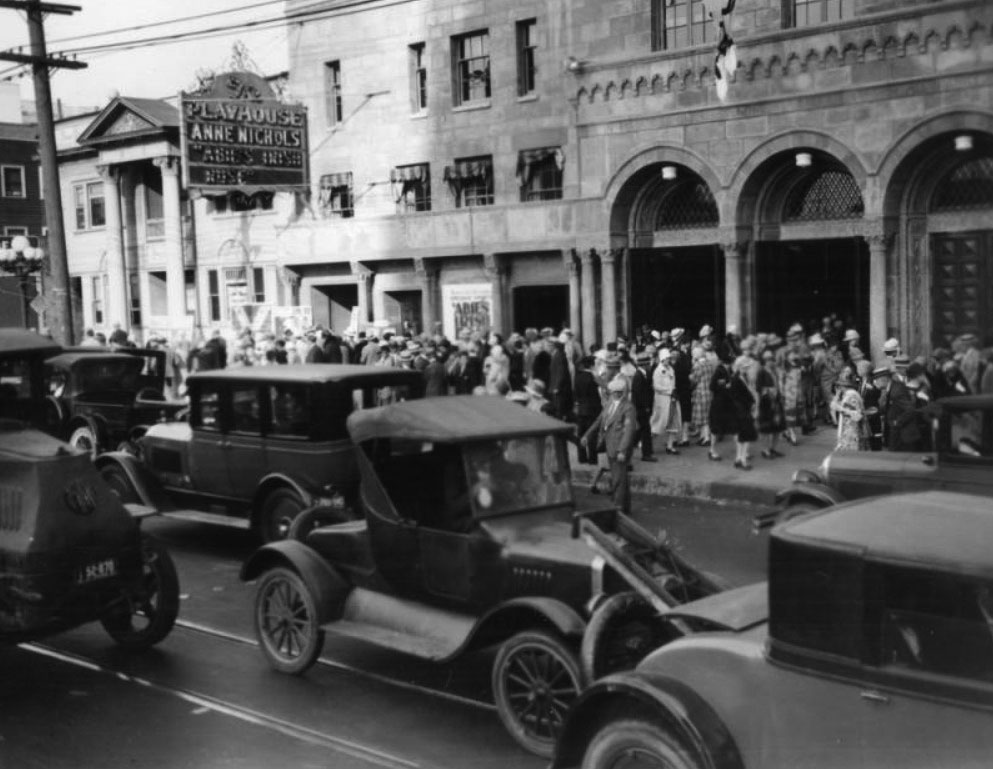 |
|
| (ca. 1935)^ - A view of Variety Arts Theater which at the time of this picture was named Figueroa Playhouse. Across the view of cars in the street you can see a crowd of people on the sidewalk and the marquee: "Anne Nichols Abie's Irish Rose." |
Historical Notes From 1932 to 1938, CBS Radio Playhouse used the auditorium to broadcast 'The Burns and Allen Show' as well as radio broadcasts by Al Jolson and Eddie Cantor. Even Eleanor Roosevelt allegedly spoke there. ^ |
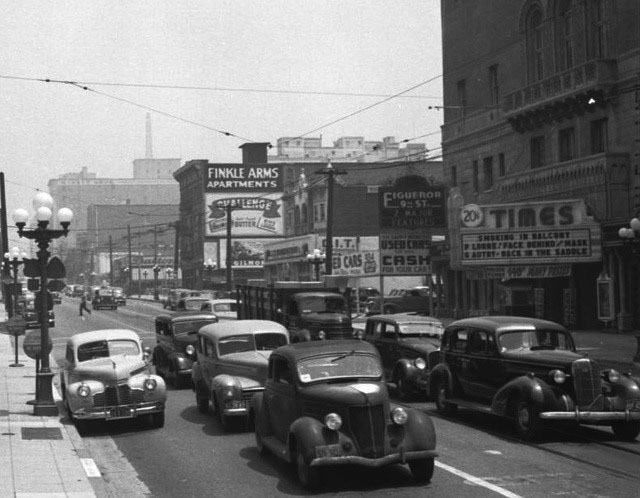 |
|
| (ca. 1941)^.^ – View looking north on Figueroa Street towards 9th Street showing the Friday Morning Club building on the right. The sign on the theatre marquee now reads “Times”. Movie now playing is “Back in the Saddle” starring Gene Autry |
Historical Notes In 1940, the auditorium was renamed the Times Theater, which tried to fill its calendar with stage shows, lectures and an occasional movie screening. However, the theater began losing its luster. ^ |
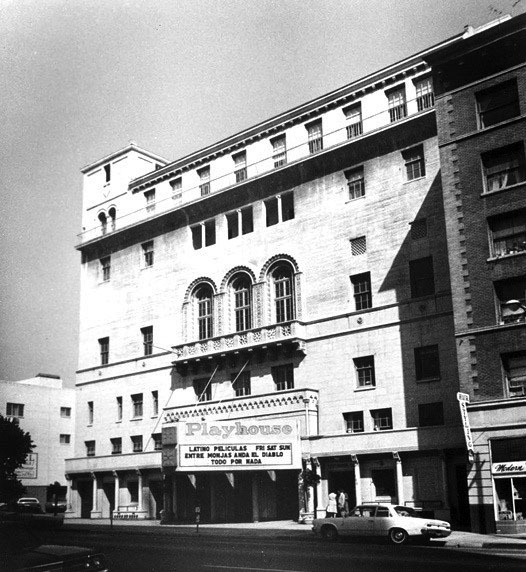 |
|
| (1970s)^.^ - View showing the Friday Morning Club with new marquee reading "Playhouse". |
Historical Notes After reverting the theater back to its original name, The Playhouse, the building was granted landmark status on August 9, 1978. |
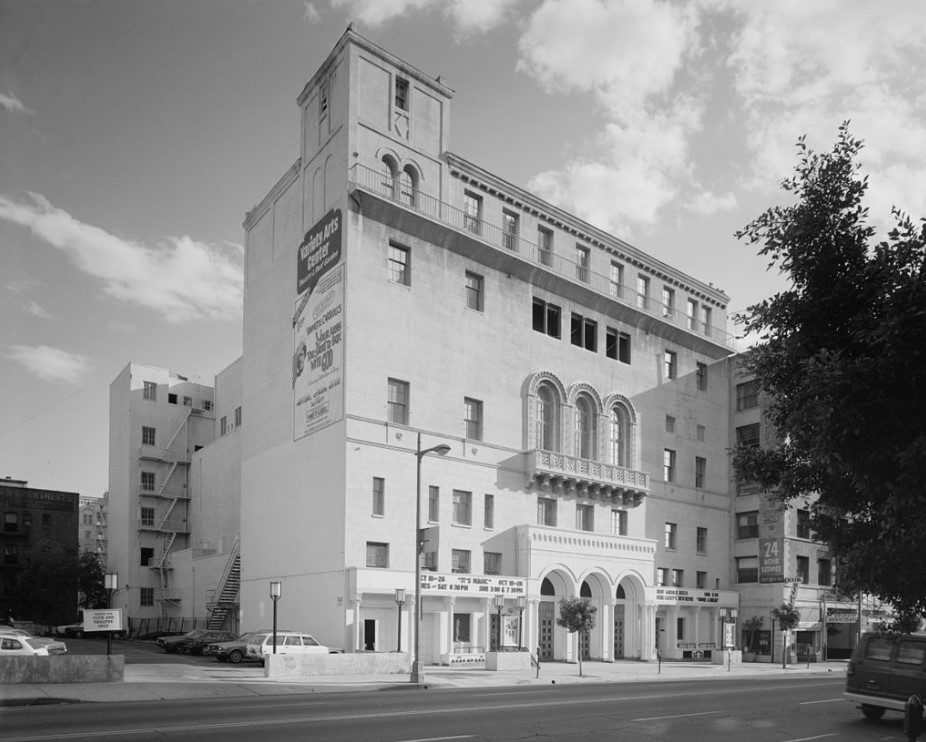 |
|
| (1980)^* – The Friday Morning Club building, 938-940 South Figueroa Street, as it appeared in the 1980s. |
Historical Notes The Friday Morning Club sold their headquarters in 1984 to a non-profit organization called the Society for the Preservation of the Variety Arts headed by Milt Larsen. Larsen, who owned the Magic Castle at the time, continued to use the building for live performances and opened a small museum dedicated to the vaudeville and the theatrical history of the building. The building was renamed the Variety Arts Center. In 1988, the Variety Arts Center closed due to Larsen’s failure to pay back taxes. Los Angeles’ Community Redevelopment Agency, who had initially loaned the Society for the Preservation of Variety Arts a half a million dollars for restoration purposes had to raise an addition $1.7 million to prevent the IRS from auctioning the landmark. Paul Sehdeva purchased the building in 1989 and operated a nightclub there for a short time. ^ |
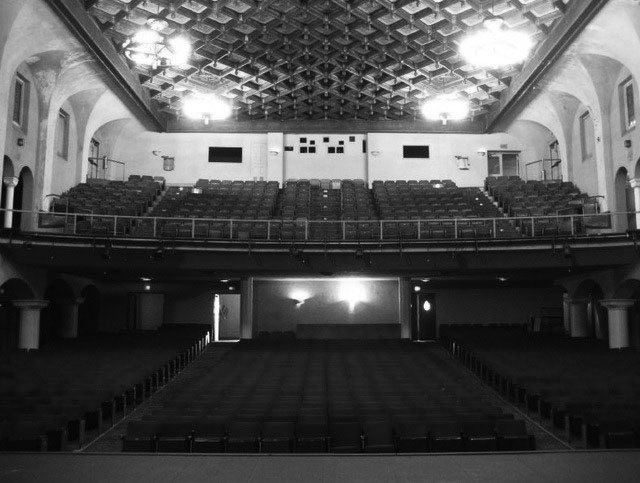 |
|
| (ca. 2010s)^.^ – Interior view of the Variety Arts Theatre Auditorium (Friday Morning Club Building) as seen from the stage. |
Historical Notes The Variety Arts Center Building is a Los Angeles Historic-Cultural Monument. It was added to the National Register of Historic Places in 1984, meeting the criteria for both social history and architectural significance. |
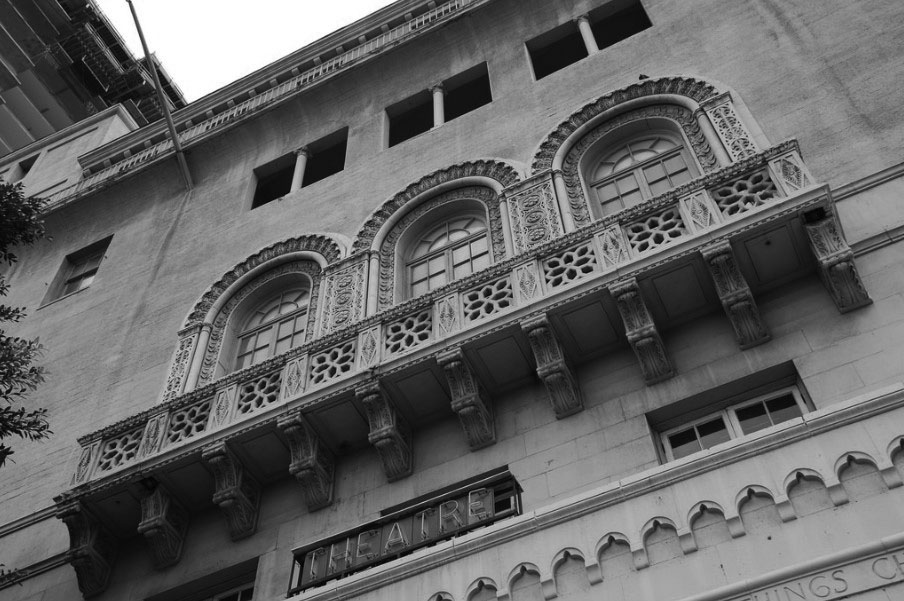 |
|
| (2008)^*^ – Close-up view showing the ornate arched window of the Variety Arts Center Building (formerly Friday Morning Club Building). |
Historical Notes In 2004, The Anschutz Entertainment Group (AEG) bought the Variety Arts Center for around $8 million, but was unsuccessful in their attempt to incorporate the property as part of their L.A. Live area. Originally, AEG had eyed the strip of land between Staples Center and the Variety Arts Center for the a $2.5 billion L.A. Live sports and entertainment district, featuring big-name restaurants, retail shops, a theater, movie complex, ESPN broadcast center, housing and a hotel. The proposed development was later abandoned.* |
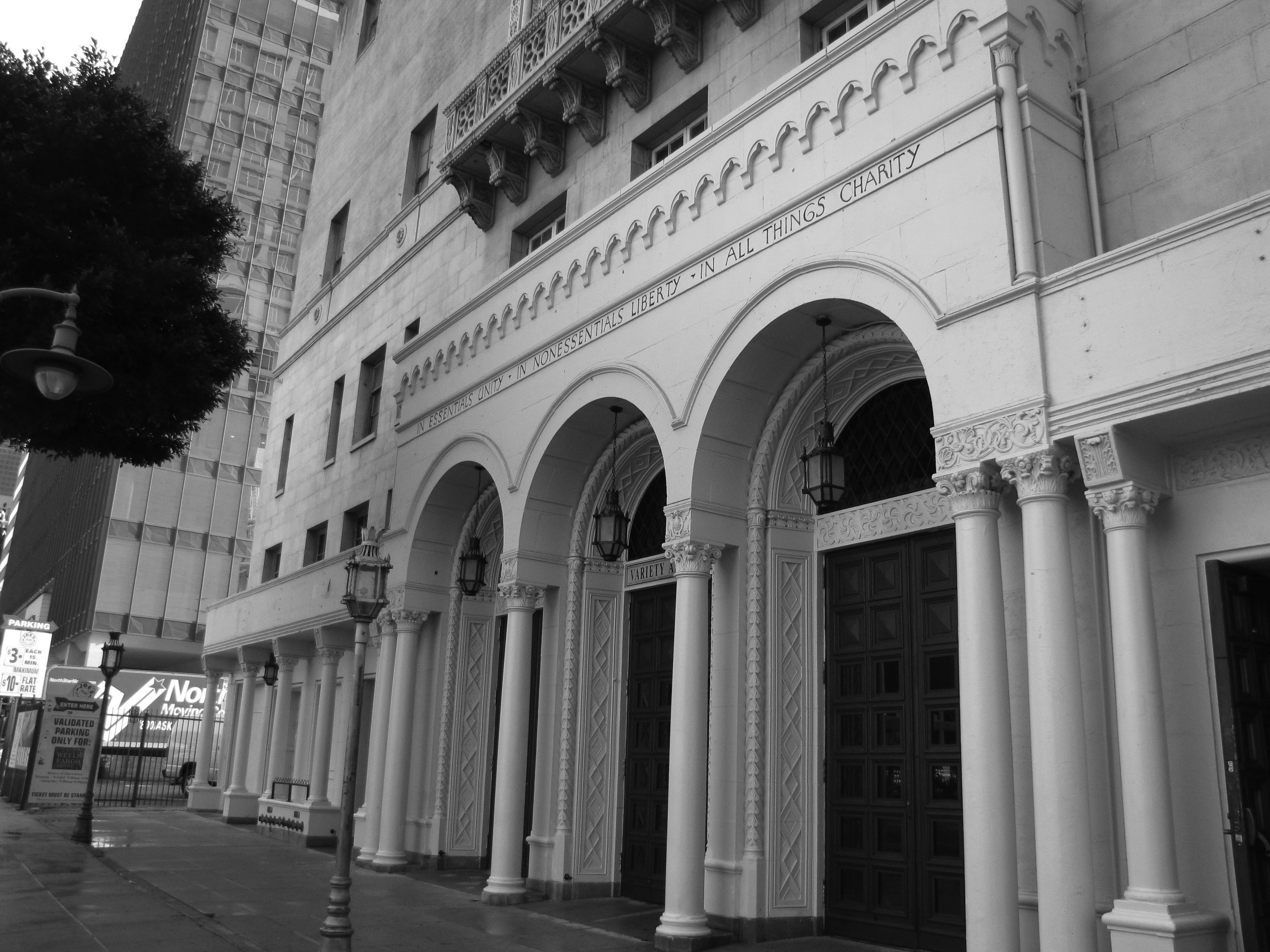 |
|
| (2010s)^x^ - Variety Arts Theater (Friday Morning Club). Engraved sign over front entrance reads: ‘In Essentials Unity – In Nonessentials Liberty – and In All Things Charity’ |
Historical Notes In late 2006, David Houk, former owner of the Pasadena Playhouse, bought the building from AEG for an undisclosed amount. However, in 2008, Houck told The Los Angeles Times that he was 'unable to secure the federal tax credits he had hoped would help fund restoration and operation…so now he must sell it or find a new partner willing to buy into his dream of bringing the old stage back to life.' In the meantime, the building is occasionally rented out for film and television productions, photo shoots and fashion shows."* |
* * * * * |
Gamut Auditorium
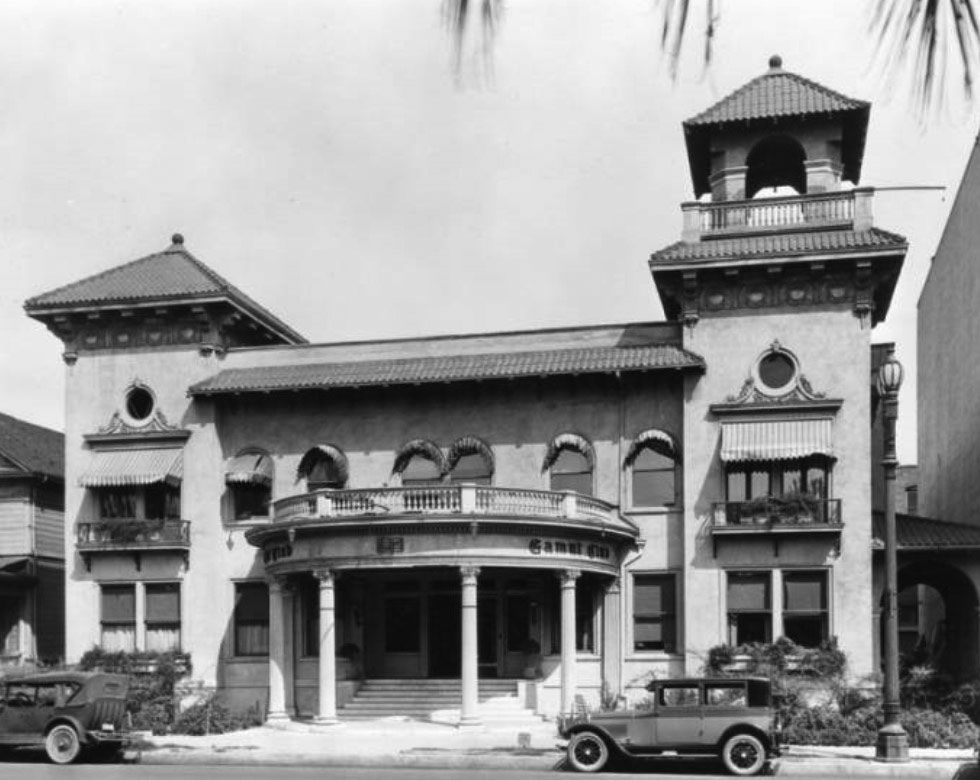 |
|
| (1926)* - View showing the Gamut Club Building (aka Gamut Auditorium) located at 1044 S. Hope Street. A musical symbol is seen above the entrance. |
Historical Notes Opened in 1904 as an exclusively male musical society by L.E. Behymer and other L.A. musicians. Soon the Gamut Club broadened its focus to other types of artists as well as local people of "artistic tastes." Behymer was also involved in the production of opera at Hazard's Pavilion and became the head of the Los Angeles Civic Light Opera, presenting at the later building on the site at 5th and Olive, the Philharmonic Auditorium. Seating: 668 in the auditorium plus various other meeting, banquet rooms and music studios. The club was the scene of a great variety of musical performances. Status: The building has been demolished. It's unknown when the club ceased to be active (Late 20s?). It's listed in the 1923 city directory under "theatres." The site of the Gamut Club is now (2018) a parking lot.^ |
* * * * * |
Jonathan Club
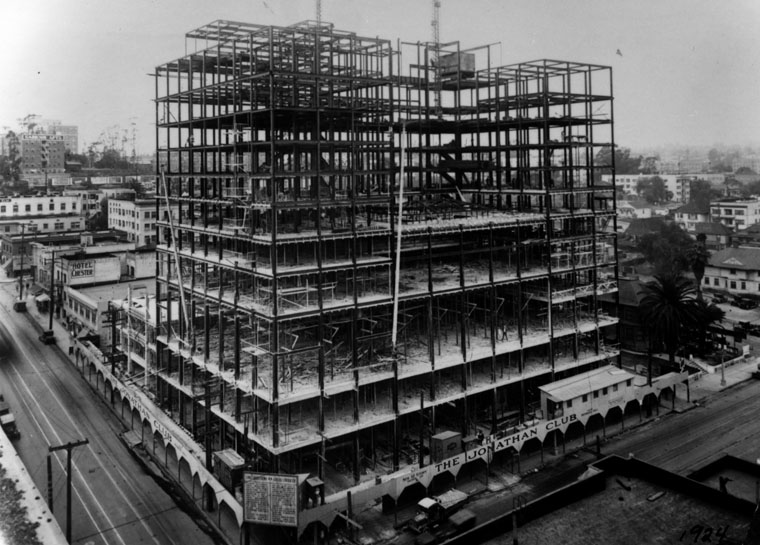 |
|
| (1924)* - Postcard view of the construction of the Jonathan Club building, with open steel frame. Date built: 1924. Architects: Schultze & Weaver. The new building is located at 545 S. Figueroa Street (NW corner of Figueroa and Sixth streets) where the Belleview Terrace Hotel once stood. |
Historical Notes In 1905, the club was headquartered in the monumental new Pacific Electric Building at 610 S. Main Street, which was the transportation hub for Southern California. According to the National Trust for Historic Preservation, "the top three floors of the building housed the exclusive and lavishly adorned Jonathan Club, one of the city’s most exclusive private clubs. In 1924 a contract was let for what Southwest Builder called a "magnificent new home" for the club — its present brick-faced structure at 545 S. Figueroa Street, one block west of the Los Angeles Central Library. In 1927 a second club, The Jonathan Beach Club, opened in Santa Monica at 850 Palisades Beach Road.^* |
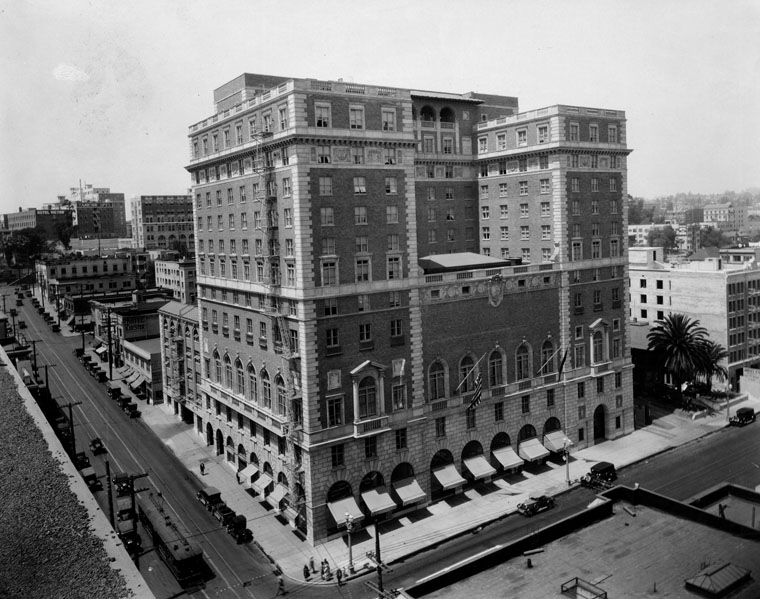 |
|
| (ca. 1925)* - Exterior view of the Jonathan Club building at Figueroa and 6th Streets. |
Historical Notes Established in 1894 as a political group Jonathan Club segued into a purely social club shortly after. The Club originally afforded an outlet through which members hosted political candidates, participated in political rallies and gathered for social activities. In 1895, Jonathan Club members determined that the social bond, and not the political one, was what interconnected its members. Jonathan Club was chartered as a “purely social club” by the State of California on September 23, 1895. +** |
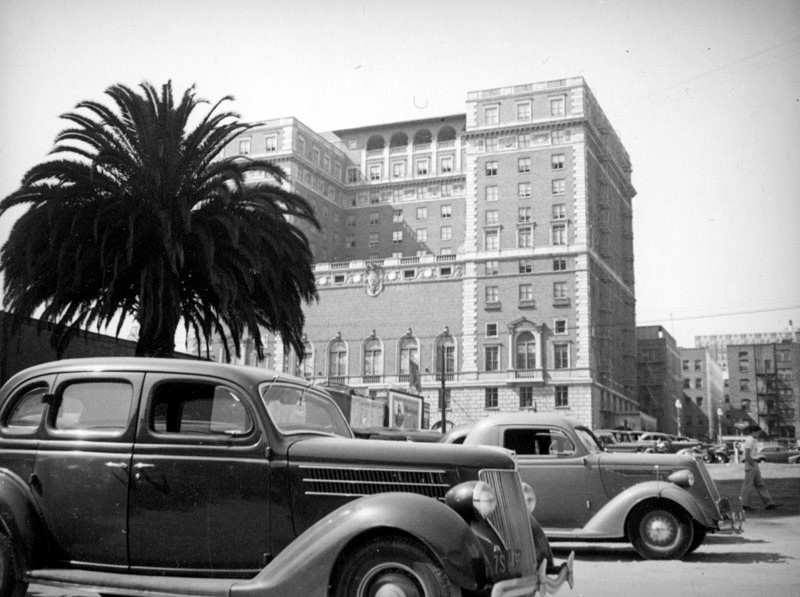 |
|
| (ca. 1937)* – View across a parking lot showing the Jonathan Club in the background. |
Historical Notes For most of its history, the club admitted only men, but since 1987 the club enjoys a diversified membership. When the Jonathan Club originated, only white, Anglo-Saxon, Protestant men were able to join. The club was alleged to have maintained discriminatory admission and access policies based on race and sex throughout the 20th century and into the 21st. The club admitted its first African-American and female members in 1987.^* |
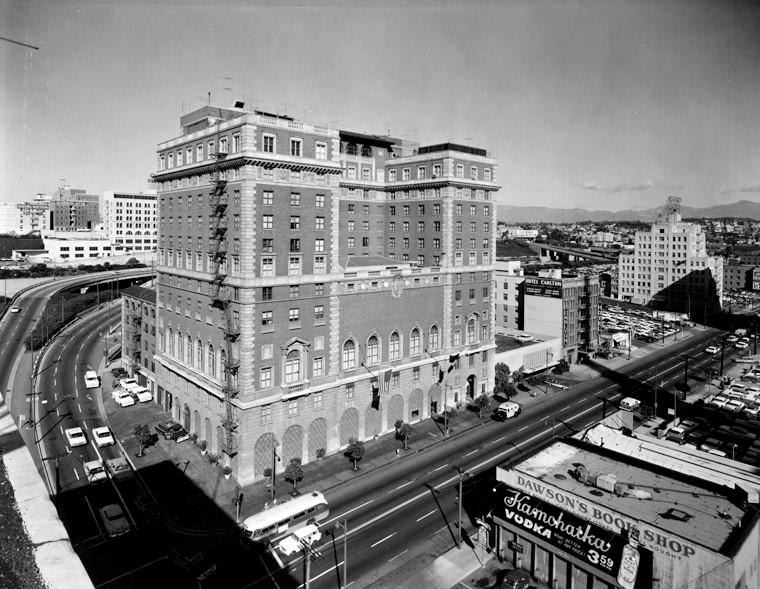 |
|
| (1960)* - View looking northwest showing the Jonathan Club at 545 S. Figueroa Street. Dawson's Book Shop can be seen across the street. |
Historical Notes The building was designed in a Beaux Arts version of early l6th Century Italian. Architects: Schultze & Weaver.* |
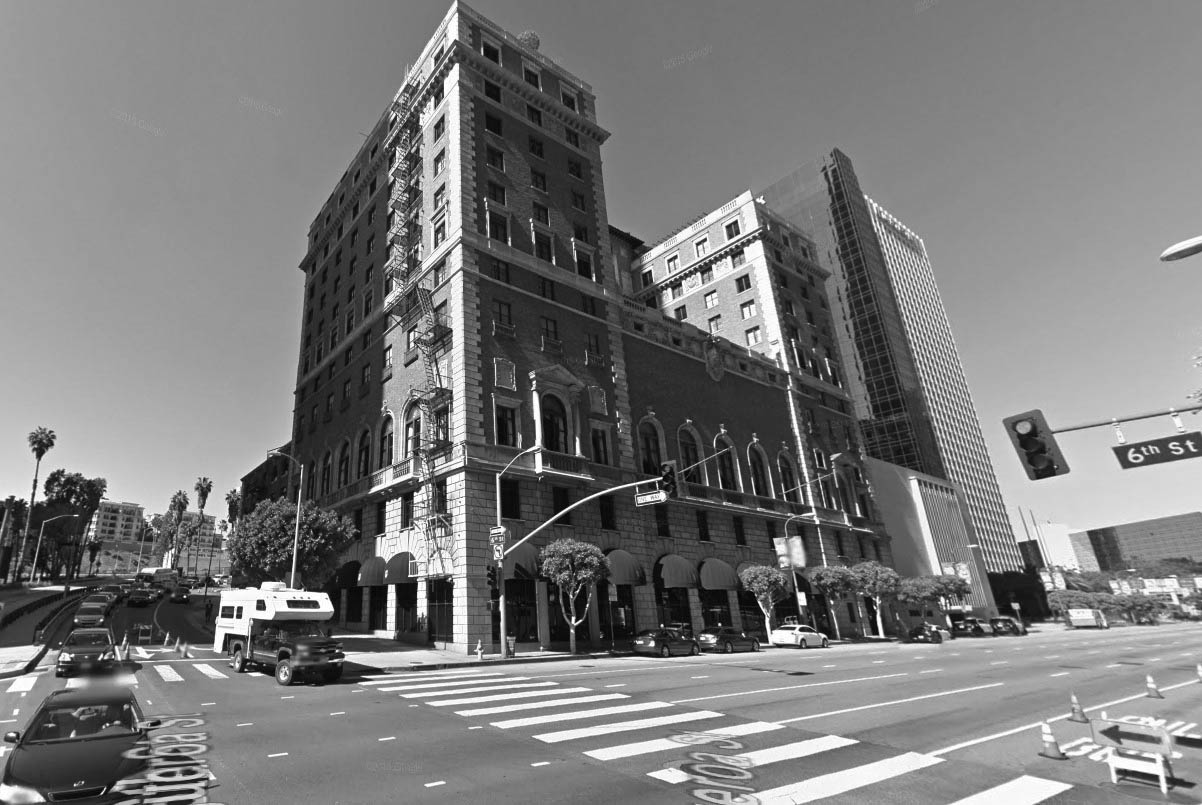 |
|
| (2015)#^^* – Google street view looking northwest toward the Jonathan Club from the intersection of Figueroa and 6th Street. |
Historical Notes Membership in the club is by invitation. For most of its history, the club admitted only white men, but since 1987 it has also admitted women and minorities.^* |
* * * * * |
Wurlitzer Building
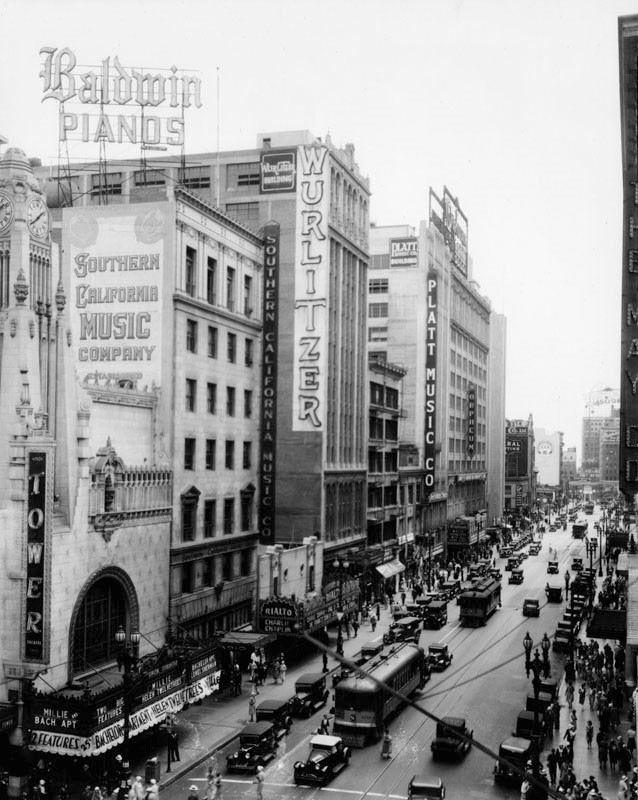 |
|
| (ca. 1927)* - View looking south on Broadway from 8th Street, showing the 13-story Wurlitzer Building located at center of block. |
Historical Notes The Wurlitzer was billed as "the world's largest music house" when it was designed by Percy Walker and Alber Eisen in 1924 (the Platt Building just down the block was also built to house music companies and had the same architects). In both buildings, one floor--according to Richard Schave of LAVA--was a concert hall, and the building was filled with practice rooms and offices. Franz Rudolph Wurlitzer opened his first shop in Cincinnati selling imported musical instruments but within a few decades was making violins, harps, juke-boxes and their best-known product, the “Mighty Wurlitzer” theatre organs. The company hit its stride during the early 20th century, when it built large organs for theaters that were--at that time--showing silent films, most of them pretty short and thrilling. Organs were ideal for that sort of venue because besides simply playing Bach loud enough for the sound to fill a large auditorium, organs "could produce a variety of sounds, from banjos to harps to orchestra bells to train whistles and galloping horses." * |
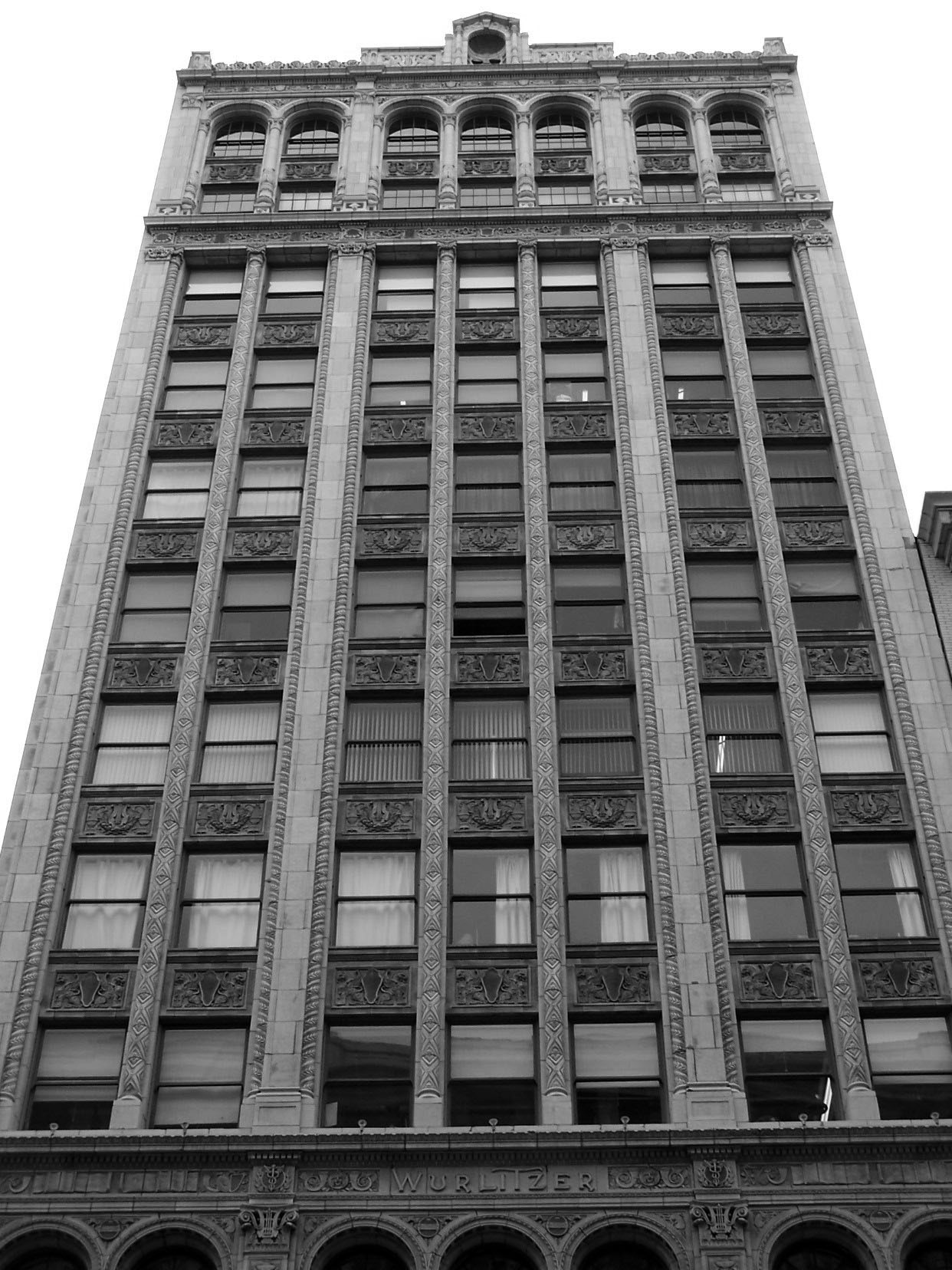 |
|
| (2010)*# – Front view of the Wurlitzer Building located at 818 S. Broadway (architects Walker & Eisen, 1924). |
Historical Notes The 13-story building would cost a million dollars to erect, and go up in six months-- incredible speed, according to an LA Times story in 1923. It confirms that that there would be a large recital hall, as well as a showroom for pipe organs. * |
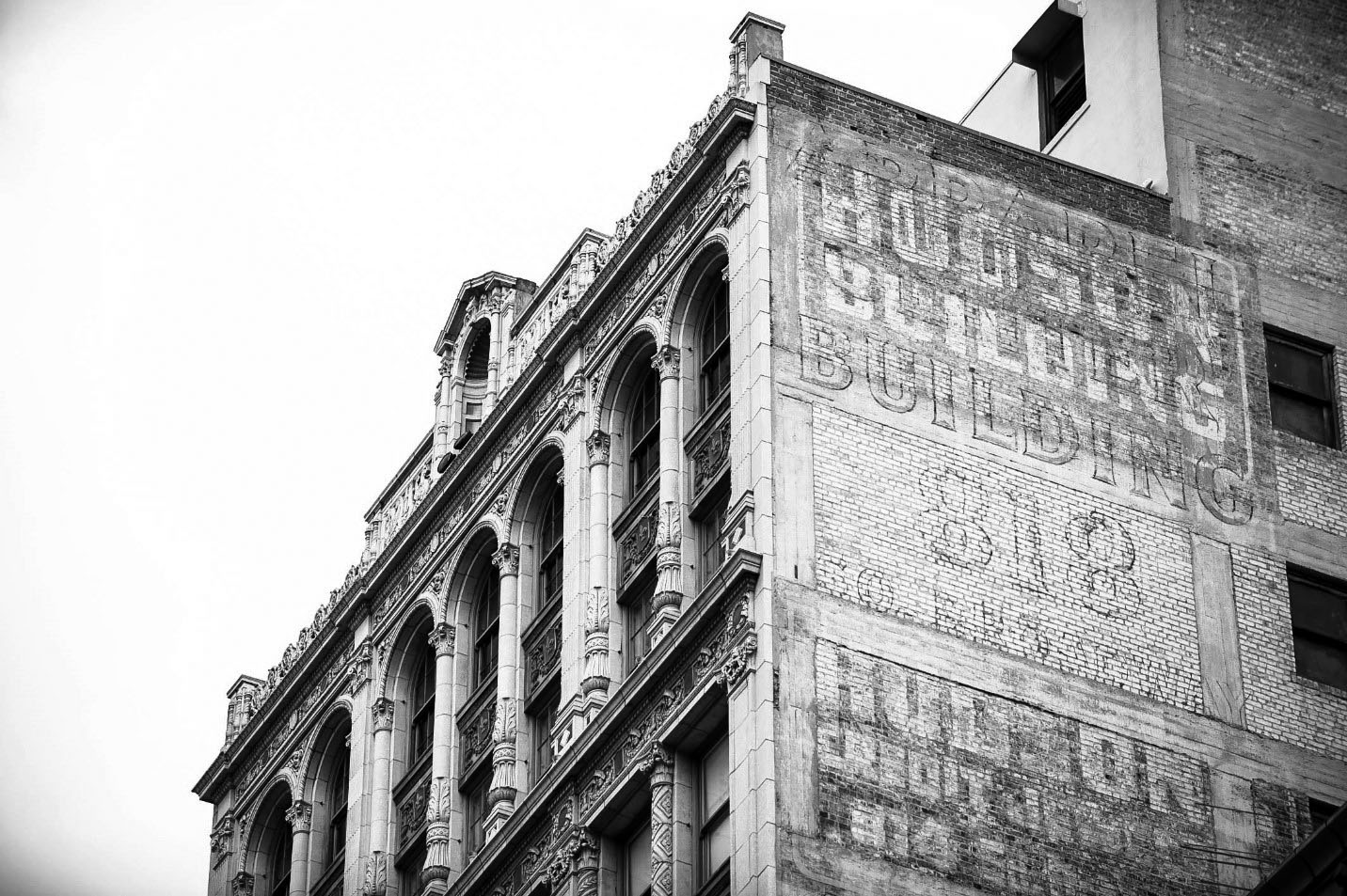 |
|
| (ca. 2016)^ – Close-up view showing the top two floors of the Wurlitzer Building. Over the years the Wurlitzer Building has been known by other names including the Apparel Center Building, Anjac Fashion Building, and apparently Hudson Building as seen on the side facing. |
Historical Notes In 1924, Wurlitzer occupied the bottom four floors and basement area, but leased out the top eight floors as loft space to other concerns. The other tenants of the Wurlitzer included millinery companies that sold hats and clothes, which we know because they suffered losses in fires in the 1920s. Since the building was concrete, the fires did not spread to other floors. * |
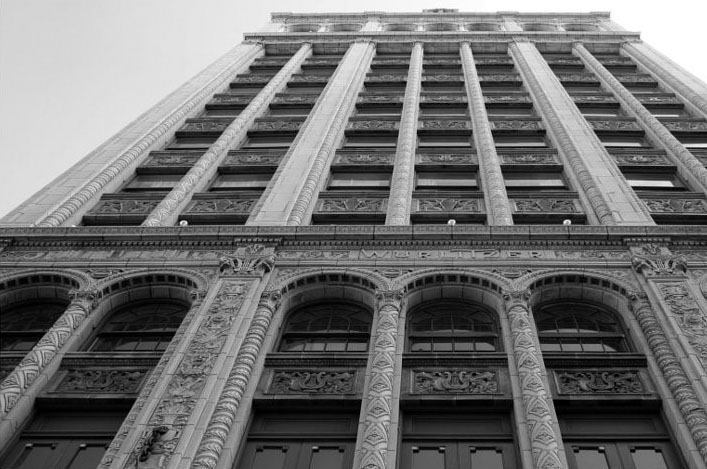 |
|
| (2010s)*^ – Looking straight up towards the top of the 13-story Wurlitzer Building located at 818 S. Broadway. |
Historical Notes Thirteen stories was the legal limit in those days (There was a 150’ height limit until 1957). The first floor usually encompassed a 2nd floor mezzanine, so that there was never a 13th floor. |
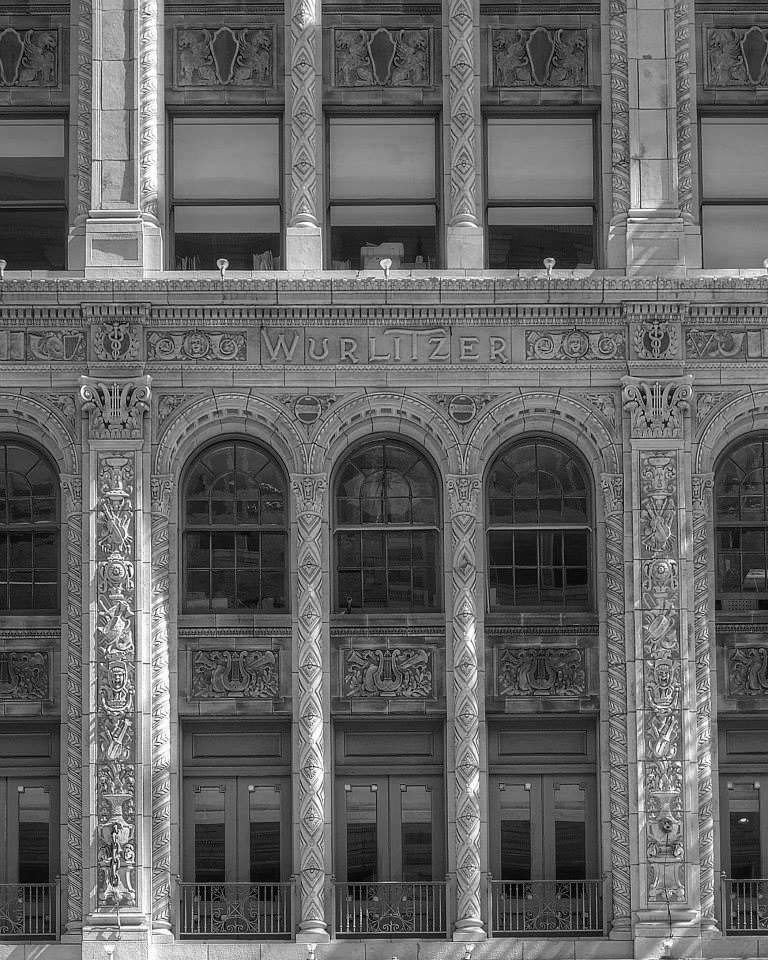 |
|
| (2014)^.^ – Wurlitzer Building close-up showing its unique Spanish Renaissance Revival detail design. |
Historical Notes The Wurlitzer's terra cotta facia, and its many hues, were covered by grime for far too long. But in 2007 the building was power-washed to expose its beautiful intricate ornamentation and designs. |
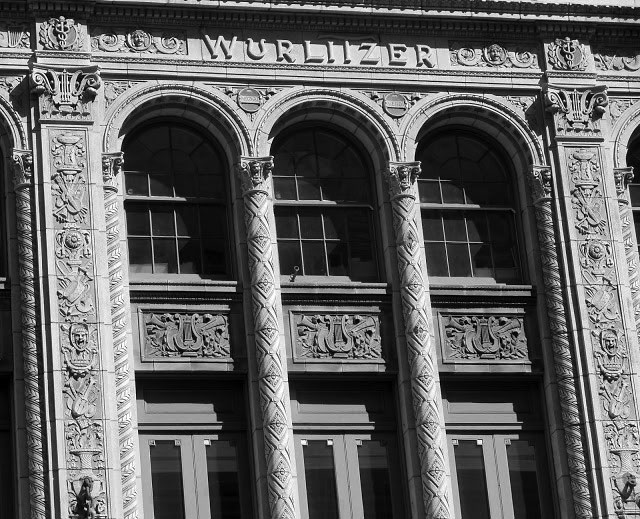 |
|
| (2013)^^ – Close-up detail view showing front facade of the Wurlitzer Building, 818 S. Broadway. |
Historical Notes If you look closely at the photo above, the names Mozart and Verdi are carved in the medallions beneath the Wurlitzer name. The detail of bas relief and sculpture on the place is incredible. |
* * * * * |
Platt Building
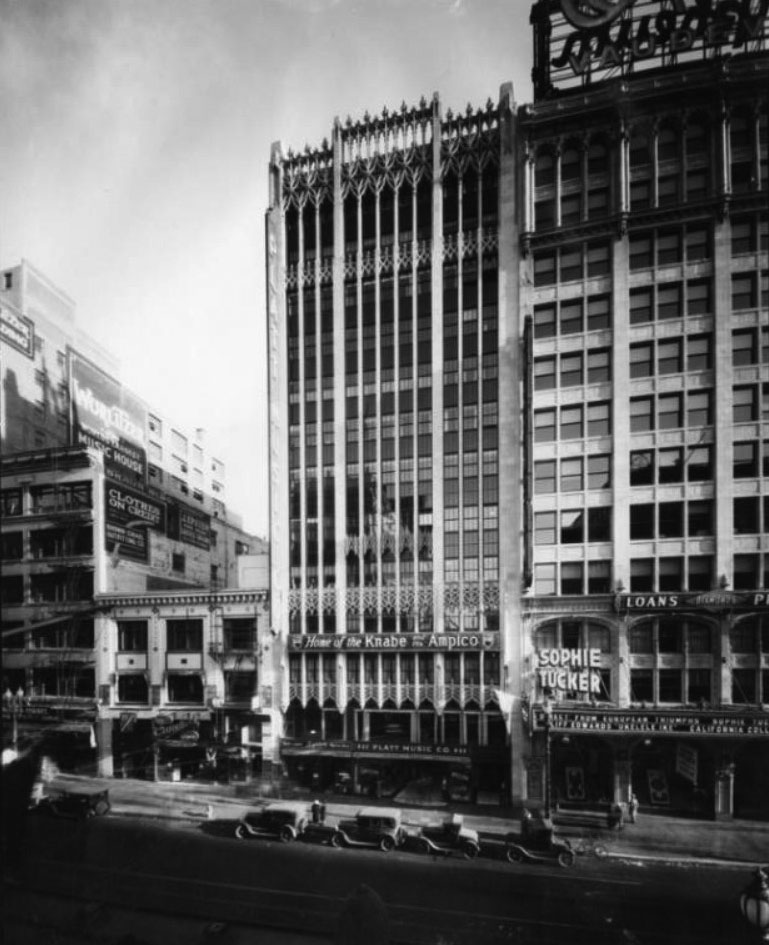 |
|
| (1927)* – View showing the Platt Music Company Building (center) at 832 S. Broadway with the Orpheum Theatre Building seen on the right. |
Historical Notes The Platt Music Company Building was constructed in 1927 and designed by architects Walker + Eisen who also designed the Wurlitzer Building just up the block at 818 S. Broadway. The same firm also designed the Beverly Wilshire Hotel in Beverly Hills.^ |
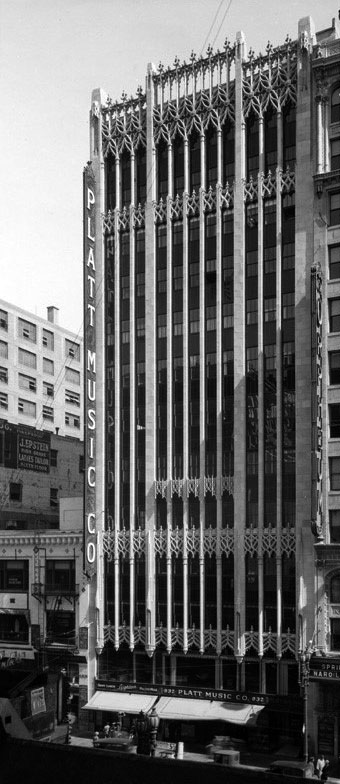 |
(1927)* - View showing the 13-story Platt Music Co. Building. Thirteen stories was the legal limit in those days (There was a 150’ height limit until 1957). The first floor usually encompassed a 2nd floor mezzanine, so that there was never a 13th floor. |
|
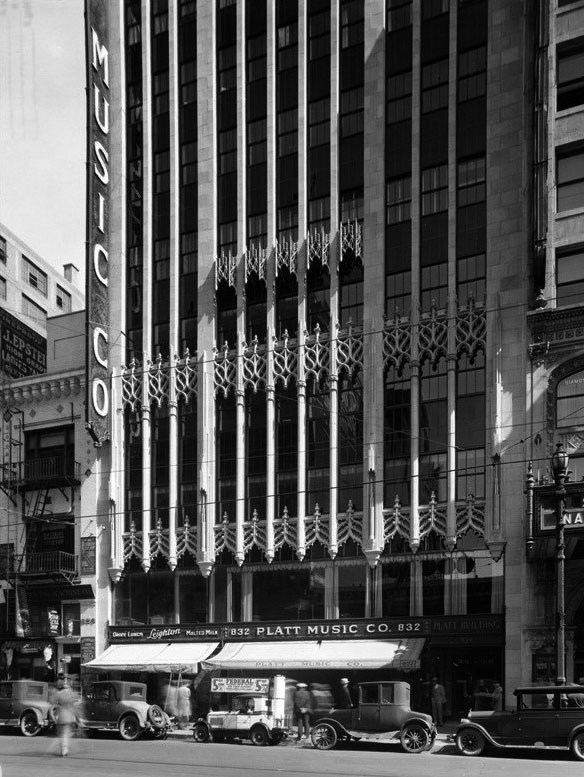 |
|
| (1927)* – Ground level view showing the entrance to the Platt Music Co. Building at 832 S. Broadway as seen from across the street (architects Walker & Eisen). |
Historical Notes The Platt Music Corporation, founded by Benjamin Platt in 1905, was a national retailer specializing in selling consumer electronics goods through leased operations in 135 department stores including Marshall Field's, Bloomingdale's, The May Department Stores Company and Emporium-Capwell.^ |
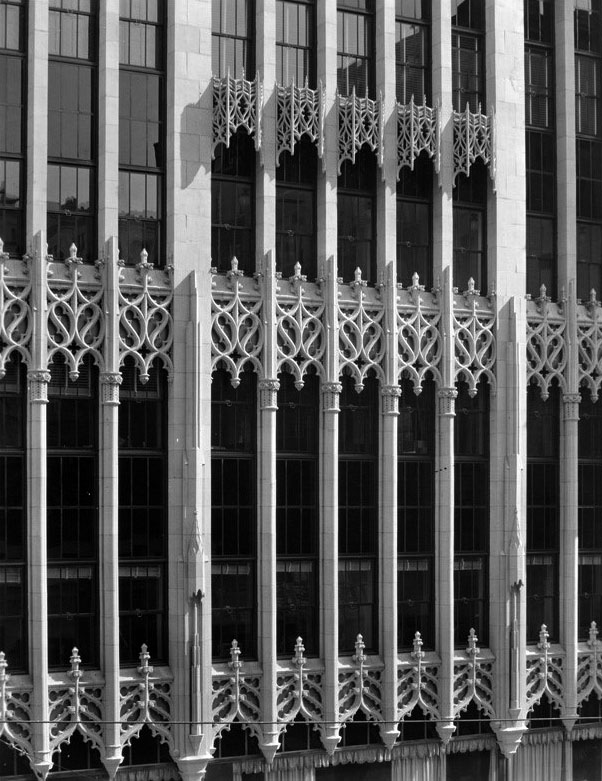 |
|
| (1927)* – View showing the center section and front facade of the Gothic Revival-style Platt Building. |
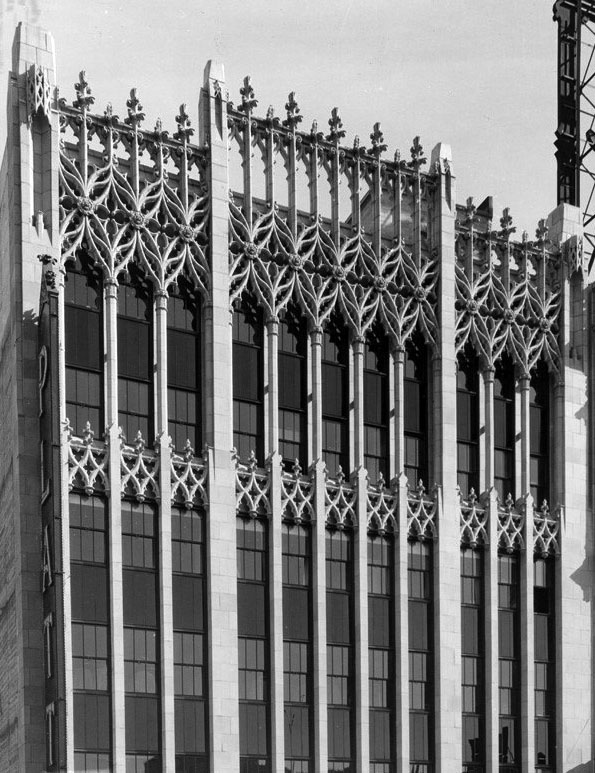 |
|
| (1927)* – View showing the top section of the Gothic Revival-style Platt Building, 834 S. Broadway |
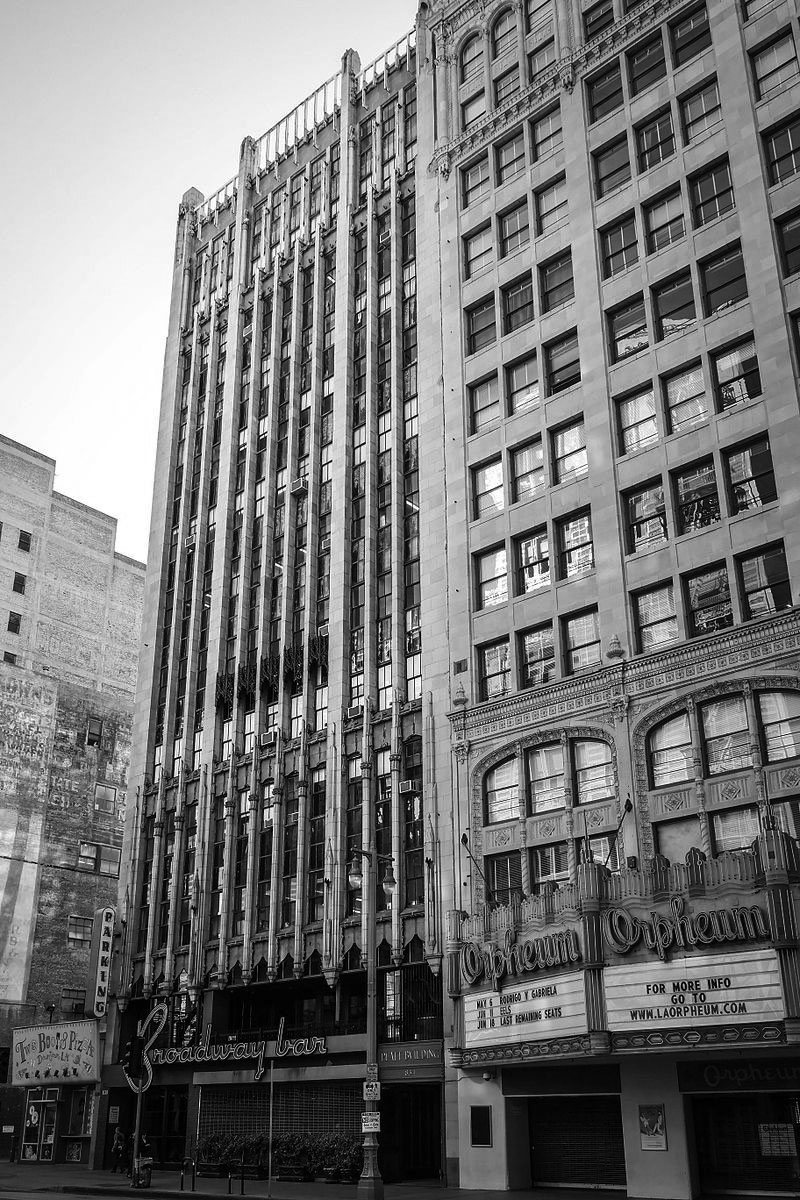 |
|
| (2014)^* - The Platt Building (left), also known as the Anjac Fashion Building, in the Broadway Theater and Commercial District of Los Angeles. The Orpheum Theatre is seen at right. |
Historical Notes The Platt Building is one of the Anjac Fashion Buildings, and the National Register of Historic Places nomination form for the Broadway Theater and Commercial District uses this name to designate the building. Anjac is a portmanteau of the names Annette and Jack Needleman, real estate owners who in 1964 began buying properties in the Fashion District and surrounding area.* |
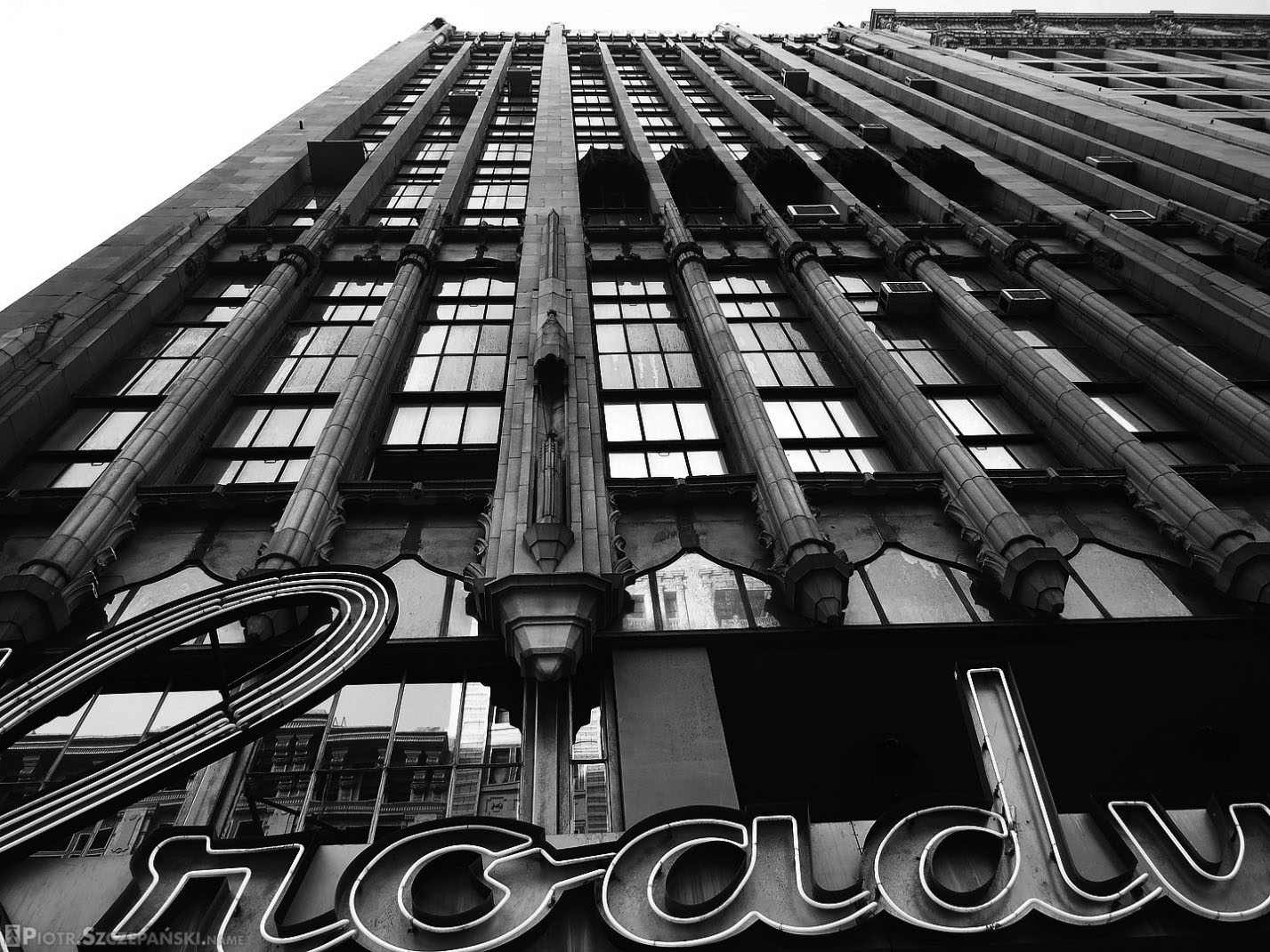 |
|
| (2014)*# – Looking up towards the top of the Platt Building with the Broadway Bar ground floor. |
Historical Notes The Broadway Bar (within the Platt Building) has been opened since 2005. The two-story bar is decked out in leather sofas, vintage brass sconces and colors including purple, black and deep blue. |
* * * * * |
Please Support Our CauseWater and Power Associates, Inc. is a non-profit, public service organization dedicated to preserving historical records and photos. We are of the belief that this information should be made available to everyone—for free, without restriction, without limitation and without advertisements. Your generosity allows us to continue to disseminate knowledge of the rich and diverse multicultural history of the greater Los Angeles area; to serve as a resource of historical information; and to assist in the preservation of the city's historic records.
|
For more Historical Los Angeles Views click one of the following:
For Other Historical Views click one of the following:
See Our Newest Sections:
To see how Water and Electricity shaped the history of Los Angeles click one of the following:
Water:
Power:
* * * * * |
References and Credits
* LA Public Library Image Archive
**DWP - LA Public Library Image Archive
*^Oviatt Library Digital Archives
^^ Daily Breeze: Los Angeles Motordome
*# LA Times: Hollywood Castles and Curious Cures; Olympic Auditorium History; The Ennis House; Bob Hope Patriotic Hall reopens in L.A.
#**Themerica.org: Tam O'Shanter Inn
#++Mattconstruction.com: The Ennis House
#^*Huntington Digital Library Archive
^*#California State Library Image Archive
^+^Bob Hope Patriotic Hall Renovation
+##RolandCommunications.com: Tam O'Shanter
++#Movie Palaces: Beverly Theater
^^*Early Downtown Los Angeles - Cory Stargel, Sarah Stargel
^^+Fightland: Fight Night at the Olympic
**#Noirish Los Angeles - forum.skyscraperpage.com; Elks Building - Horthos; Tam O'Shanter Inn; Garden Court Apartments; Angelus Temple; Coliseum Construction
**^Historical LA Theatres: The Philharmonic Auditorium; Downtown Theatres; Mason Theatre; Loew's State Theatre; Metropolitan/Paramount Theatre; Biltmore Theater
*^#Publicartinla.com - Bovard Hall
*##Curbed LA: California Broadway Trade Center
^^#CSULB - A Visit to Old LA: Hamburger Dept. Store
***Los Angeles Historic - Cultural Monuments Listing
*^*California Historical Landmarks Listing (Los Angeles)
*^^Nuestra Señora la Reina de los Ángeles: losangelespast.com
*^*^UCLA Libraries Special Collection: Pico House Courtyard
*^^*Pacific Eelecfric in San Pedro/Wilmington
^^**Flickr.com: Floyd Bariscale - Sunset Bowling Center
^^++Facebook.com - Pasadena Digital History
^^^*Cinema Treasures: Metropolitan/Paramount Theatre
^*^*Los Angeles Past: The Oldest Building in Los Angeles; Temple and Main Streets, Los Angeles - Then and Now
^*#*Los Angeles Memorial Coliseum and Sports Arena
^*^#Facebook.com - Bizarre Los Angeles
***#Big Orange: Los Angeles Stock Exchange Building; Warner Bros; Saint Vincent de Paul Church
**^#Vintage Los Angeles - Facebook.com: Bernheimer Japanese Mansion; Masonic Temple
^#**A Brief Egyptian Theatre History
^##*Los Angeles Fire Department Historical Archive
#**^Pinterest - Mid Century Hollywood
#*#*Fairfax High School Home Page
#*#^Flickr.com: Wilshire Boulevard History
#^*#Los Angeles Conservancy: Junipero Serra State Office Building; The Ennis House; Bob Hope Patriotic Hall; Talmadge Apartments
#^#^Weird California: Los Angeles' Programmatic Architecture
*###The Story of Hollywood by Gregory Paul Williams
^^##Metropolitan Transportation Library and Archive: Hill St. Station; Subway Terminal Building
###*Sunset Bronson Studios: Hudson Pacific Properties
##^*Facebook.com: Classic Hollywood-Los Angeles-SFV
#^^*Google Maps
#***Flickr.com: Old Los Angeles Postcards
^***^Facebook.com: Garden of Allah Novels
^* Wikipedia: Leonis Adobe; Occidental College; Beverly Hills; Beverly Hills Hotel; Huntington Hotel; Bank of Italy; Van de Kamp's Holland Dutch Bakeries; Rose Bowl Stadium; Los Angeles Memorial Coliseum; Farmers and Merchants Bank of Los Angeles; Los Angeles Biltmore Hotel; Jonathan Club; Los Angeles Plaza Historic District; St. Vincent Church; The Benevolent and Protective Order of Elks; Park Plaza Hotel; YMCA; San Pedro; Venice; Subway Terminal Building; St. Vincent Hospital; Los Angeles Herald-Examiner; Cahuenga Branch Library; Foy House; Frederick Hastings Rindge House; Los Angeles High School; MGM; Breed Street Shul; Natural History Museum of Los Angeles County; Jonathan Temple; Highland Park Masonic Temple; Egyptian Theatre; Phineas Banning; Eagle Rock; Hollywood Masonic Temple; Sawtelle Veterans Home; Downtown, Los Angeles; Los Angeles Philharmonic; Subway Terminal Building; Hollywood Athletic Club; Pío Pico; Los Angeles Plaza Historic District; Jonathan Temple; Charles Clarke Chapman; Los Angeles Stock Exchange; Park Plaza Hotel (Los Angeles); Broadway Theater District: Lowe's State Theater; Obadiah J. Barker; Leslie Brand; Ben Bernie; Ambassador Hotel; Tam O'Shanter Inn; Garden Court Apartments; George L. Crenshaw; St. Vincent's Medical Center; Fairfax High School; Old Warner Bros. Studio; Hollyhock House; Hollywood Bowl; Angelus Temple; Aimee Semple McPherson; Vista Theatre; Grand Olympic Auditorium
< Back
Menu
- Home
- Mission
- Museum
- Major Efforts
- Recent Newsletters
- Historical Op Ed Pieces
- Board Officers and Directors
- Mulholland/McCarthy Service Awards
- Positions on Owens Valley and the City of Los Angeles Issues
- Legislative Positions on
Water Issues
- Legislative Positions on
Energy Issues
- Membership
- Contact Us
- Search Index
